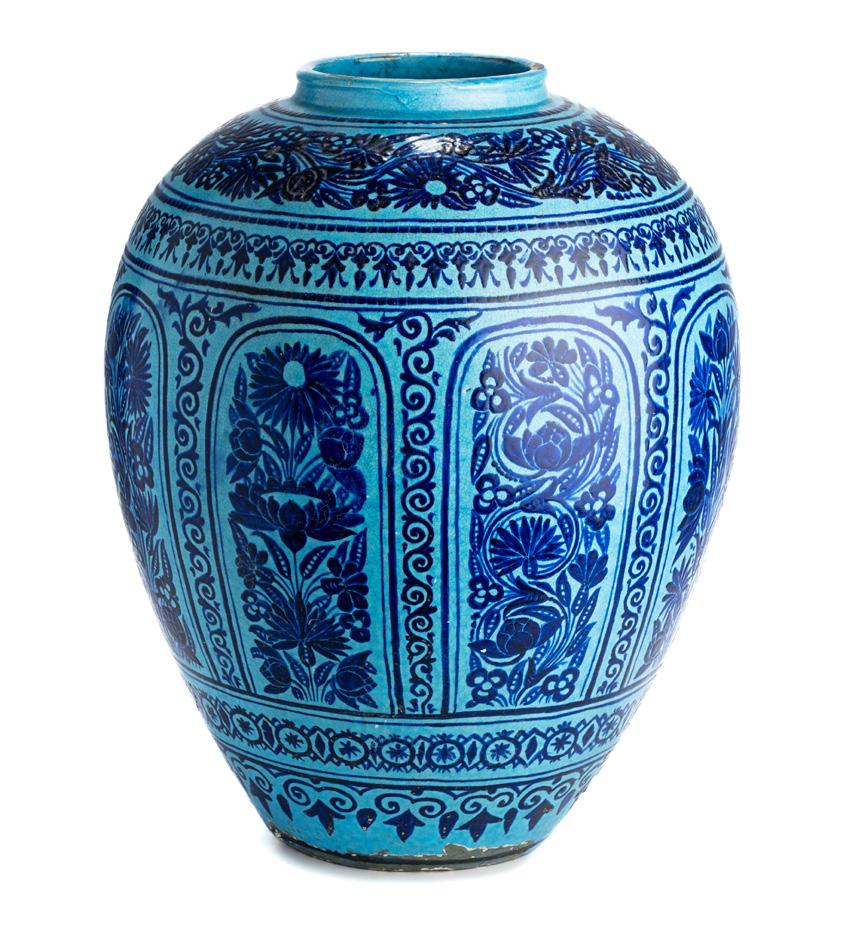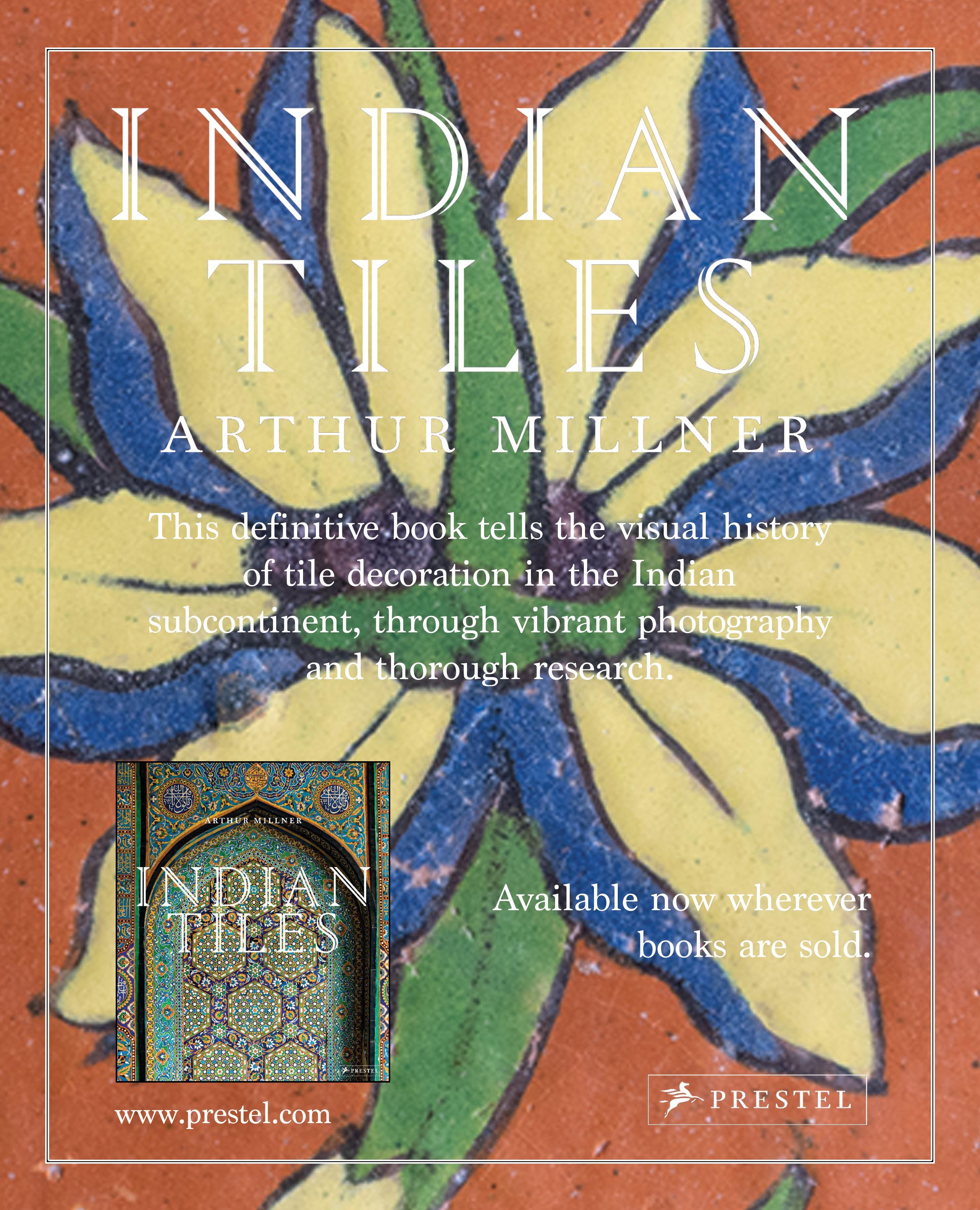Wednesday 9th November 2022
Starting at 11am Asian & Islamic Works of Art
1.
A PAIR OF JAPANESE SATSUMA VASES, CHOSHUZAN, MEIJI PERIOD (1868-1912), slightly tapered slender bodies with variously patterned lappets to the flattened shoulders and around the base, each painted between with a rectangular panel of women and children over a lavish spray of various flowers, gilt painted black ground signature panel to underside, 24cm high £300-500

2.
A GROUP OF SEVEN JAPANESE SATSUMA SMALL OR MINIATURE WINE POTS AND COVERS, 19TH / 20TH CENTURY, of typical flattened form excepting one globular, three lacking handles, 10.5cm longest £400-600
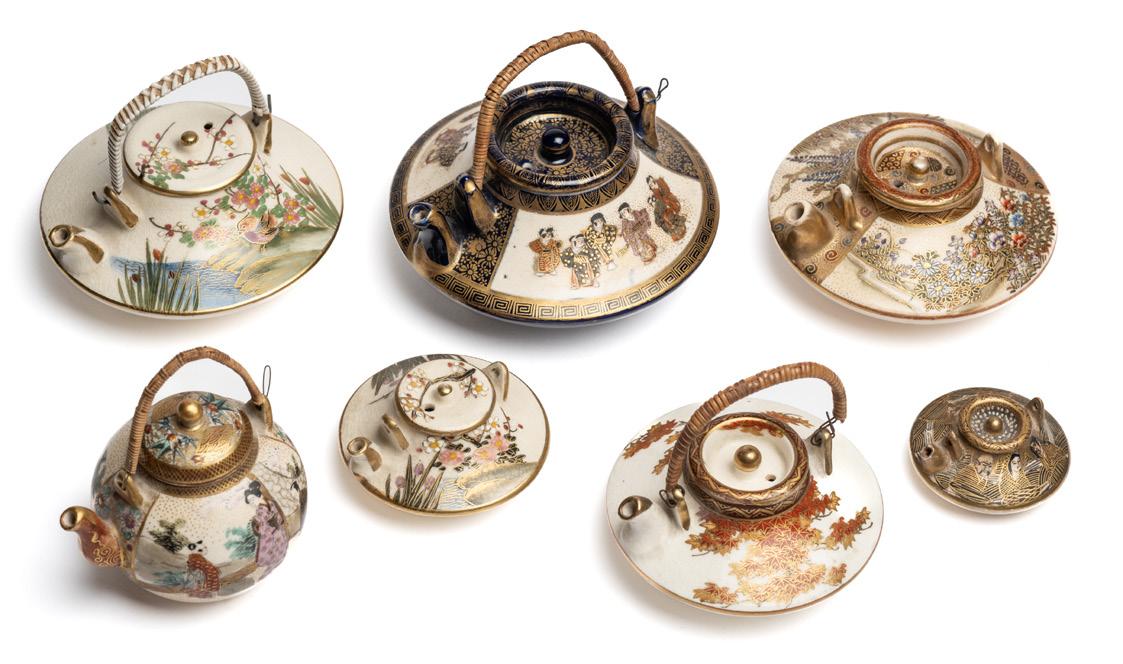
3.
A JAPANESE BLUE AND WHITE KAKIEMON STYLE DISH, 18TH CENTURY, circular with shaped rim, painted with a central pomegranate branch, the interior sides with flowering and fruiting prunus amid rocks, the exterior with leafy tendrils, with an associated wood stand openwork foliate carved, 32cm diameter £200-300

4. (illustrated online)
A JAPANESE IMARI JAR, EDO PERIOD, LATE 17TH CENTURY, slightly bulbous octagonal, painted with two vases of flowers beneath a lappet border enclosing flowers alternating with sold blue panels, 33cm high £100-200
1
5. (illustrated online)
□ FOUR JAPANESE SCROLL PAINTINGS, 20TH CENTURY
ink on paper, laid on silk brocade, wood rollers and hanging rods, two depicting a tuft of grass, unsigned, another depicting ferns growing on rocks, signature and red stamps, the other with stylised fruit design with four columns of calligraphy and red stamps, a further column of calligraphy and '137 Sazanami' in European script at the back, 155 x 42.5cm (2), 105 x 45.5cm, 164 x 40cm
£50-80
6. JAPANESE WOODBLOCK TRIPTYCH, UTAGAWA KUNIYOSHI (1797-1861), the kabuki actors Bando Shuka (right), Sawamura Sojuro V (centre) in a female role, and Onoe Kikuguro III (left) seated on a black box bound with ropes, with small black birds flying overhead, woodblock print, each sheet signed 'Ichiyusai Kuniyoshi ga', published by Minatoya Kohei (Kinsendo), 1847, censor's seals 'Muramatsu' and 'Yoshimura', each sheet approzximately 35 x 24cm

Another impression of the same triptych is in the collection of The British Museum, No. 2008,3037.19808
£200-300
7.
□ THREE CHINESE BLUE AND WHITE SAUCER DISHES, 17TH CENTURY, two painted to the interior with Buddhist lion medallions and one with a bird perched on rockwork encircled by floral medallions; together with two South East Asian blue and white saucer dishes; the largest 14cm diameter (5)

Provenance: Collection of a deceased diplomat, thence by descent
£50-70
2
8. A CHINESE FAMILLE ROSE PUNCH BOWL, QING DYNASTY, 18TH / 19TH CENTURY, the deep rounded sides rising from a short tapering foot, richly enamelled around the exterior with panels of figures in landscapes reserved on a dense diaper ground, the interior with a figural medallion encircled at the rim with floral cartouches and floret and spearhead bands, 29cm diameter

£150-250
9. A LARGE CHINESE BLUE AND WHITE CHARGER, QING DYNASTY, LATE 18TH CENTURY, painted to the interior with a river landscape medallion encircled by a spearhead band and a diaper-filled ruyi band at the rim, 54cm diameter
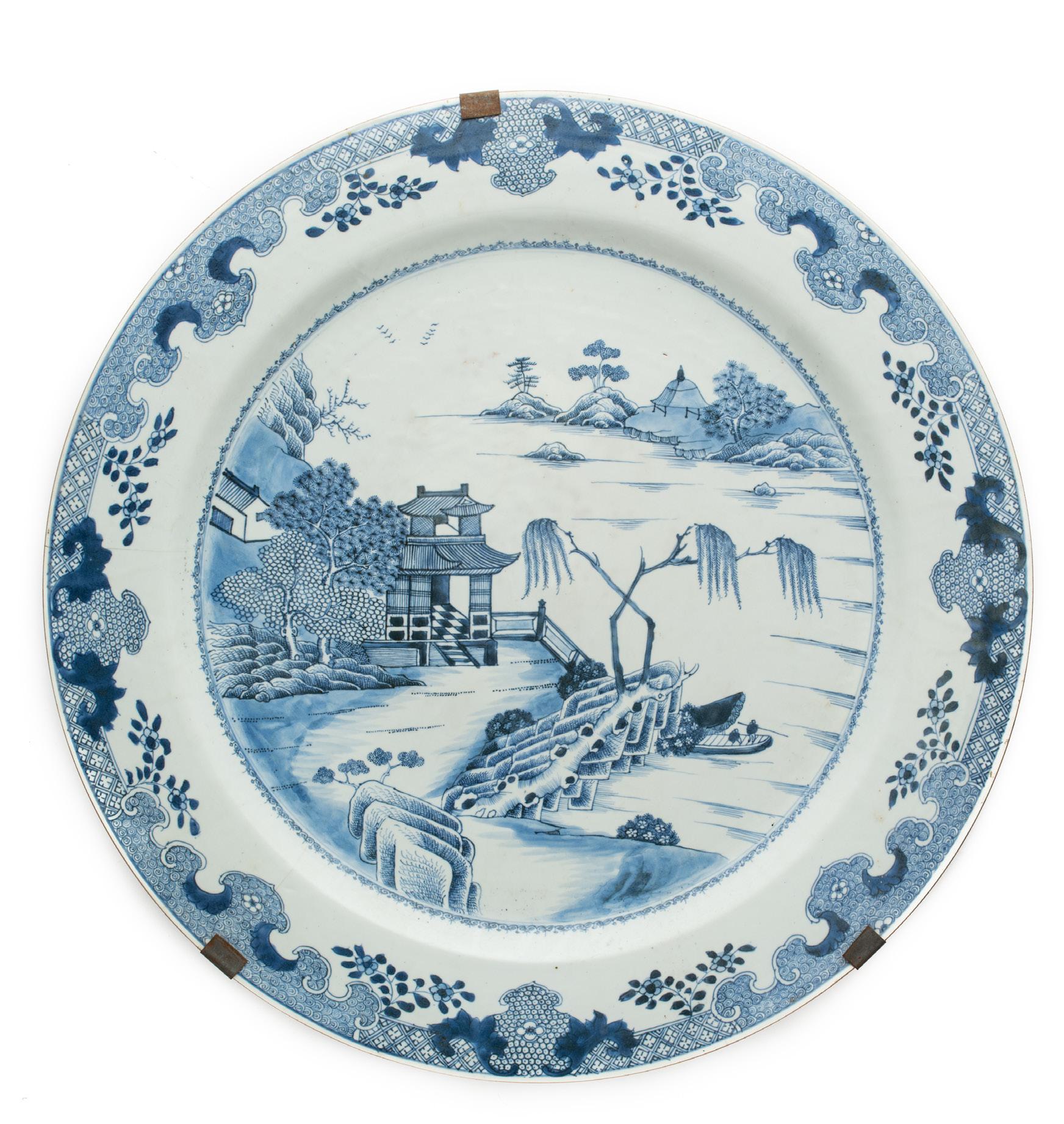
Provenance: Collection of the late Peter Millett (1925-2016)
£600-800
3
10.
A CHINESE BLUE AND WHITE 'DRAGON' BALUSTER VASE, QING DYNASTY, 19TH CENTURY, painted around the exterior with two large scaly dragons in pursuit of a flaming pearl, all above a wave ground and below four high relief lion masks at the shoulder, 37.5cm high; together with a blue and white baluster vase with lug handles and painted with floral sprays (2)

Provenance: Collection of a deceased diplomat, thence by descent.
£200-300
11.
□ A CHINESE BLUE AND WHITE TRIPOD EWER, 'HE', 20TH CENTURY, the compressed globular body rising from three columnar legs to a short neck, set to one side with a handle and to the other with a short tapering spout, painted around the exterior with six Buddhist emblems, wood cover, 31cm long

Provenance: Christies, London, 10 June 1999, lot 625
£80-120
12.
A PAIR OF CHINESE WATER DROPPERS, QING DYNASTY, 19TH CENTURY, each of double peach shape with a domed top pierced with a dragon amidst cloud scrolls, one enamelled in famille rose, the other in famille verte, each 10cm long; together with a sancai-glazed shell, 6.5cm long (3)

Provenance: Collection of a deceased diplomat, thence by descent
£150-250
4
13.
A CHINESE SANCAI 'MONKEY' EWER, QING DYNASTY, 19TH CENTURY, seated on a stylised tree trunk forming the spout and with a small monkey perched on its knees, the left arm forming the handle, the right hand holding a peach, brightly decorated with yellow, green and aubergine glazes, 16.5cm high

Provenance: Collection of a deceased diplomat, thence by descent £150-250
14.
A CHINESE DEHUA FIGURE OF GUANYIN SEATED ON A LION, 20TH CENTURY, Guanyin wearing a long flowing robe open at the neck to reveal an elaborate beaded necklace, the recumbent lion with large bulbous eyes and a bushy tail, 29.7cm high £100-200
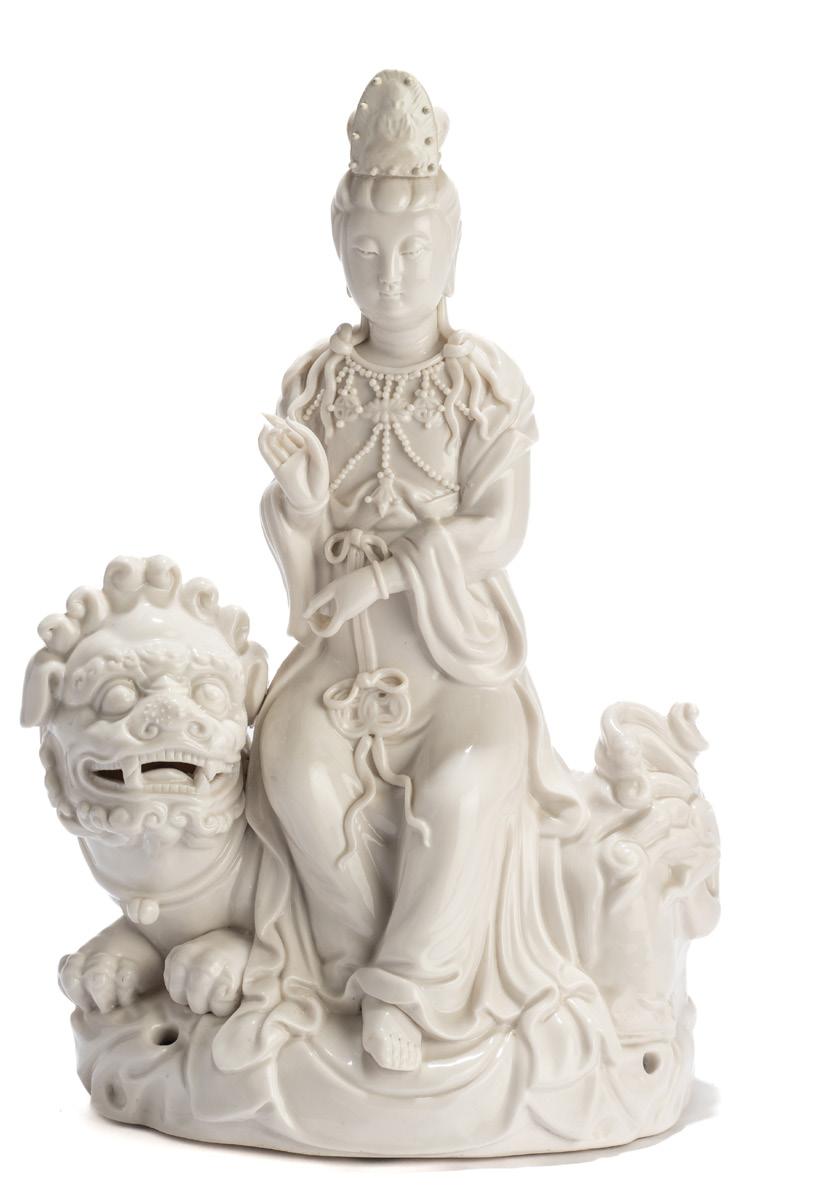
15.
A CHINESE MOONFLASK, LATE 19TH / EARLY 20TH CENTURY, typical form, each side painted with a roundel of a pair of dragons chasing a pearl, various borders throughout and applied chilong figures to the shoulders, 24cm high £60-80


16.
A CHINESE CLOISONNE ENAMEL EWER AND COVER, 20TH CENTURY, the cylindrical body decorated with two Buddhist lions amidst Buddhist emblems and cloud scrolls; together with a blue and white porcelain lobed ewer, cover and warmer, 20th Century, the cloisonné ewer 16.5cm high (2) £80-120
5
17.
A PAIR OF CHINESE LARGE CRACKLEWARE VASES, 20TH CENTURY, decorated with unglazed brown applied chilong and moulded borders, enamelled with battle scenes, 44.5cm high excluding wood stands
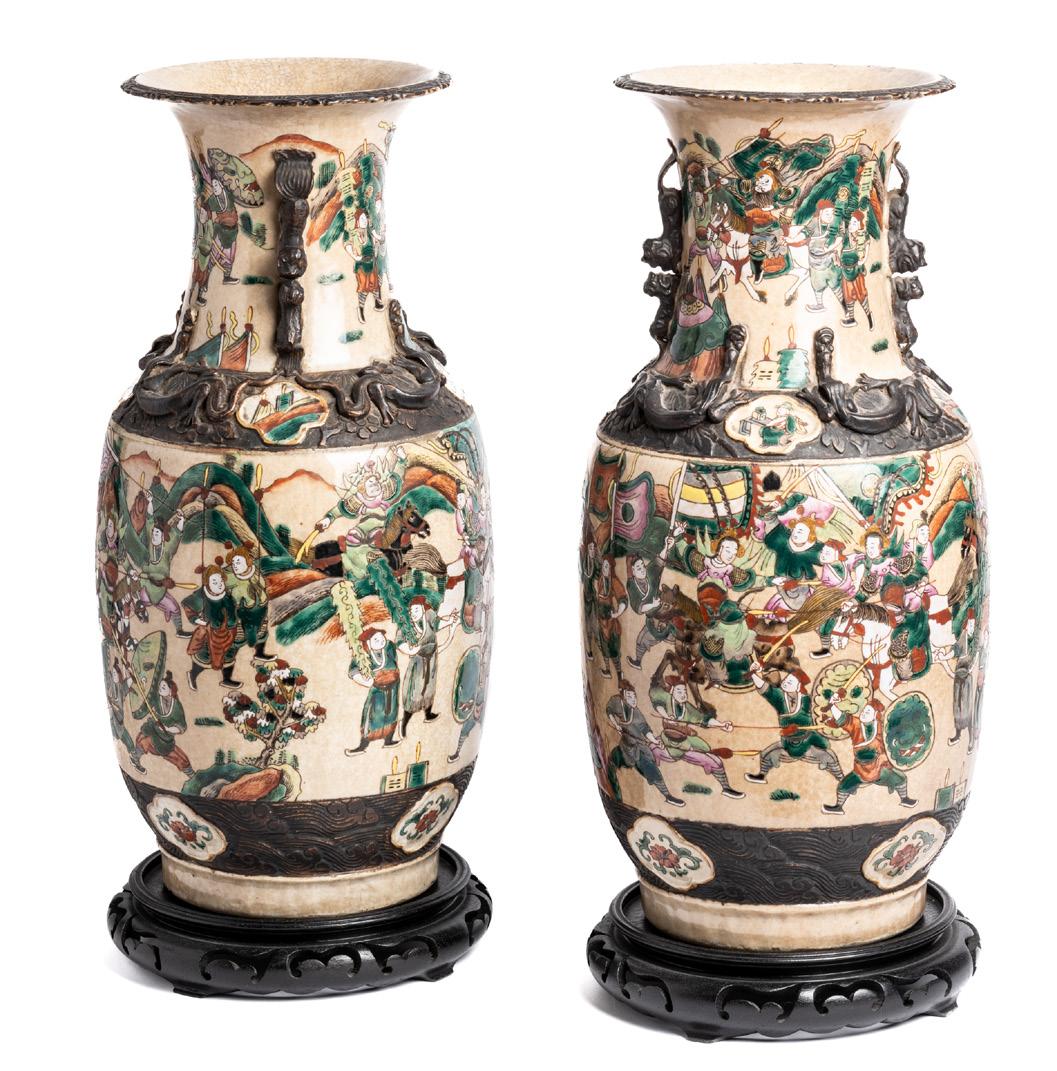
£100-200
18.
A LARGE CHINESE CANTON FAMILLE ROSE
PUNCH BOWL, QING DYNASTY, 19TH CENTURY, the deep U-shaped body rising from a short foot to a slightly flaring rim, brightly enamelled around the exterior and interior with figural panels reserved on a ground of flowers and antiques, 36.5cm diameter; together with a similarly decorated baluster vase and cover, 31.5cm high (2) £300-500
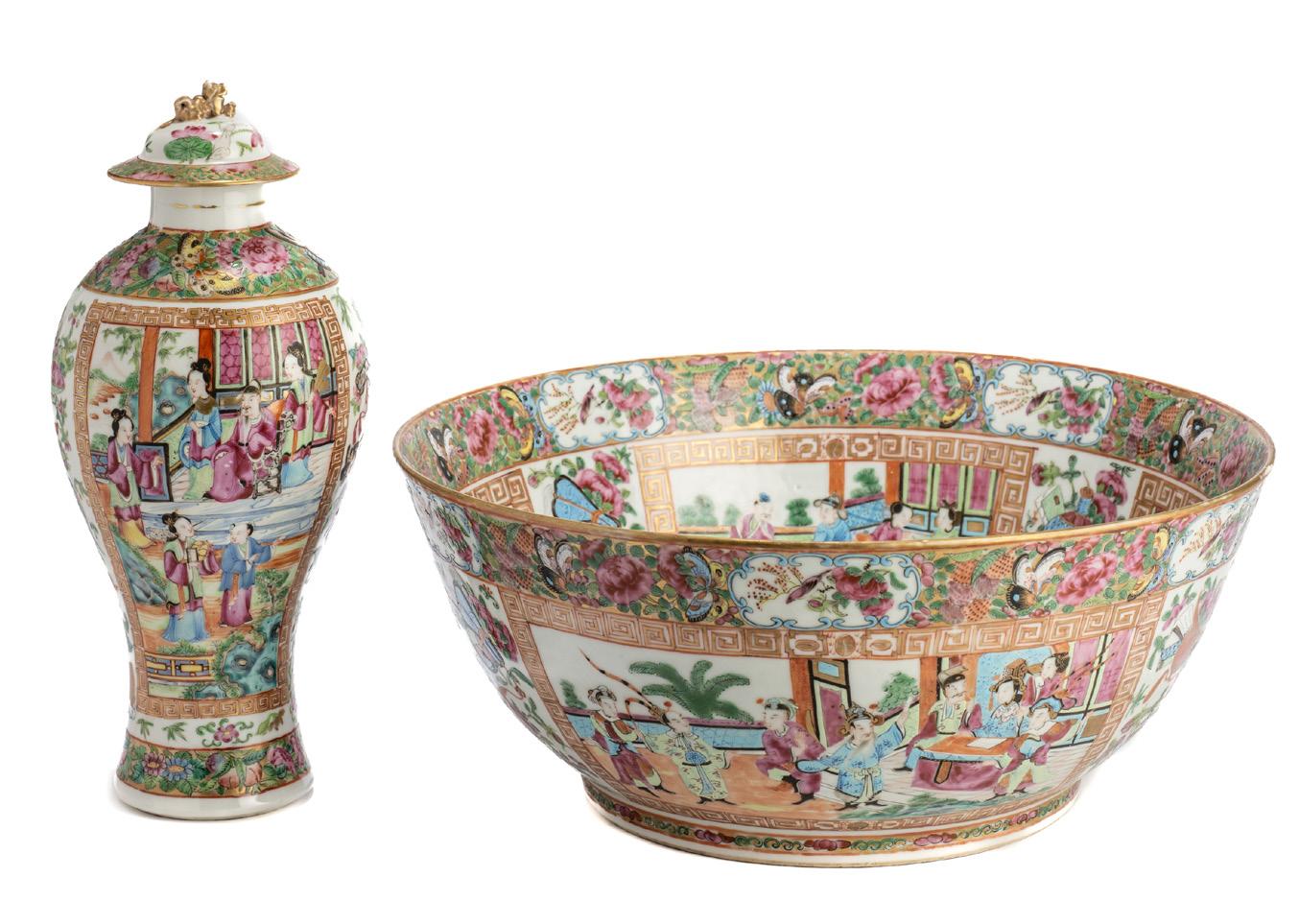
19.
A COLLECTION OF CHINESE BLUE AND WHITE WARES, QING DYNASTY, 19TH CENTURY, comprising: a pair of 'dragon' baluster vases and covers, apocryphal Kangxi marks to base, 31cm high; a small 'prunus on cracked ice' baluster vase and cover; a pair of 'Immortal' baluster vases; a pair of 'Xiwangmu' Queen Mother of the West' baluster vases; a 'Buddhist Lion' bottle vase; and a teapot and cover (9)


£400-600

6
A LARGE PAIR OF CHINESE FAMILLE ROSE BALUSTER VASES MOUNTED AS LAMPS, 20TH CENTURY, each brightly enamelled with pairs of long tailed birds perched on rockwork issuing peony, all between lotus lappets at the base and a ruyi collar at the shoulder, height of porcelain 43.5cm

A CHINESE IRON-RED BALUSTER VASE MOUNTED AS A LAMP, LATE QING DYNASTY, painted around the exterior with gilt Shou characters amidst floral strapwork, 45.5cm high

22.
A CHINESE EMBROIDERED BLUE SILK RANK BADGE OF A PHOENIX, QING DYNASTY, 19TH CENTURY, the bird in flight amidst auspicious emblems and above waves, looking towards the red sun or symbol of the Emperor, all within a keyfret band, framed and glazed, 26cm long
Collection of a deceased diplomat, thence by descent.
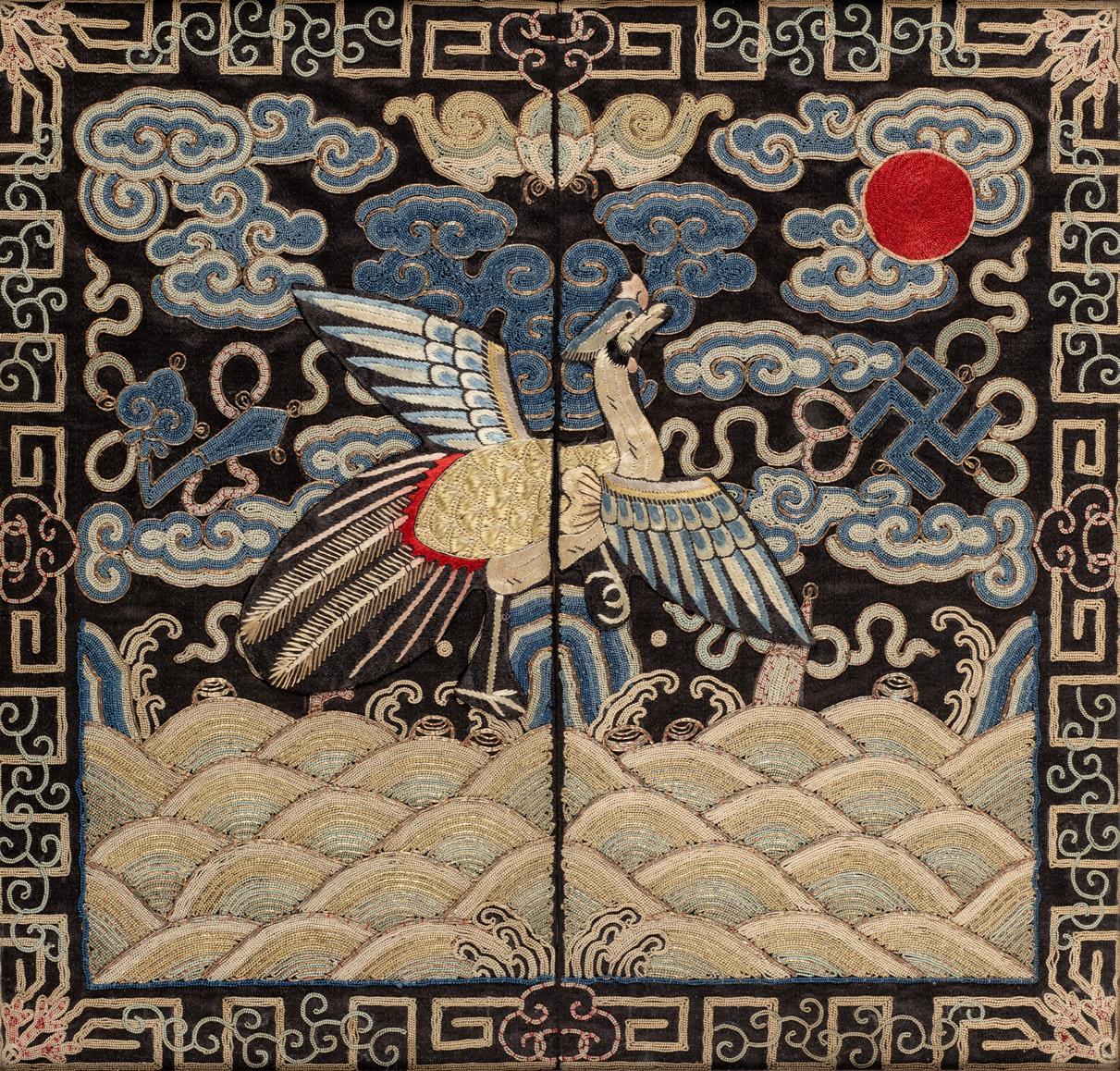
7 20.
£400-600 21.
£100-200
Provenance:
£150-250
23.
□ FOUR QAJAR BORDER TILES, PERSIA, SECOND HALF 19TH CENTURY, underglaze painted fritware, with relief moulded scrolling bird and vine design, the edges with borders of arabesques and bead motifs, 7 x 15.5cm and smaller
£80-120
24.
AN OTTOMAN BORDER TILE, PROBABLY FROM THE DOME OF THE ROCK, JERUSALEM, MID-16TH CENTURY, underglaze painted fritware, of rectangular form, decorated in black, turquoise and cobalt blue with a reversing trefoil merlon design with stylised floral arabesques, thin turquoise bands above and below, 9.4 x 23.4 x 3.8cm

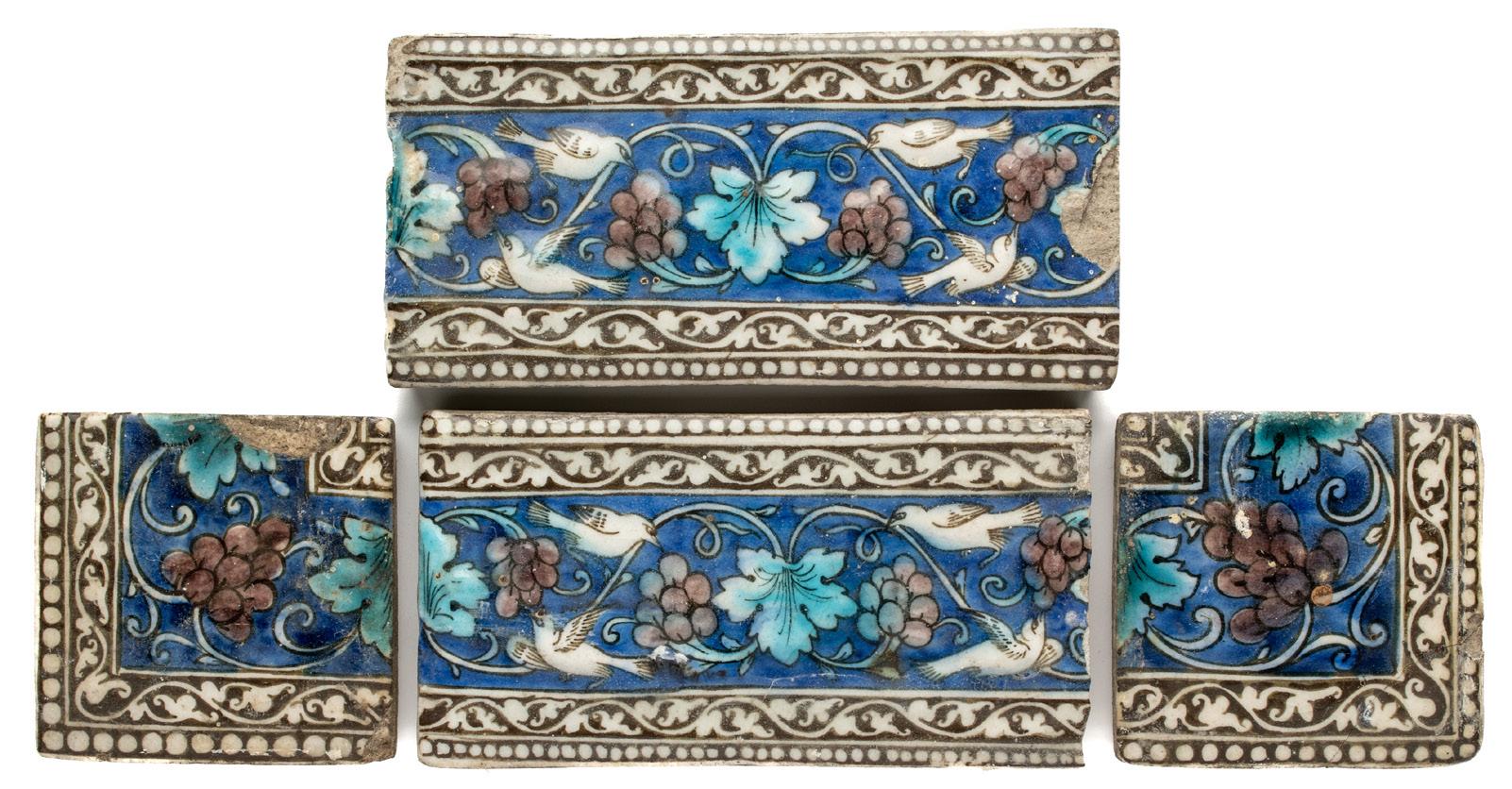
Provenance: Adda Collection, Alexandria, first half 20th century; Christie's London, 31 March 2009, lot 133. Private collection, London
Published: Millner 2015, fig. 6.140, p.306
The distinctive colour palette is characteristic both of tiles on the Dome of the Rock in Jerusalem and of those on several buildings in Aleppo. The characteristic 'apple' green, so readily associated with the Ottoman tiles of Damascus is little seen in either of these other cities. The thickness is unusual but not entirely unknown, and it draws comparisons with a group of similarly decorated thick square tiles attributed to Aleppo (see Millner 2015, fig.6.74, p.274).
£2000-3000
8
25.
painted fritware, the blue and turquoise floral arabesque designs on white ground,

x
a complete tile of the same design in
Victoria and Albert Museum, see inv.
26.
DAMASCUS BORDER TILE, OTTOMAN SYRIA, 1560-70, underglaze painted fritware, with scrolling arabesque medallions intertwined with stylised leaves
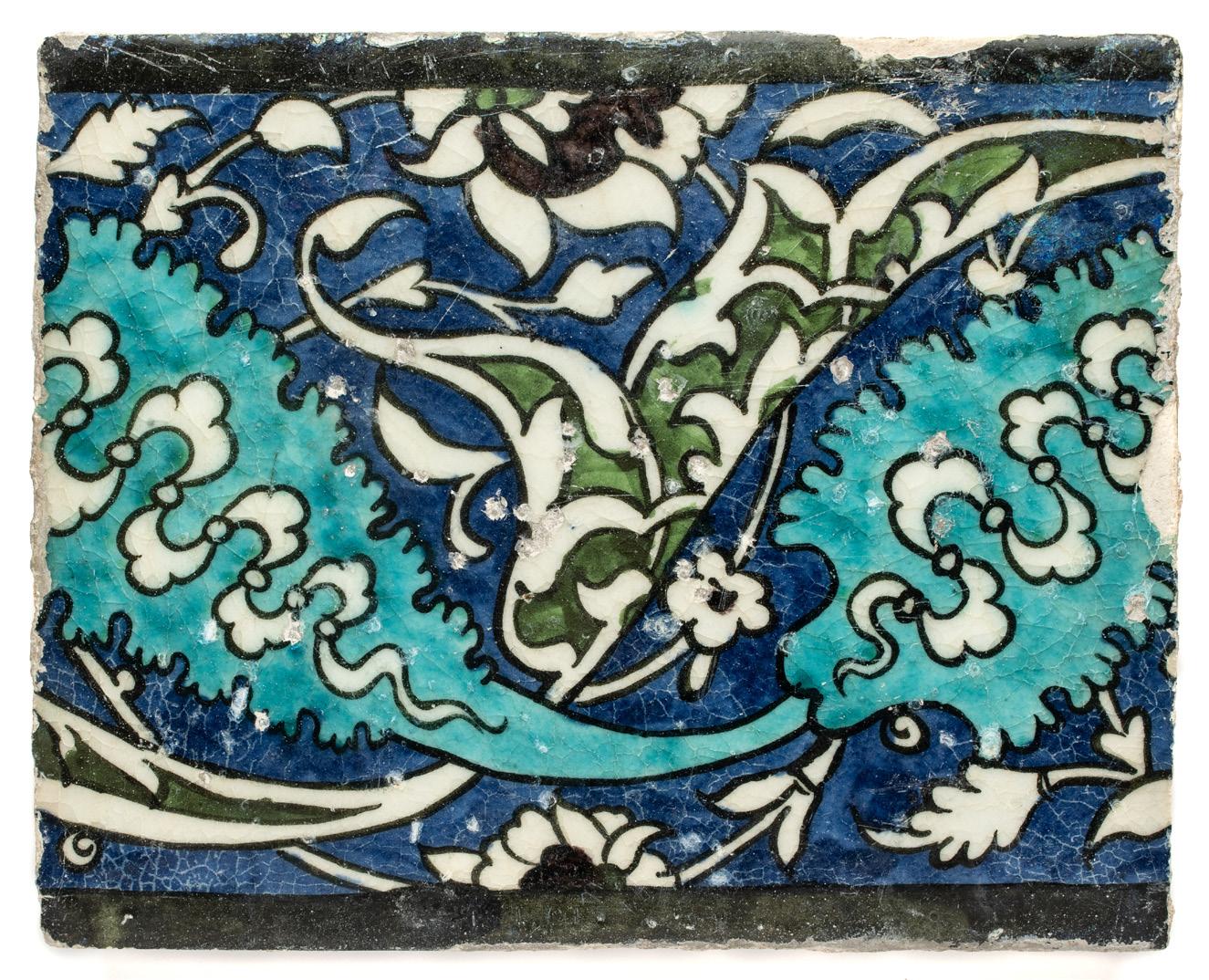
undulating cloud motifs, black bands along the edges, 15 x 19cm
Provenance: Private Collection, England; Sotheby's London, 14 October 1999, lot 573 (part). Another tile from the same lot at Sotheby's was sold by a different vendor in these rooms on
November 2020, lot 263. A considerable number of border tiles of this design can be
Hall at Leighton House.
27. (illustrated
A GLAZED EARTHENWARE BOWL, PESHAWAR REGION, PAKISTAN, CIRCA 1900, underglaze painted on cream slip with a stylised flower, 9cm high, 30cm diam.
9
AN IZNIK HEXAGONAL TILE FRAGMENT, OTTOMAN ANATOLIA, CIRCA 1540, underglaze
15.5
10cm For
the
no. CIRC 32-1953 £200-300
A
enclosing
18
seen in the Arab
£400-600
online)
£40-60
28.
A QAJAR PEN BOX (QALAMDAN), PERSIA, 19TH CENTURY, painted and lacquered papier-mache, of long rectangular form, with sliding tray compartment, the convex top decorated with a pair of oval medallions depicting maidens, with rosebush motifs in between, the sides similarly decorated, 3.5 x 23.5 x 4cm
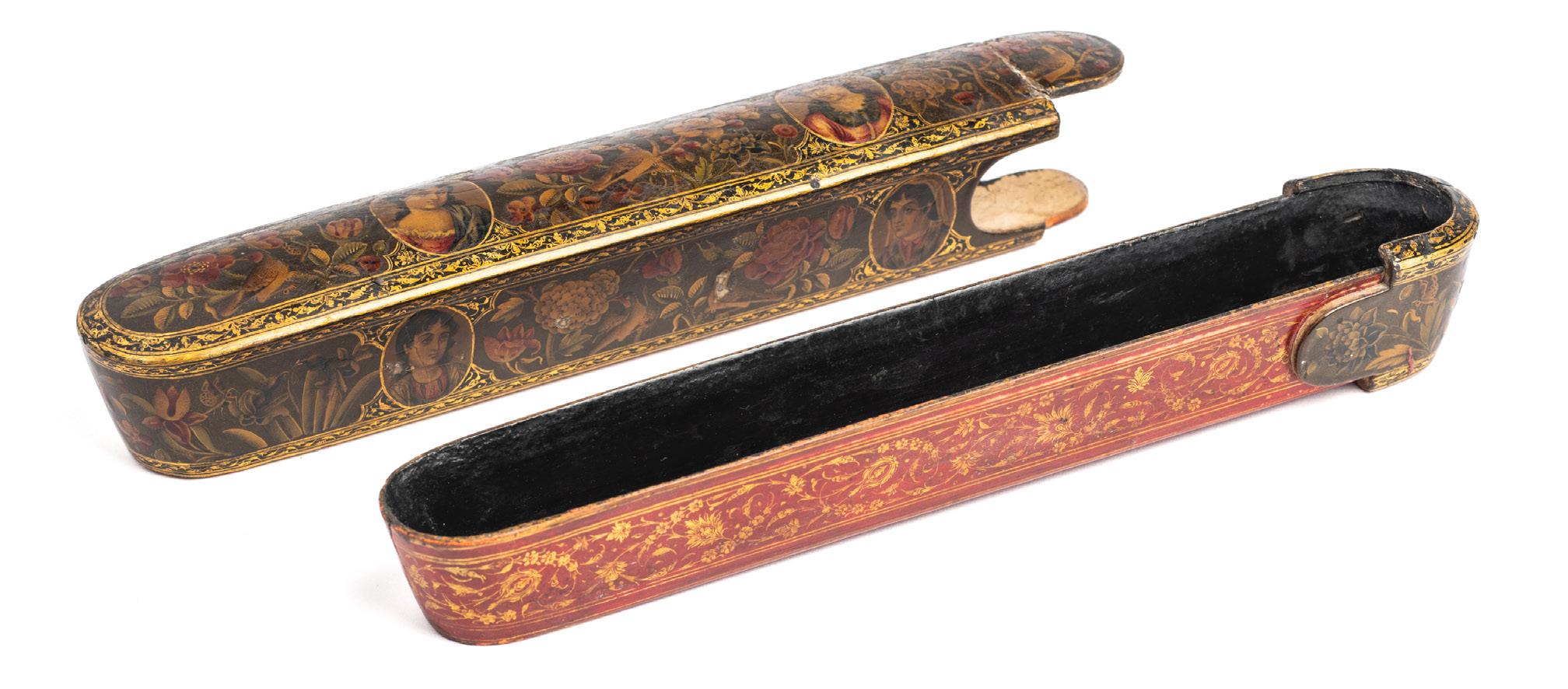
Provenance: Khakshouri Family, Zurich, formerly of Urmia, Iran £300-500
29.
RUSTEM KILLS THE WHITE DIV, PERSIA, CIRCA 18TH CENTURY, a scene from Firdausi's Shahnama, gouache with gold on paper, framed, 16.5 x 15cm (inside mount)
Provenance: Old label on the reverse from Galerie Joseph Soustiel, 146 Boulevard Haussman, Paris £600-800

10
30.
A MUGHAL QUR'AN, NORTHERN INDIA, DATED AH 1098 / APRIL-MAY 1687, COPIED BY ABD AL-LATIF BIN MULLA, approximately 559 folios, main Arabic text in black naskhi script, Persian translation in red nastaliq, commentary in margins in black nastaliq, further occasional margin notes in red, later olive leather binding, embossed in gold, 33 x 24cm (folios)
£500-800
31.
AN EDITION OF THE BUSTAN OF SA'DI, INDIA, DATED AH 1275 / 1858 AD, Persian text in nastaliq script, main text in black ink, headings in red, red leather binding, 25.5 x 15.5cm
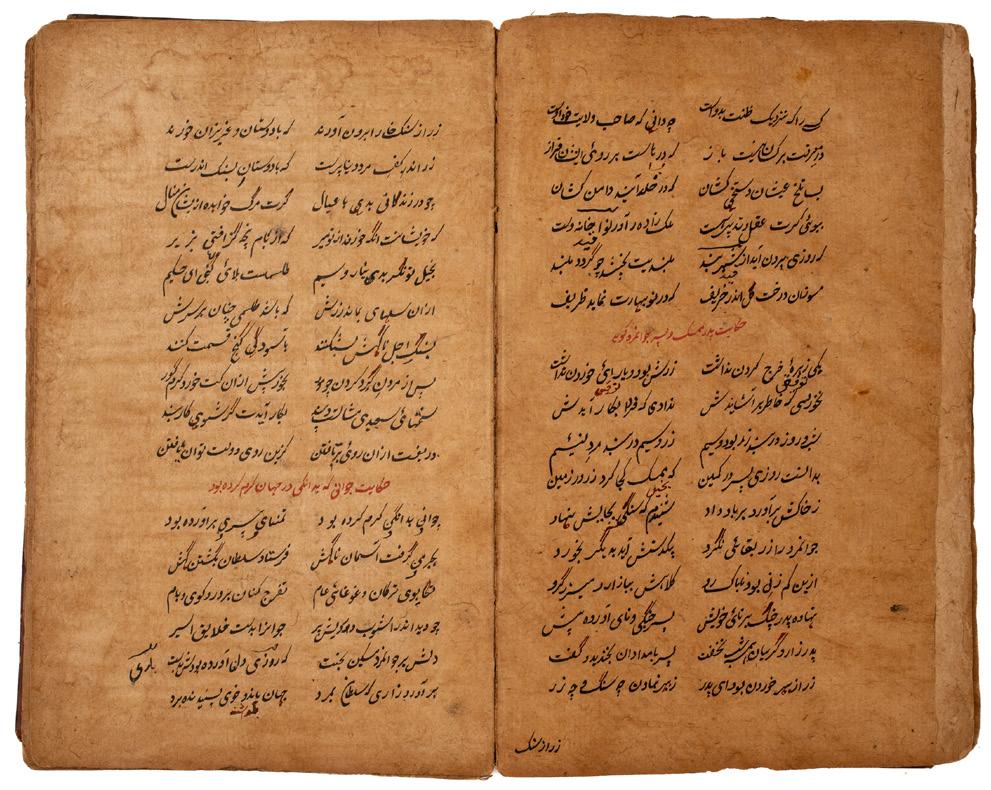
£120-180

11
32.
A PAIR OF PARCEL GILT BRONZE THANGKA POLE ENDS, TIBET, 19TH CENTURY, of domed form decorated with a dragon in relief, the sockets with stylised tree design, surmounted by a lotus border, 11cm long; 11cm diam. £150-250

33.
AN IRON RITUAL DAGGER (PHURBU), TIBET, 15TH/16TH CENTURY, with three sided blade issuing from a makara, the handle with twin knot motifs, the finial in the form of a head of Mahakala, 26cm long £200-300

34.
A BUDDHIST RITUAL DAGGER (PHURBU), TIBET, 19TH CENTURY, bronze, with three sided blade issuing from a makara, the handle in the form of a vajra, the with triple head of Mahakala and further half-vajra at the top, 36cm long £80-120

12
35.
TWO HIMALAYAN CONTAINERS, 19TH CENTURY, comprising a Tibetan copper amulet box with brass overlaid scrollwork design, and a Nepalese brass scent bottle on lotus base with Mughal style ribbed body, later chain, 13 x 10.5 x 3.5cm; 8.4cm high
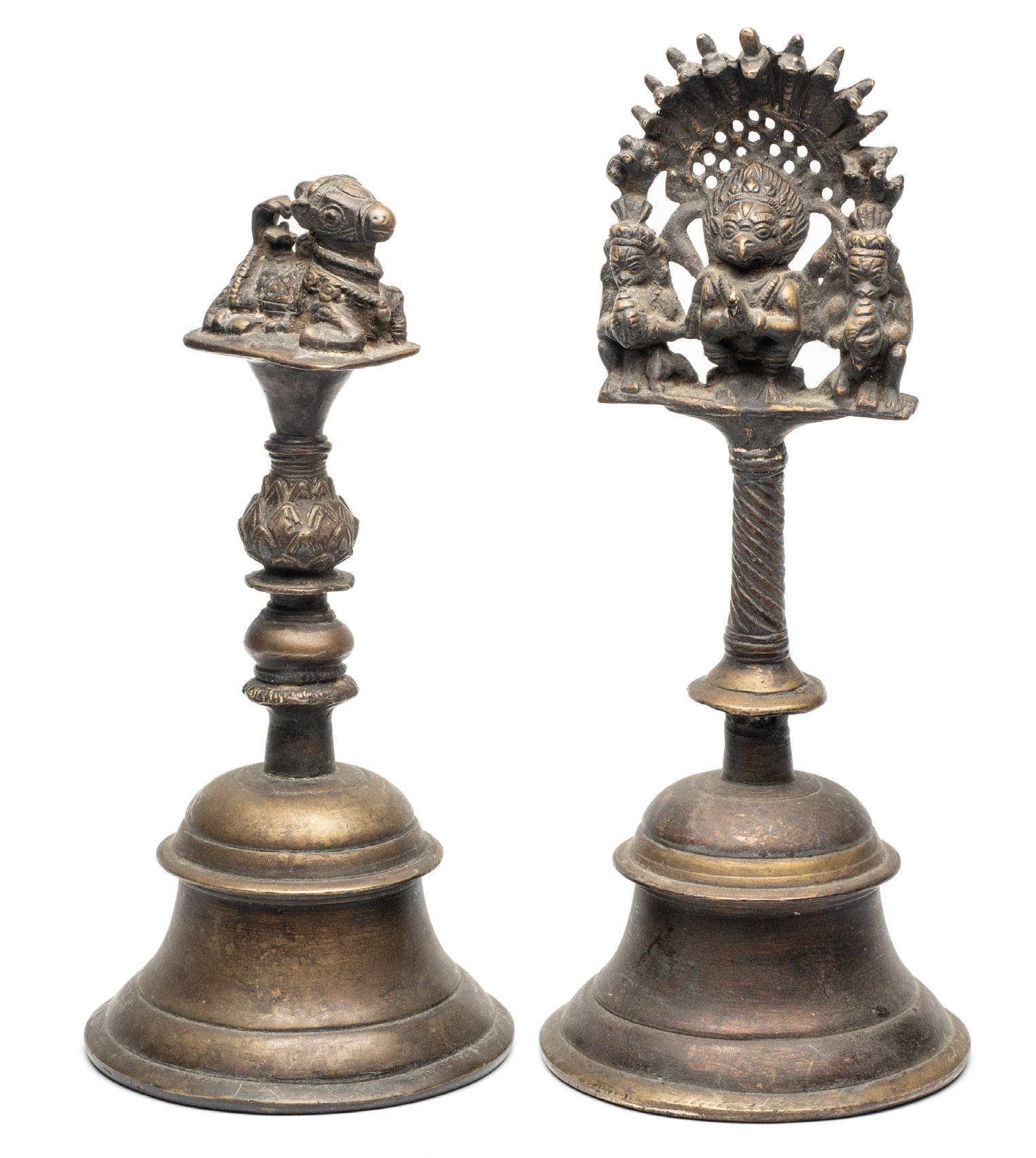
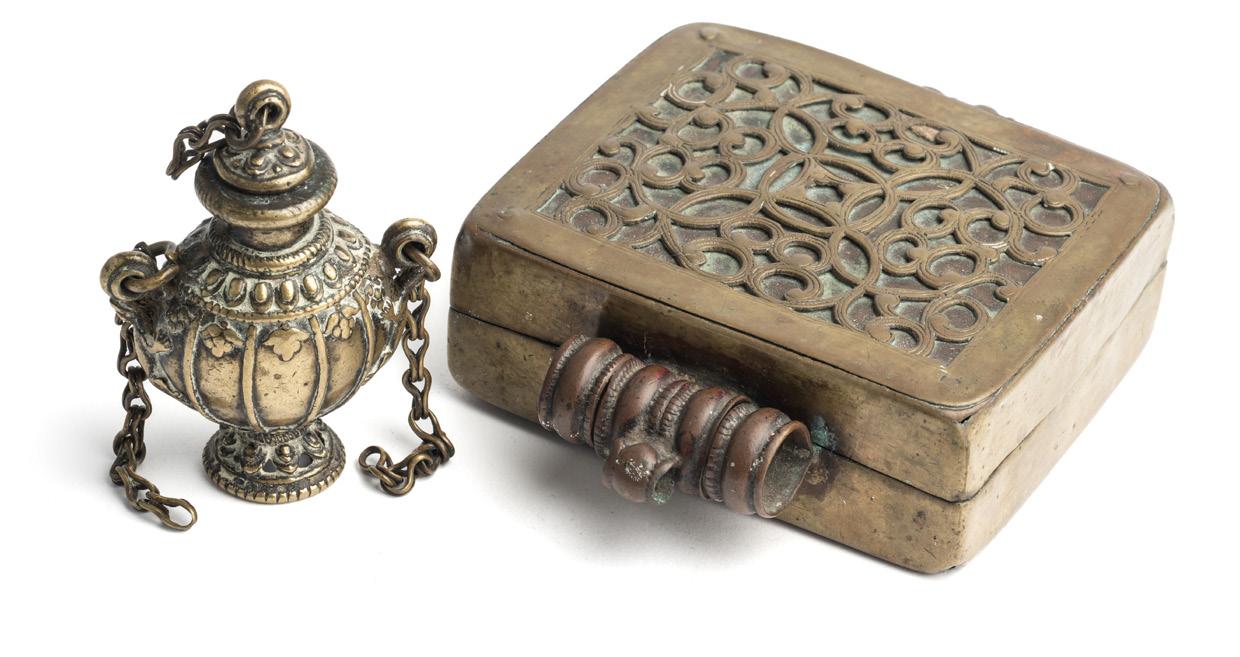
Provenance: Private collection, Western England
For a near identical Nepalese container, see Bussabarger and Robins 1968, p.75 £120-180
36.
A BRONZE RITUAL BELL, NEPAL, 19TH CENTURY, the segmented handle with lotus decoration, surmounted by finial in the form of Nandi Bull, 27.5cm high £200-300
37.
A BRONZE RITUAL BELL, NEPAL, 19TH CENTURY, the handle decorated with spiral design, surmounted by finial in the form of Garuda under an eleven-headed naga canopy, flanked by musicians blowing conch shells, 32cm high £200-300
13
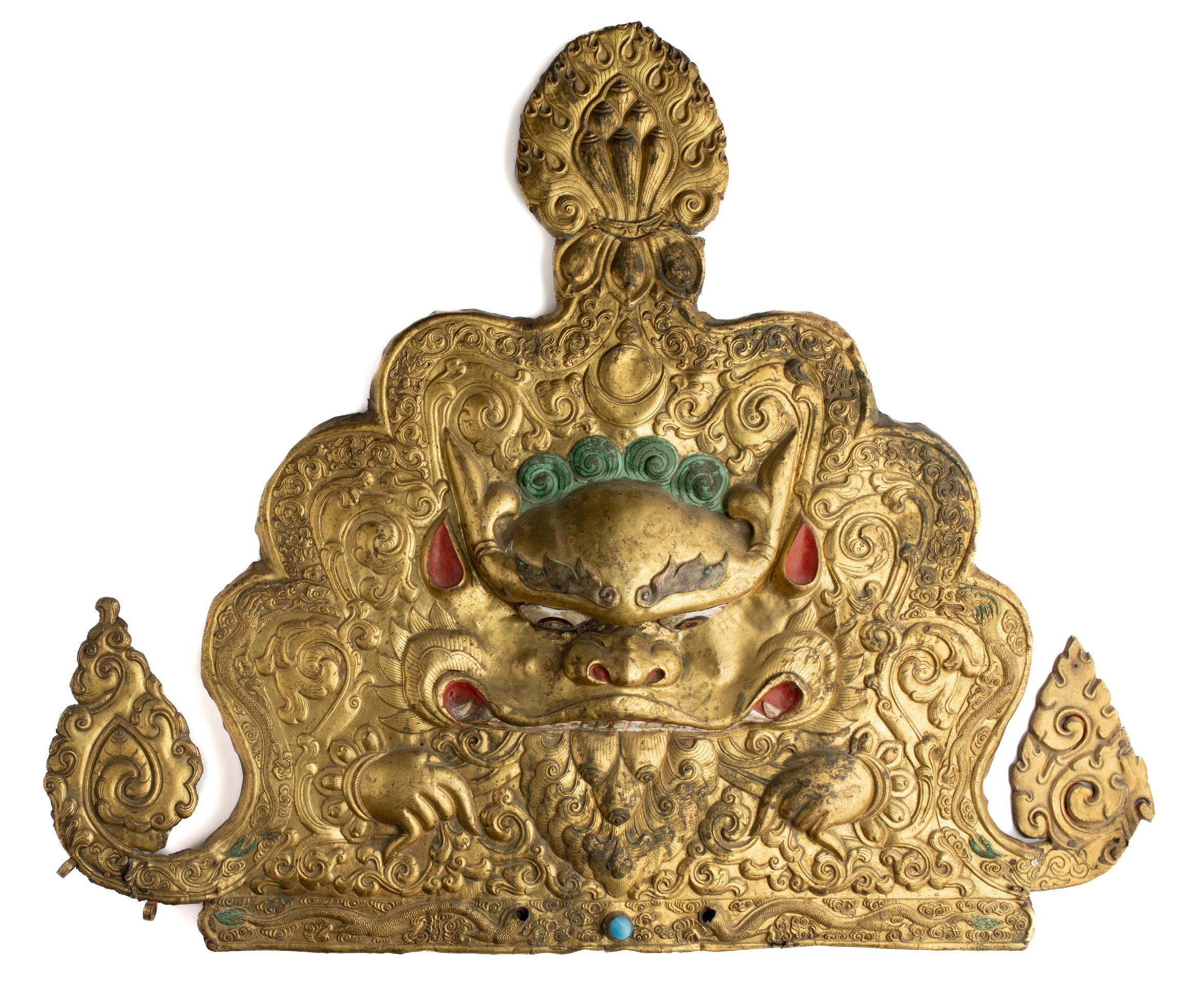
14 38. A COPPER GILT PANEL FROM A LARGE SHRINE, TIBET, 16TH / 17TH CENTURY, cusped arched form, the repousse relief design depicting a kirttimukha amidst intricate scrolls, bordered with dragons, further scrolls and the eight auspicious emblems, the top with flaming jewels motif, the fierce face with painted details, set with a blue glass bead at the bottom, 69cm high; 82cm wide £4000-6000
39.
A COPPER REPOUSSE FRAGMENT FROM A SHRINE, TIBET, 14TH / 15TH CENTURY, the raised relief gilt and the ground painted red, the central section with two scenes within an undulating lotus stem, the lower depicting Buddha with two citipati, the upper depicting Buddha with three attendants, one holding a parasol, flanked by bands of beadwork and flames on the left side, lotus petals on the right, 30.5 x 22cm £2000-3000
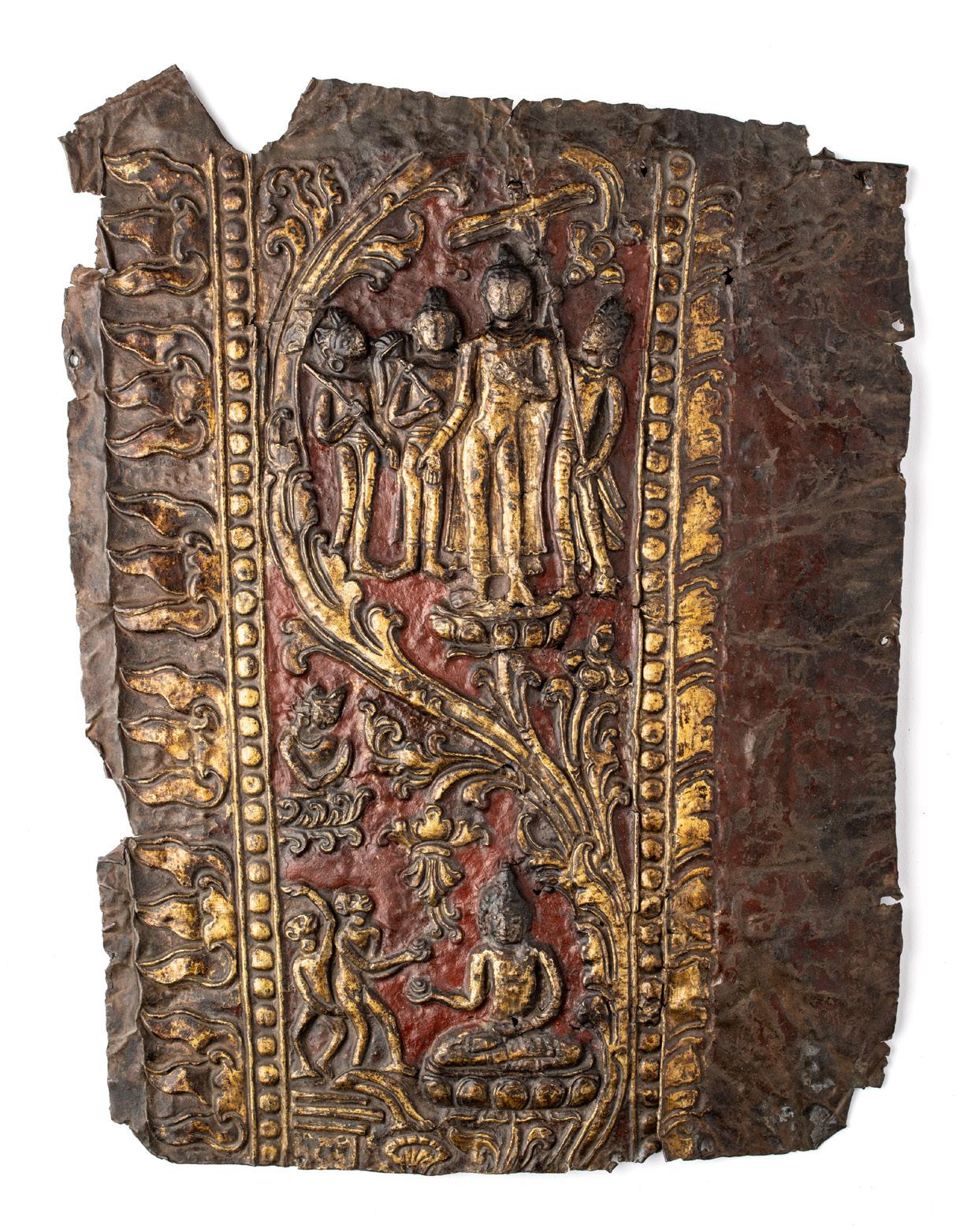
40.
A COPPER AND SILVER ALLOY AMULET BOX (GAU), TIBET, 19TH CENTURY, of lobed arched form, the silver front panel decorated with seven of the auspicious Buddhist symbols around the opening, a kirttimukha below, on scrolling foliate ground, 13.3 x 11.3 x 5.2cm
£600-800

15
41. A PAIR OF COPPER-GILT RELIEFS OF LIONS, TIBET, 16TH/17TH CENTURY, probably from a shrine, each with bulging eyes, protruding fangs and matted mane, two piercings on body for attachment 13 x 18 x 5cm


2000-3000
42. THREE TIBETAN BRASS OBJECTS, CIRCA 1900, comprising a ‘singing’ bowl, a pair of ritual cymbals strung with leather and an offering bowl, the domed cover with coral finial, 17.5cm (diam. of bowl, and smaller)
£120-180
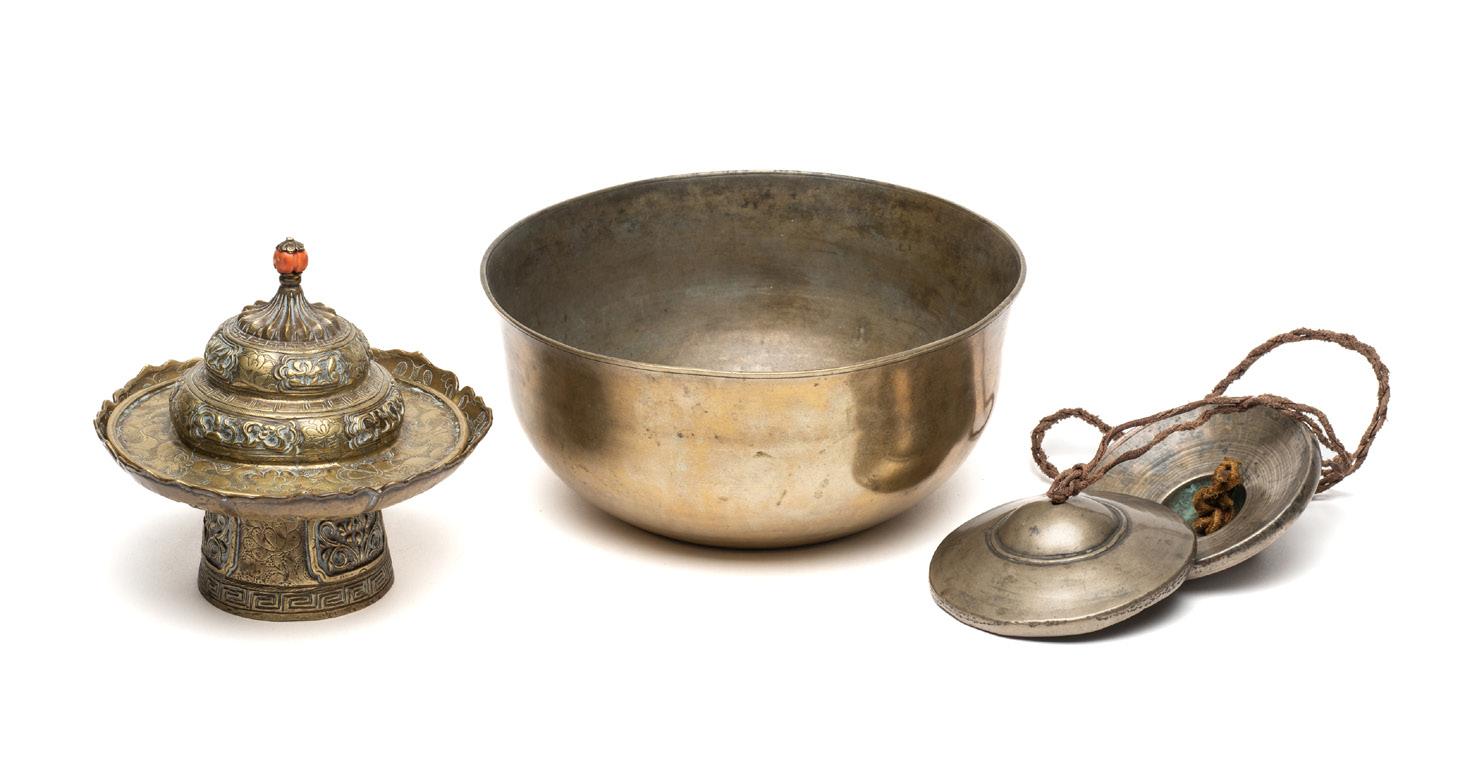
16
£
43.
A BRONZE FIGURE OF AMITAYUS, TIBET, CIRCA 15TH CENTURY, seated in padmasana on a double lotus throne, his hands in dhyana mudra, holding the overflowing vase of immortality, wearing a five-leaf crown, disc earrings, armbands and necklace, set with turquoises, 13cm high £4000-6000

17
44.
A BRONZE FIGURE OF VAJRAPANI, TIBET, 15TH / 16TH CENTURY, stepping to the right on a pierced lotus base, his right hand raised holding a vajra, his left in karana mudra, traces of gilt and his face and hair with traces of red pigment, 13.5cm high Provenance: Collection of the late Joost Slingerland, Yorkshire, acquired Aura Antiques, London, 1 April 2000. The original receipt is sold with this lot.

£3000-4000
45.
A SMALL GILT BRONZE FIGURE OF MANJUSRI, TIBET, CIRCA 16TH CENTURY, the Buddhist deity seated in padmasana on a double lotus throne, his right hand raised wielding a sword behind his head, his left holding the stem of a lotus with a book resting on the top, sealed, 8cm Provenance: Collection of the late Joost Slingerland, Yorkshire, acquired Sebastiano Barbagallo, London 1 June 2000. The original receipt is sold with this lot.
£800-1200

18
A PARCEL GILT BRONZE FIGURE OF SADAKSARI, TIBET, 16TH CENTURY, the four-armed Buddhist deity, seated on a double lotus throne, his primary hands clasped in anjali mudra, his upper hands holding mala and padma, his tall headdress with diminutive figure of Aksobhya, his face and crown with traces of pigment and cold gilding, remains of relics inside, 15cm high
Provenance: Collection of the late Joost Slingerland, Yorkshire. Acquired from Frederick Joy, London, 9 August 1999

19 46.
£3000-4000
47.
A SINO-TIBETAN GILT BRONZE FIGURE OF A MAHASIDDHA, 19TH CENTURY, seated on a double lotus throne with legs loosely crossed, his right hand raised in karana mudra, 11.7cm Provenance: Collection of the late Joost Slingerland, Yorkshire.
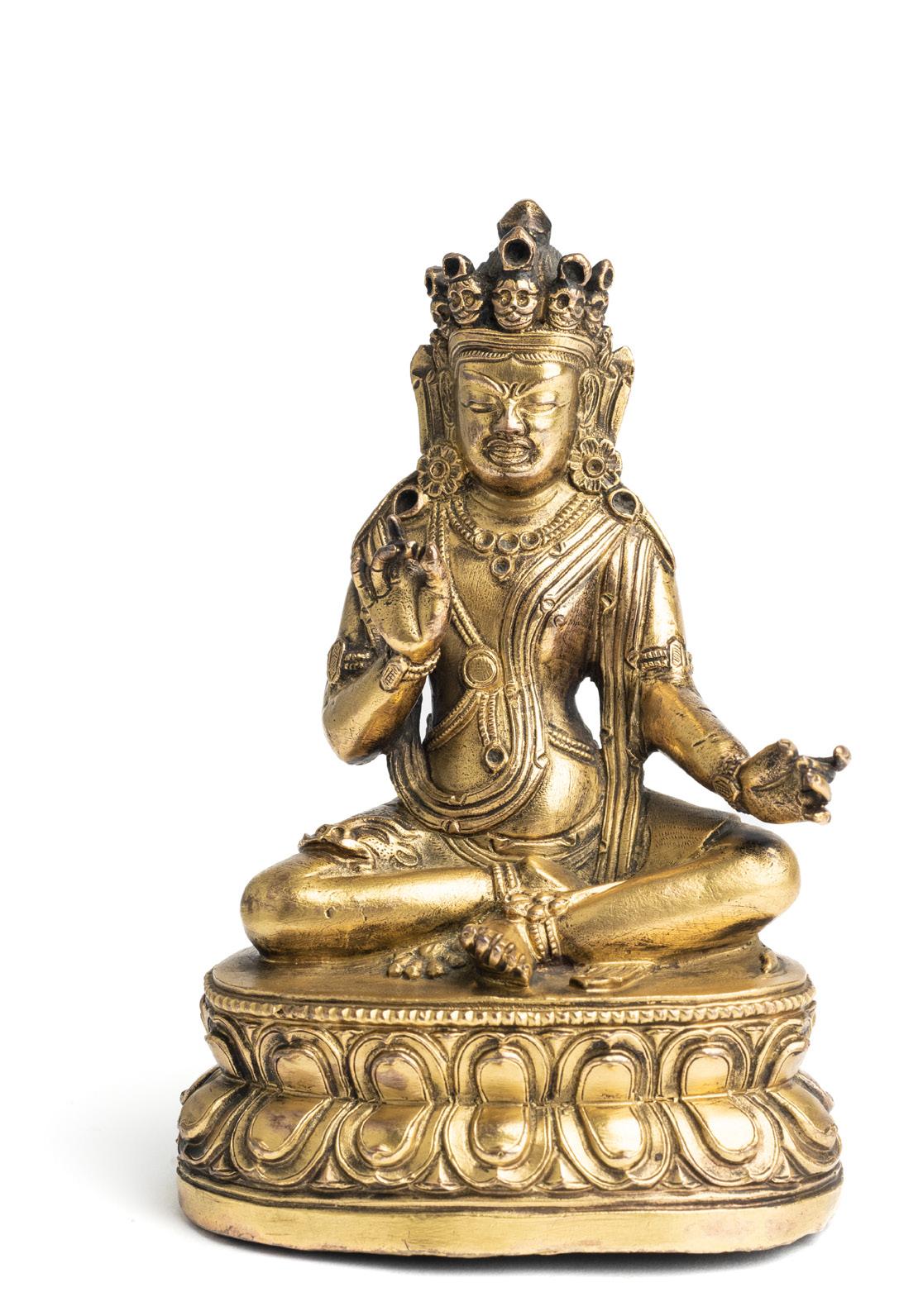
£700-900
48.
A TSAKLI DEPICTING VAJRAVARAHI, TIBET, CIRCA 18TH CENTURY, pigment on cloth, red border, mantras in Tibetan script on the reverse, framed, 16 x 12.5cm approx. £100-150
49.
A THANG-KA DEPICTING PADMASAMBHAVA, TIBET, 17TH CENTURY, pigment with gold on cloth, the central figure seated within a flaming aureole, surrounded by smaller figures of Buddhist deities and lamas, including Mahakala, Vajrapani and Tsong ka Pa, bordered with remains of silk mount, framed, 54 x 36.5cm £200-300


20
50. A MEDICAL CHART, TIBET, 20TH CENTURY, ink on paper, depicting a human body with parts labelled in Tibetan script, surrounded by further heads and a male and female figure, each annotated, 61 x 51cm

51. A PALA GREY STONE FRAGMENTARY STELE DEPICTING TARA, BIHAR, INDIA, 10TH-11TH
CENTURY, seated in lalitasana on a lotus throne, her right hand in varada mudra, her left holding the stem of a lotus, her right foot resting on a further lotus, a diminutive devotee below, further figures of female deities to her right, four lines of devanagari text on the reverse, mounted, 19cm high

21
£600-800
£1000-1500
52.
A GANDHARA GREY SCHIST PALETTE, NORTH-WESTERN PAKISTAN, 3RD/4TH CENTURY, of flat kidneyshaped form, with raised lip, carved in relief with a snake, a frog and two ducks, together with A terracotta relief plaque, depicting a crowned royal couple, 12.8; 7.5cm (2)

Provenance: Private collection, Western England
£80-120
53.
A SMALL GREY SCHIST RELIEF FRAGMENT, KASHMIR, 8TH / 9TH CENTURY, depicting the upper portion of a goddess, probably Parvati, under a lobed arch, holding a mirror and a leafy stem holding a water-pot, wearing large earrings and three leaf crown, 8cm high £200-300

54.
A SMALL GREY SCHIST RELIEF FRAGMENT, KASHMIR, 8TH / 9TH CENTURY, depicting a female chauri bearer, her body flexed, looking up to her left, 12cm high

£200-300
55. (illustrated online)
A SMALL BRONZE SHRINE DEPICTING TWO WARRIORS, WESTERN DECCAN, INDIA, CIRCA 18TH CENTURY, each holding sword and shield, standing erect on either side of an arch, 7.4cm high Provenance: Private collection, Northern England. Acquired by the vendor's mother in the 1950s.

£80-120
56.
A FOLK BRONZE FIGURE OF DURGA SLAYING THE BUFFALO DEMON, WESTERN DECCAN, 18TH / 19TH CENTURY, the eight armed goddess wielding various weapons standing on the decapitated buffalo while stabbing the demon which emerges, on raised, separately cast base, 17cm high
Provenance: Private collection, England, thence by descent.
£150-250
22
57.
TWO BRONZE FIGURES, 19TH / 20TH CENTURY, comprising a Nepalese figure of a female trumpeter, and a small South Indian bronze figure of Vishnu, 13.5cm; 9.5cm high


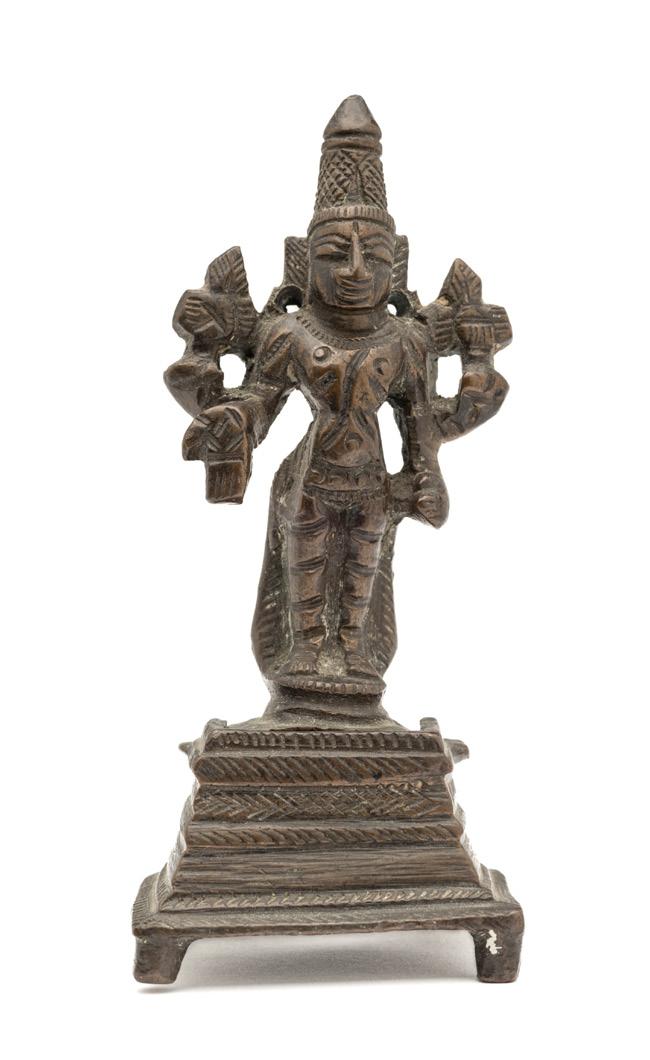
Provenance: Private collection, England, thence by descent.
£100-150
58.
A LARGE BRONZE GROUP DEPICTING SIVA AND PARVATI ON NANDI BULL, WESTERN DECCAN, CIRCA 18TH CENTURY, the four armed god holding a rosary, and axe and a trident(?), his lower left hand holding his consort, who has a lotus in her left hand, the couple sheltered by a seven headed cobra under an arched prabha, their vehicle with pronounced horns, blanket and three necklaces 41cm high
Provenance: Private collection, England, thence by descent.
£1200-1500
23
59.
A SHRINE DEPICTING KRISHNA VENUGOPALA, SOUTH INDIA, 19TH CENTURY, the four-armed god playing the flute, his upper hands holding cakra and sankha, flanked by a pair of gopis dancing to his music, while a pair of cows listen below 23cm high

Provenance: Private collection, England, thence by descent. £300-400
60.
A FRAGMENTARY BRONZE FIGURE OF DURGA SLAYING THE BUFFALO DEMON, PROBABLY KARNATAKA, WESTERN DECCAN, INDIA, 19TH CENTURY, the eight-armed goddess with remaining hand holding her trident, with protruding fangs, and tall flaming headdress, her necklace with floral pendant 21.5cm

Provenance: Private collection, England, thence by descent. £150-200
61.
A SMALL SIVA SHRINE, SOUTH INDIA, 19TH CENTURY, bronze, the square platform on lotus base, with a yoni-lingam at one end, sheltered by a five headed naga cobra canopy, flanked by seated female chauri bearers, with figures of Nandi, Ganesha and a further cobra at the opposite end, engraved with sun and moon emblems, 6.5 x 8.5 x 8.5cm
Provenance: Private collection, England, thence by descent. £150-200
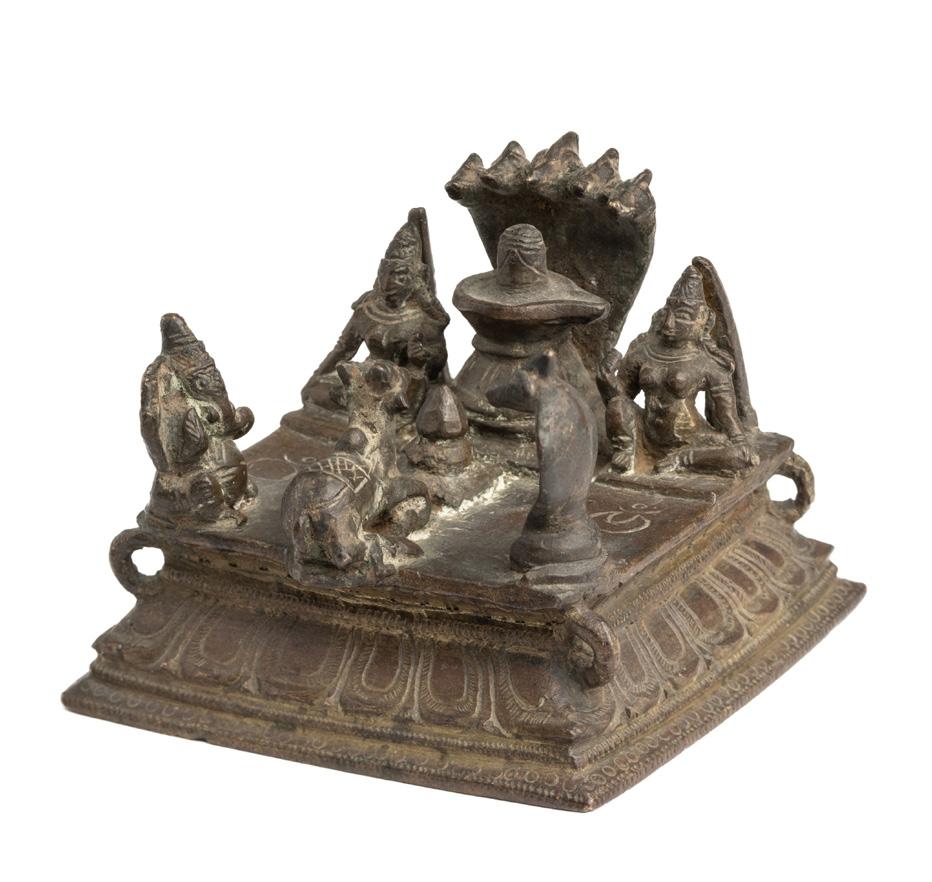
24
62.
A SMALL FRAGMENTARY BRONZE FIGURE OF A GODDESS, SOUTH INDIA, 16TH/17TH CENTURY, the four-armed figure seated in lalitasana, her head surrounded by a serrated halo, with silver inlay, together with A Back Plate from a Bronze Shrine, Western Deccan, India, 18th / 19th Century, 4.5cm; 36 x 26.5cm

Provenance: Private collection, England, thence by descent.
£120-150
63.
AN ASSEMBLED BRONZE GROUP, WESTERN DECCAN, CIRCA 18TH CENTURY, comprising a four-armed figure of Vishnu(?) seated with his consort, a figure of Nandi Bull, with bell hanging from his neck and a dimunutive lingam at his feet, and a bronze base and openwork prabha, with five headed cobra and kirttimukha finial, 42cm high

Provenance: Private collection, England, thence by descent.
£1000-1500
25
64.
A JAIN BRONZE FIGURE OF AMBIKA, WESTERN INDIA, CIRCA 16TH CENTURY, standing in tribhanga within an arched shrine, holding her child in her left arm, a lotus stem in her right, a diminutive lion and further child at her feet, a seated jina above, indistinct inscription on the reverse, 11cm high Provenance: Private collection, Western England £300-400
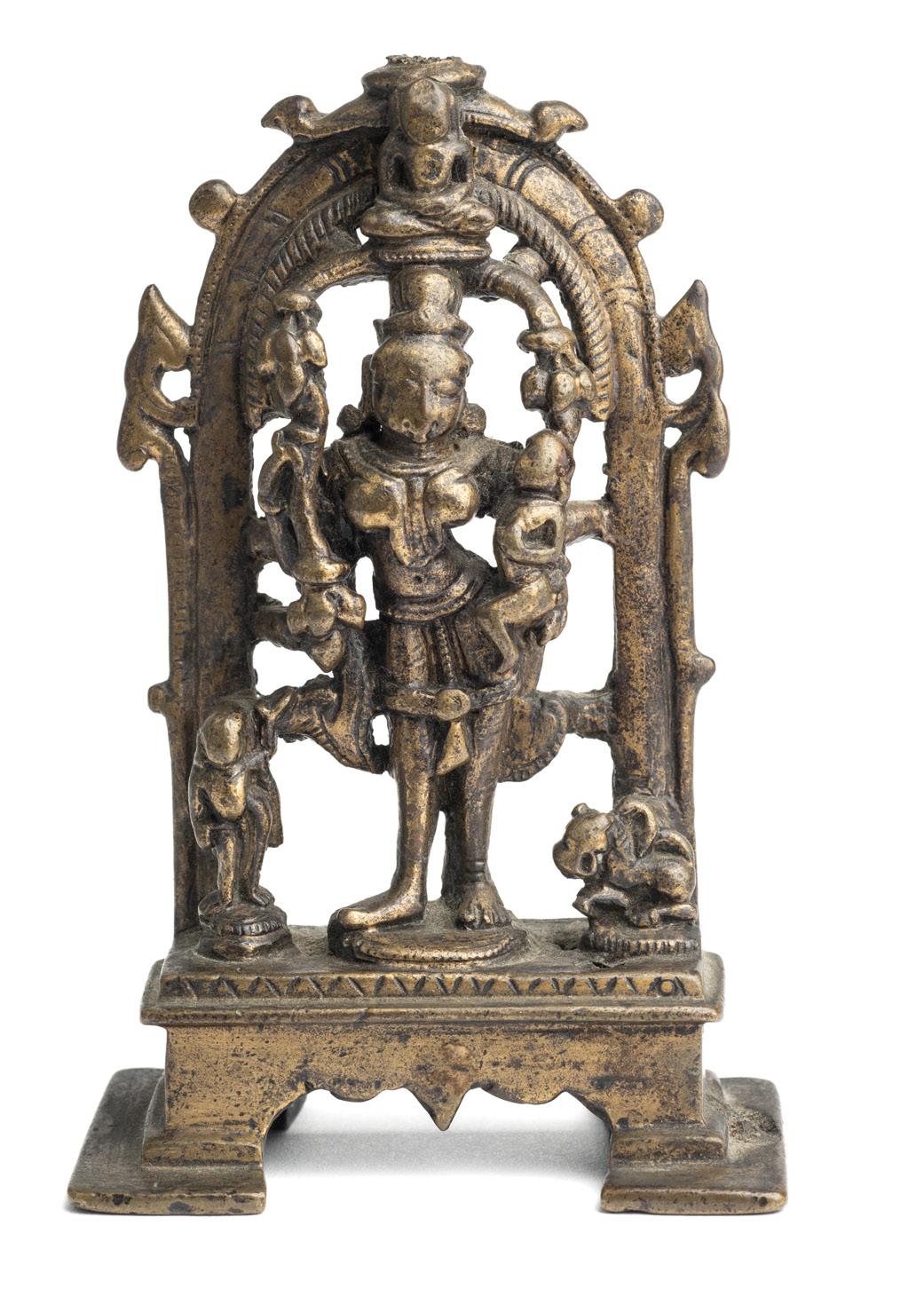
65.
A SMALL BRONZE FIGURE OF YASHODA AND KRISHNA, PROBABLY CHOLA, SOUTH INDIA, 11TH/12TH CENTURY, the goddess seated on a mound, holding the child deity to her breast, 5.5cm high

Provenance: Private collection, Western England £120-180
66.
A BRONZE FIGURE OF BALAKRISHNA, TAMIL NADU, SOUTH INDIA, CIRCA 18TH CENTURY, the infant deity depicted crawling, holding butter balls in each hand, 6cm high

Provenance: Private collection, Western England
£150-250
67.
A BRONZE FIGURE OF RAMA, TAMIL NADU, SOUTH INDIA, 15TH/16TH CENTURY, standing with body flexed on a raised lotus base, his left arm holding his bow (now missing), wearing tall domed headdress, 9cm high

Provenance: Private collection, Western England
£200-300
68.
TWO ASIAN BRONZE IMAGES, 19TH/20TH CENTURY, comprising a Chinese figure of Guanyin and a Himalayan bronze figure of Ganesha, 11.5; 7cm

Provenance: Private collection, Western England
£70-90
26
69.
A BRONZE FIGURE OF GANESHA, WESTERN DECCAN, INDIA, 16TH/17TH CENTURY, the fourarmed, elephant headed deity seated on a lotus stool, his vehicle the rat at his feet, holding axe, lotus stem, his broken tusk and a bowl of sweets, 8cm high Provenance: Private collection, Western England £300-400

70.
A BRASS FIGURE OF KHANDOBA ON HIS HORSE, WESTERN DECCAN, INDIA, 18TH CENTURY, cast in two parts, the moustachioed and crowned form of Siva wielding a sword, his horse with plaited mane, harness and pointed ears, 24cm high Provenance: Private collection, England. Acquired from Au Lion des Neiges, Sydney, Australia, 2 April 2005.

£400-600
71.
A BRONZE FIGURE OF A HINDU GODDESS, WESTERN DECCAN, INDIA, CIRCA 16TH CENTURY, her four hands each holding an attribute, seated in lalitasana on a raised plinth with three diminutive heads and an animal, wearing large disc earrings and tall headdress with bud finial, 11.5cm high £150-250

27
A JAIN SHRINE, WESTERN INDIA, DATED SAMVAT 1591/1535 AD, brass with silver inlay, the central figure of Sambhavanatha, seated on a cushioned lion throne under a parasol, flanked by pairs of standing and seated jinas, and a pair of chauri-bearers, further figures and offerings below, dedicatory inscription on the reverse including date, 15cm high Sambhavanatha is the third Jain tirthankara and can be identified here by the horse emblem on his throne.
£800-1200

28 72.
73.
A BRONZE FIGURE OF HANUMAN, SOUTH INDIA, 20TH CENTURY, the monkey-headed god striding with right hand raised, holding the sacred herb and wearing platform sandals, 16cm high £120-150
74.
A BRONZE FIGURE OF GANESHA, INDIA, 19TH CENTURY, the four-armed elephant headed deity seated with legs loosely crossed on a lotus base with his vehicle the rat below, with scrolling trunk and domed crown, 7.5cm
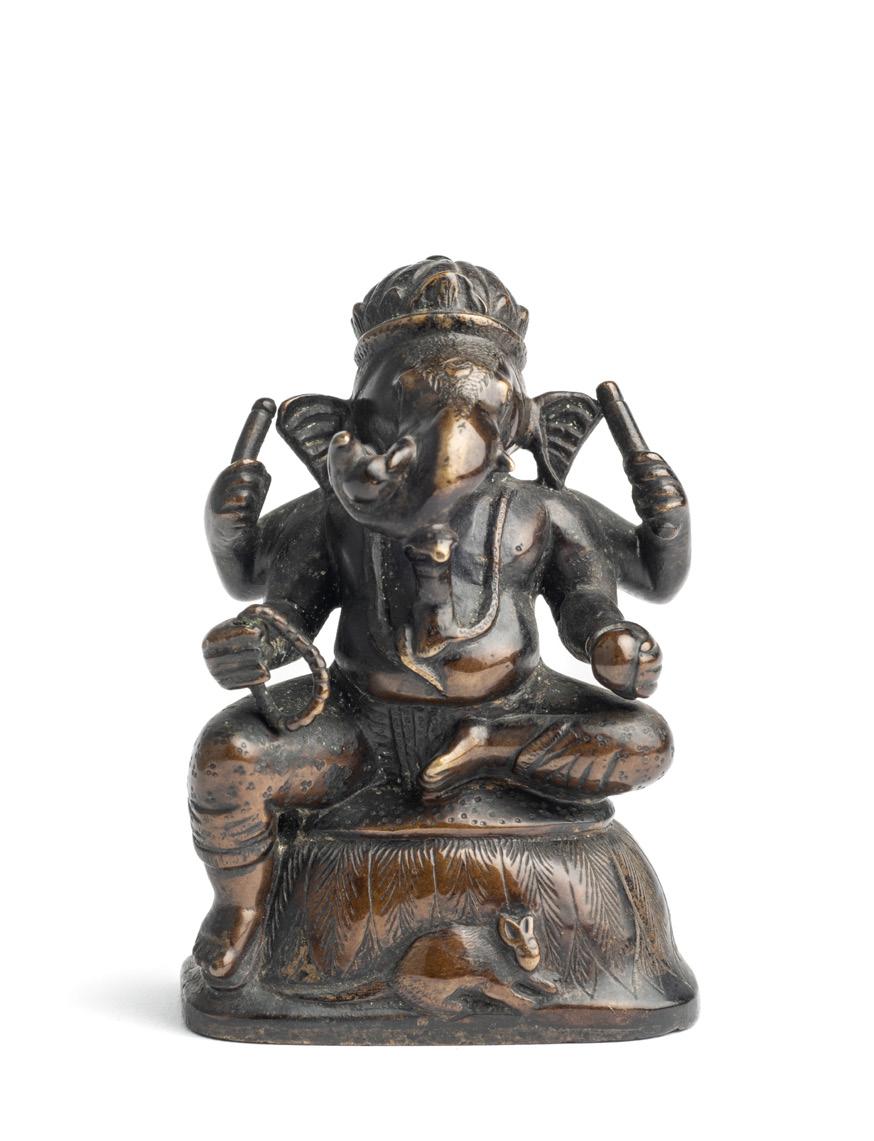
Provenance: Collection of the late Joost Slingerland, Yorkshire, acquired Peter Sloane, London, 15 June 2001. A copy of the receipt is sold with this lot.
£200-300
75.
A 'GANGAJUMNA' FIGURE OF KRISHNA BATTLING WITH KALIYA, SOUTH INDIA, 19TH CENTURY, brass and bronze, on a lotus base, a butter ball in his right hand, his left hand raised, holding the cobra's tail, wearing beaded belt and multiple necklaces, with long flowing hair and tall headdress, 11cm high

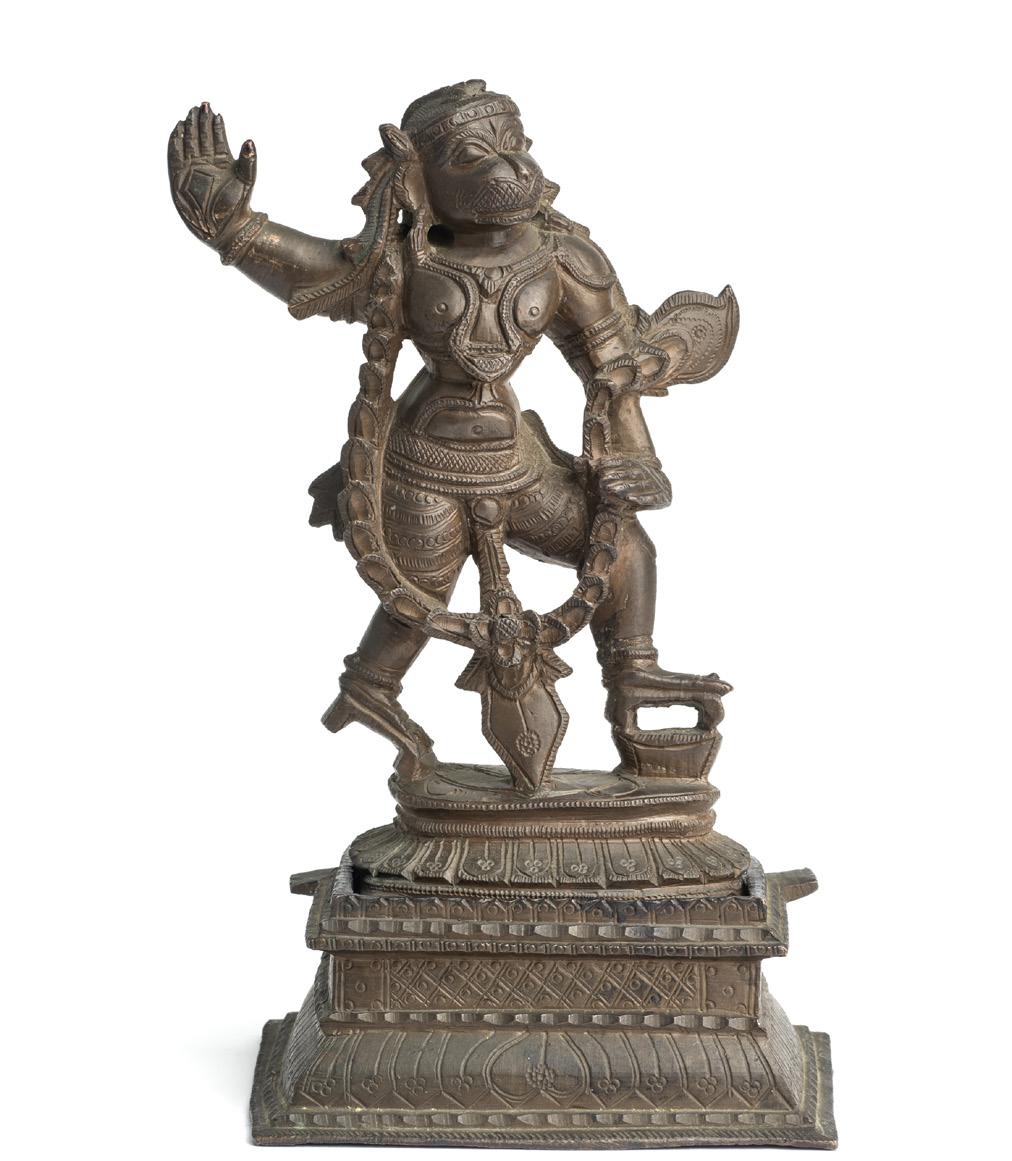
Provenance: Collection of the late Joost Slingerland, Yorkshire, acquired Roderic Antiques, Richmond, London, 17 June 2000. The original receipt is sold with this lot.
£300-400
76. (illustrated online)
THREE BRONZE IMAGES, 20TH CENTURY, comprising a Tibetan figure of Padmasambhava, a South Indian bronze figure of Durga and a Khmer style dancing figure of Ganesha, 14.5cm high and smaller
Provenance: Collection of the late Joost Slingerland, Yorkshire. The Ganesha figure was acquired from The Antiques Centre, York, 22 September 2005. The original receipt for that item is sold with this lot.
29
£80-120
77.
A BRONZE FIGURE OF VITHOBA, DECCAN, SOUTHERN INDIA, 16TH/17TH CENTURY, standing on a square base, his hands by his hips, his right in varada mudra, his left holding a conch shell, his tall headdress with bud finial, 13.5cm high Provenance: Collection of the late Joost Slingerland, Yorkshire, acquired Arthur Millner, London, 14 June 2002.
Vithoba is a form of Krishna worshipped particularly in the western Deccan. The brick, here shown as the square paving tile the deity is standing on, along with his distinctive static posture, is a reference to a story in the life of Krishna, when he was told by Pundalika to wait on a brick while Pundalika attended to his aged parents.
78.
A 'GANGAJUMNA' FIGURE OF DANCING KRISHNA, SOUTH INDIA, 18TH CENTURY, brass and bronze, on a lotus base, a butter ball in his right hand, his left hand raised, wearing multiple necklaces, with long flowing hair and tall headdress, 11cm high
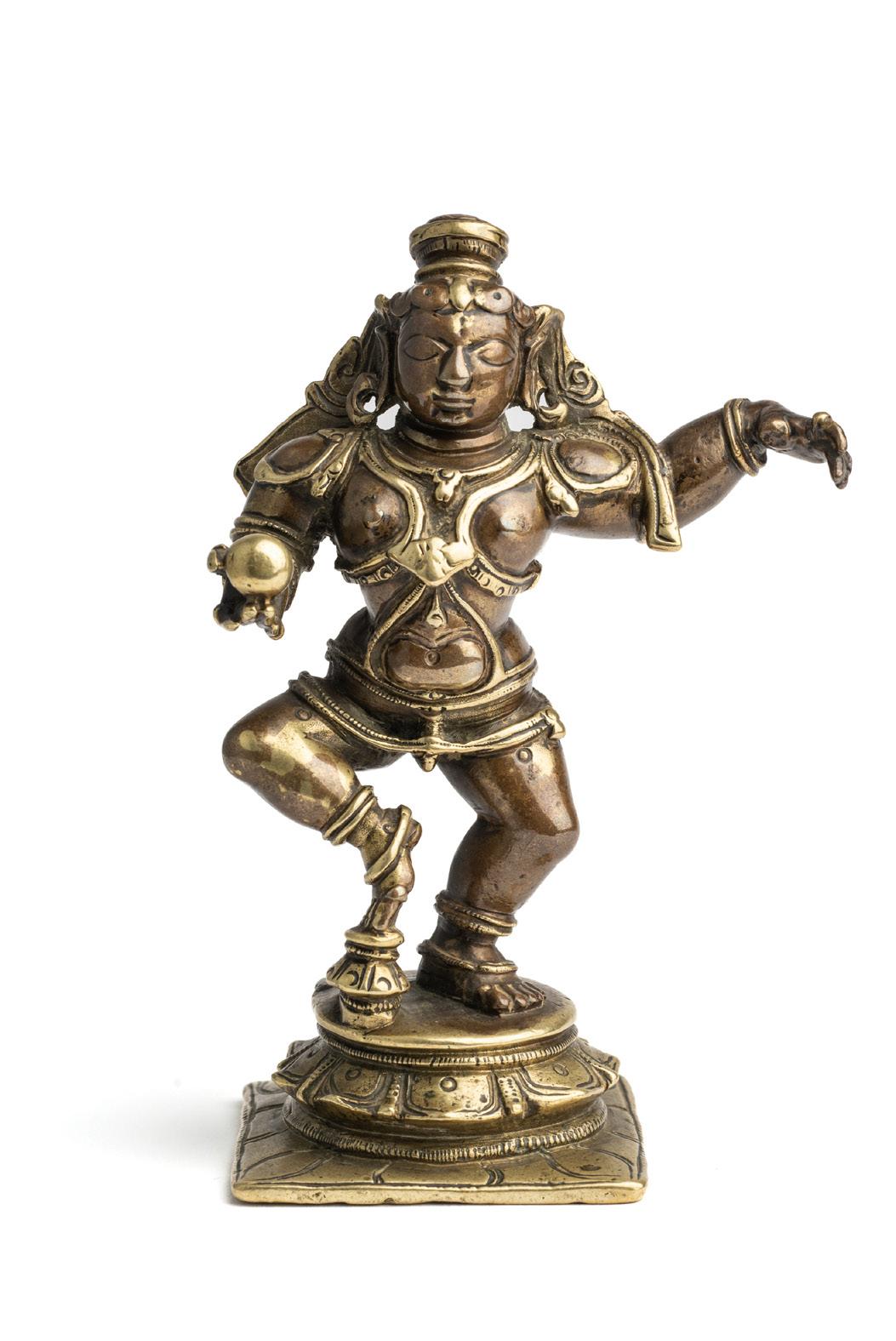
Provenance: Collection of the late Joost Slingerland, Yorkshire, acquired Arthur Millner, London, London 26 February 2000. The original receipt is sold with this lot.

30
£400-600
£600-800
79.
A BRONZE FIGURE OF NANDI BULL, WESTERN DECCAN, INDIA, CIRCA 17TH CENTURY, the vehicle of Siva crouching on a raised plinth, with long tapered horns, wearing a necklace fringed with bells, 7.5cm high

Provenance: Collection of the late Joost Slingerland, Yorkshire, acquired Sebastiano Barbagallo, London, 14 June 2002. The original receipt is sold with this lot.
£150-250
80.
A FOLK BRONZE FIGURE OF KHANDOBA, WESTERN DECCAN, INDIA, 18TH / 19TH CENTURY, the god depicted riding a horse on a rectangular base, diminutive figures of Ganesha, Nandi, a cobra and a Sivalingam at its feet, 10cm high

Provenance: Collection of the late Joost Slingerland, Yorkshire.
£250-350
81.
A PAIR OF BUFFALO HORN FINIALS, PROBABLY DECCAN, 19TH CENTURY OR EARLIER, each of conical form, with buffalo head finial, five projecting loops and twin holes on each side near the base, 10.8cm each (2)
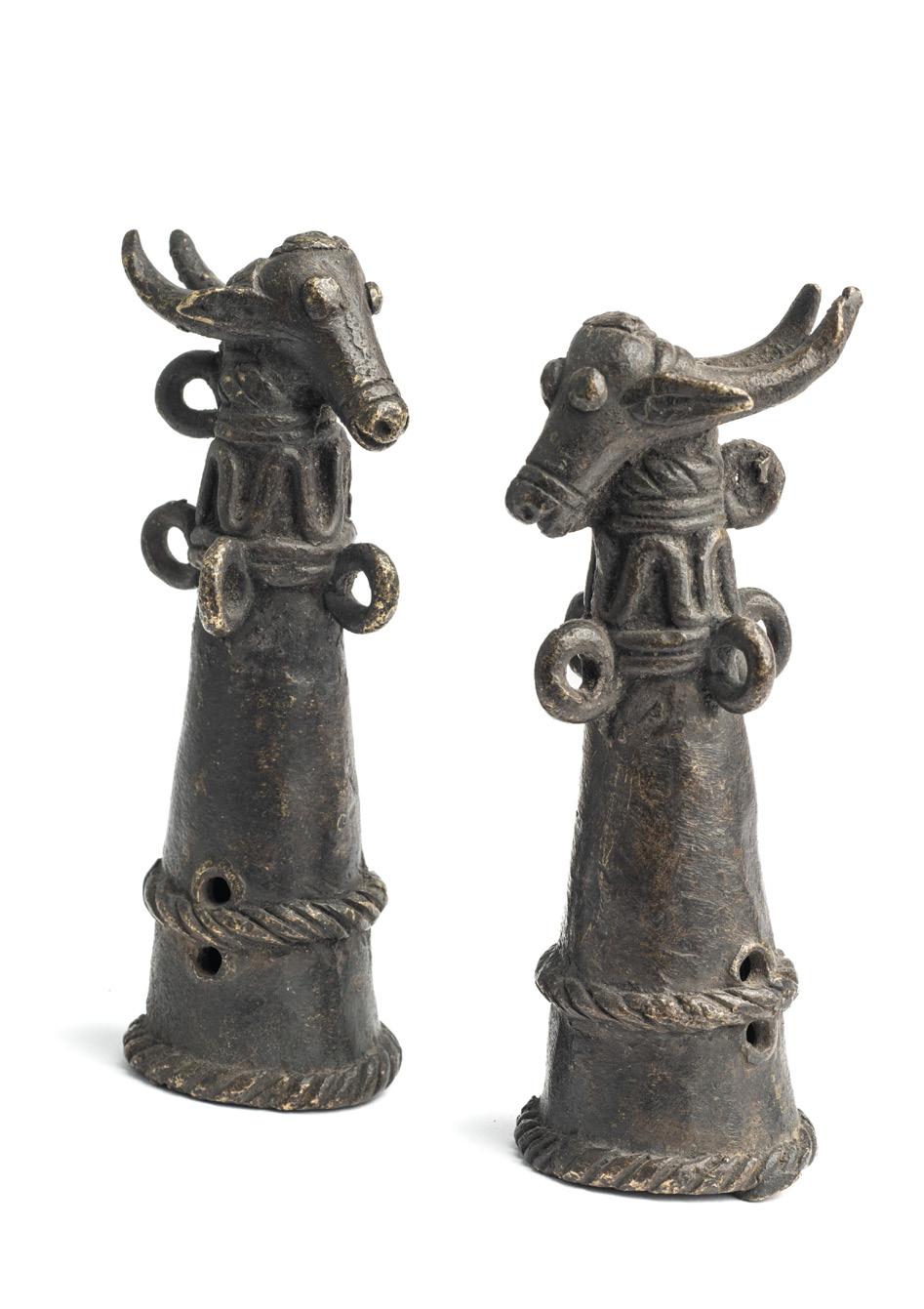
Provenance: Collection of the late Joost Slingerland, Yorkshire.
£150-250
31
82.
A BRONZE FIGURE OF GARUDA, SOUTHERN INDIA, CIRCA 18TH CENTURY, the winged vehicle of Vishnu standing on a lotus, his hands clasped in anjali mudra, wearing tall headdress with bud finial, 10.8cm
Provenance: Collection of the late Joost Slingerland, Yorkshire. £250-350
83.
A BRONZE FIGURE OF BHU-DEVI, TAMIL NADU, SOUTH INDIA, CIRCA 18TH CENTURY, the consort of Vishnu standing in tribhanga on a raised lotus base, holding a padma in her left hand, her right by her side, her head with tiered headdress, wearing large hoop earrings, 12.7cm

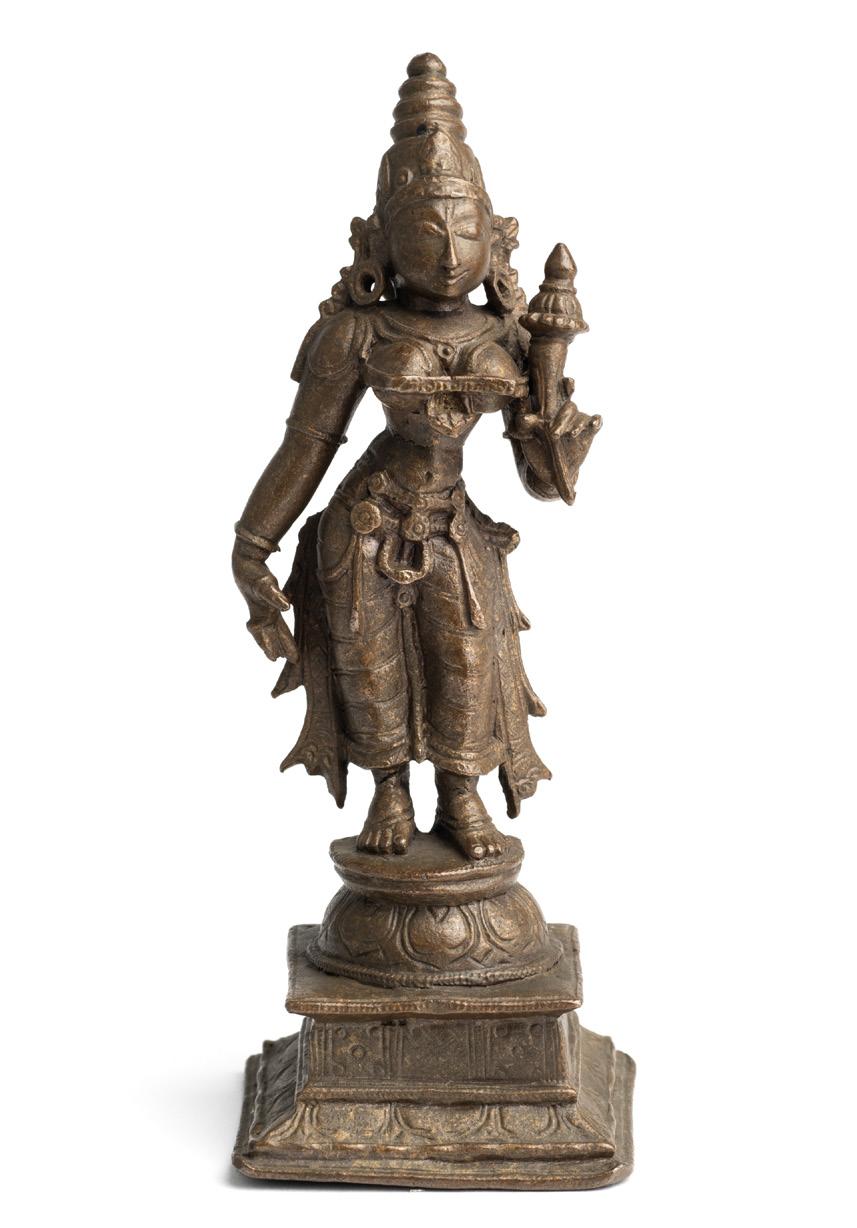

Provenance: Collection of the late Joost Slingerland, Yorkshire, acquired Peter Sloane, London, 15 June 2001. A copy of the receipt is sold with this lot.
£250-350
84.
A BRONZE FIGURE OF HANUMAN, TAMIL NADU, SOUTH INDIA, CIRCA 17TH CENTURY, the monkey-god, standing on a raised lotus base, his hands clasped in anjali mudra, his long tail scrolling over his head, 14.5cm
Provenance: Collection of the late Joost Slingerland, Yorkshire. £400-600
32
85.
A BRONZE FIGURE OF PARVATI, SOUTH INDIA, CIRCA 17TH CENTURY, the four-armed consort of Siva seated in lalitasana on a double lotus, holding a sivalingam, Ganesha's tusk, a citron and a small figure of Ganesha, the underside engraved with four floral medallions, 11.5cm high Provenance: Collection of the late Joost Slingerland, Yorkshire.


£700-900
86.
A BRONZE FIGURE OF DURGA MAHISASURAMARDINI, TAMIL NADU, SOUTH INDIA, 17TH / 18TH CENTURY, the six armed goddess stabbing the demon as it emerges from the buffalo body, the animal head lying on the ground, on elevated lotus base, 12.5cm high
Provenance: Collection of the late Joost Slingerland, Yorkshire, acquired Arthur Millner, London, 17 June 2000. The original receipt is sold with this lot.
£500-800
33
87.
A BRONZE FIGURE OF BHU-DEVI, TAMIL NADU, SOUTH INDIA, CIRCA 18TH CENTURY, the consort of Vishnu standing in tribhanga on a lotus base, her right hand raised, holding the stem of a padma, her tall headdress with bud finial, 10.5cm
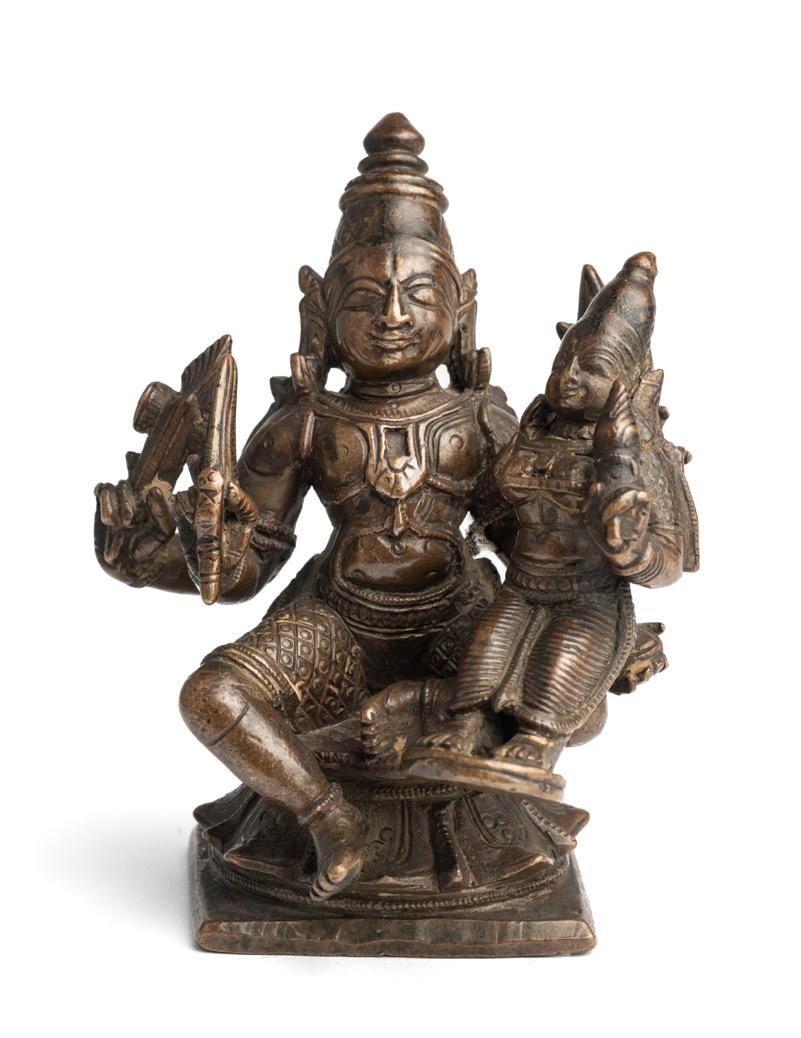
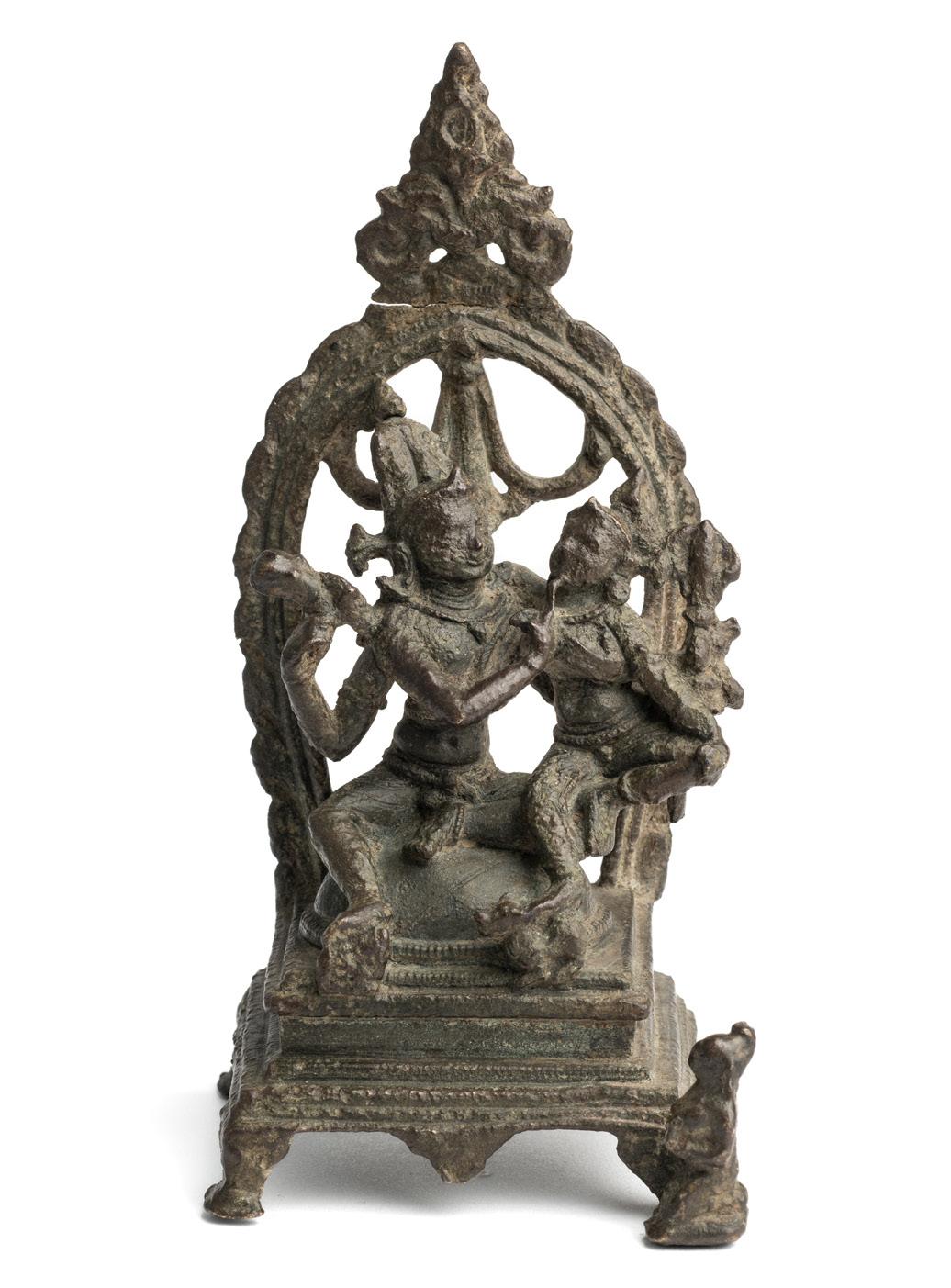
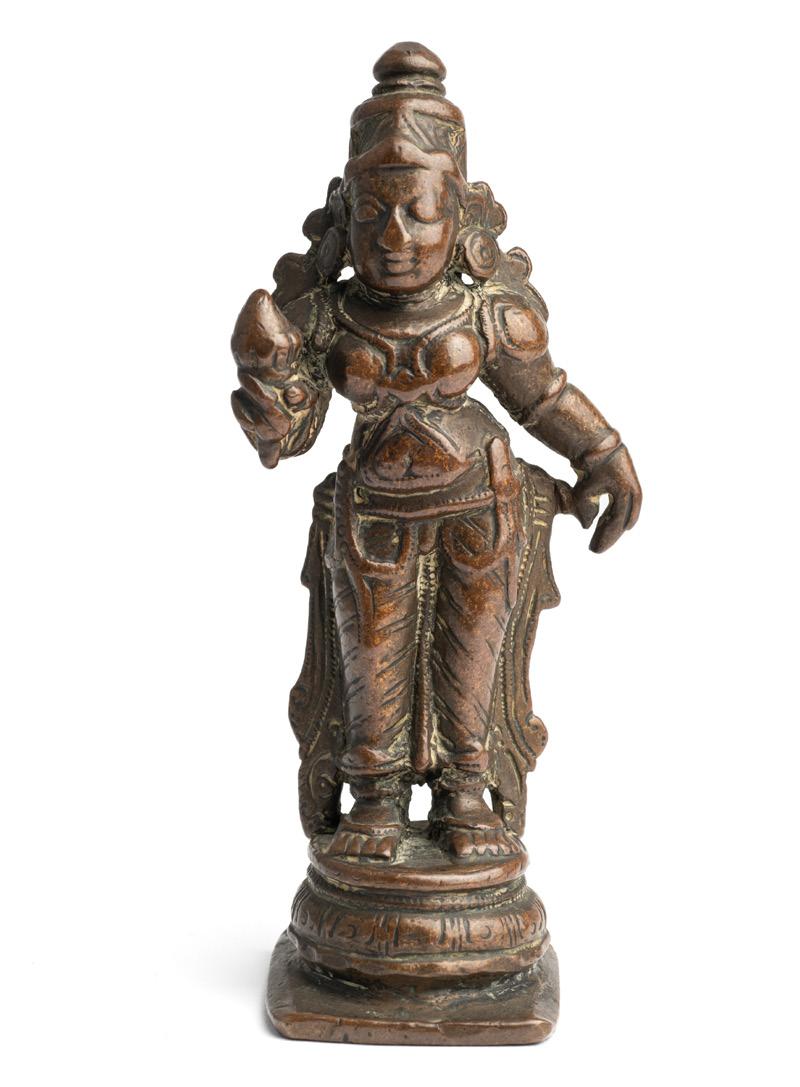
Provenance: Collection of the late Joost Slingerland, Yorkshire.
£300-400
88.
A PALA BRONZE UMA-MAHESVARA GROUP, BENGAL, EASTERN INDIA, 10TH / 11TH CENTURY, the couple seated together on a mound, figures of Nandi and Ganesha at their feet, a figure of a kneeling devotee on the base, 14cm high
Provenance: Collection of the late Joost Slingerland, Yorkshire. Acquired in the Netherlands (sold with exhibition label).
£700-900
89.
A BRONZE GROUP DEPICTING SIVA AND PARVATI, SOUTH INDIA, 19TH CENTURY, the god seated in lalitasana on a lotus throne holding various attributes, his consort on his left knee, 9.5cm
Provenance: Collection of the late Joost Slingerland, Yorkshire.
£300-400
34
90.
A BRONZE FIGURE OF NANDI BULL, WESTERN DECCAN, INDIA, LATE 19TH CENTURY, on raised base, wearing blanket and trappings, his head with prominent horns, 13cm high Provenance: Collection of the late Joost Slingerland, Yorkshire.

£300-500
91.
A PALA BRONZE FIGURE OF TARA, BENGAL, INDIA, CIRCA 11TH CENTURY, standing in tribhanga on a raised lotus base, her hands in varada mudra and holding the stem of a padma, a small parasol above with kalasa finial, 14cm

Provenance: Collection of the late Joost Slingerland, Yorkshire.
For two related bronzes, depicting Avalokitesvara, in the Los Angeles County Museum of Art, see Pal 1988, pl.94b & c, p.94
£600-800
35
92.
A BRONZE FIGURE OF PARVATI, GUJARAT, WESTERN INDIA, 15TH / 16TH CENTURY, the four-armed goddess standing erect on an open work plinth with her vehicle the lion at the front, holding Sivalingam, Ganesha, a citron and rosary, the cusped prabha surmounted by kalasa finial, 14.3cm
Provenance: Collection of the late Joost Slingerland, Yorkshire. Acquired from Arthur Millner, 18 June 2003. The original invoice and related correspondance are sold with this lot.
£600-800
93.
A BRONZE FIGURE OF ANNAPURNA, DECCAN, CIRCA 18TH CENTURY, seated with legs loosely crossed on a low stool resting on raised platform, holding her loaded ladle, with flowing hair and tall headdress, 8.8cm high
Provenance: Collection of the late Joost Slingerland, Yorkshire.
Annapurna is the Hindu goddess of nourishment, especially worshipped in Varanasi (Benares). She uses her large ladle to serve food to her devotees. £200-300
94.
A BRONZE FIGURE OF A GODDESS, SOUTH INDIA, 18TH / 19TH CENTURY, standing erect, holding a padma in the form of a bowl in her right hand, a mirror in her left, her hair plaited behind in a long ponytail, later brass stand, 15.8cm high

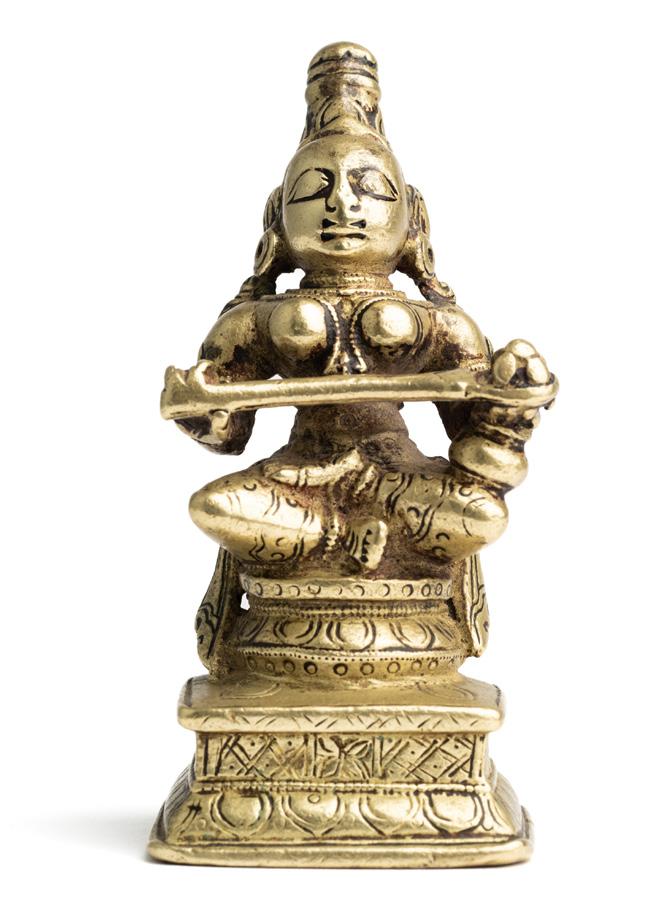
£250-350

36
95. TWO SAIVITE BRONZES, WESTERN DECCAN, INDIA, 16TH/17TH CENTURY, comprising a figure of Nandi Bull and a ritual bracelet with lingam emblem, 9.5cm approx. each £120-180
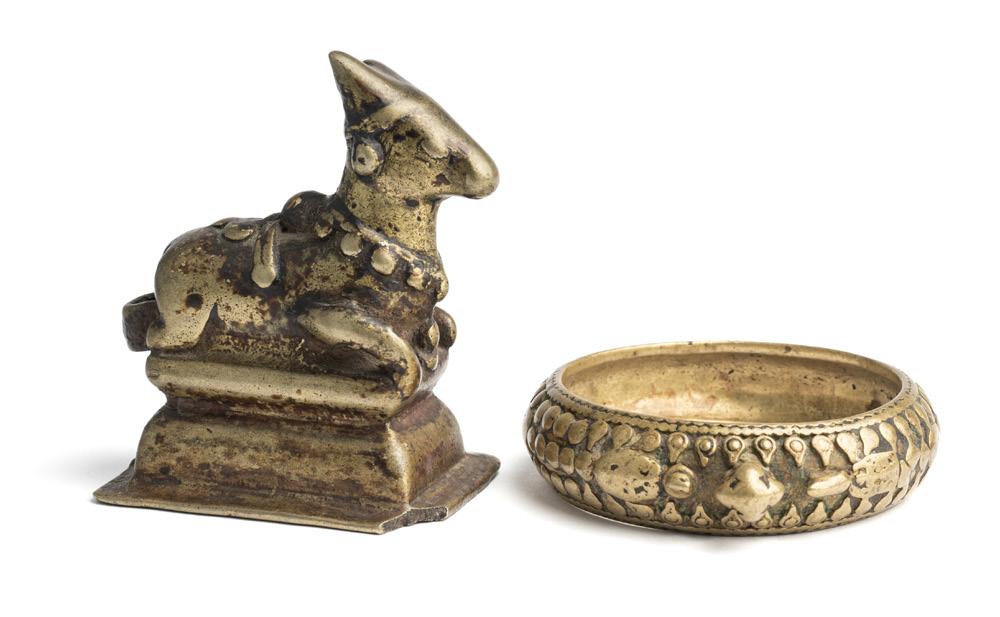
96.
A BRASS SIVA MASK (MOHRA), HIMACHAL PRADESH, 15TH CENTURY OR LATER, in the form of a stylised bust, the head with third eye, crown, and earrings, a necklace on the chest, 17cm £250-350
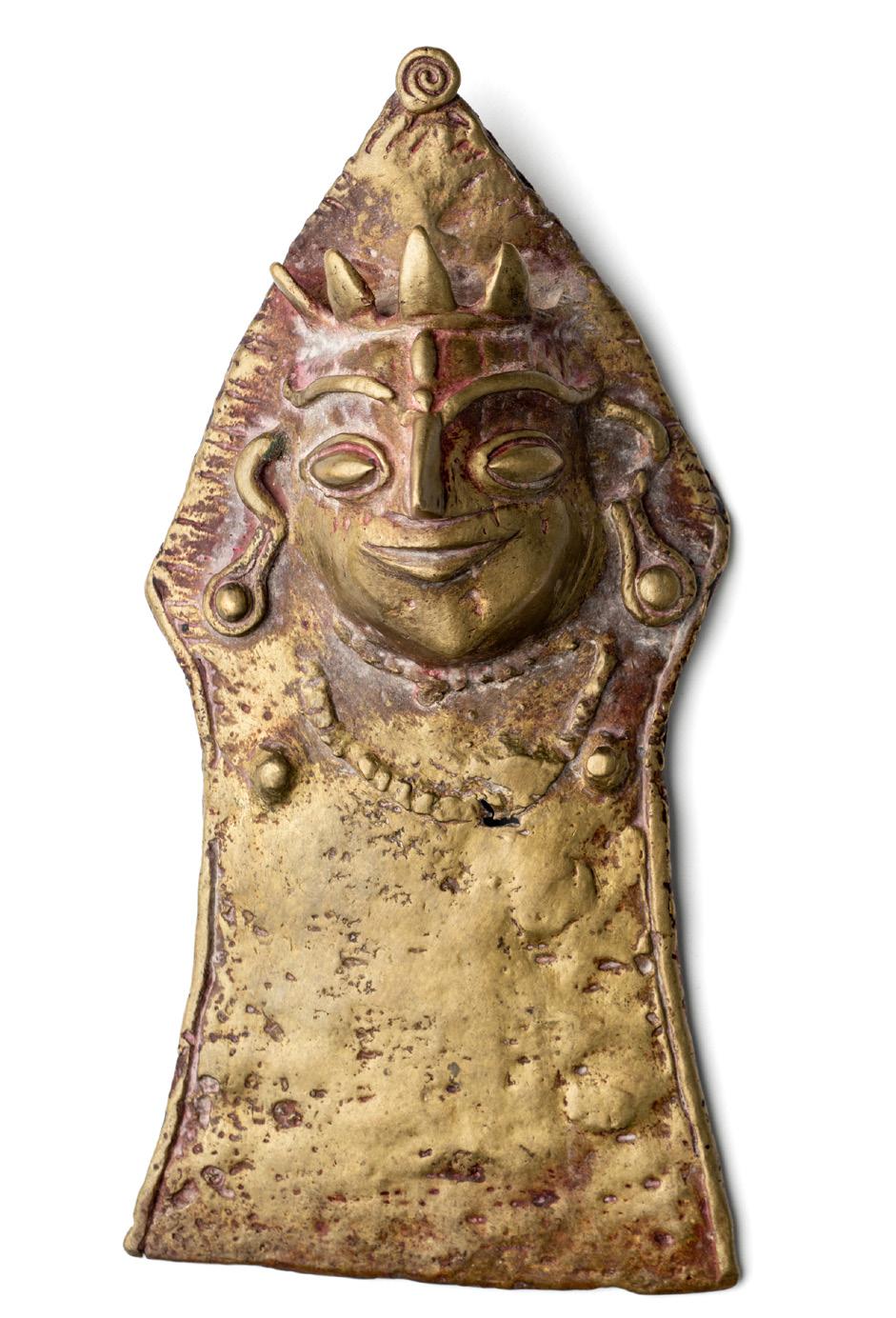
97. (illustrated online)
TWO CARVED WOOD FIGURES, INDIA, EARLY 20TH CENTURY, depicting Durga on horseback and a celestial musician, together with a Painted Ritual Mask, Orissa, early 20th century, 63cm; 59cm; 30cm high £120-150

98. A CARVED WOOD PANEL FROM A PROCESSIONAL CHARIOT (RATHA), TAMIL NADU, SOUTH INDIA, CIRCA 18TH CENTURY, the central figure dancing with body flexed holding a sword in his raised right hand and a horn in his left, wearing crown, dhoti and elaborate necklaces and jewellery, flanked by a winged androgynous figure, also holding a horn and a female figure carrying a waterpot, a mtical bird on the upper corner, mounted, 59 x 70cm
Provenance: Private Collection, England. Acquired Jeremy Knowles Ltd., London, 2nd April 2006.
£600-800
37
99.
A CARVED SANDALWOOD PANEL, MYSORE REGION, SOUTHERN INDIA, CIRCA 1880, of rectangular form, the relief decoration comprising a central panel depicting the coronation of Rama, the hero accompanied by Sita, Lakshmana, Bharata, Shatrugna and Hanuman, within an oval medallion including two other Ramayana scenes, surrounded by a band of further medallions containing Hindu deities, 30.5 x 21.5 x 1cm
Mysore sandalwood carving is thought to have been inspired by the intricate stone carving of the Hoysala dynasty in the same part of the Deccan. For other examples of this work, including complete caskets, exhibited in Delhi in 1903, see Watt 1903, pls.35 & 36A. There are several examples in the Victoria and Albert Museum, London, such as inv. no. 02306-1 (IS), acquired in 1867 and recorded as being made by a carver named 'Coompta'.
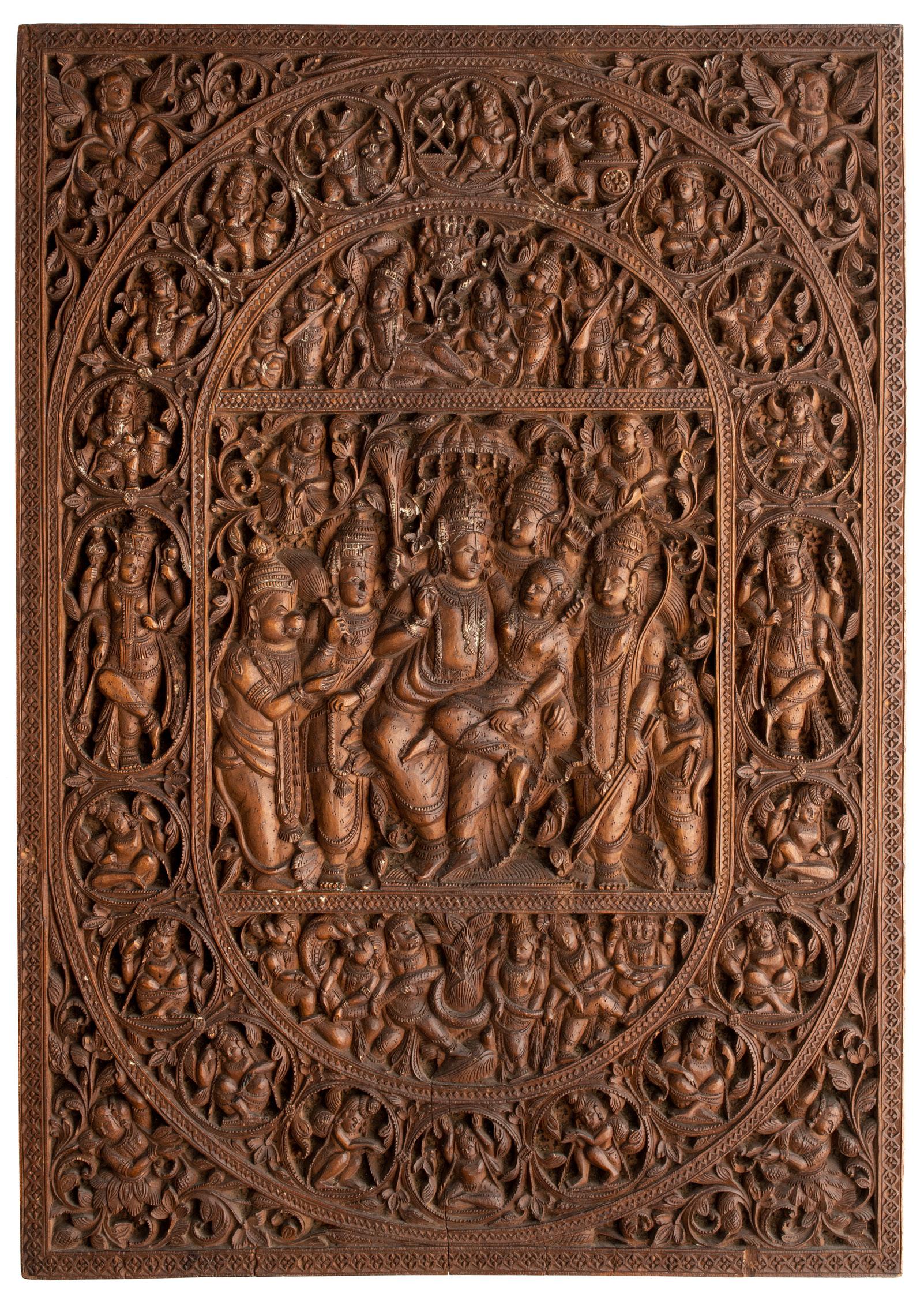
38
£300-500
100.
A MUGHAL BRASS EWER, NORTHERN INDIA, CIRCA 1800, with bulb-shaped body, serpentine handle and straight tapered spout, engraved with repeated leaf design, the hinged lid with bud finial, 28cm high £80-120

102.
part
101.
THREE BRONZE OBJECTS, INDIA, 19TH CENTURY, comprising a Saivite ritual bowl and two bronze finials, 7.6cm; 9.6cm

Provenance: Private collection, England, thence by descent.
£120-150
□
A KOFTGARI BUCKLE, PUNJAB, INDIA (NOW PAKISTAN), gold damascened iron, of serpentine rectangular form, decorated with scrolling leaf designs, mounted, 8 x 5.7cm

£80-120
103.
A BRASS TORC, PROBABLY RAJASTHAN, INDIA, 19TH CENTURY, spiral openwork brass, with hooked terminals, a coloured glass inlaid medallion on each side, 16.5cm max. diam.
Provenance: Private collection, Western England £80-120

39
104.
A PARTHABGAR BROOCH, RAJASTHAN, INDIA, 19TH CENTURY, blue glass inlaid with engraved gold, of bevelled rectangular form, depicting a royal couple in a palace courtyard with attendants, together with a brass mould for an amuletic pendant, 19th century, depicting Khandoba and Mhalsa on horseback, 4.0; 4.3cm high (2)

Provenance: Private collection, Western England £200-300
105.
A BRONZE GAMING PIECE, PROBABLY BASTAR, CENTRAL INDIA, 19TH CENTURY, of pyramidal form, the sides with stylised human and animal figures in relief, 5.5cm high


Provenance: Private collection, Western England £80-120
106.
A SILVER SCENT BOTTLE, PROBABLY DECCAN, INDIA, LATE 18TH CENTURY, of bud-shaped form, the fluted sides with engraved foliate, ropework and lotus bands, the stopper attached with chain, 6cm long £600-800
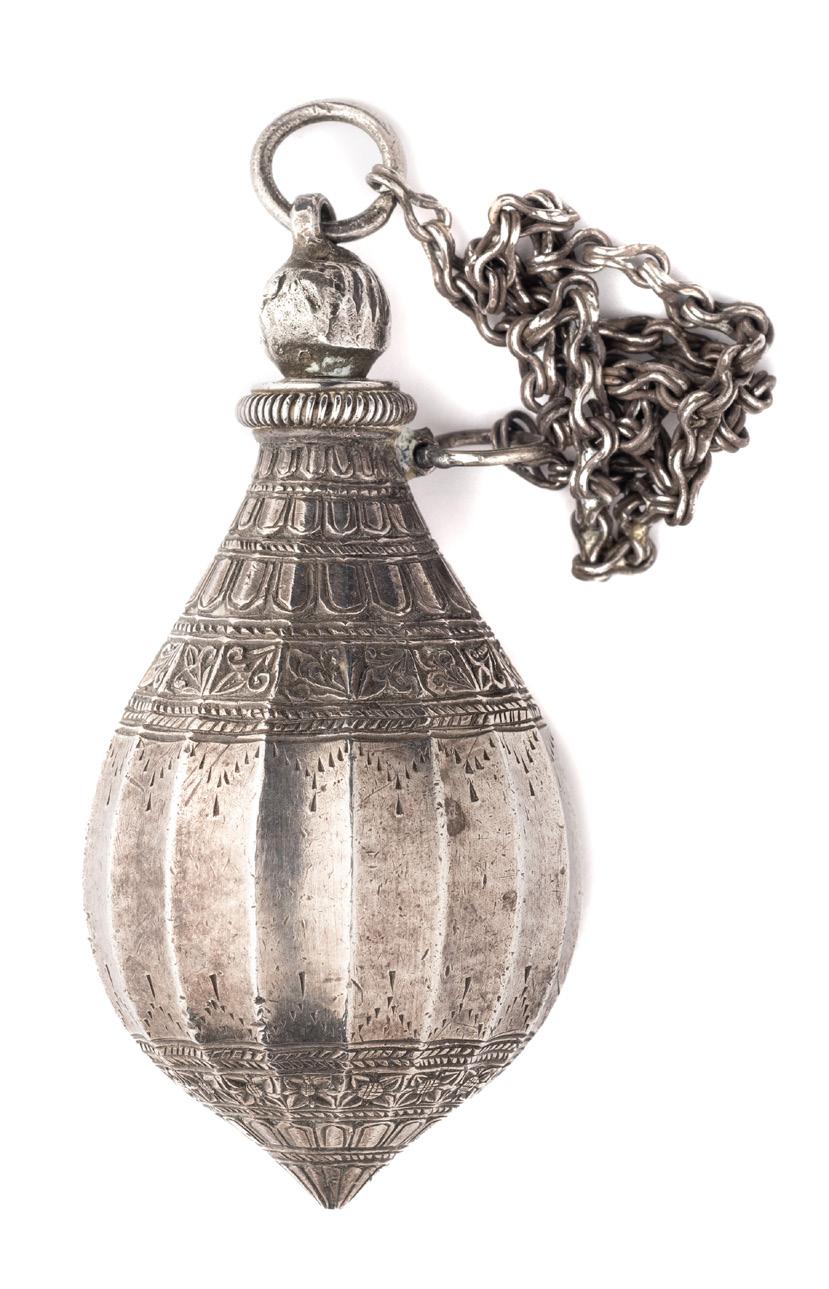
40
107.
A SILVER ROSEWATER SPRINKLER, CALCUTTA, INDIA, CIRCA 1930, the hammered and repousse decoration depicting houses amongst trees and an art deco medallion on the sides, acanthus and scrolling floral borders, the tapered neck with sunflower head, later Gujarati inscription on the shoulder, 31cm high £300-400

108.
A SMALL LIMEBOX IN THE FORM OF A MANGO, INDIA, CIRCA 1800, tinned bronze, with hinged opening and crown shaped suspension loop, 8.2cm long £80-120
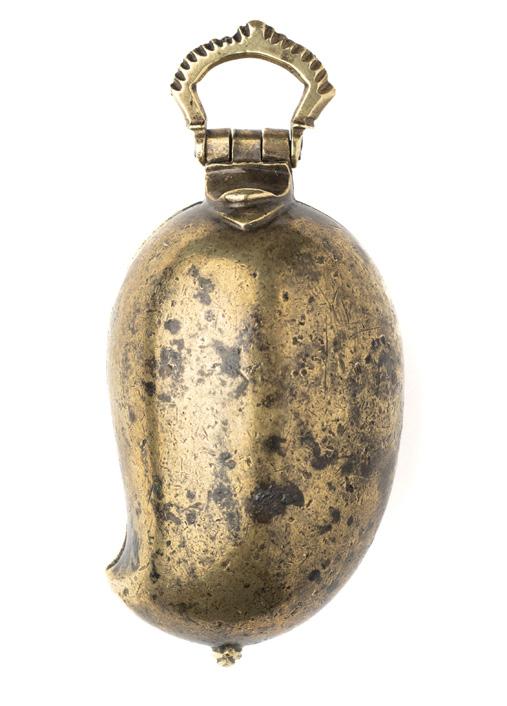
109.
A COLLECTION OF TEN BRONZE OPIUM WEIGHTS, INDIA, CIRCA 18TH/19TH CENTURY, each in the form of an amalaka (Indian gooseberry), some with engraved marking, 4cm diam. and smaller The Indian gooseberry (emblica officinalis) is an important element in Ayurvedic medicine and a common architectural motif in mediaeval Hindu architecture. For a similar group of weights previously sold in these rooms, see 24 November 2021, lot 135. £300-400

41
110.
A REPOUSSE SILVER BOWL, PROBABLY KASHMIR, EARLY 20TH CENTURY, decorated with iris and leaf design in relief, standing on three bud-shaped feet, the base with concave rosette design, 10cm high; 22cm diam. 929g

£600-900
111.
AN EXTENSIVE MISCELLANEOUS COLLECTION OF BEADS, MOSTLY HIMALAYAS AND SOUTH-EAST

ASIA, CIRCA 5TH CENTURY AND LATER, most of pierced spherical form, composed of terracotta, coloured glass, agate, coral, lapis lazuli, silver, seed pearl, carnelian, the smallest: 2mm, the largest: 48mm, average size: 7mm, (more than 1000)
Provenance: Collection of a deceased diplomat, thence by descent.
£400-600
42
part
112 (part)
112.
FOUR INDIAN MANUSCRIPT FOLIOS, INDIA, CIRCA 18TH CENTURY, ink and gouache on paper, comprising three folios from a treatise on animals (?), written in nastaliq script, separately inserted illustrations, and a Hindu folio written in devanagari script, the illustration depicting Krishna with the gopis, 28 x 16cm approximately each (Islamic folios); 15 x 28.5cm (Hindu folio)
£60-80 113.
TWO INDIAN PAINTINGS, RAJASTHAN, INDIA, 19TH CENTURY, gouache on paper, one depicting a maiden seated in a verdant landscape, the other depicting Sri Nath Ji in a shrine flanked by two male devotees, 15 x 10cm; 20 x 17cm approx. (image)

Provenance: Private collection, Northern England £100-150
114.
A NARRATIVE SCROLL DEPICTING SCENES FROM THE HINDU EPICS, BENGAL, 20TH CENTURY, gouache on paper, of long rectangular form, depicting a series of scenes vertically arranged, several depicting Rama with Sita and Krishna and Radha in the mouth of Aghasura, 226 x 45.5cm
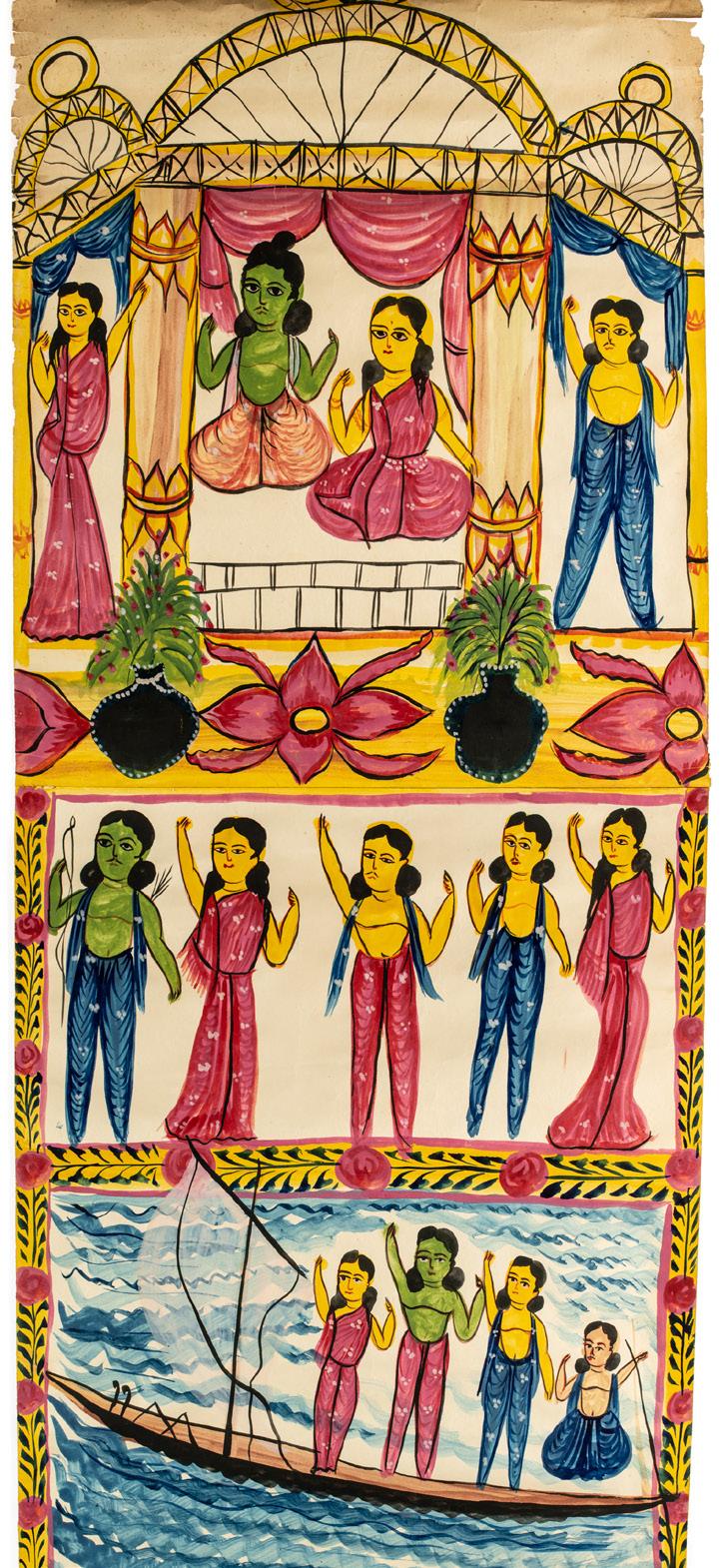

Provenance: Private collection, Northern England £100-150
113 (part)
43
114 (detail)

44 115. FOUR PAINTINGS DEPICTING HINDU DEITIES, RAJASTHAN, INDIA, LATE 19TH CENTURY, gouache with silver on paper, depicting Narasimha with Hiranyakasipu, Vishnu with Lakshmi on the serpent raft, Parashurama and Lava(?), son of Rama, each mounted on card and inscribed in devanagari on the reverse, 16 x 12.5cm and smaller (image) Provenance: Private collection, Northern England £250-350
BOUND WITH THE SNAKE (NAGAPASA), PAHARI, INDIA, EARLY 19TH CENTURY, gouache with gold on paper, the hero seated on the ground in a palace courtyard, watched by Ravana, Indrajit and their courtiers, grey border within speckled pink border, a line of devanagari script on the reverse, 23 x 31.5cm (image), 30.5 x 39cm (folio)

Provenance: Private collection, Northern England
In this scene from the Ramayana, Rama has been brought down by a magic arrow fired at him by Indrajit which turns into a snake mesh. For another version of this scene, see Topsfield 2004, no.49.
45 116. RAMA
£1000-1500
118.
FOUR PAINTED CARDS, INDIA AND TIBET, 19TH CENTURY, watercolour on paper, comprising three tarot(?) cards, one depicting a princely figure holding a document, and a Tibetan tsakli, together with a Fragmentary Book, the loose leaves written in devanagari script, the loose leaves including an illustration depicting a man riding a camel, 11 x 10cm (average size, cards), 10 x 13cm (folios)
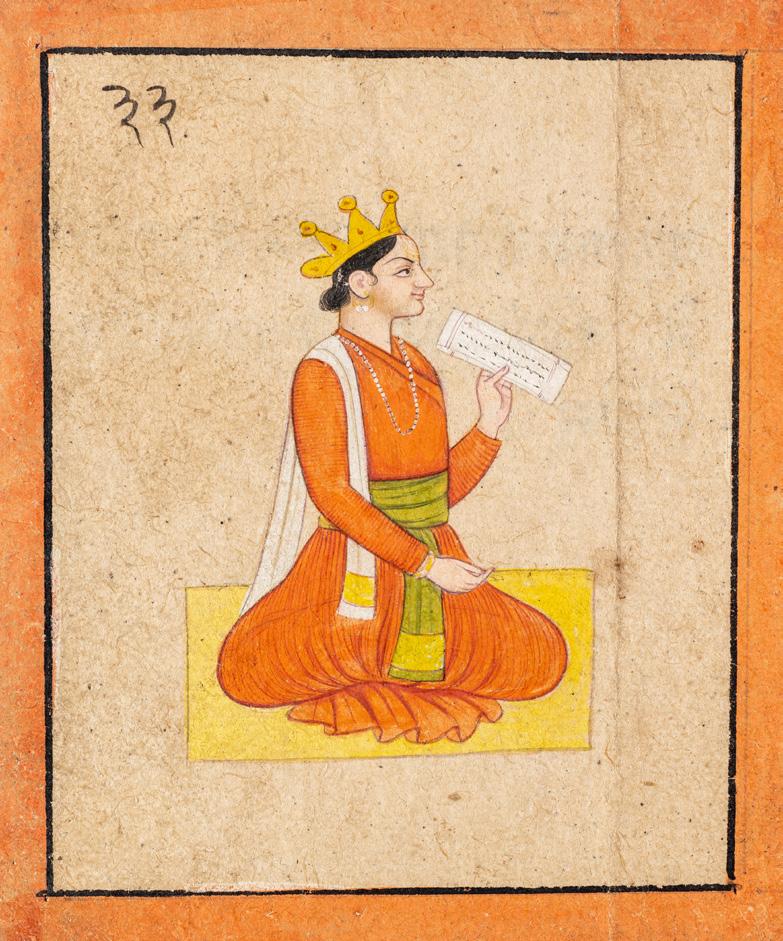
£150-250
part
117.
THREE JAIN PAINTINGS, WESTERN INDIA, 19TH CENTURY, gouache, ink and gold on paper, the larger showing various vignettes with three nude jinas at the top, another showing representations of the 24 tirthankaras, the third with the head of a jina on a manuscript folio, 26 x 11.5cm and smaller

£150-200
part
119.
TWO PAINTINGS OF GANESHA, RAJASTHAN, CIRCA 18TH CENTURY, ink and watercolour on paper, comprising a Ganapati pataka, inscribed with mantras and yantras, and a coloured image of the elephant headed god flanked by attendants, laid on card, 33.5 x 24.5cm; 21 x 17.5cm
£150-200
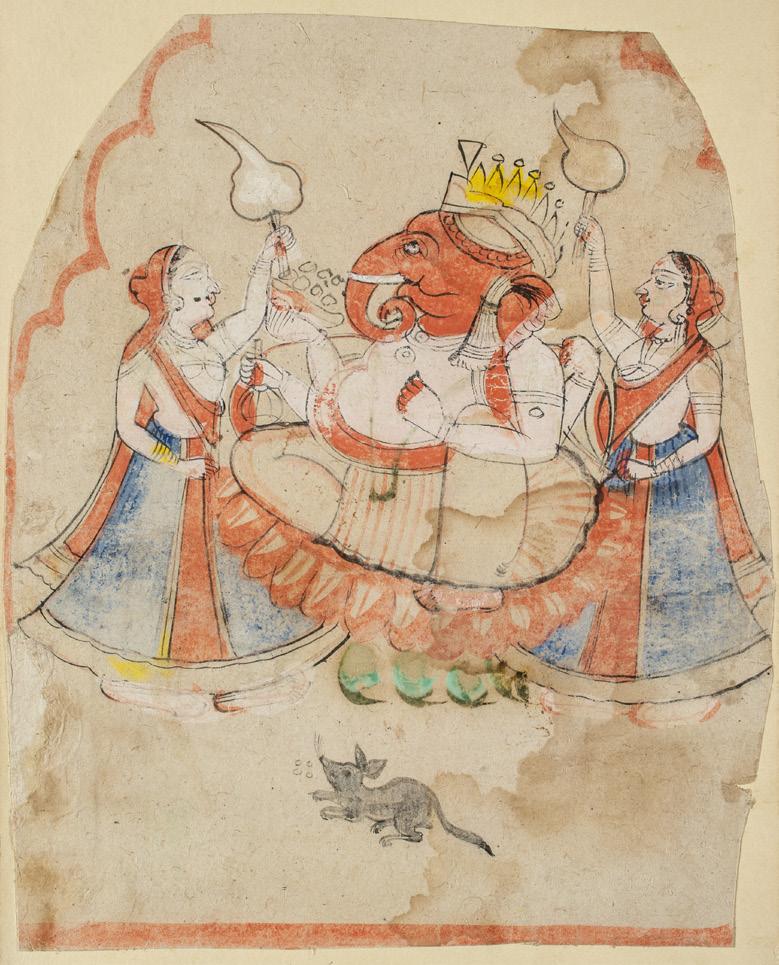
46
part
part
120.
TWO EROTIC SCENES, RAJASTHAN, INDIA, 19TH CENTURY, gouache on paper, partly laid on cloth, the entwined figures set against a green background, with red and orange borders, 22 x 37cm approx. each
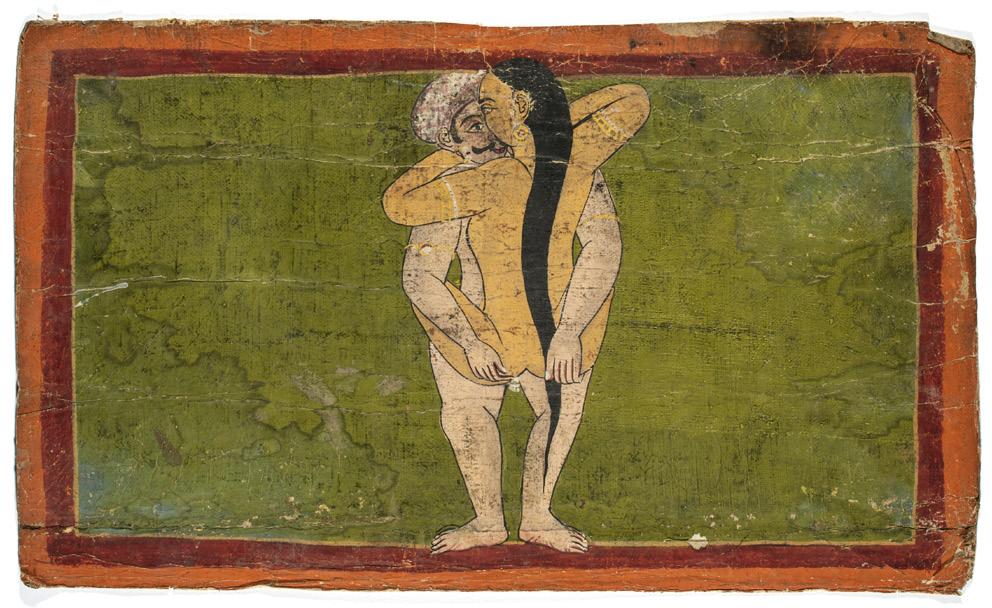
£150-250
121.
A FRAGMENTARY BLUEPRINT PLAN OF PART OF SOUTH DELHI, EARLY 20TH CENTURY, primarily showing the district of Hauz Khas, with individual land plots, inscribed in Urdu and English, 72 x 50.5cm £200-300
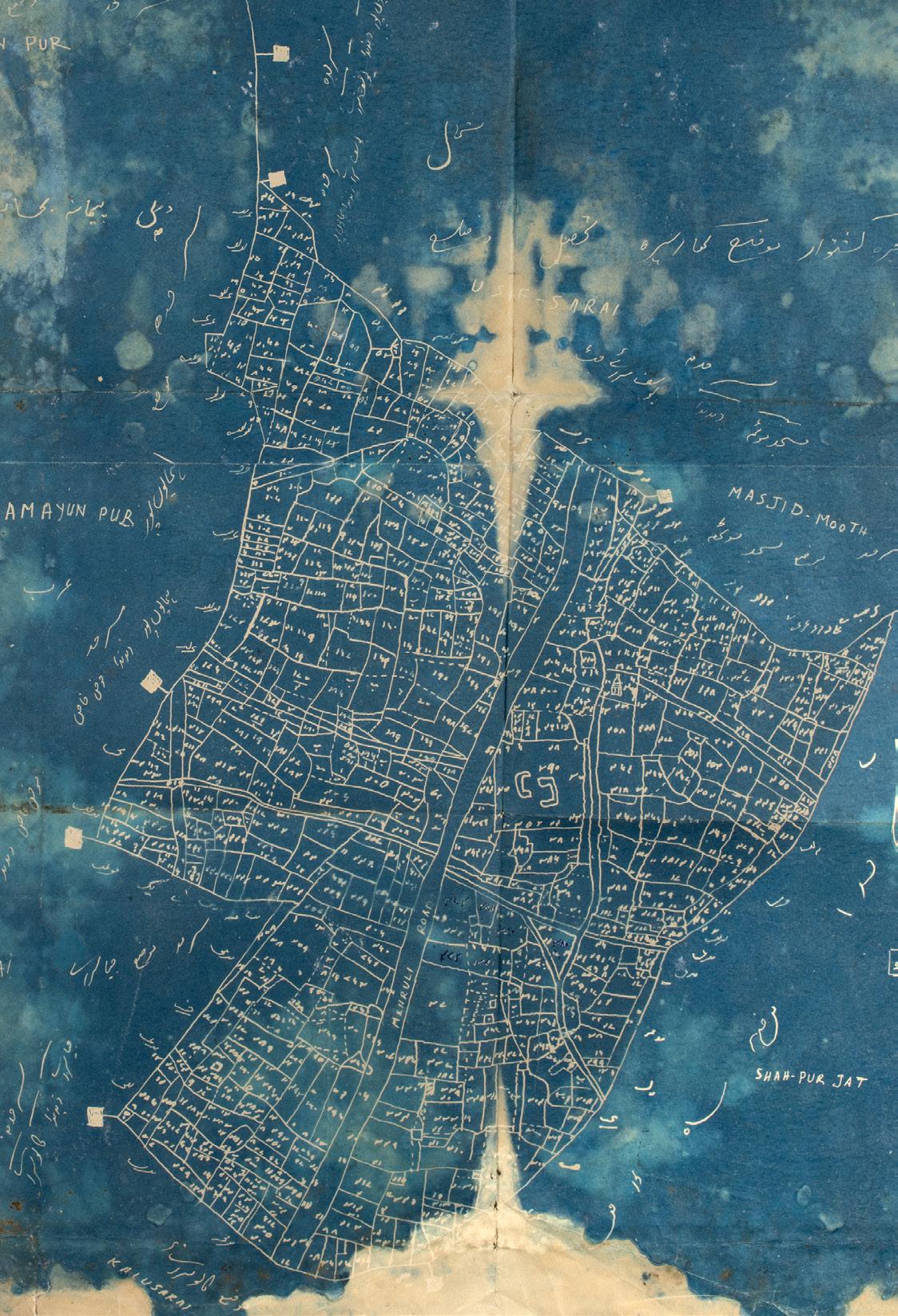
122.
THREE COSMIC DIAGRAMS (YANTRA), RAJASTHAN, INDIA, 18TH/19TH CENTURY, ink and watercolour on paper, each depicting a roundel with concentric registers of devanagari inscriptions, 42 x 46cm and smaller £120-180
detail
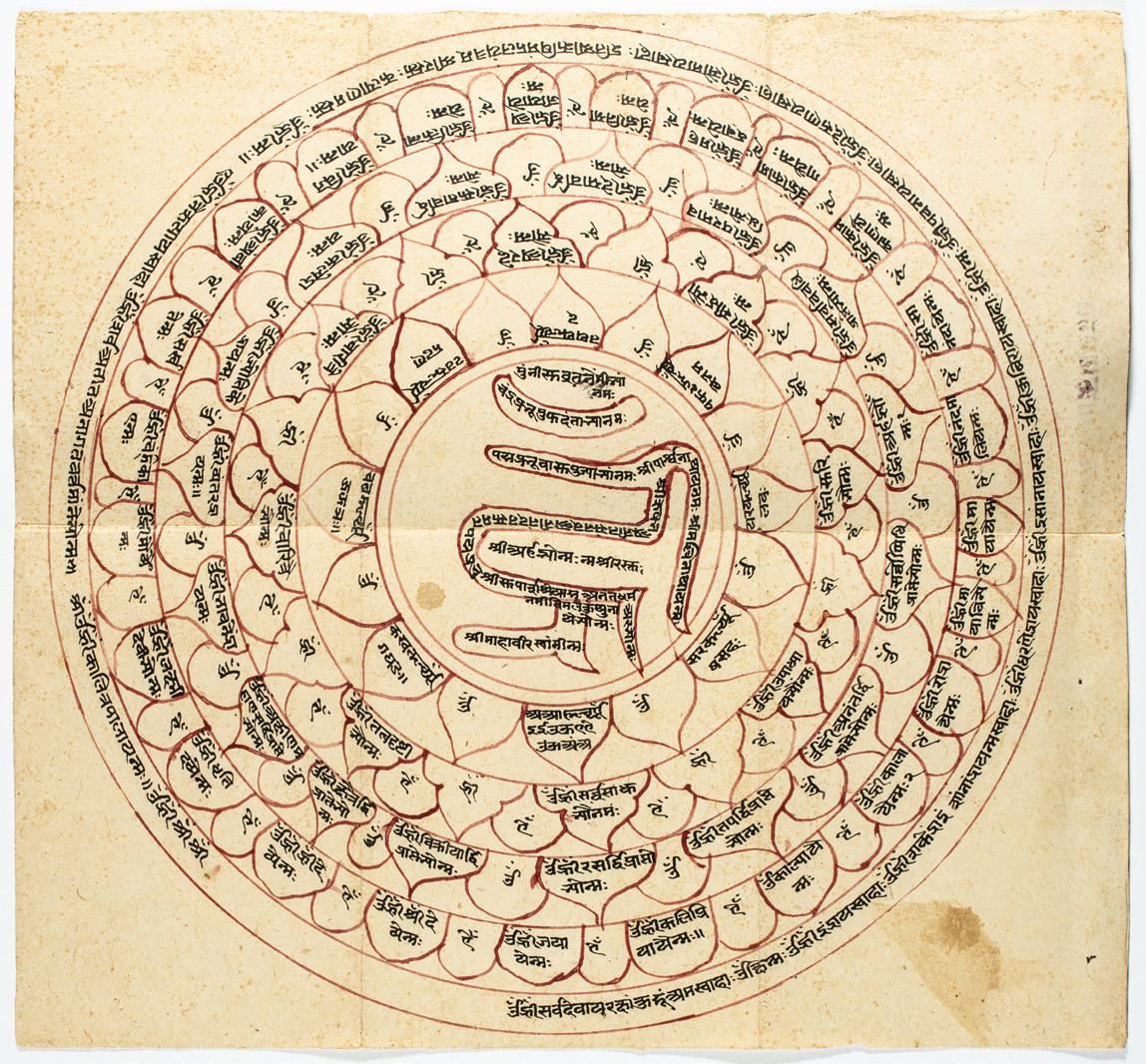
47
part
123 (part)
123.
TWO PAINTINGS OF SRINATHJI, NATHDWARA, RAJASTHAN, INDIA, LATE 19TH CENTURY, gouache with gold on paper, the larger depicting the deity with right hand raised, holding a cup in his left, a female devotee at his side, the other playing the flute at night, surrounded by devotees, with Indra and Airavata in the foreground, 35 x 25cm; 32 x 23cm
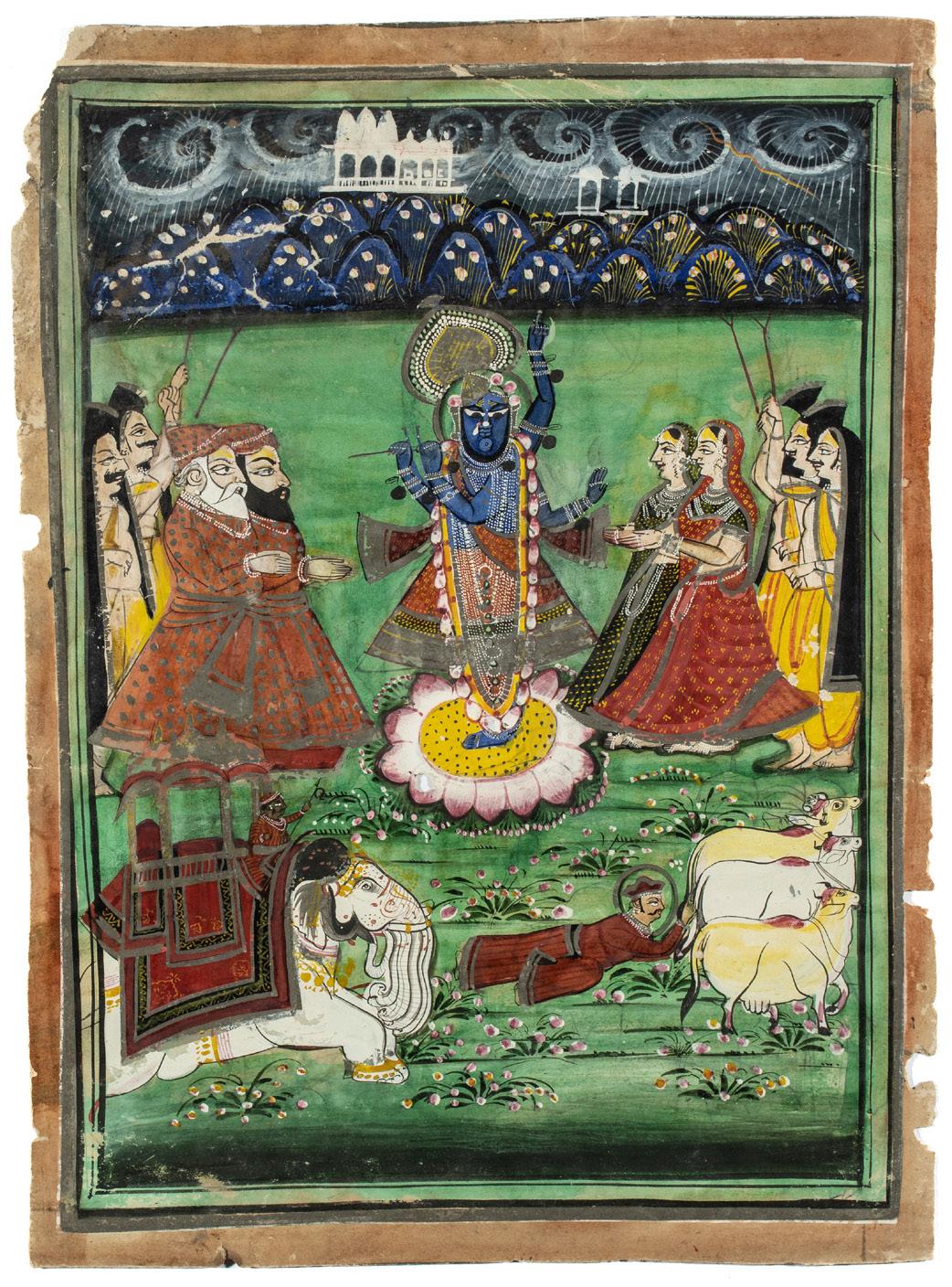
£250-350
124.
A DEVOTEE OF BALAKRISHNA, PAHARI, NORTH-WESTERN INDIA, EARLY 19TH CENTURY, gouache on paper, red border, 23.5 x 14.5cm


The devotee is depicted instructing his mala (set of prayerbeads) to accompany his prayers. The mala is held inside a gomukhi (cow's mouth), a cloth cover or bag worn over the hand and wrist.
£250-350
125.
FIVE INDIAN DRAWINGS, NORTHERN INDIA, 19TH CENTURY, ink on paper, one with watercolour depicting a Sikh gentleman at a table, the others depicting two ladies on horseback, three soldiers, a man restraining a lion and a seated nobleman, 22 x 16.5cm
£200-300
124
48
125 (part)
126.
TWO PAINTINGS OF SRINATHJI, NATHDWARA, RAJASTHAN, 19TH CENTURY, gouache with gold on paper, the larger with the central image within a leafy arch, flanked by a pair of priests, a further priest on another painting attached underneath, the smaller with a female devotee and giant bolster behind, devanagari inscription above, 35.5 x 25cm; 17 x 35.5cm £250-350

127.
TWO SHEETS OF PAHARI DRAWINGS, PUNJAB, INDIA, 19TH CENTURY, ink and wash on paper, comprising preparatory studies of various deities within ruled panels, including Durga and Siva, 26 x 26cm approx. each £250-350 part
detail

49
A HOLY MAN WITH YOUNG DEVOTEE, MUGHAL, INDIA, 18TH CENTURY, watercolour on paper, laid on a gold-painted 17th century album page, the figures depicted in a European rocky landscape with a church, the reverse with an unrelated manuscript folio inscribed with three columns of nastaliq script, 37.5 x 26.5cm (album page), 25.5 x 15cm

50 128.
£500-800

51 129. SIX PAINTINGS OF HINDU DEITIES, JAIPUR, RAJASTHAN, INDIA, 19TH CENTURY, gouache with gold and silver on paper, with blue and orange borders, depicting Varaha, a Sivalingam, Narasimha, Krishna, Ganga and another goddess riding on a dog, 15 x 10.5cm approx. each £500-800
part
130.
A GROUP OF MANUSCRIPT FOLIOS, WESTERN INDIA, CIRCA 18TH CENTURY, ink with watercolour on paper, comprising twelve small illustrated pages depicting animals birds and deities, each inscribed and with four lines of devanagari script on the reverse, and two larger, horizontal folios, one depicting Ganesha, the other a ruler on a multi-headed horse, 6 x 9.7cm (group of 12); 12 x 26.5cm and smaller (14)


£180-220
131.
THE MOON GOD CHANDRA ON HIS CHARIOT, RAJASTHAN, INDIA, gouache on paper, mounted, 17 x 12.5cm inside mount £80-120

132. TWO INDIAN PAINTINGS, 19TH CENTURY, comprising a Pahari scene with two noblemen playing cards(?), devanagari inscription on the reverse, and a manuscript folio, Gujarat, with illustration depicting Durga slaying the Buffalo Demon, text on both sides in devangari script, 22 x 29cm; 11.5 x 20cm
£100-150
52
part
134 (part)
133.
133
TWO SCENES IN A PALACE, DECCAN, SOUTHERN INDIA, 19TH CENTURY, gouache with silver on paper, laid together on card, one depicting a ruler instructing his guards, the other depicting a young couple drinking together, overlooking a garden, 29 x 12cm (folio) £150-200
134.
TWO INDIAN SCENES, JAIPUR, INDIA, LATE 19TH CENTURY, gouache with gold on paper, comprising an erotic scene and a gentleman seated on a European chair with an attendant, inscriptions in devanagari text above, 21.5 x 16.5cm; 17 x 11cm (image) £150-200
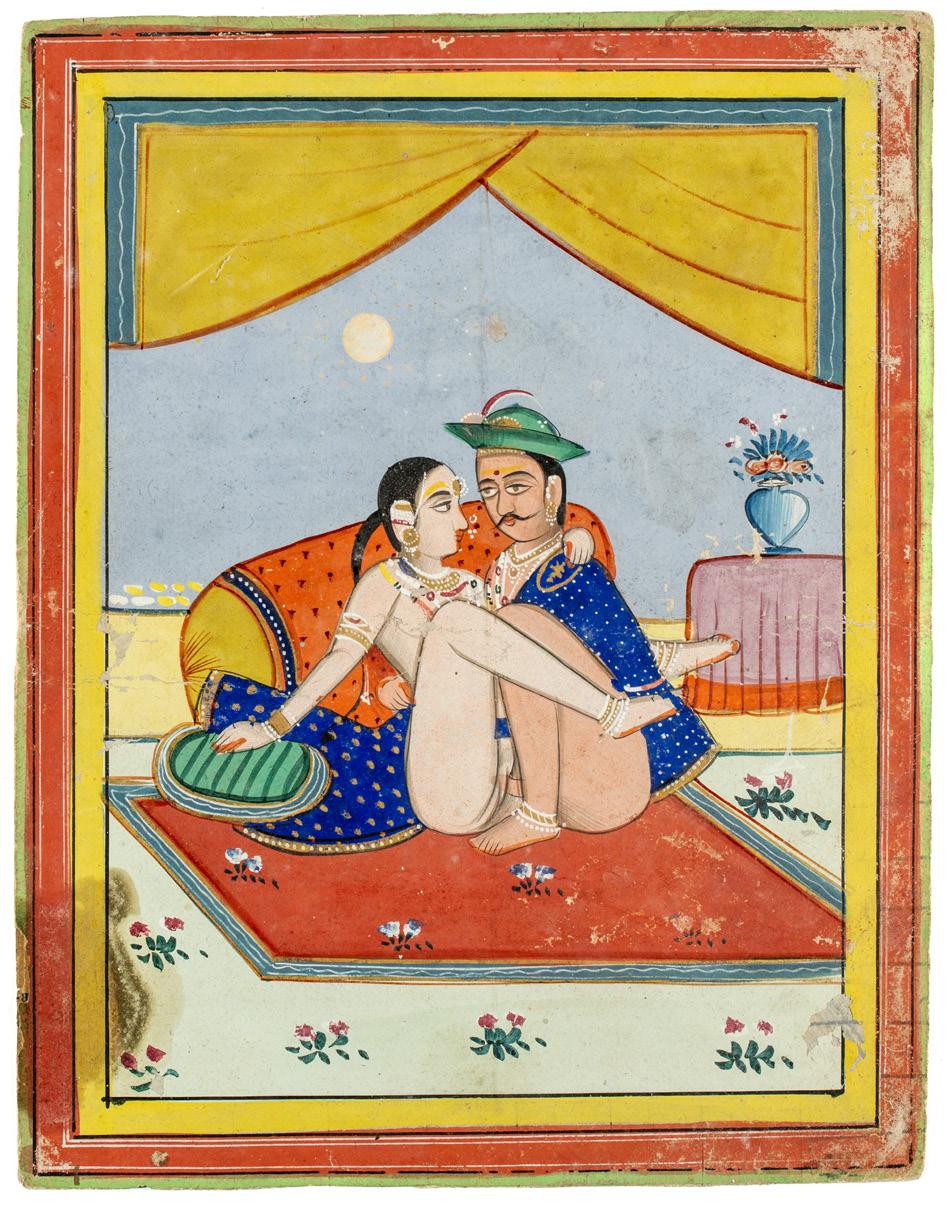

135.
A LADY ON A TERRACE WITH HER CAT, BUNDI, RAJASTHAN, CIRCA 1900, gouache with gold on paper, devanagari inscription on upper margin, 21.5 x 12cm £700-900

53
135

54 136. PORTRAIT OF A NOBLEMAN WITH ATTENDANT, RAJASTHAN, INDIA, CIRCA 1800, gouache with silver and gold on paper, inscription along top margin reading 'Sri Rajan Vaisnav Rajaji', signed 'Indrajit Singh', on the reverse, along with stamped crest of the Thakurs of Masuda, Rajasthan, mounted, 20 x 15.5cm (image) £600-800

55 137. A RULER WITH THREE MAIDENS, RAJASTHAN, INDIA, 18TH CENTURY, gouache with gold on paper, signed 'Indrajit Singh', on the reverse, along with stamped crest of the Thakurs of Masuda, Rajasthan, mounted, 23 x 13.8cm (image) £1200-1500
138.
JANGARH SINGH SHYAM, INDIAN, TWO DRAWINGS, DATED 1996, ink on thin card, each depicting animals around a stylised tree, signed and dated lower right, 55 x 70cm; 56.5 x 72cm (2)

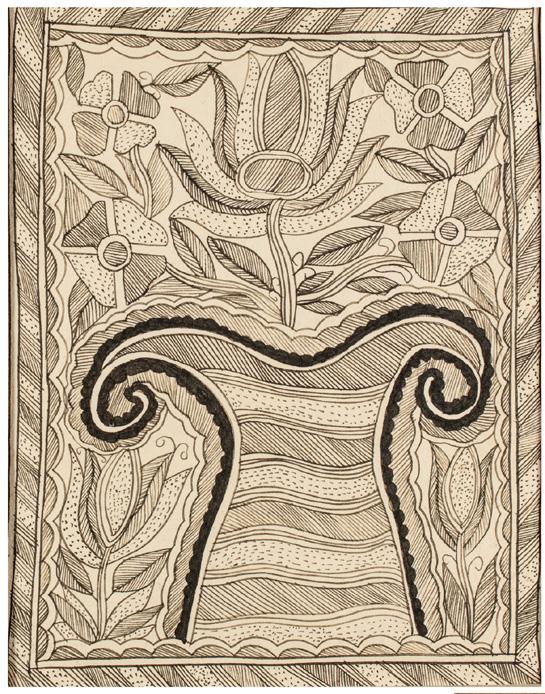
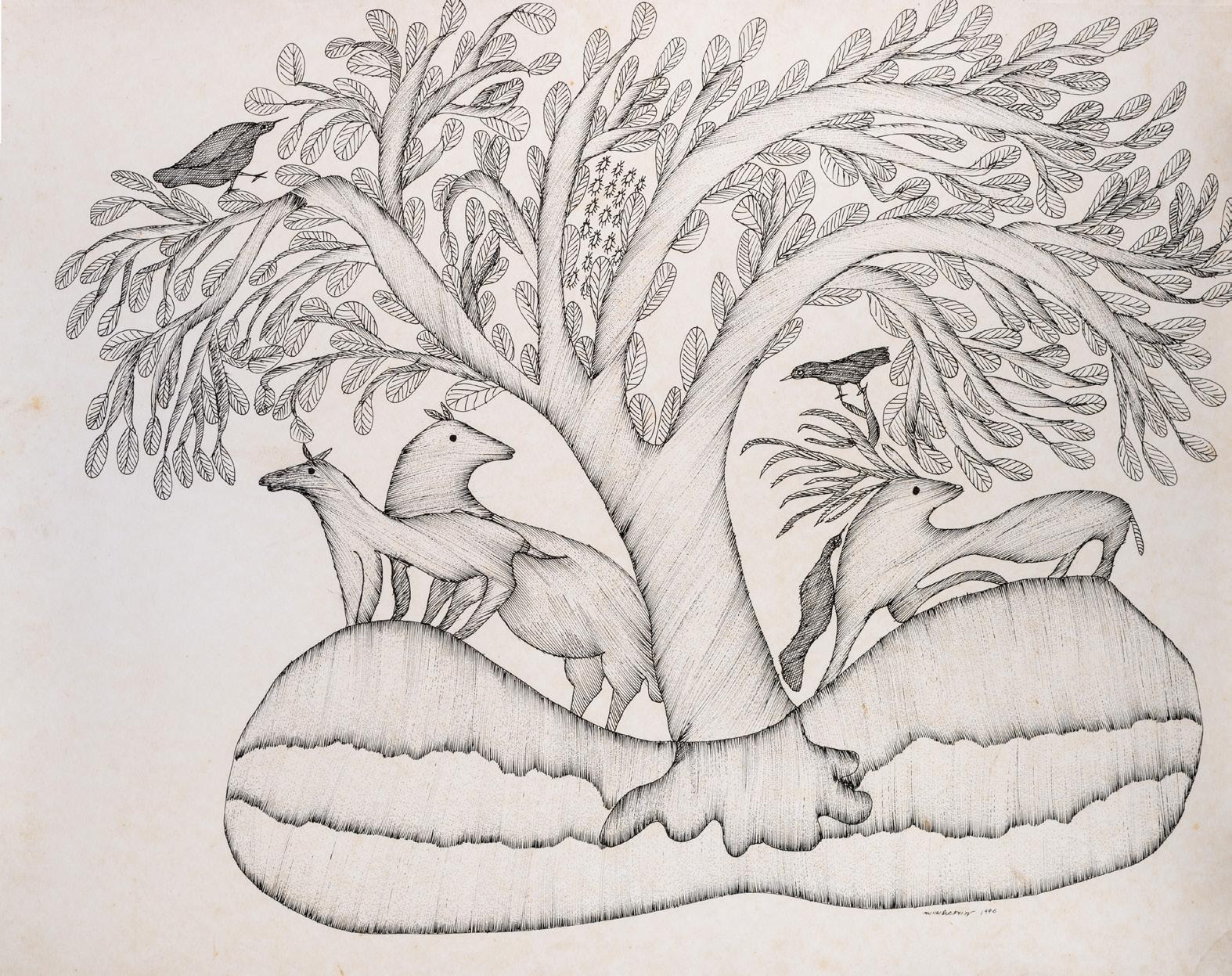
Provenance: Private collection, Western England Jangarh Singh Shyam is from a tribal community in the forested region of Central India. He was discovered by the well known artist J. Swaminathan in the 1980s while looking for works of art for his museum of rural and urban art. Despite at first struggling with the transition from rural to urban life, Jangarh was tempted to move to Bhopal, where materials, facilities and money enabled him to explore his creativity. For a detailed discussion of his work, see Sheikh 1998, pp. 16-33.
£150-250
139.
FOUR SMALL MADHUBANI PAINTINGS, BIHAR, NORTHERN INDIA, MID-20TH CENTURY, ink on paper, one with watercolour, depicting a woman, a fish, a bird and a lotus respectively, mounted, 21 x 17cm approx. each (excluding mount)


Provenance: Private collection, Western England
Three inscribed 'Veena Devi, Dariyakrata, Jitwarpur'. Jitwarpur is a small village in Bihar which has become famous for its characteristic folk paintings, known as Madhubhani or Mithila.
£200-300
part
56
140.
MAQBOOL FIDA HUSAIN, INDIAN, (19132011), 'GAJA GAMINI-IN THE KERALA JUNGLE', limited edition print, signed by the artist, numbered 115/300, 52 x 35.5cm Provenance: Private collection, Western England £600-800
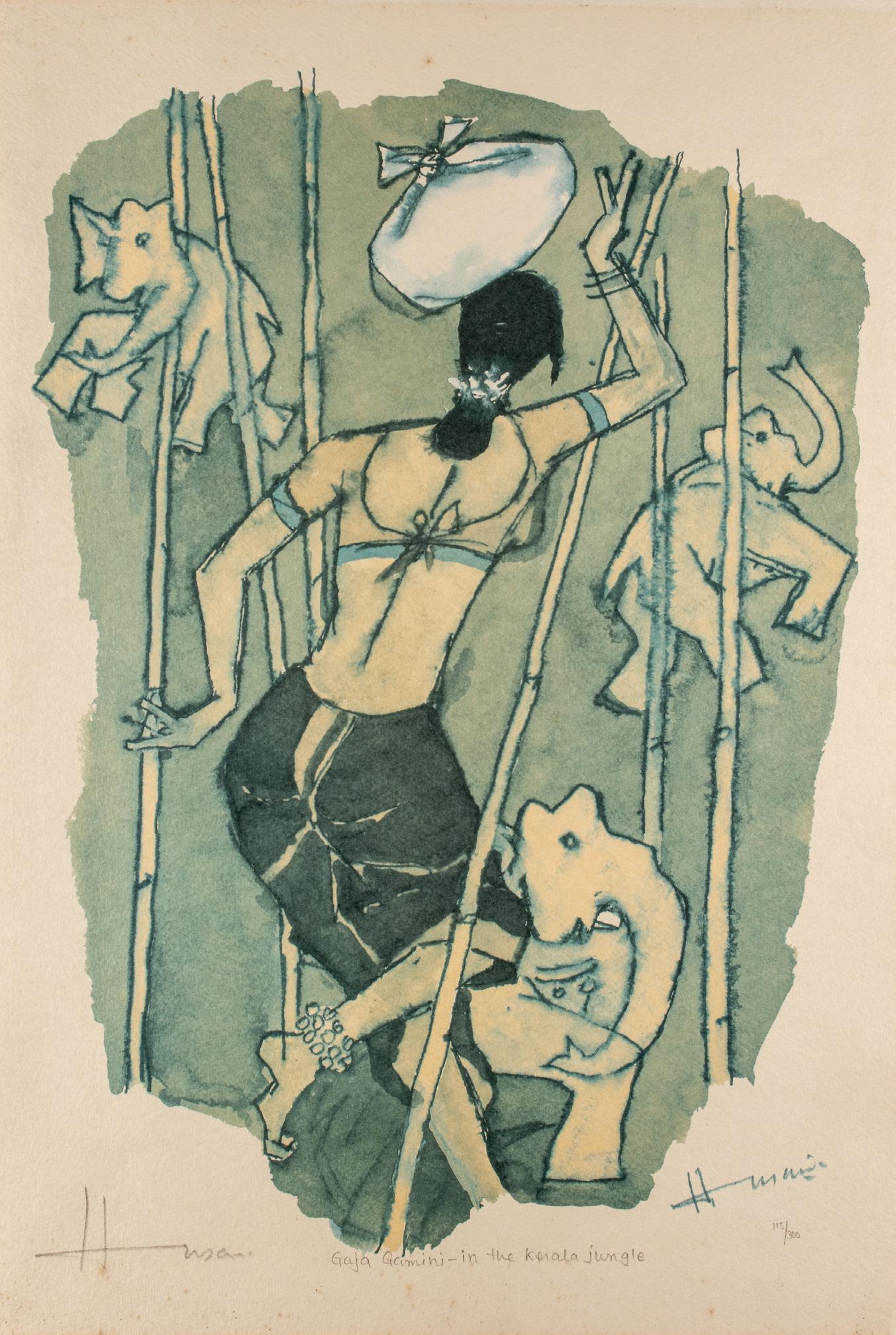
141.
INDIAN SCHOOL, CIRCA 1920-30, THE MASSACRE AT JALLIANWALA BAGH, ink with pencil on paper, probably a preparatory sketch for a painting, inscribed 'Jalianwalabagh II (Rough)’ on the reverse, 16 x 33cm
The Amritsar Massacre of 1919 instigated by Brigadier-General Reginald Dyer, in which it is thought more than a thousand unarmed protesters were killed and many more injured, was probably the most notorious episode of the colonial period in India, marking a turning point in the independence movement. £80-120
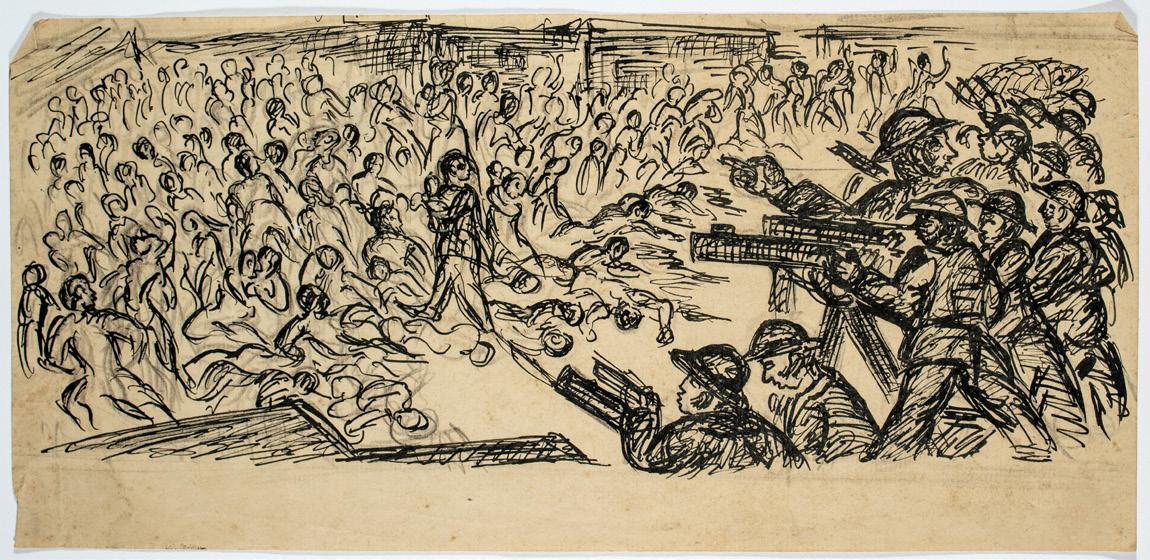
57
142.
DURGA WITH A ROYAL DEVOTEE, JODHPUR, RAJASTHAN, INDIA, 19TH CENTURY, gouache on paper, the multi-armed goddess seated on a lion throne on a palace terrace, figures of Krishna and Balarama behind, a verdant landscape with lake in the background, 26.5 x 19cm
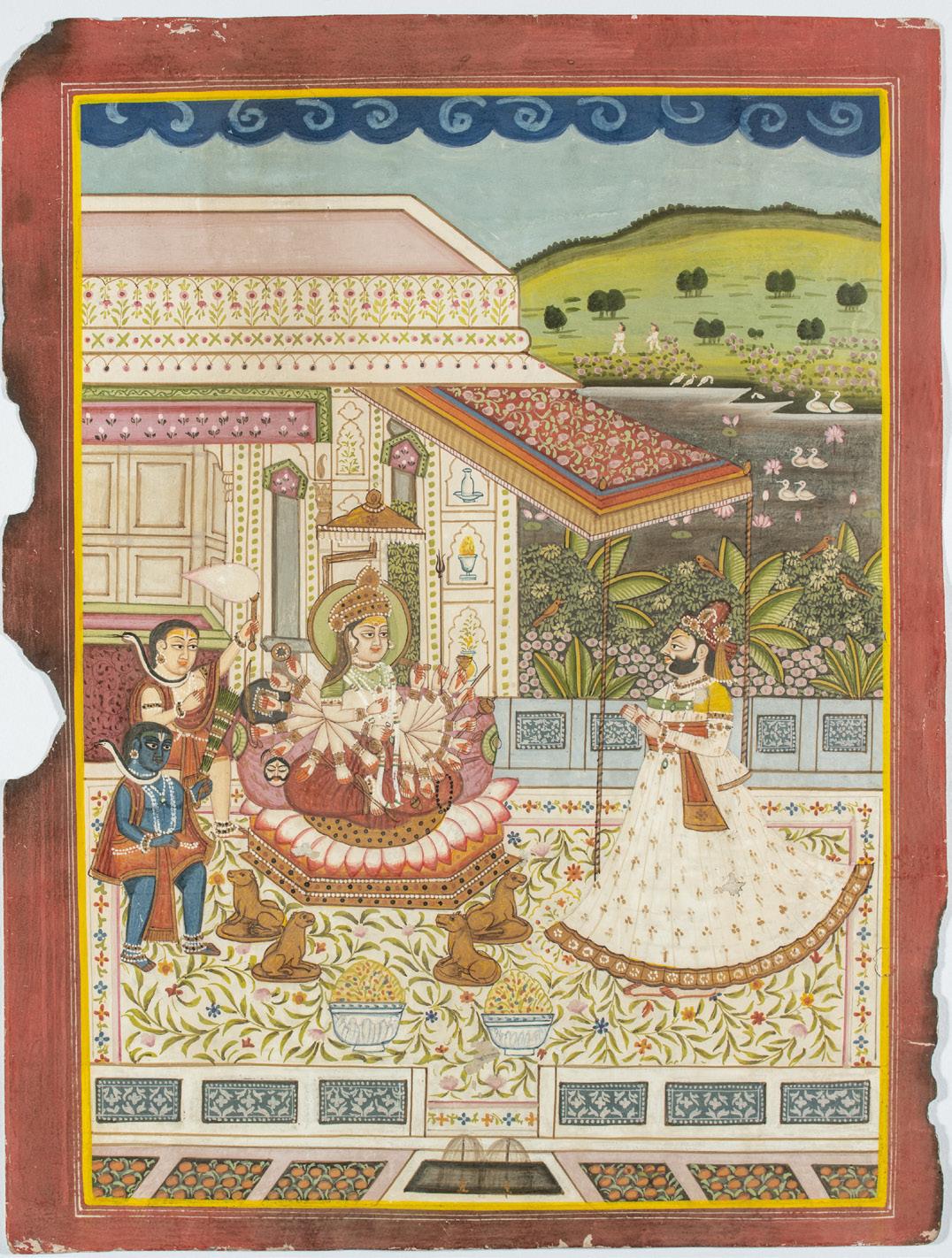
£300-400
143.
A PORTRAIT OF A PARSI GENTLEMAN WITH HIS YOUNG CHILD, INDIA, PROBABLY MUMBAI, EARLY 20TH CENTURY, gouache on paper, of oval form, framed, 15 x 12.4cm
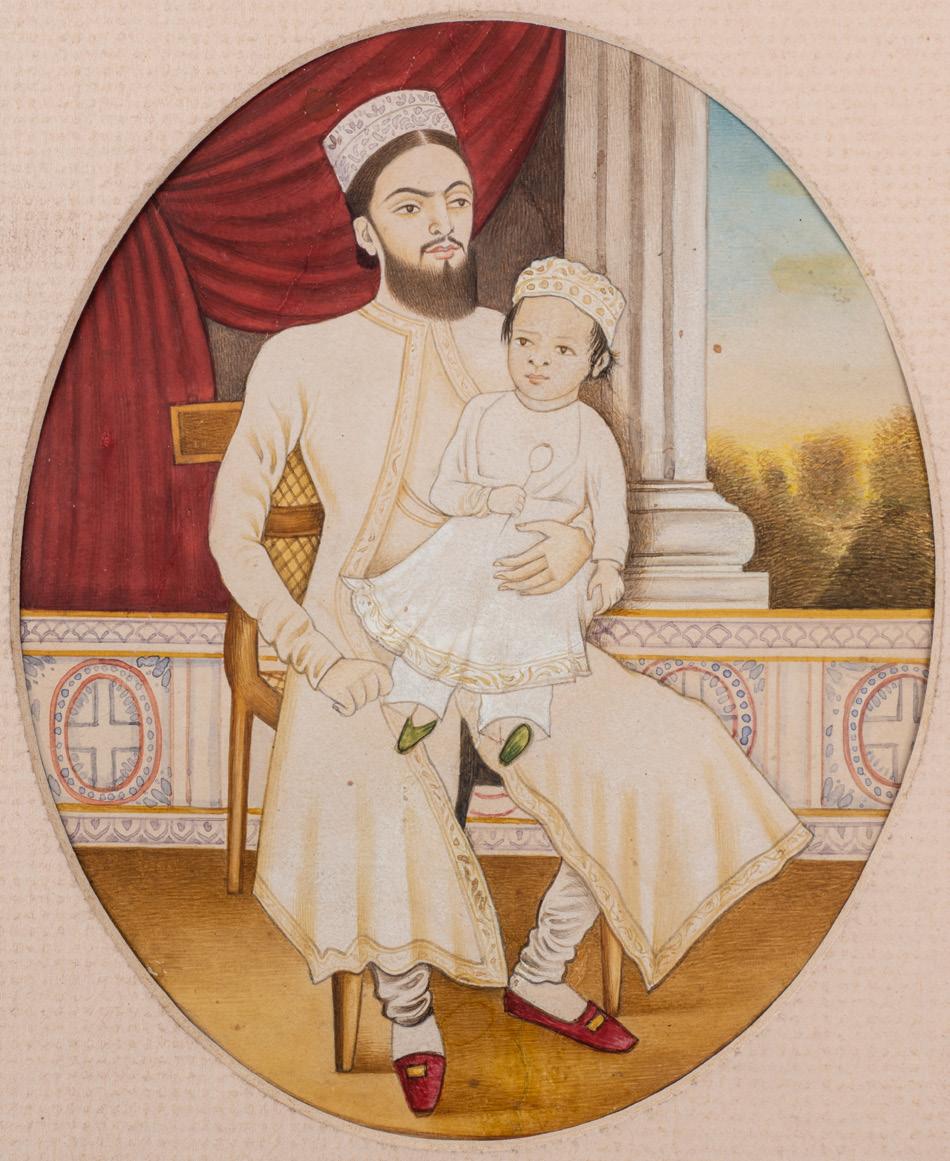
£150-200
144.
TWO POLYCHROME PAINTED CLOTH HANGINGS (PICHHAVAI), RAJASTHAN, INDIA, 20TH CENTURY, pigment on cotton, each of rectangular form, depicting Krishna with the gopis, 210 x 134cm; 106 x 70cm £80-120

58
part
145.
A SCENE FROM THE MAHABHARATA, PUNJAB HILLS, EARLY 19TH CENTURY, gouache with gold on paper, depicting Arjuna being driven by Krishna in his chariot, framed, 25 x 17.5cm (image)

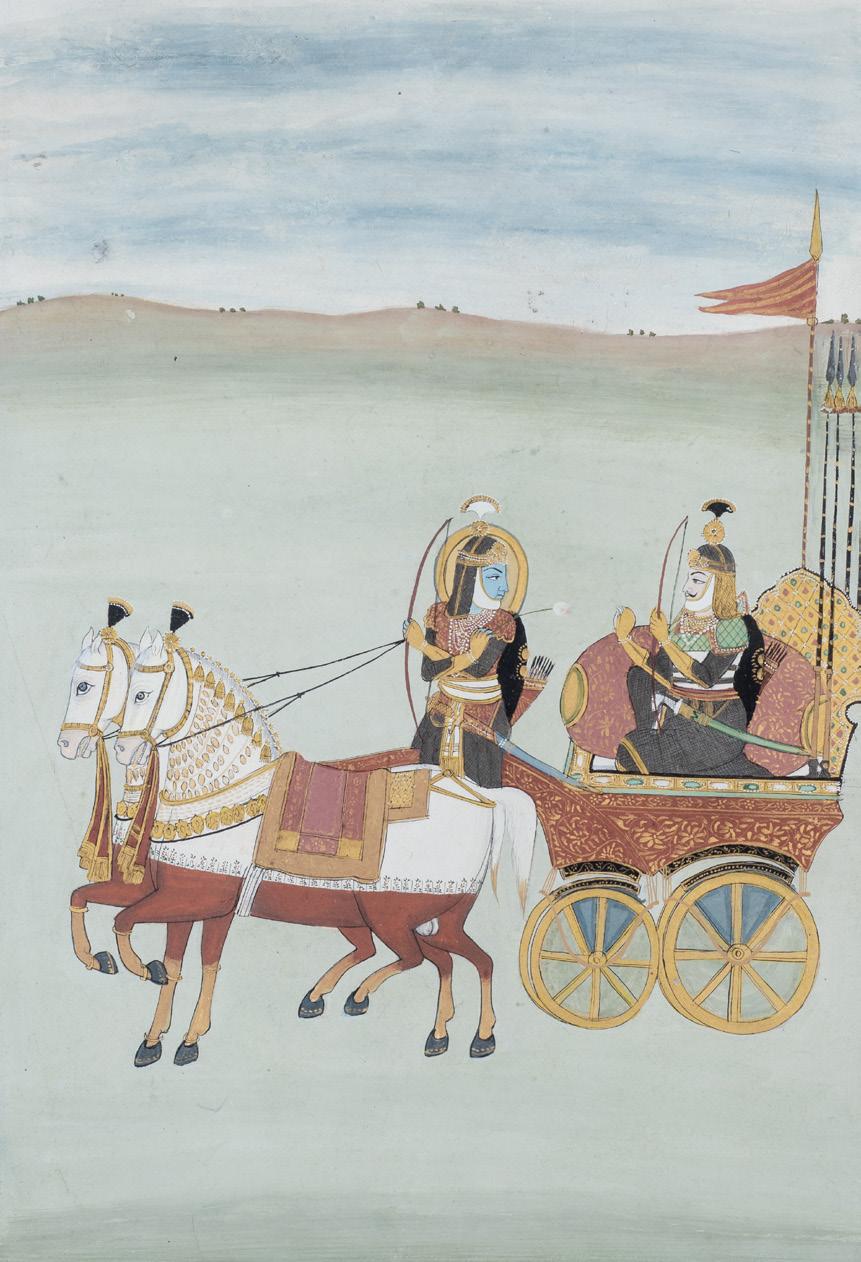
During the battle of Kurukshetra, Arjuna, son of the god Indra, Krishna helped and encouraged Arjuna, who was hesitant about fighting against his own cousins, despite right being on his side.
£300-500
146.
KRISHNA AWAITS RADHA, PROBABLY BIKANER, RAJASTHAN, 18TH CENTURY, gouache with gold on paper, the god reclining in a palace while his lover approaches accompanied by attendants, a river teeming with wildlife in the foreground, a stormy sky and fort in the background, surrounded by a floral border, a line of devanagari script above within a yellow cartouche, framed, 28 x 42cm (folio); 20 x 32cm (image)
£700-900
59
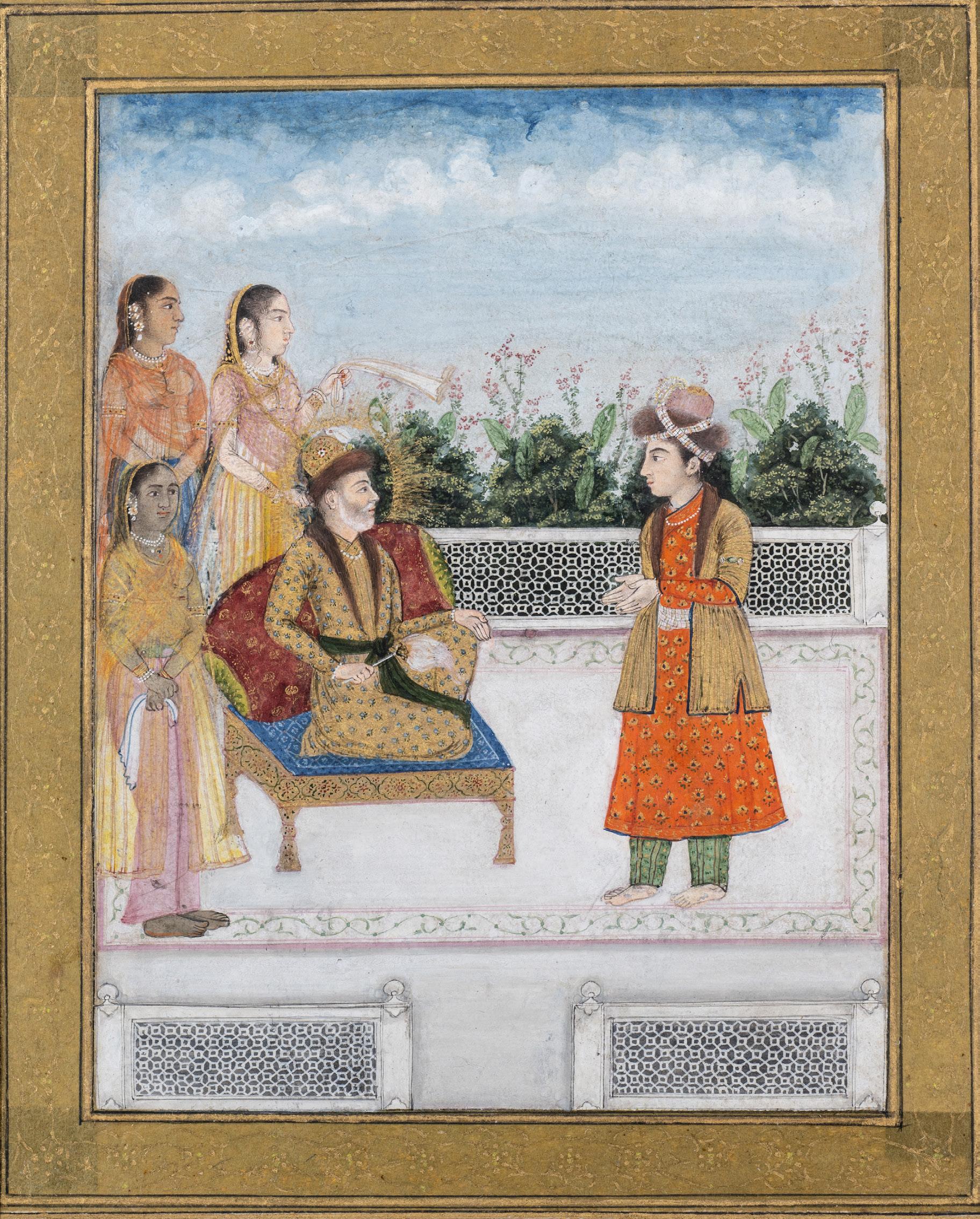
60 147. A RULER CONVERSES WITH HIS SON, DECCAN, INDIA, 18TH CENTURY, gouache with gold on paper, laid on an album page, the two men on a terrace wearing brocade coats and fur hats, three female attendants on the left, 14 x 10.5cm (image); 33 x 22cm (folio) £2000-3000
MUGHAL PORTRAIT
SHAH JAHAN,
INDIA, 18TH CENTURY, gouache with

on paper,
subject
15cm
within a yellow border,
gilt frame on a palace wall, the dado below
61 148. A
OF
MUGHAL,
gold
the
depicted as a painting in an oval
decorated with floral bouquets, birds and mosquitoes,
framed, 21.5 x
(image) £1800-2200
149.
A FOLIO FROM A DISPERSED MANUSCRIPT, KASHMIR, 19TH CENTURY, gouache with gold and ink on paper, depicting a maiden pausing at a river to wash, while being watched by a horseman, four columns of nastaliq on either side, framed, 29 x 14.4cm (inside mount) £200-300

150.
A SUFI TEACHER WITH HIS FOLLOWERS OUTSIDE A CAVE, KASHMIR, EARLY 19TH CENTURY, gouache with silver and gold on paper, framed, 17.5 x 14.5cm (inside mount) £600-800

62
RULER
open
RAJASTHAN,

CENTURY,
two Europeans in a palace
setting
flanked by two
by a red painted
63 151. A
AND HIS COURTIERS, KOTA,
MID-19TH
gouache with gold on paper, the figures including
interior, the
window at the back with the
sun,
female attendants carrying offering dishes, surrounded
border, framed, 30 x 42.5cm £800-1200
152. PORTRAIT OF A MAN, ANGLO-INDIAN SCHOOL, CIRCA 1900, watercolour on paper, mounted, 27.2 x 19cm £100-150
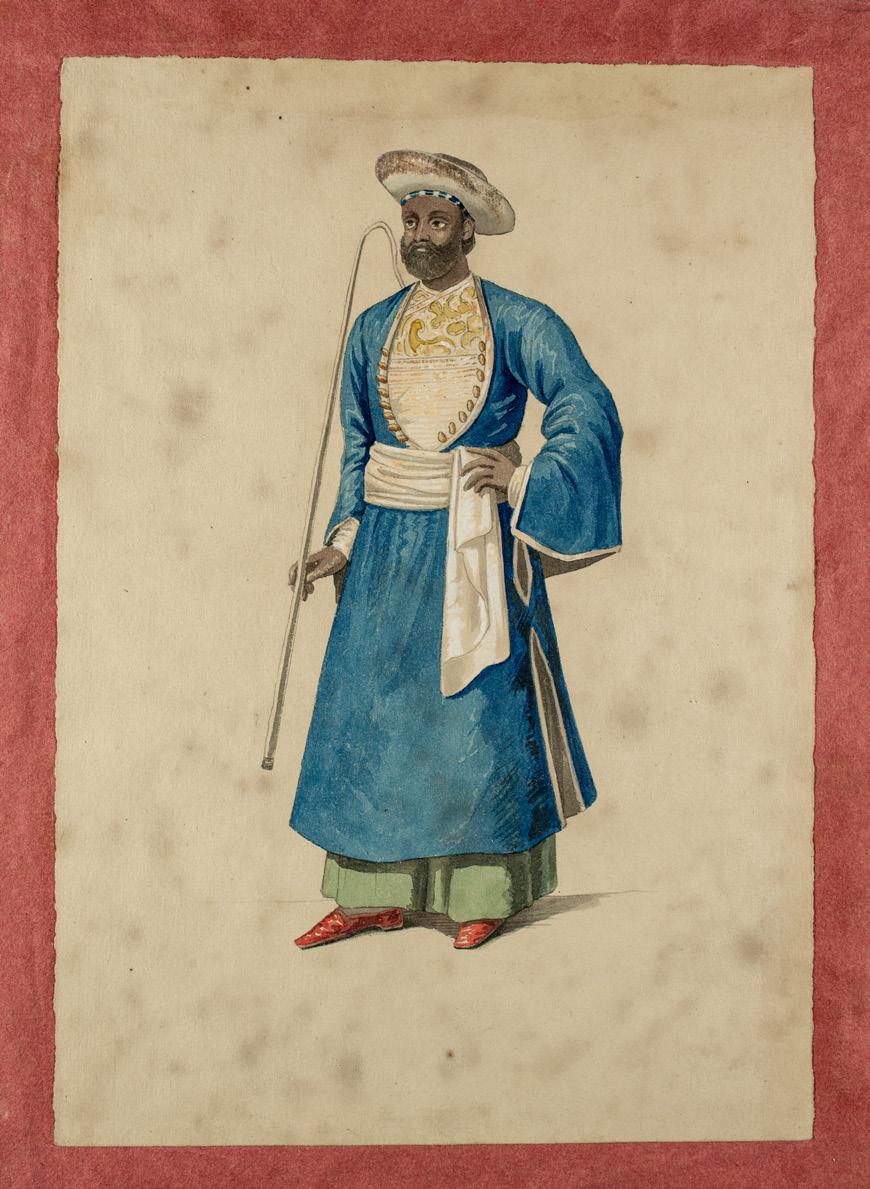
153. A PILGRIMAGE PAINTING OF THE JAGANNATH TEMPLE AT PURI, ORISSA (NOW ODISHA), EASTERN INDIA, 20TH CENTURY, pigment on cloth, the trio of Jagannath, Balabhadra and their sister Subhadra depicted inside the shrine, flanked by Brahma and Siva in arched niches, surrounded by other deities and symbols within a floral border, framed, 38.5 x 34.5cm £100-150

154. FOUR COMPANY SCHOOL PAINTINGS, TRICHINOPOLY (NOW TIRUCHIRAPALLI), TAMIL NADU, SOUTH INDIA, MID-19TH CENTURY, gouache on mica, depicting a chariot pulled by bullocks, a palanquin with European lady inside, a camel and rider and a ruler on horseback with attendants, framed as two pairs, 9.8 x 14.2cm each inside mount £400-600

64
part
155.
A SAIVITE PILGRIMAGE CHART, NORTHERN INDIA, 20TH CENTURY, coloured print on paper, depicting a stylised landscape map dotted with shrines, each labelled, with rivers and a fortified city, winged apsaras in the heavens above, surrounded by a border of massed sivalingams, framed, 95 x 77cm

£120-150
156.
A GROUP OF SHADOW PUPPETS, DECCAN, INDIA, 19TH CENTURY, painted, cut and pierced vellum, including figures of a warrior, probably Balarama, the monkey god, Hanuman, two male figures and a demonic figure, together with loose parts, (100 x 50cm average size)
(approximately 9 items including loose parts)
For related puppets previously sold in these rooms, see 20 November 2019, lot 211, and a closely related puppet is in the Museum of Folk and Tribal Art, Gurgaon, near Delhi, (Aryan 2005, p. 83, no. 152).
£500-800

65
part
157.
A PANORAMA OF THE DELHI DURBAR, BOURNE AND SHEPHERD STUDIO, 1912, composed of five gelatin prints, mounted together, framed, inscribed 'Bourne and Shepherd' on right end print, inscribed 'Delhi Durbar 1912 [sic]' on mount, image as group 18 x 135cm
The apparently erroneous dating may refer to the production of the photograph, rather than the event depicted. The Delhi Durbar, held on 12 December 1911, was the third of three held in Coronation Park during the British Raj. It marked the coronation of George V which had taken place in London six months earlier. The park, on the northern edge of the Indian capital, is now the repository of a number of British statues removed from prominent sites on the streets of New Delhi.

£600-800
158.
A CEREMONIAL CLOTH (TAMPAN), LAMPUNG, SUMATRA, INDONESIA, 19TH CENTURY, woven russet and indigo cotton, with an intricate design of stylised ships amongst semi-abstract figures and animals, surrounded by bands of geometric and scroll motifs, mounted on stretcher, 97cm square approx. (cloth); 103cm square (stretcher)

Provenance: Collection of a deceased diplomat, thence by descent.
Tampans were produced mostly by the women of Lampung, a region rich from the cultivation of pepper. Almost all families would have possessed a few of these cloths which were used for display at family ceremonies such as marriage and had a variety of functions including being used to cover food. For other Sumatran ceremonial textiles with stylised ship designs, see Gittinger 1985, pp.89-93.
£600-800
66
SARONG (TAPIS), KAUER PEOPLE, LAMPUNG, SUMATRA, INDONESIA,
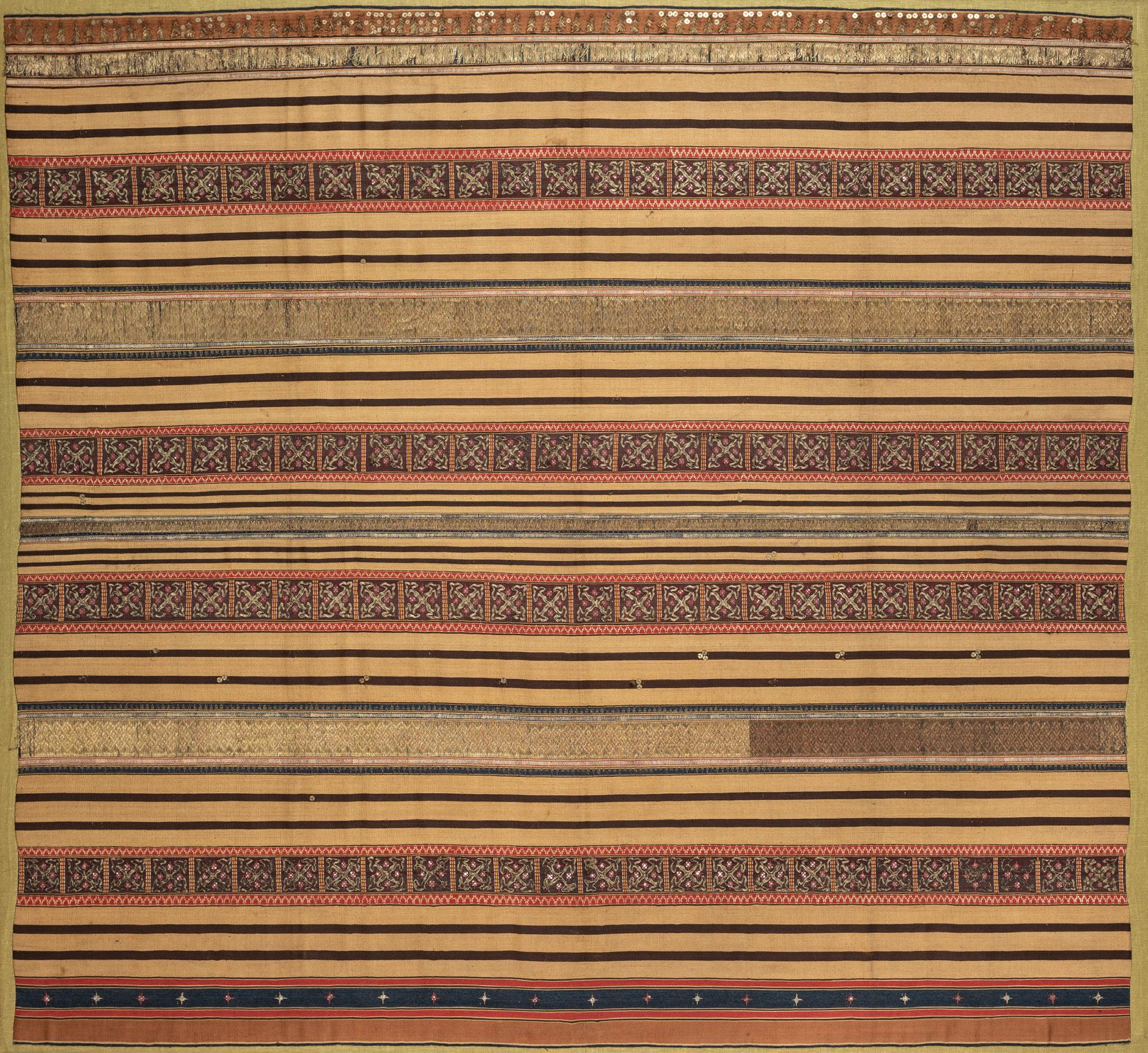
CENTURY, woven and embroidered silk, with gilt thread and silver gilt applique, of square form, the decoration comprising a series of stripes, some plain, others with stylised leaf and abstract motifs, mounted on stretcher,
x 124cm approx. (cloth); 118 x 128cm (stretcher)
Collection of a deceased diplomat, thence by descent.
a photograph of a Kauer woman wearing a related example, see Gittinger 1985, pl.45,
67 159. A WOMAN'S
19TH
114
Provenance:
For
p.85 £800-1200
160.
A WOMAN'S SARONG (TAPIS), LAMPUNG, SUMATRA, INDONESIA, 19TH CENTURY, woven and embroidered cotton and silk, with gilt thread and mirror glass applique, of square form, the decoration comprising a series of intersecting stripes, with semi abstract motifs including waves and stylised figures, mounted on stretcher, 124cm square approx. (cloth); 127cm square (stretcher)

Provenance: Collection of a deceased diplomat, thence by descent.
For two closely related tapis cloths, see Gittinger 1985, pls.43 & 44, pp.82-83 (also colour plate of no.44).
£1200-1800
68
161 (detail)
161.
A LENGTH OF SILK IKAT CLOTH, YAZD, PERSIA, EARLY 20TH CENTURY, of long double rectangular form, divided by tassels, with polychrome stylised tree and medallion design, 350 x 120cm

£100-150
162.
A SAFAVID BROCADE PANEL, PERSIA, 17TH CENTURY, woven silk, with design of repeated stylised carnations, cypresses and irises, in gold and silver coloured thread on black ground, framed and mounted, 44 x 34cm
£100-150
163. (illustrated online)
162
□
A SMALL ASHAVALI BROCADE PANEL, AHMEDABAD, GUJARAT, 19TH CENTURY, silver thread on gold coloured silk ground, with a trellis design of turtles and fish, framed and mounted, 24 x 25cm £80-120
164.
A BENARES BROCADE SARI, NORTHERN INDIA, LATE 19TH CENTURY, of long rectangular form, profusely woven in gilt metal thread on mauve silk ground, the field decorated with a leafy trellis framing repeated floral lozenge motifs, the ends with panels of repeated registers of stylised flowering plants, a similar border running along each side, part lined, 284 x 86cm

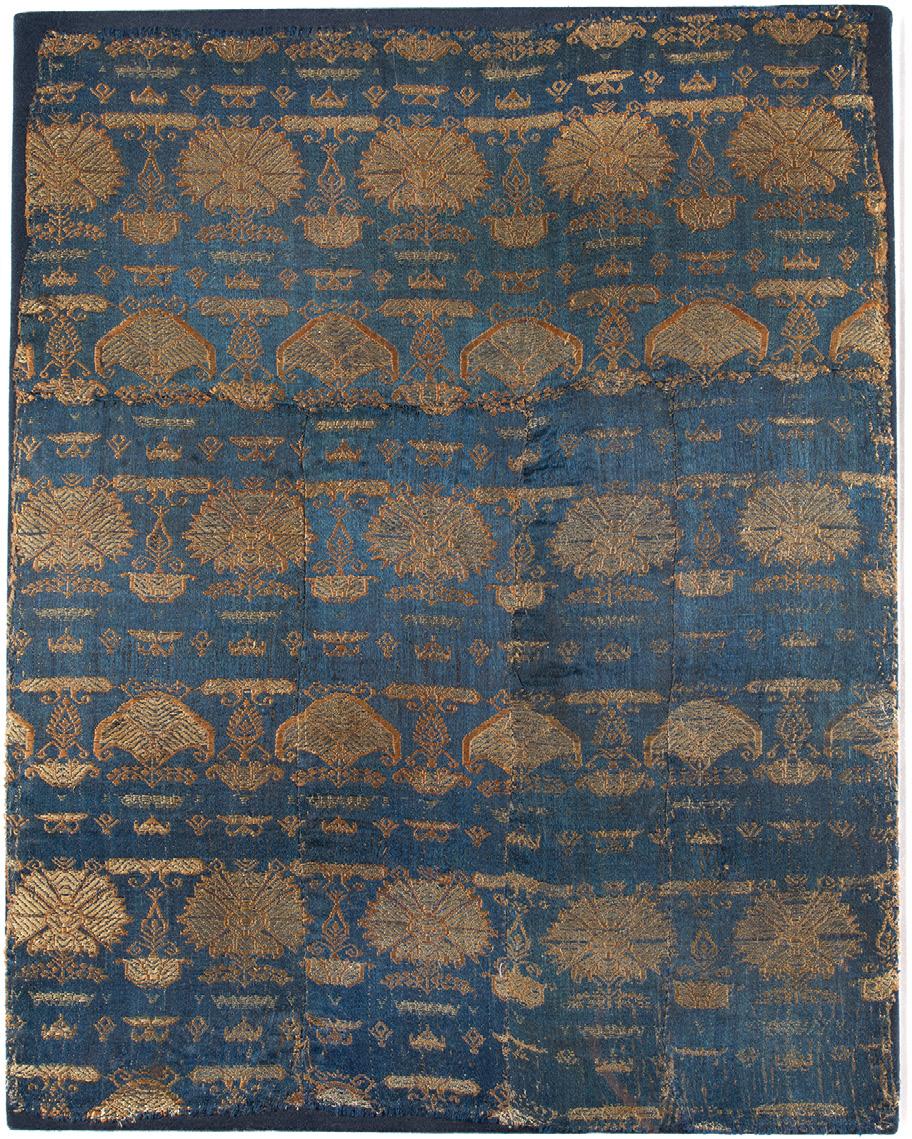
£120-150
(detail)
69
164
part
165.
A GROUP OF MISCELLANEOUS INDIAN AND CENTRAL ASIAN TEXTILES, 19TH/20TH CENTURY, comprising a long flatweave tasselled strap, a Turkmen cap with silver applique and glass bead tassels, five Gujarati mirror glass applique and embroidered entrance hangings, and eight other similar Gujarati covers and panels, (15)

£200-300
166.
AN EMBROIDERED COTTON WALL HANGING (CHAKLA), KATHIAWARE, GUJARAT, WESTERN INDIA, EARLY 20TH CENTURY, with mirror glass appliquework, of square form, with polychrome figures and animals arranged around a central floral roundel, 150cm square approx.; together with a tubular garment (malong a landap), Maranao People, Philipinnes, circa 1900, with tapestry weave bands with geometrical design, sewn onto silk bands, 163 x 92cm

The malong a landap is worn by both men and women in northern Mindanao. For another example in the Ayala Museum, Manila, see https://www.ayalamuseum. org/collection/9284225
£200-300
70
part
167.
A LARGE OTTOMAN EMBROIDERED HANGING, ANATOLIA, CIRCA 1900, coloured felt with silk embroidery, of tall rectangular form, the central panel with tughra and naskh inscription, four floral quatrefoil medallions below, surrounded by two concentric floral bands, later red lining with padded edges, 385 x 112cm (including lining)

£400-600
168. (illustrated online)
□ A GROUP OF METAL AND WOOD OBJECTS, INDIA, 19TH / 20TH CENTURY
comprising a lid in the form of a peacock and a stopper in the form of a chhatri, both mounted, part of a pipe(?) of horizontal cylindrical form with bird head finials, and a ladle, with diagonally protruding shaft, mounted, and a bronze idli pan, 36cm diam. and smaller
£80-120
169.
A FRAGMENTARY PILGRIM FLASK WITH RELIEF DECORATION, RAJASTHAN, INDIA, LATE 19TH CENTURY, blue and white underglaze painted fritware, the body with an image of Siva in relief on either side, with his vehicle Nandi Bull below, the edges painted with floral arabesques, 26cm high

For a closely related flask in the Albert Hall Museum, Jaipur, see Michael 2009, p.50.
£80-120
71
170.
A MUGHAL STYLE PIETRA DURA INLAID MARBLE FOOTSTOOL, AGRA, NORTH INDIA, 2006, of square form resting on four short bun feet, the stylised foliate decoration in the style of Shah Jahan's reign, the inlay including carnelian, lapis lazuli, agate and jade, 7.5 x 40.5 x 40.5cm

Provenance: Private collection, England. Commissioned by the vendor at Oswal Emporium in Agra. £1200-1500
171.
A MARBLE PLANTER, RAJASTHAN, INDIA, 20TH CENTURY, of square form, the sides carved with an acanthus leaf design, 19cm high; 52.5cm approx. square £200-300
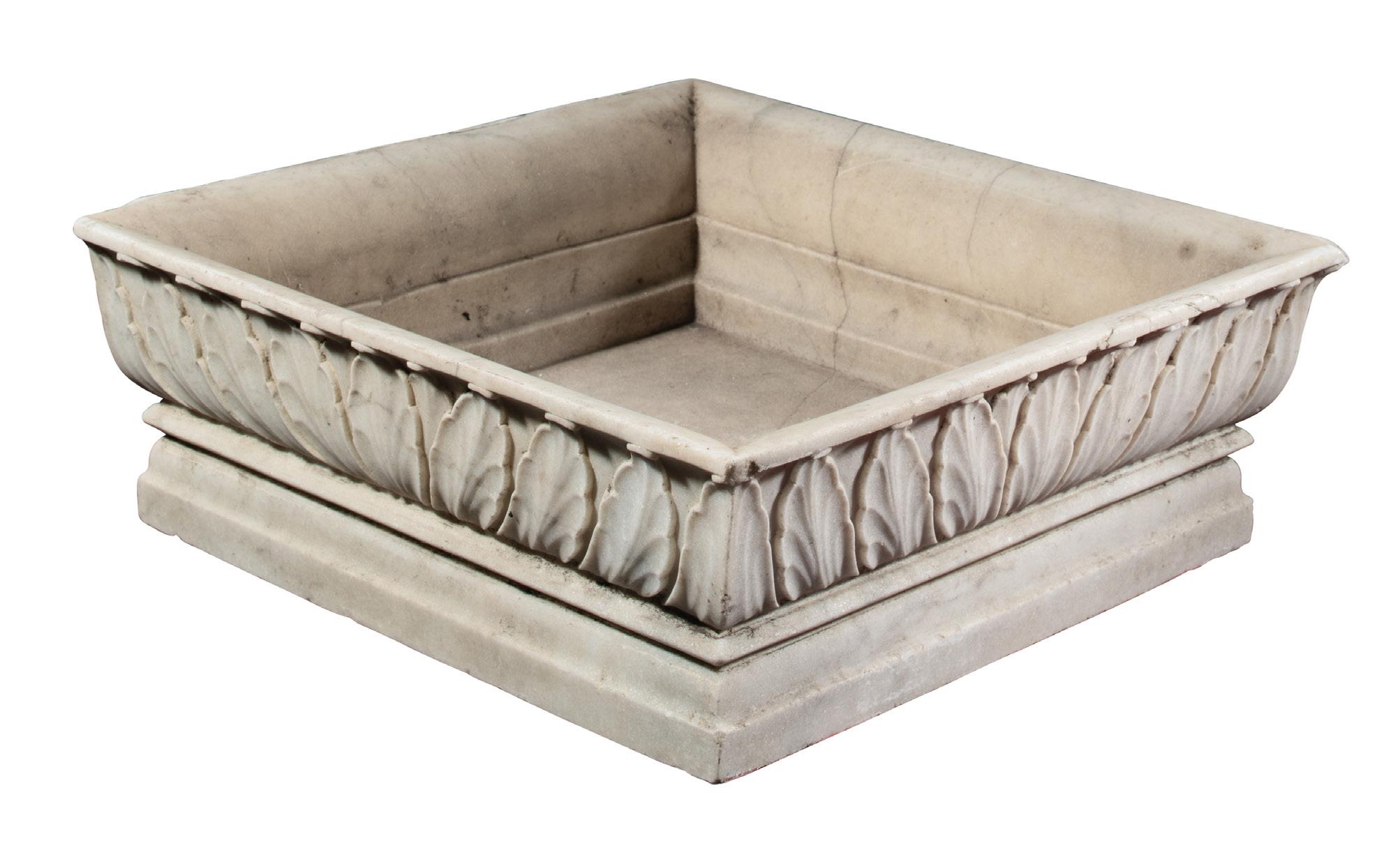
72
172.
~ FOUR VIZAGAPATAM BOXES, SOUTH-EASTERN INDIA, LATE 19TH CENTURY, each of sandalwood with engraved and pierced ivory overlay, three with horn, one with tortoiseshell veneer, the smallest a watch holder, the other three each with hinged convex lid, 8.5 x 27 x 12.5cm and smaller
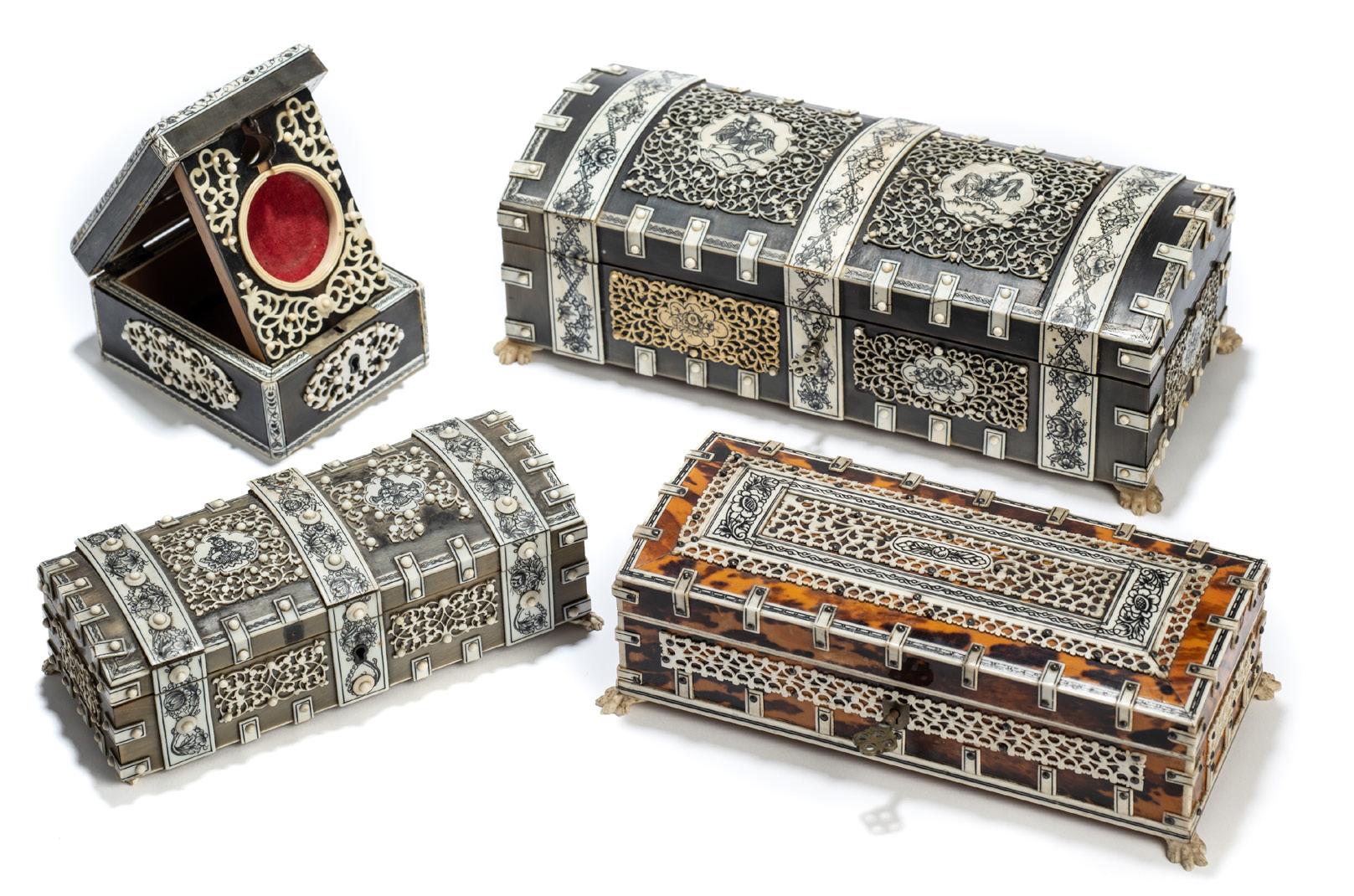
For a similar box previously sold in these rooms, see 11 May 2022, lot 152.
£400-600
173.
TWO MULTAN DISHES, PUNJAB, INDIA (NOW PAKISTAN), CIRCA 1900, underglaze painted earthenware, each of shallow concave circular form on ring foot, painted with central inscribed cartouche surrounded by scrolling floral designs, 39cm, 31cm diam.

The inscription on the larger dish has been translated 'the wealth which is good will be used for one's own benefit'; the smaller smaller dish reads 'khusamadeed' (welcome to all!).
£400-600
73
174.
A MAJAPAHIT TUFFSTONE
BUST OF A BOY, JAVA, INDONESIA, CIRCA 14TH CENTURY, wearing a jewelled necklace, his hair elaborately curled, a flower ornament over each ear, mounted, 18cm high
Provenance: Collection of a deceased diplomat, thence by descent.
£300-400
175.
A MAJAPAHIT TERRACOTTA RELIEF FRAGMENT, JAVA, INDONESIA, CIRCA 14TH CENTURY, depicting a woman carrying a pair of baskets, mounted 15 x 19 x 6cm

Provenance: Collection of a deceased diplomat, thence by descent.
£150-250
176. A MAJAPAHIT TERRACOTTA HEAD OF A DVARAPALA, JAVA, INDONESIA, CIRCA 14TH CENTURY with smiling face, moustache and furrowed brow, his wavy hair gathered in a topknot 12.5cm
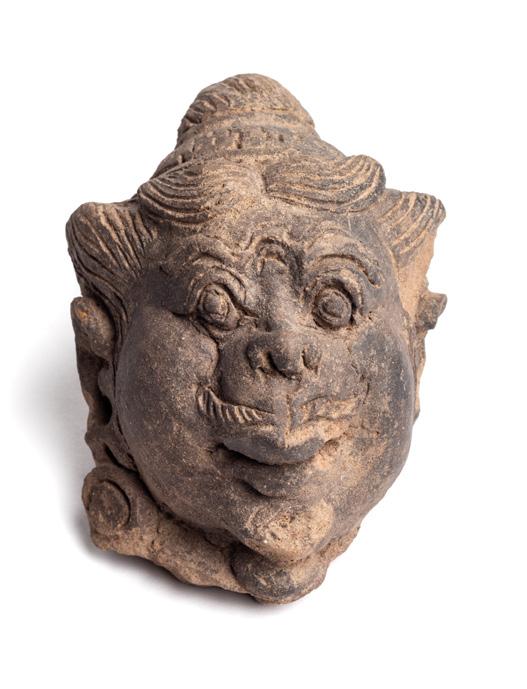
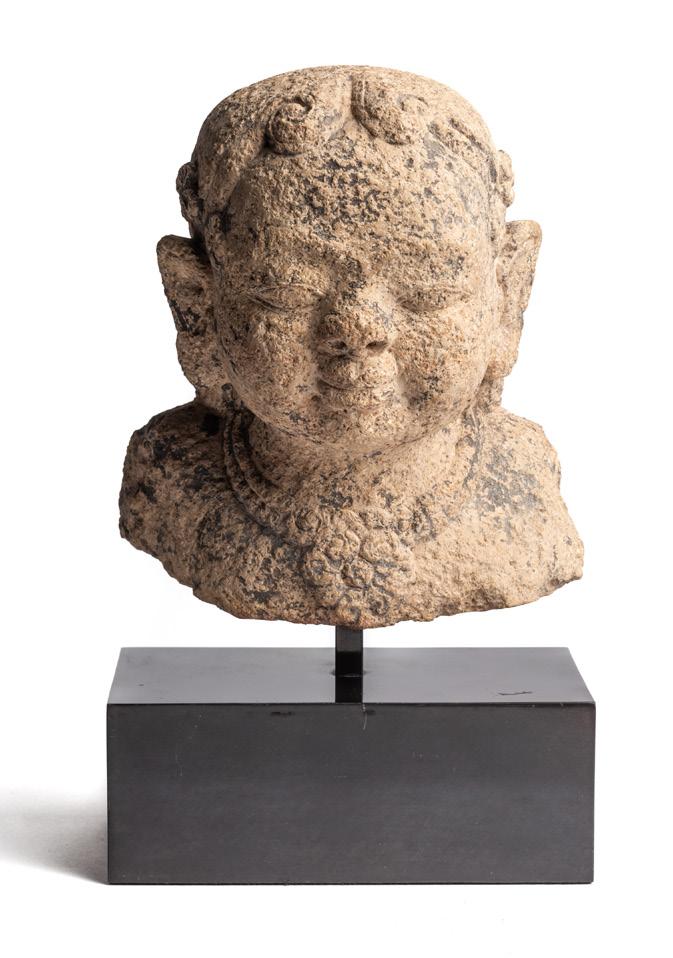
Provenance: Collection of a deceased diplomat, thence by descent.
£80-120
177.
NINE JAVANESE TERRACOTTA
HEADS, 12TH-14TH CENTURIES, three of maidens, the smallest with traces of pigment, one of an older woman, and four male heads of various characters and a larger head of a deity from a relief, all but two mounted on stands, 14cm high and smaller

Provenance: Collection of a deceased diplomat, thence by descent.
£400-600
74
178.
A COLLECTION OF TERRACOTTAS, INDIA AND JAVA, 1ST MILLENIUM BC AND LATER, comprising three Harappan objects, a Mauryan plaque, a Buddhist votive plaque, a crouching figure of an old man, and nine heads, 15cm (and smaller) (15)

Provenance: Collection of a deceased diplomat, thence by descent.
£80-120
179.
FIVE FRAGMENTARY MAJAPAHIT TUFFSTONE CARVINGS, JAVA, CIRCA 14TH CENTURY, comprising a pot in the form of a tortoise, a frog, an elephant, a figure of Ganesha and a bust of a devotee, 10cm long and smaller

Provenance: Collection of a deceased diplomat, thence by descent.
£120-150
179
180.
THREE MAJAPAHIT TUFFSTONE CARVINGS, JAVA, INDONESIA, CIRCA 14TH CENTURY, comprising a head of a man, a bust of a woman and a figure of a seated woman, wearing moustache and domed hat, mounted, 8.5cm high and smaller
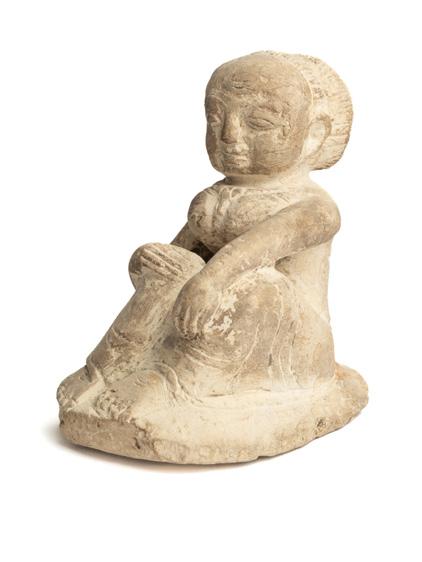
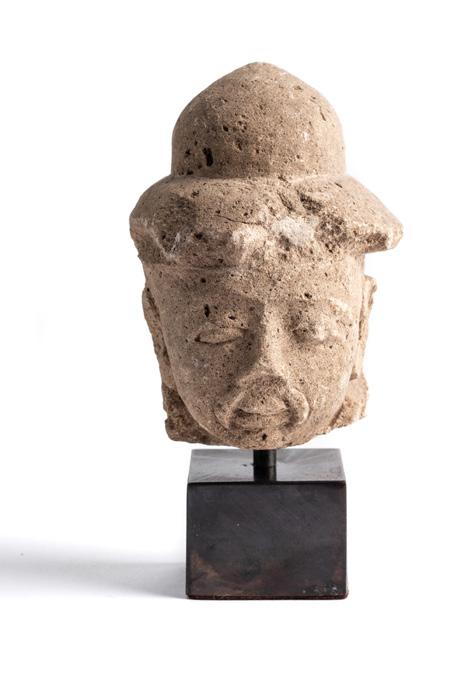

Provenance: Collection of a deceased diplomat, thence by descent.
£200-300
75
178 (part)
180
181.
A JAVANESE VOLCANIC STONE FRAGMENTARY FIGURE POSSIBLY DEPICTING SIVA, INDONESIA, CIRCA 9TH CENTURY, seated in sattvasana on a lotus throne, his hands resting on his knees, a lotus flower(?) in his left hand, 49cm high
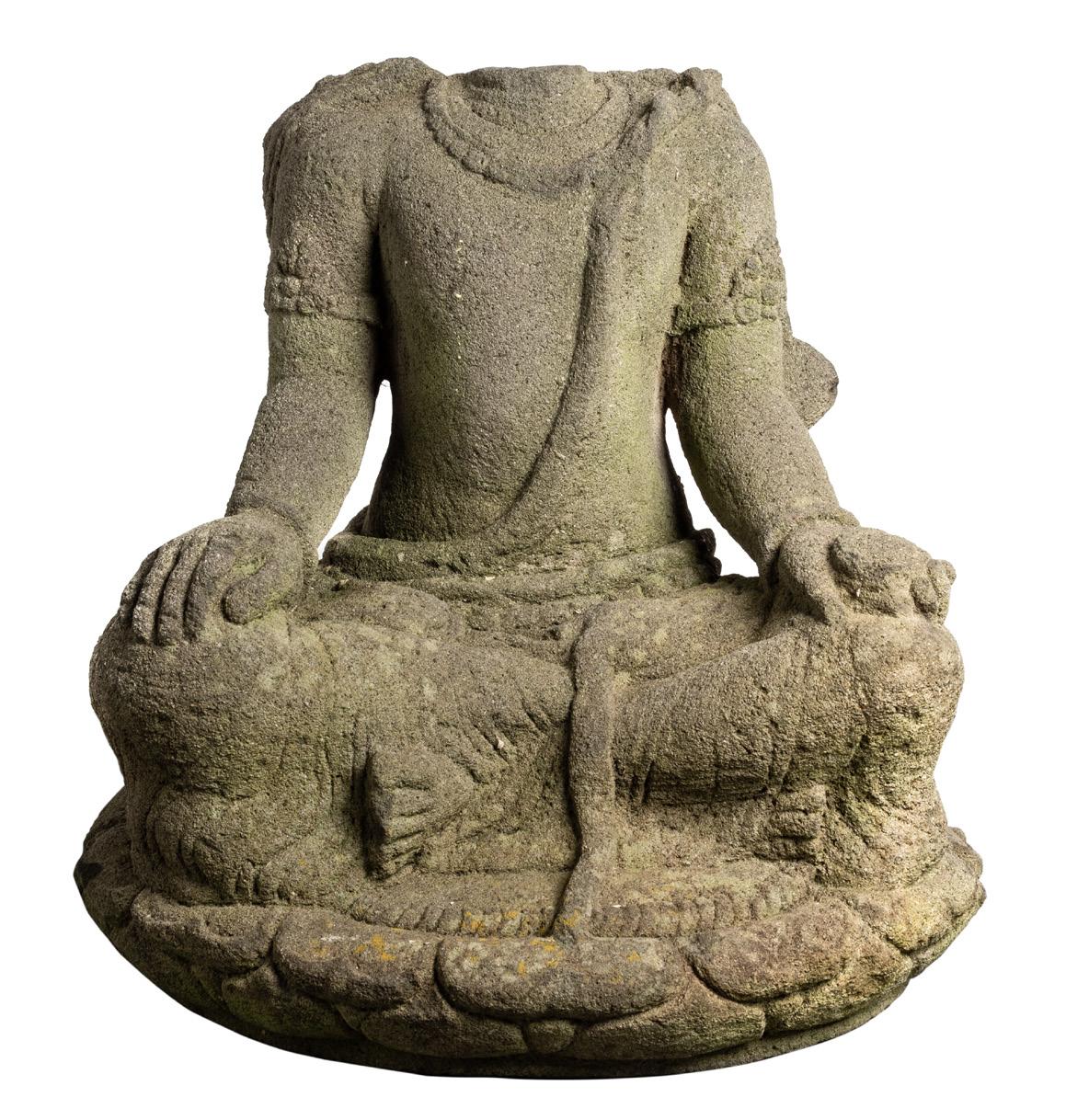
Provenance: Collection of a deceased diplomat, thence by descent, thought to have been acquired in the 1960s.
Although at first sight this appears to be a figure of Buddha, the positioning of the hands suggests otherwise Even more telling are indications of two further arms, now missing, and the long hair which still falls onto his shoulders. A plausible comparison is the 9th century figure of Siva found in the Dieng plateau, see Bernet-Kempers 1959, pl.28.
£2000-3000
181
182.
A JAVANESE VOLCANIC STONE RELIEF DEPICTING BRAHMA AND SARASWATI, INDONESIA, 8TH / 9TH CENTURY, each standing on a lotus, wearing tall headdresses, the god with four heads and four arms, his consort with four arms, his vahana, the goose, just visible at his feet, 75 x 43 x 19cm

Provenance: Collection of a deceased diplomat, thence by descent, thought to have been acquired in the 1960s. Brahma is generally depicted bearded, but there are exceptions. For an Indian example without beard in the British Museum, see inv. no. 1963,0217.1. Also notable here is the relative equality of scale between the male and female figures. For a more typical bearded figure of Brahma, from Singasari, Eastern Java, see BernetKempers 1959, pl.242.
£1200-1500
76
182
183.
A JAVANESE VOLCANIC STONE FIGURE OF DURGA SLAYING THE BUFFALO DEMON, INDONESIA, 13TH/14TH CENTURY, the eight armed Hindu goddess standing on the body of the buffalo, her lower left hand subduing Mahisa who has emerged from the prostrate animal's body, with various attributes and weapons in her other hands, wearing jewelled belt, armlets and cummerbund, her head with elaborate crown, her hair gathered in a bun, mounted, 61cm high
Provenance: Collection of a deceased diplomat, thence by descent.
For a well known depiction of Durga from Candi Jawi, Eastern Java, dating from the 14th century, showing the same iconographical detail, see Fontein 1990, p.156, no.22 £1200-1500
184.
A LARGE MAJAPAHIT TERRACOTTA FIGURE OF A MAIDEN, JAVA, CIRCA 14TH CENTURY


wearing assymmetrical headdress, large disc earrings and heavy scrolling necklace, holding a billowing scroll of her tunic in her left hand, her feet protruding from her skirt on a circular base 74cm high
Provenance: Collection of a deceased diplomat, thence by descent.
£1200-1500
77
185.
A TERRACOTTA VOTIVE PLAQUE, MON-DVARAVATI, THAILAND, 8TH/9TH CENTURY, moulded in relief, depicting Buddha, seated in sattvasana on a lotus throne, surrounded by a fiery prabha, 16cm high

Provenance: Collection of a deceased diplomat, thence by descent.
£80-120
186.
FOUR SMALL MAJAPAHIT TERRACOTTA HEADS, JAVA, CIRCA 14TH CENTURY, each with expressive visage, two with hair gathered in a topknot, 7.5cm high and smaller
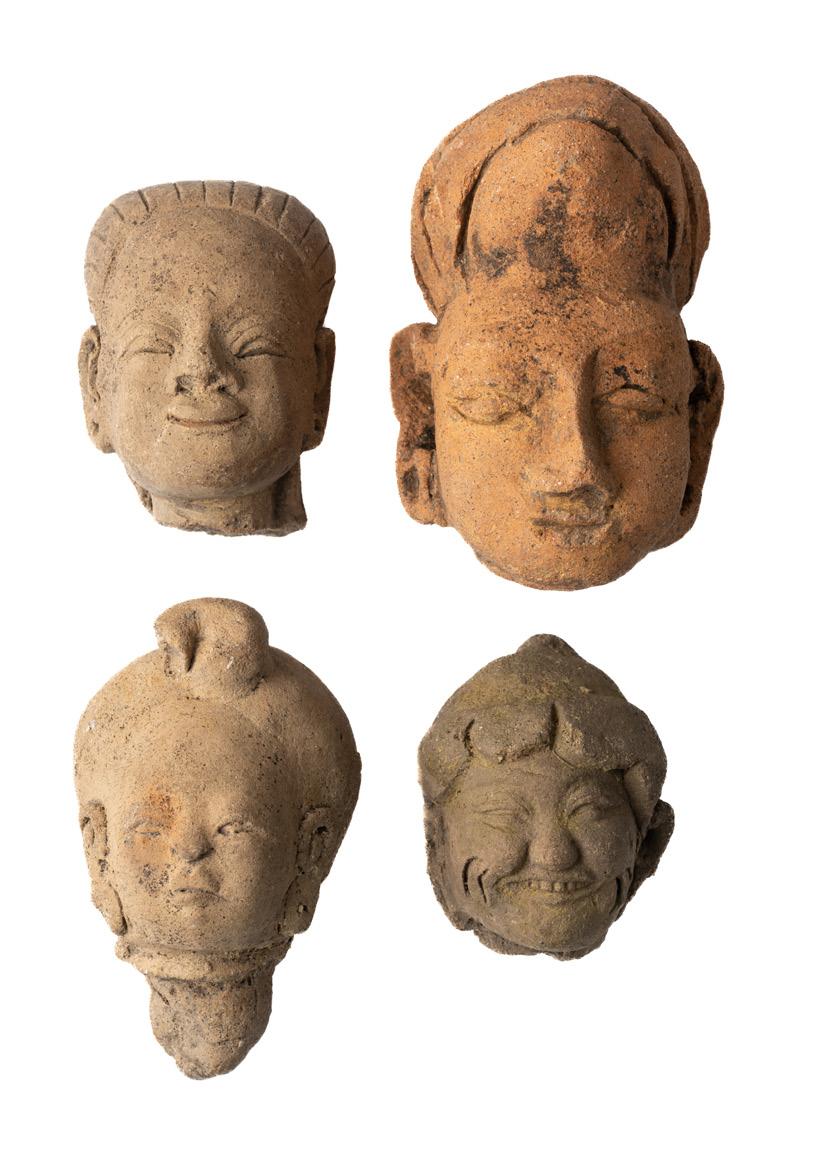
Provenance: Collection of a deceased diplomat, thence by descent.
£120-180
187.
A MAJAPAHIT FRAGMENTARY HEAD OF A MAIDEN, EASTERN JAVA, INDONESIA, CIRCA 15TH CENTURY, terracotta, her ears with large disc earrings and flower ornament above, her incised hair gathered at the back, 16cm high

Provenance: Collection of a deceased diplomat, thence by descent.
For a very closely related terracotta head in the WalterGrounds Collection, see Pal 1987, p.18 and no.13.
£400-600
78
188.
A TERRACOTTA BUDDHIST RELIQUARY, PROBABLY BURMA, 12TH CENTURY OR LATER, with waisted body and conical spire, removable panel in the side, 25cm high

Provenance: Collection of a deceased diplomat, thence by descent £150-250
189.
A PYU FRAGMENTARY FIGURE OF BUDDHA, BURMA (NOW MYANMAR), CIRCA 9TH CENTURY, buff sandstone, with head inclined, mounted, 19.5cm high

Provenance: Collection of a deceased diplomat, thence by descent £250-350
190.
A MAJAPAHIT CARVED STONE FIGURE OF GANESHA, JAVA, INDONESIA, CIRCA 14TH CENTURY, the pot-bellied, four armed elephant headed deity seated crosslegged on a lotus throne, eating sweets with his trunk from a bowl in his left hand, inscription on the reverse, 11cm high £200-300

79
191.
THREE SMALL BRONZE HEADS OF BUDDHA, THAILAND, 15TH-17TH CENTURY, each with pointed usnisa, the two smaller with tightly curled hair, together with a Khmer Bronze Stand and Small Bowl, circa 12th century and a Javanese Bronze Element, possibly a sword locket, 14th/15th century, with a crowned head in relief, 15cm and smaller
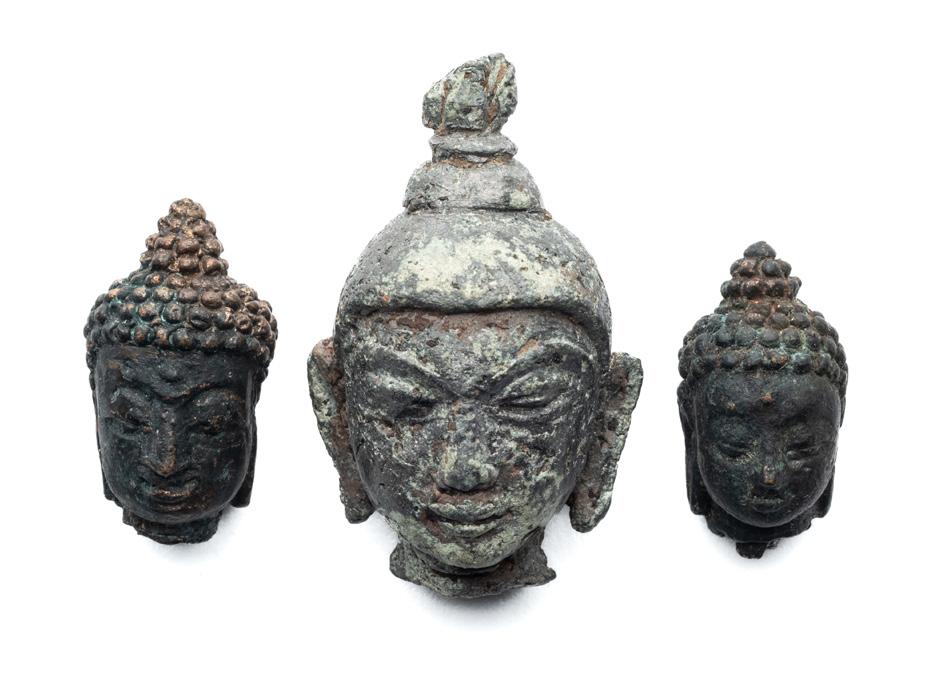
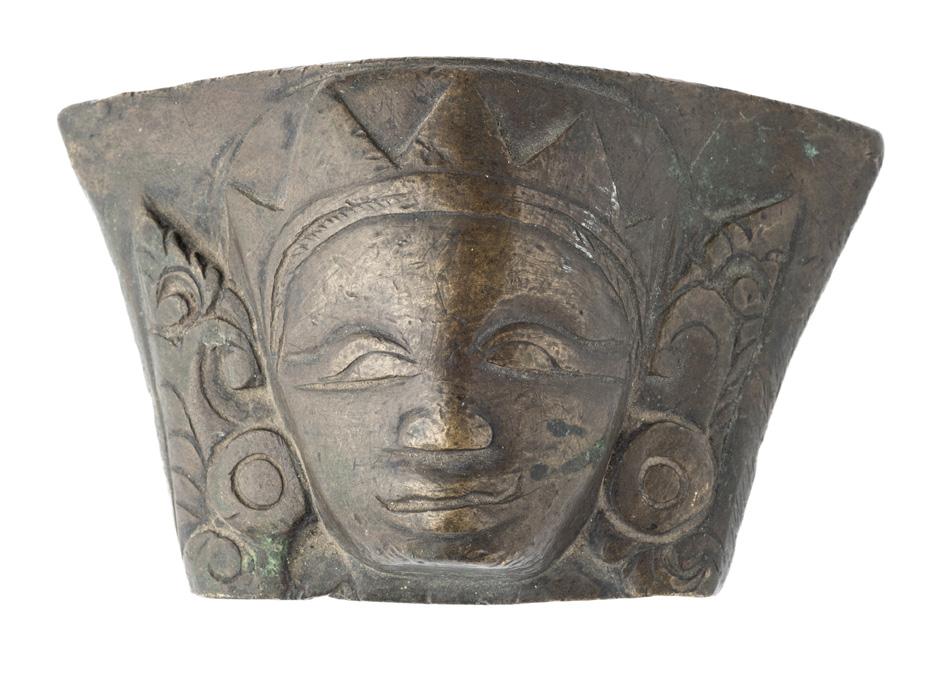
Provenance: Collection of a deceased diplomat, thence by descent. £200-300
192.
A SRIVIJAYA LEAD ALLOY FIGURE OF A BODHISATTVA, SUMATRA, INDONESIA, 7TH / 8TH CENTURY, standing on a raised circular base, his hands in abhaya and varada mudra, the slender figure with his hair gathered in a tall bun 8.5cm high

Provenance: Collection of a deceased diplomat, thence by descent.
For a larger, bronze version of the same subject and period in the Metropolitan Museum of Art, New York, formerly in the Samuel Eilenberg collection, see inv. no. 1987.218.15
£150-200
193.
□ A MISCELLANEOUS GROUP OF SOUTH-EAST ASIAN OBJECTS, MOSTLY 12TH16TH CENTURIES, comprising two Thai bronze limepots, a bronze figure of a horse, a bronze consort from a yab-yum group, a head from a hammer mace, an iron finial, three iron figurines, a small figural relief plaque, a terracotta figure of a deer and a bronze oil lamp, 21.5cm long and smaller, (12)
Provenance: Collection of a deceased diplomat, thence by descent.
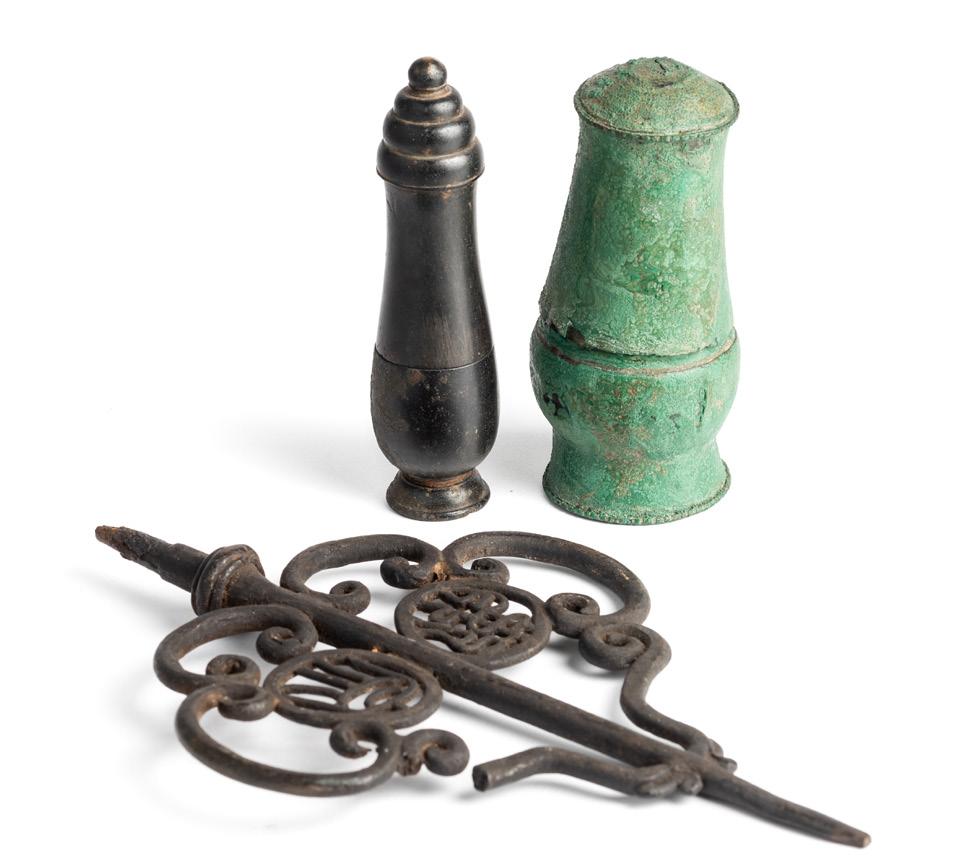
80
£120-150 part part
194.
A PARCEL GILT SHEET SILVER HEAD OF A DEITY, JAVA, CIRCA 18TH CENTURY, wearing elaborate twin-peaked headdress, and tiara and earrings, his face gilded, with moustache and raised eyebrows, 3.5cm high Provenance: Collection of a deceased diplomat, thence by descent.

£80-120
195.
A PYU GILT BRONZE HEAD OF BUDDHA, BURMA (NOW MYANMAR), 8TH / 9TH CENTURY, with elongated earlobes, the tightly curled hair with domed usnisa, mounted 9cm high

Provenance: Collection of a deceased diplomat, thence by descent.
For a more complete, but ungilded, closely related Pyu figure of Buddha in the Metropolitan Museum of Art, New York, see inv. no. 2006.53. The Pyu kingdoms flourished in Northern and Central Burma for about 1000 years until their primary capital, Halin, was sacked by the Chinese in 832.
£600-800
196.
A JAVANESE BRONZE SECTION FROM A HANGING LAMP, INDONESIA, 14TH/15TH CENTURY, in the form of a mythical bird with fish-shaped wings, an openwork globe above containing a pellet bell, suspension loops at top and bottom, 19.5cm high Provenance: Private collection, Western England
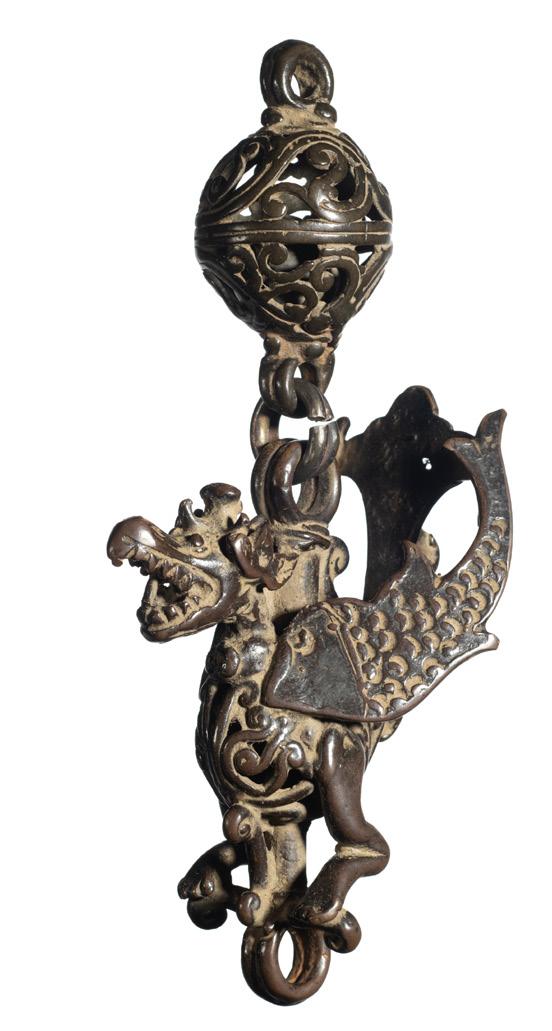
£200-300
197.
A KHMER BRONZE FIGURE OF AVALOKITESVARA, ANGKOR WAT, CAMBODIA, 11TH CENTURY, standing on a circular base, wearing sampot with elaborate clasp, necklace and tall headdress, 14.5cm high

Provenance: Collection of the late Joost Slingerland, Yorkshire, acquired David Baker, London, 25 April 2000. The original receipt is sold with this lot.
£700-900
81
198.
A JAVANESE BRONZE FIGURE OF PADMAPANI, PROBABLY MAJAPAHIT, 14TH CENTURY OR LATER, the slender four armed figure standing on a double lotus base, holding the stem of a padma in his right hands, wearing pendent earrings and tall headdress in the form of a water-pot, 17.8cm high Provenance: Collection of the late Joost Slingerland, Yorkshire.


£300-400
199.
A BRONZE FIGURE OF BUDDHA, CENTRAL JAVA, CIRCA 9TH CENTURY, standing on a double lotus, with body gently flexed, his right hand in varada mudra, his left raised, surrounded by a flaming aureole, 16.5cm
For two closely related bronze Buddha images formerly in the Samuel Eilenberg Collection, see Lerner and Kossak 1991, nos.137 & 139 (now in the Metropolitan Museum of Art, inv. no. 1987.142.19 & 23).
£2000-3000
82
part
200.
A GROUP OF SOUTH-EAST ASIAN METAL AND STONE ITEMS, 4TH CENTURY BC AND LATER, including bracelets and a ewer, two bracelets of carved steatite, 30cm and smaller, (a lot)
Provenance: Collection of a deceased diplomat, thence by descent.
£150-250
201.
EIGHT BRONZE RINGS, JAVA AND CAMBODIA, 9TH12TH CENTURIES, comprising three Khmer earrings, one gilt, another set with rock crystal, and five finger rings, one of spiral form, three with flat engraved bezels and one with a figure of Nandi Bull and a Sivalingam, 4cm diam. and smaller


Provenance: Collection of a deceased diplomat, thence by descent.
£120-180
part
202.
A MISCELLANEOUS COLLECTION OF ANCIENT SOUTHEAST ASIAN BRONZE OBJECTS, 14TH CENTURY AND EARLIER, including three ritual ladles, a weighing balance, an oil lamp, an earring, a buckle, two hairpins and two small vessels, 30cm (length of longest ladle) and smaller, (approximately 24 pieces)
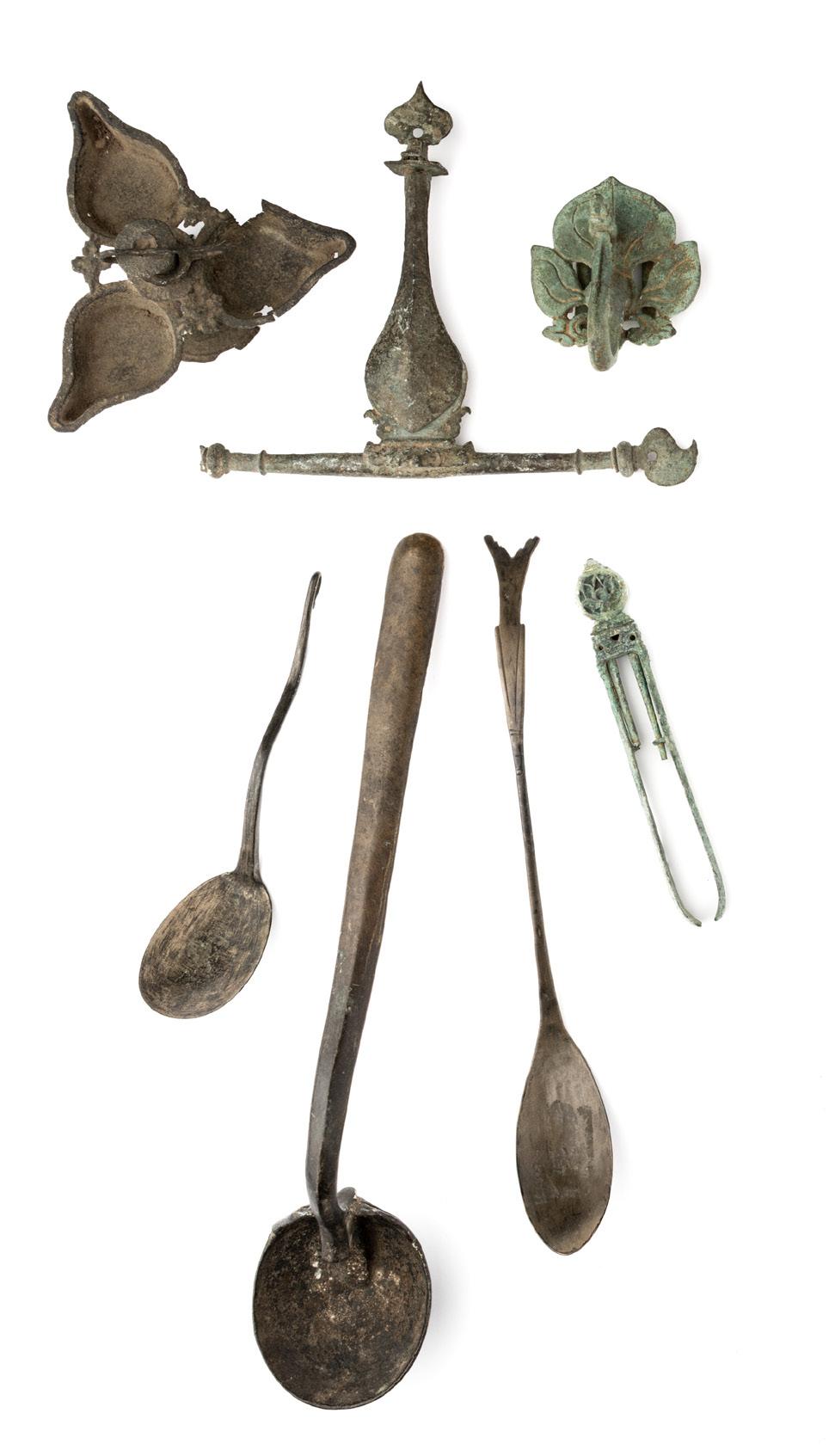
Provenance: Collection of a deceased diplomat, thence by descent.
£100-150
83
203.
A PYU BUDDHIST RELIQUARY CASKET, BURMA (NOW MYANMAR), CIRCA 7TH CENTURY, silver, of cylindrical form, the sides decorated with a series of Buddha images in repousse relief, seated within an arcade of columnar niches, the lid with lotus petal design, 9cm high; 12cm diam.

Provenance: Collection of a deceased diplomat, thence by descent.
For a related silver casket in the National Museum, Yangon (Rangoon) found in the Khin Ba Stupa, Sri Ksetra (Hmawza), see Fraser-Lu and Stadner 2015, no.2, pp.92-93. In the text, the authors mention a cylindrical casket found in the same place which may be closer in form to this object.
£700-900
204 (part)
204.
FIVE SHEET GOLD FRAGMENTARY PLAQUES, THAILAND, 8TH-13TH CENTURIES, repousse relief, comprising one Mon-Dvaravati and two Baphuon depictions of Buddha, and two others, together with an undecorated gold fragment, 9.5cm average size
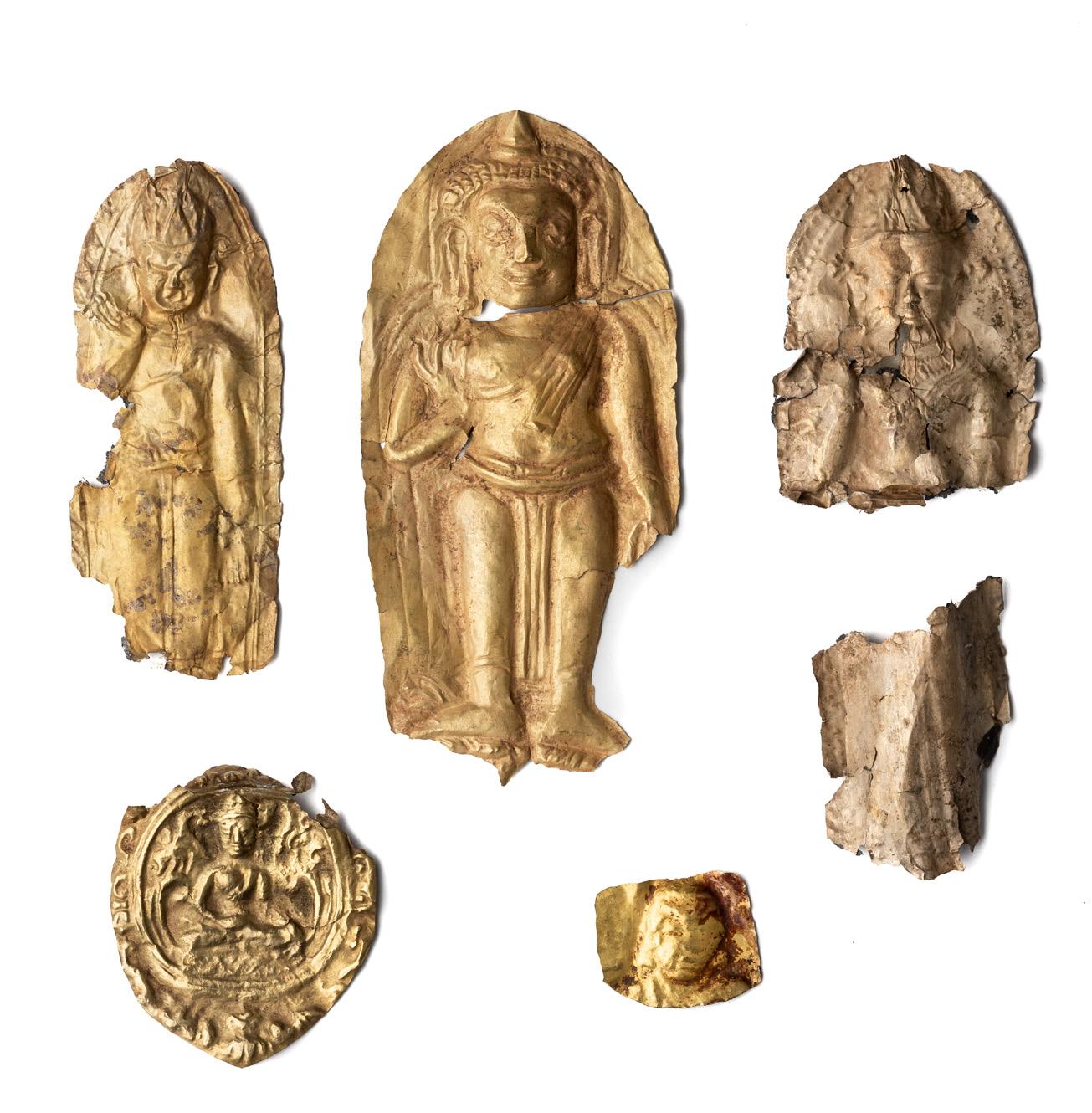
Provenance: Collection of a deceased diplomat, thence by descent.
For related Mon-Dvaravati plaques in the Norton Simon Museum, see Pal 2004, nos.85-87, pp.118-119.
£300-400
203
205. (illustrated online)
A GROUP OF SOUTH-EAST ASIAN OBJECTS, MOSTLY JAVA, CIRCA 14TH CENTURY, comprising two bronze hairpins, three finials, four seals, and a tuff stone tablet, probably a gaming piece, 20 5cm long, and smaller
Provenance: Collection of a deceased diplomat, thence by descent.
£120-150
84
206
206.
A GILT-BRONZE SEAL RING, JAVA, INDONESIA, CIRCA 10TH CENTURY, the engraved oval bezel with staff symbol, 2.5cm diam. approx.

Provenance: Collection of a deceased diplomat, thence by descent.
£100-150
207. (illustrated online)
A JAVANESE BRONZE OFFERING TRAY, INDONESIA, 10TH-14TH CENTURY, with raised sides and overhanging lip, standing on flared rim foot, traces of engraved decoration in the centre, 6.5cm high; 29cm diam.


Provenance: Collection of a deceased diplomat, thence by descent.
£100-150
208.
A GROUP OF SOUTH-EAST ASIAN BRONZE OBJECTS, 10TH-14TH CENTURIES, comprising a reliquary pot, a pierced bowl, a hanging oil lamp, a bell handle, two footscrapers and two finials, 23.5cm and smaller
Provenance: Collection of a deceased diplomat, thence by descent.
£300-400
209.
A BUFF SANDSTONE FRAGMENTARY CORBEL, CENTRAL INDIA, 11TH/12TH CENTURY, in the form of a gana, with bulging eyes and bared teeth, 26 x 24 x 14cm
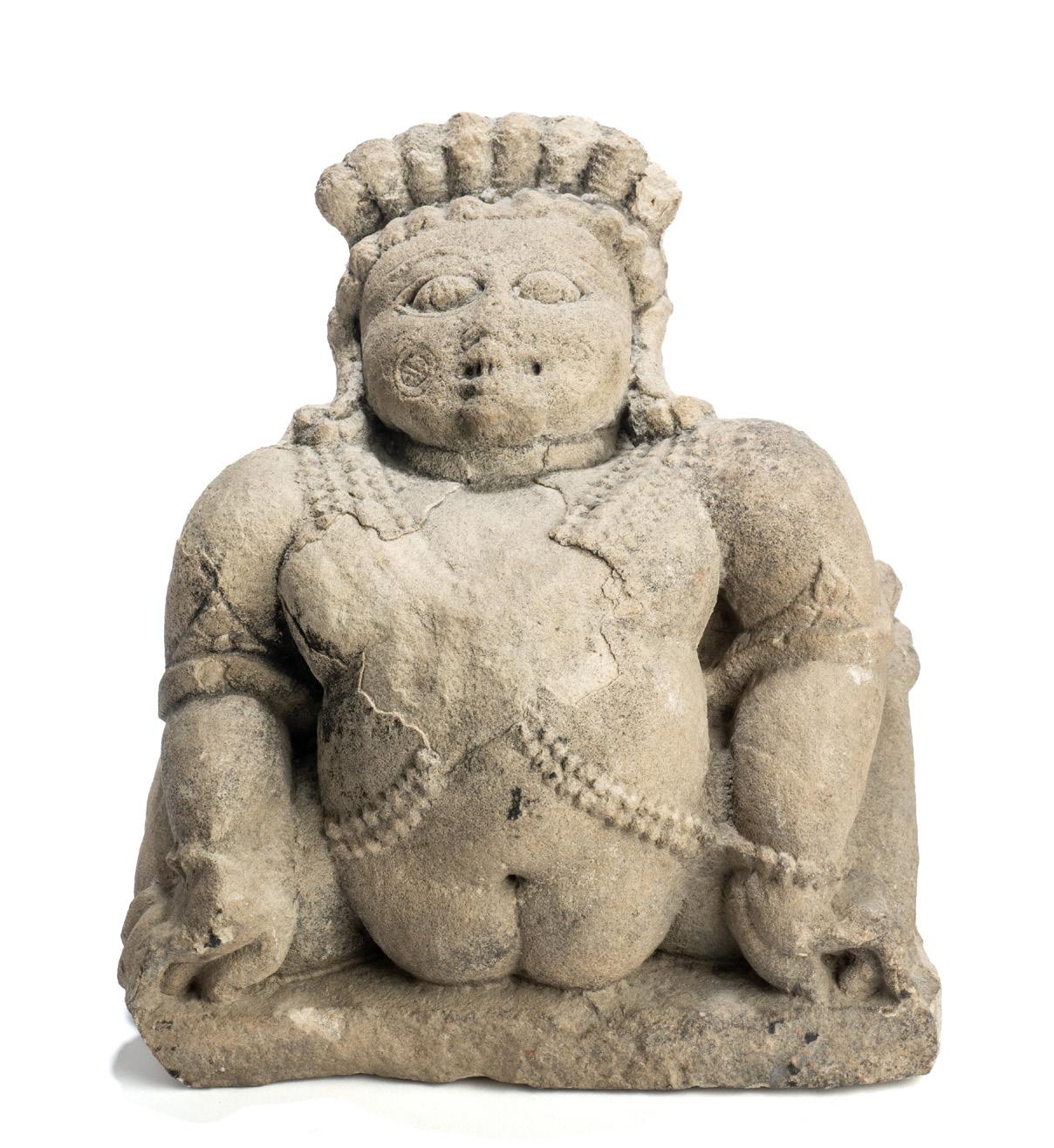
£300-400
208 (part)
85
208 (part) 209
210.
A COLLECTION OF SILVER AND WHITE METAL
JEWELLERY, MOSTLY INDONESIA, 20TH CENTURY AND EARLIER, comprising eight bracelets and a pair of pendants in the form of spiders, 10cm diam. and smaller (10) Provenance: Collection of a deceased diplomat, thence by descent.
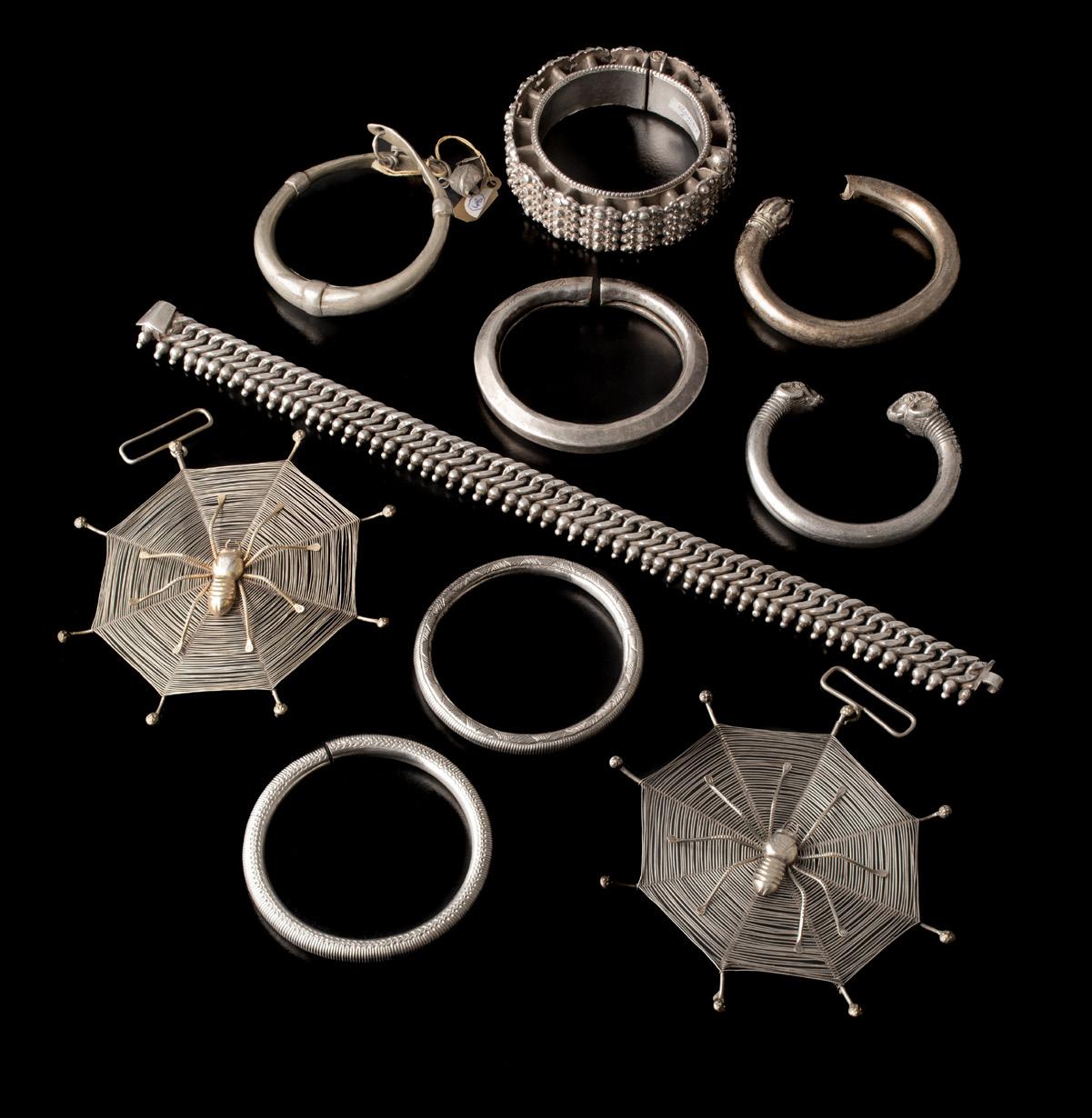
£200-300
211.
FOUR GOLD BRACELETS, JAVA, INDONESIA, CIRCA 14TH CENTURY AND LATER, one composed of a double coil of sheet metal with hinged opening, the second of single coil spiral form with ropework and repousse floral decoration, the third with repousse stippling and the other of wire construction with applique medallions, 6.8cm diam. and smaller, weight: 49g
Provenance: Collection of a deceased diplomat, thence by descent.
£800-1200 212.
SEVEN GOLD RINGS, JAVA, INDONESIA, 14TH-19TH CENTURIES, five with gem-set bezel, including banded agate, garnet, citrine and corundum, 2.9cm max. diam. and smaller, 23g in toto £1500-2000
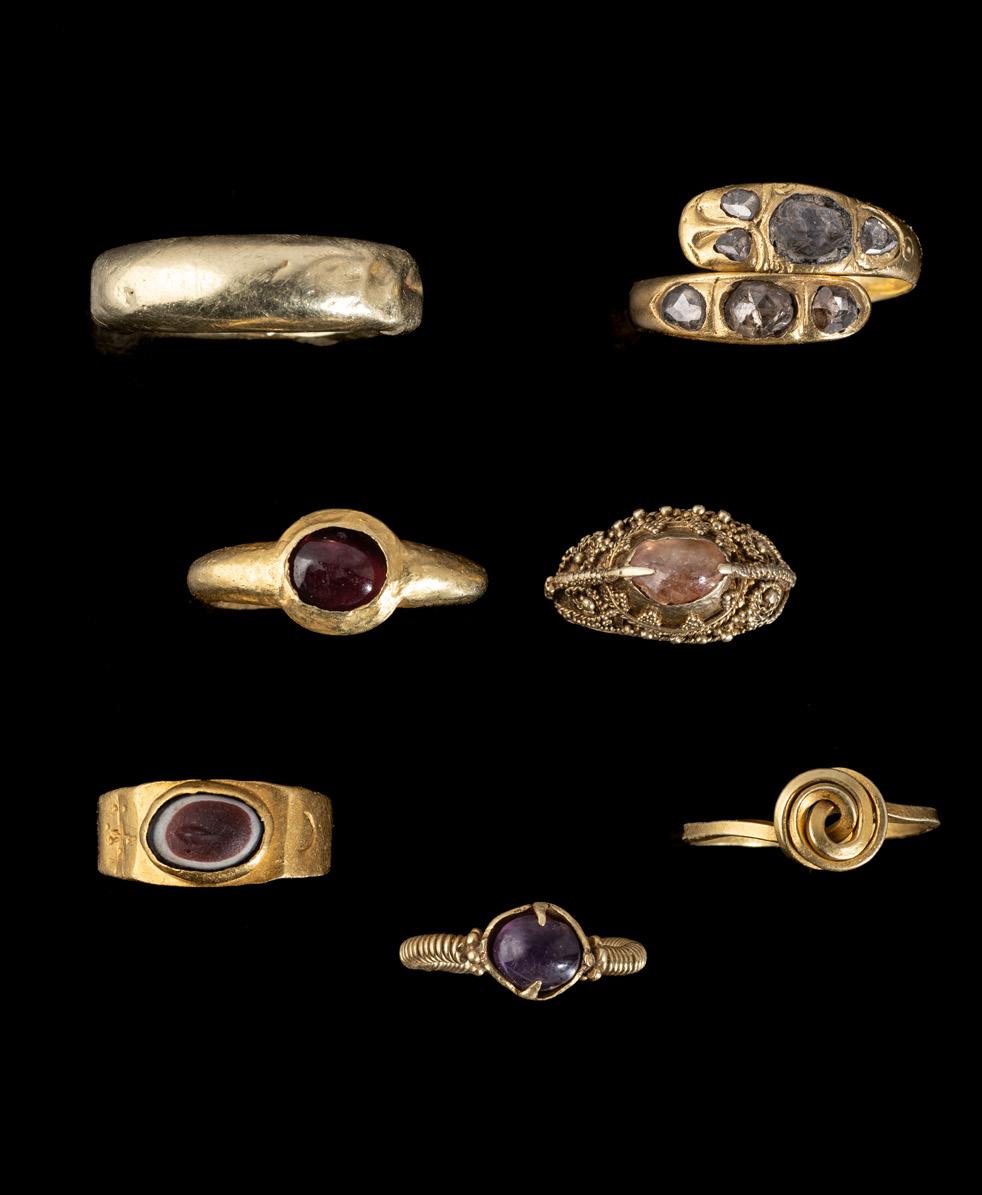

86
213.
A GOLD SEAL RING, JAVA, CIRCA 9TH / 10TH CENTURY, the circular bezel supported by broad shoulders, decorated with fish and lotus motif surrounded by a band of dots, 2.5cm max. diam. 16.8g Provenance: Collection of a deceased diplomat, thence by descent.

For a similar ring from the Eilenberg Collection in the Metropolitan Museum of Art, see inv. no. 1998.544.403 £1500-2000
214.
A GOLD NECKLACE, JAVA, MOSTLY 10TH-12TH CENTURY, re-strung with associated ancient beads of various shapes, including melon, faceted and openwork forms, 39cm long (extended), weight: 52g Provenance: Collection of a deceased diplomat, thence by descent. £1200-1500 215.

A FRAGMENTARY GOLD REPOUSSE 'TIGER CLAW' PENDANT, JAVA, 10TH-12TH CENTURY, the convex body with profuse scrolling decoration, a beaded neck above supporting a tubular suspension loop, 4.5 x 4.2cm, weight 12g Provenance: Collection of a deceased diplomat, thence by descent.
There is a complete 'tiger claw' necklace from the EilenbergRosen collection, now in the Metropolitan Museum of Art New York. Our fragment is closest to the central pendant. See https://www.metmuseum.org/art/collection/ search/49722 £600-800

87
TWELVE GEM-SET GOLD RINGS, JAVA, INDONESIA, 10TH14TH CENTURIES, of various forms, the inlaid bezels including glass, turquoise, ruby, garnet, pink sapphire, citrine and haematite, 3cm max. diam. and smaller, 45.4g in total

Provenance: Collection of a deceased diplomat, thence by descent.
£2500-3500
217.
AN ASSORTED GROUP OF SEVEN GOLD EARRINGS, JAVA, INDONESIA, PROBABLY 10TH-14TH CENTURIES, comprising a pair of crescent shape with hinged opening and gem inlay, a pair of octagonal shape with repousse lotus design and three other single pieces, 3.3cm max diam. and smaller, weight overall: 20g Provenance: Collection of a deceased diplomat, thence by descent.

£800-1200
A MISCELLANEOUS GROUP OF GOLD OBJECTS, JAVA, INDONESIA, MOSTLY CIRCA 14TH CENTIURY, comprising six assorted beads, two repousse buckles, a repousse pendant, two ornaments set with crystal, a finial, a small earring and a flat pendant, 3.8cm long and smaller, 52g in total, (14) Provenance: Collection of a deceased diplomat, thence by descent.
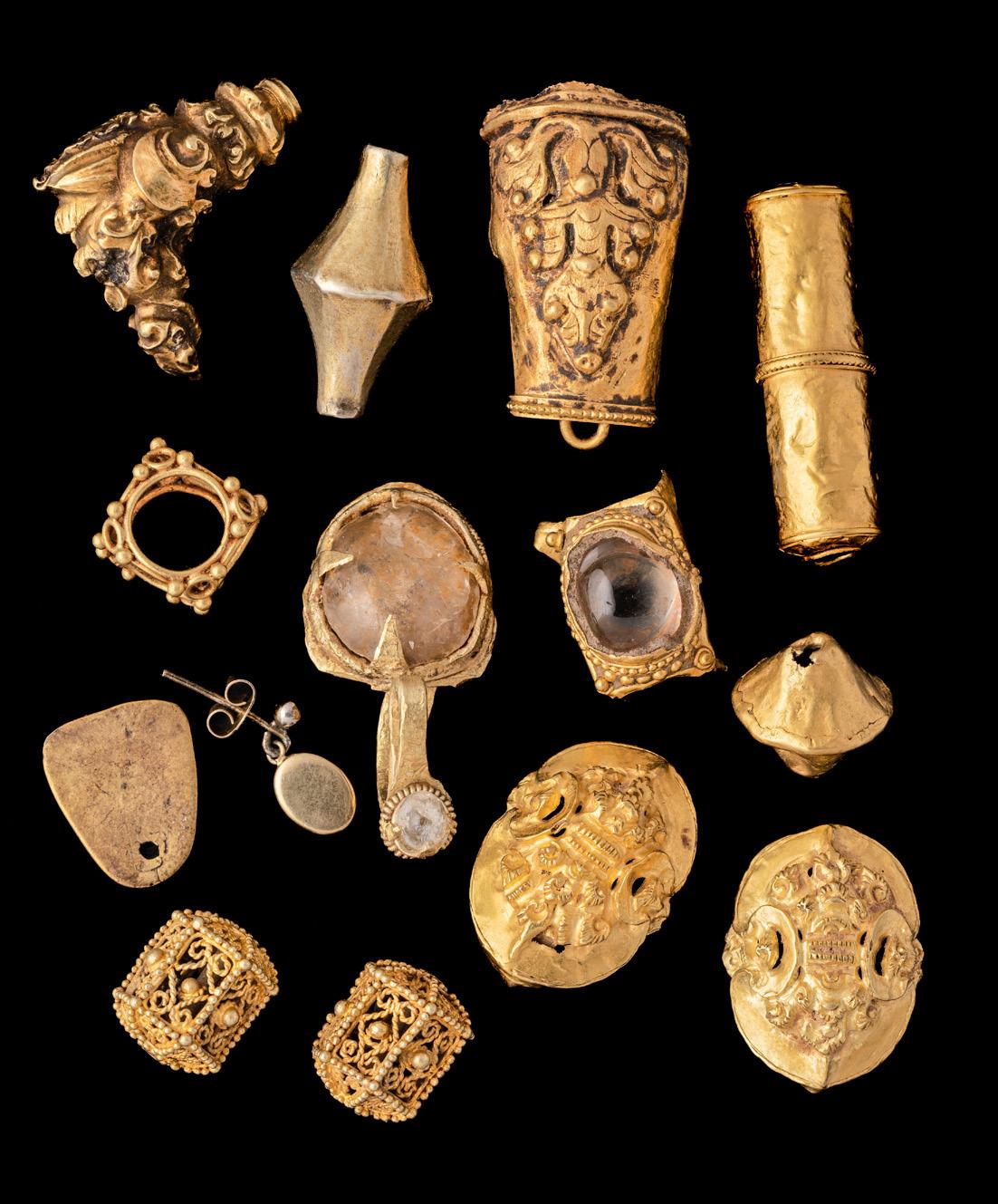
£2000-3000
part
88 216.
218.
219.
A CHAM GOLD NECKLACE, VIETNAM, 12TH/13TH CENTURY OR LATER, in the form of a triple strap of ropework ribbons made of gold wire held with three ring bands, the locking attachment at each end with applique lozenge decoration, 43cm long opened out, weight: 119g

Provenance: Collection of a deceased diplomat, thence by descent.
£2000-3000
220. ~ A GOLD AND CORAL NECKLACE, TIBET, 18TH CENTURY OR EARLIER, with ten spherical hollow gold beads, some with remaining turquoise inlay, engraved with floral and medallion motifs on stipled ground, interspersed with smaller coral beads, further coral beads at each end, 39cm long (extended), weight: 50g including coral Provenance: Collection of a deceased diplomat, thence by descent.

£800-1200
221.
A MAJAPAHIT GOLD PENDANT, JAVA, INDONESIA, 14TH CENTURY, of waisted cylindrical form, the faceted sides with scrolling repousse decoration, later suspension loop and cap, together with a Repousse Openwork Ornament, gold, in the form of a serpent, 5.5cm; 4cm long (2) 14g (together)

Provenance: Collection of a deceased diplomat, thence by descent.
£350-450
89
222.
A BRONZE JAR, SOUTH-EAST ASIA, PROBABLY
THAILAND, 16TH CENTURY, on flared ring foot, the sides with reticulated scale design, 18.5cm high; 22.5cm diam.
Provenance: Collection of a deceased diplomat, thence by descent.
£200-300
223.
A BRONZE CATTLE BELL, EASTERN JAVA, 10TH/11TH CENTURY, of domed form, the double lotus shoulder supporting a ridged suspension loop, 10.5cm
Provenance: Collection of a deceased diplomat, thence by descent.
For three similar bells in the Linden Museum, Stuttgart, see Lohuizen-De Leeuw 1984, pp.206-7

£100-150
224.
THREE JAVANESE METAL VESSELS, INDONESIA, 12TH-14TH CENTURY, comprising a silver bowl, a copper round box with flower motif on the lid and a small bowl, 5cm high; 17cm diam. (silver bowl), 10.5cm high; 22cm diam. (box), 7.5cm high; 10cm diam. (small bowl)


Provenance: Collection of a deceased diplomat, thence by descent.
For a closely related bronze box formerly in the Samuel Eilenberg Collection, see Guy 1989, pl.26, p.31
£200-300
225.
A BRONZE HANGING LAMP, JAVA, INDONESIA, 14TH / 15TH CENTURY, in the form of an elephant standing on a plinth surrounded by four oil reservoirs, each with twin wick spouts, two further reservoirs above, held by human figures, a floral parasol at the top with elaborate suspension loop, 36cm high (including remaining chain)

Provenance: Collection of a deceased diplomat, thence by descent.
For a similar lamp with a figure of Garuda in the Museum of Asiatic Art (now part of Rijksmuseum), Amsterdam, see Bernet Kempers 1959, pl.307. See also Lohuizen-De Leeuw 1984, pp.170-175, for examples in the Linden Museum, Stuttgart.
£250-350
90
224
226.
TWO BRONZE HOLY WATER (AMRTA) EWERS, EASTERN JAVA, POSSIBLY KEDIRI, 11TH/12TH CENTURY, the bulbous body on splayed foot and surmounted by segmented neck, supported by a lotus band, each with snake headed spout, 33.5cm, 27cm high
Provenance: Collection of a deceased diplomat, thence by descent. As Bernet-Kempers and Lohuizen-De Leeuw note, the snake head spout, although of iconographic importance, plays a secondary role in the function of this vessel. It acts as an air hole to allow the water to empty smoothly from the top of the neck. For very similar examples, see Bernet-Kempers 1959, pl.220 & Lohuizen-De Leeuw 1984, p.119. £600-900
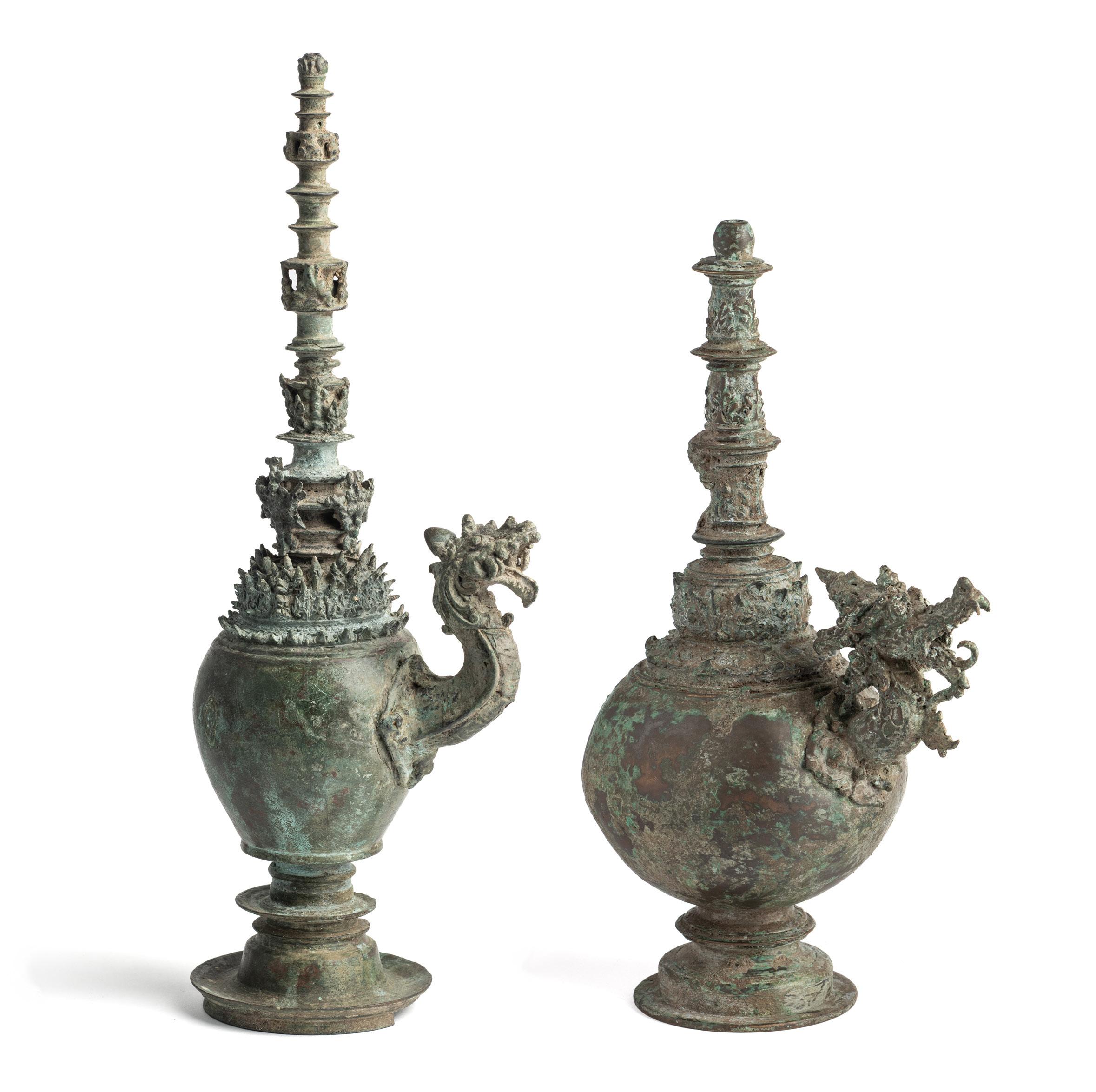
91
227.
A JAVANESE BRONZE HOLY WATER LADLE, INDONESIA, CIRCA 11TH CENTURY, the shallow concave bowl engraved with a floral medallion, the handle in the form of a leafy stem, 23cm long Provenance: Collection of a deceased diplomat, thence by descent.

For a near-identical example in the Linden Museum, Stuttgart, see Lohuizen-De Leeuw 1984, p.127.
£150-250
228.
A BUDDHIST BRONZE RITUAL BELL, JAVA, INDONESIA, CIRCA 10TH CENTURY, of domed form, the segmented shaft with vajra finial, 15.5cm high


Provenance: Collection of a deceased diplomat, thence by descent.
For a group of closely related bells in the Linden Museum, Stuttgart, see Lohuizen-De Leeuw 1984, pp.101-105
£200-300
229.
A BRONZE SLIT BELL, JAVA, INDONESIA, CIRCA 13TH CENTURY, of faceted, slightly bulbous cylindrical form, a long rectangular opening on one side, makara finial at the top with suspension loop, 20.5cm high
Provenance: Collection of a deceased diplomat, thence by descent
As Jan Fontein indicates, this type of bronze bell or drum was based on original much larger wooden versions widely used in the region (for an example from New Guinea, see lot 267 in this sale). There are two similar, but larger bronze examples in museums in Amsterdam and Jakarta, see Fontein 1990, nos.100 & 101.
£250-350
92
230.
A BRONZE BOWL, SUMATRA, INDONESIA, 18TH

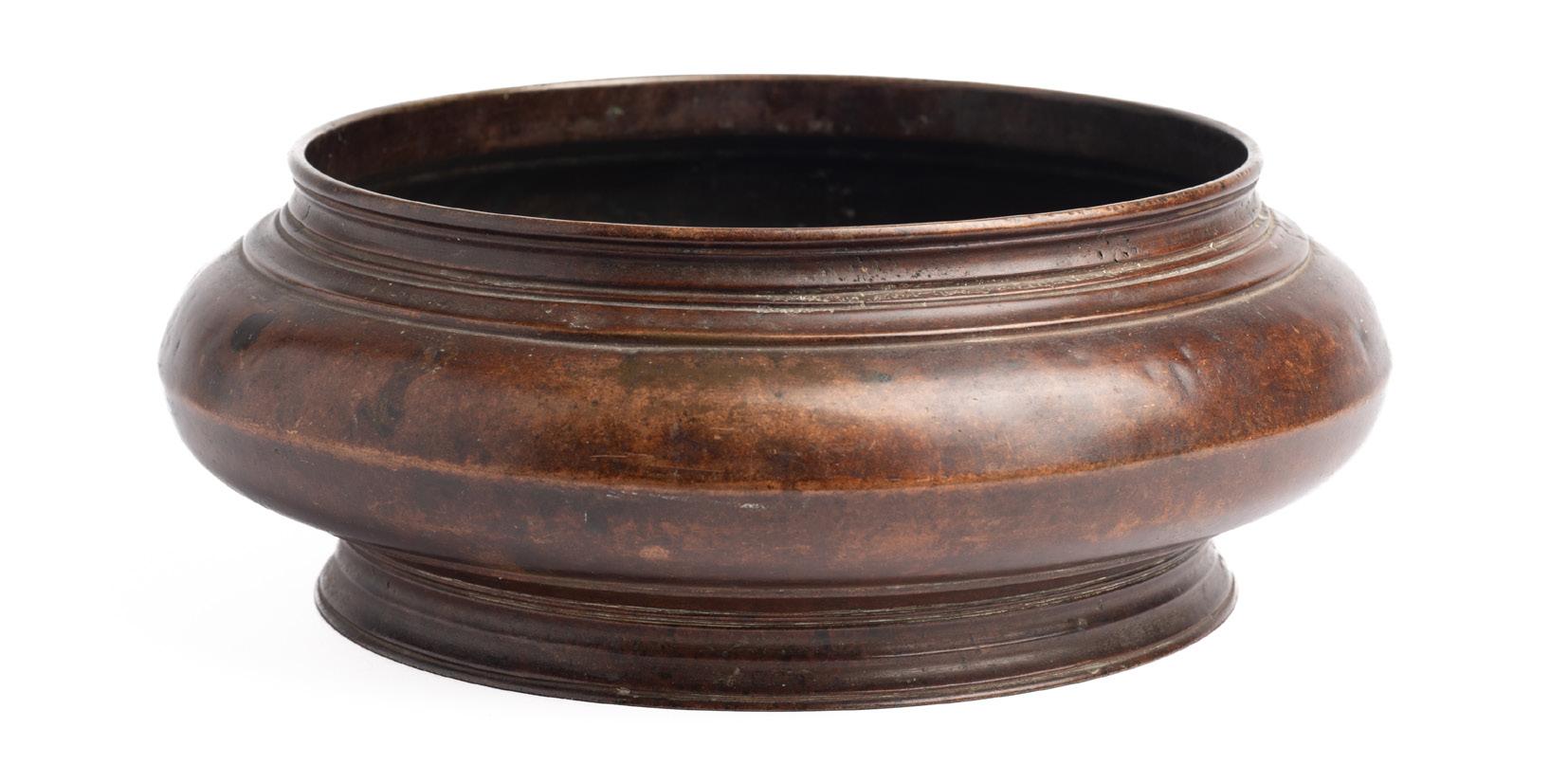
/ 19TH CENTURY, of shallow circular form with convex sides, standing on ring foot, a small circular medallion in the centre of the well, 9.5cm high; 26cm diam.
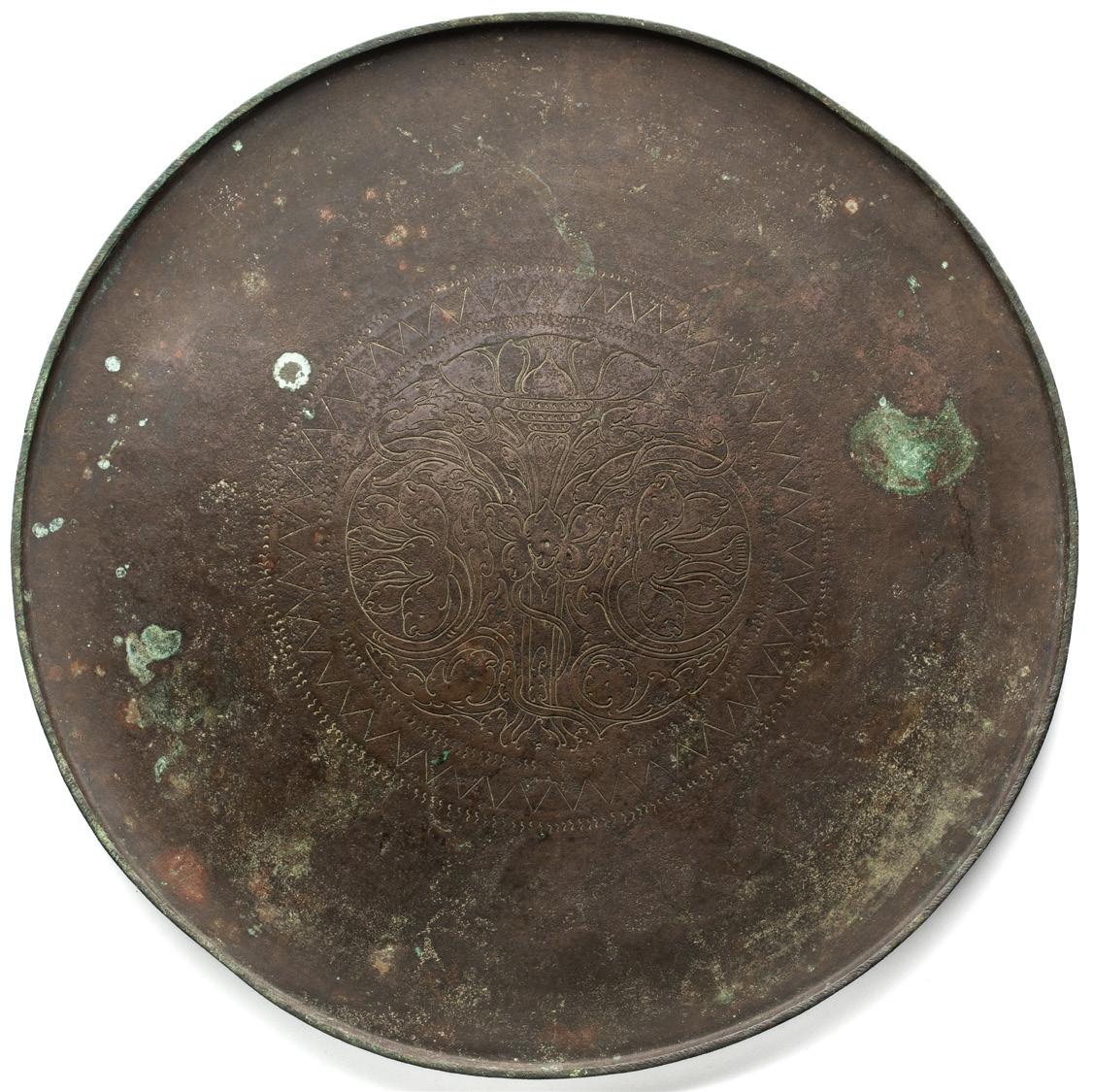
Provenance: Collection of a deceased diplomat, thence by descent
£80-120
231.
A PRIEST'S OFFERING TRAY (TALAM), CENTRAL
JAVA, CIRCA CIRCA 10TH CENTURY, of circular form, with raised turned-in rim, engraved with central foliate roundel within a border of scrolling floral forms, 41.5cm diam; 1cm high
Provenance: Collection of a deceased diplomat, thence by descent
For a similar talam in the Metropolitan Museum of Art, New York, see inv. no. 2017.61.2. See also Lohuizen-De Leeuw 1984, pp.129-134 £200-300
232.
A PRIEST'S OFFERING TRAY (TALAM), CENTRAL
JAVA, CIRCA CIRCA 10TH CENTURY, of circular form, with raised, slightly turned-in rim, engraved with central lotus medallion surrounded by a serrated border, 42cm diam; 2cm high
Provenance: Collection of a deceased diplomat, thence by descent
£250-350
93
233.
TWO SAWANKHALOK CELADON VESSELS, THAILAND, 14TH/15TH CENTURY, comprising a kendi and a bowl with underglaze carved leaf decoration, together with Two Moulded Small Dishes, probably Vietnam, 15th century, with lotus designs in relief 16.5cm. (height of kendi) 17cm (diam. of bowl)

Provenance: Collection of a deceased diplomat, thence by descent.
£120-180
234.
A KHMER BROWN GLAZED FIGURE OF A PIG, CAMBODIA, 12TH/13TH CENTURY, pinkish earthenware with incised details, 10cm high; 12.5cm long Provenance: Collection of a deceased diplomat, thence by descent.

£200-300
235.
THREE KHMER BROWN GLAZED RITUAL POTS, ANGKOR PERIOD, EARLY 12TH CENTURY, pinkish buff terracotta, one modelled as a grotesque figure drinking from a large jar, the other two in the form of a mouse and a rabbit, 11cm, 10cm, 7cm Provenance: Collection of a deceased diplomat, thence by descent.

A number of glazed pots with human and animal features have survived from Angkor. Dawn Rooney suggests that the rarer examples with human features have a ritual function. See Rooney 2010, p.64ff.
£300-500
94
236.
A GROUP OF FOURTEEN SOUTH-EAST ASIAN POTTERY LIDS, MOSTLY KHMER, CIRCA 12TH CENTURY, each with bud-shaped handle, 8.7cm and smaller

Provenance: Collection of a deceased diplomat, thence by descent. £40-60
237.
THREE KHMER BROWN GLAZED STONEWARE POTS, CAMBODIA, CIRCA 12TH CENTURY, each wheel thrown with incised decoration, the lids with bud-shaped handles, the smallest of the three in the form of a stylised owl, 13.5cm high and smaller

Provenance: Collection of a deceased diplomat, thence by descent £200-300
238.
A LARGE STORAGE JAR, THANH-HOA PROVINCE, VIETNAM, 12TH / 13TH CENTURY, glazed stoneware, decorated with incised brown glazed tendrils on celadon ground, the collar with raised lotus border and four small suspension loops below (one now missing), 32cm high

Provenance: Collection of a deceased diplomat, thence by descent
For a discussion of this type of incised ware produced under the Ly dynasty and an illustration of a near identical jar or urn in the British Museum, see Guy 1989, pp.44-46. £600-800
95
239.
A MONOCHROME GLAZED JAR AND COVER, VIETNAM, CIRCA 11TH CENTURY, stoneware with straw coloured glaze, the shoulder and lid with raised lotus petal decoration, six suspension loops around the shoulder, 22cm high
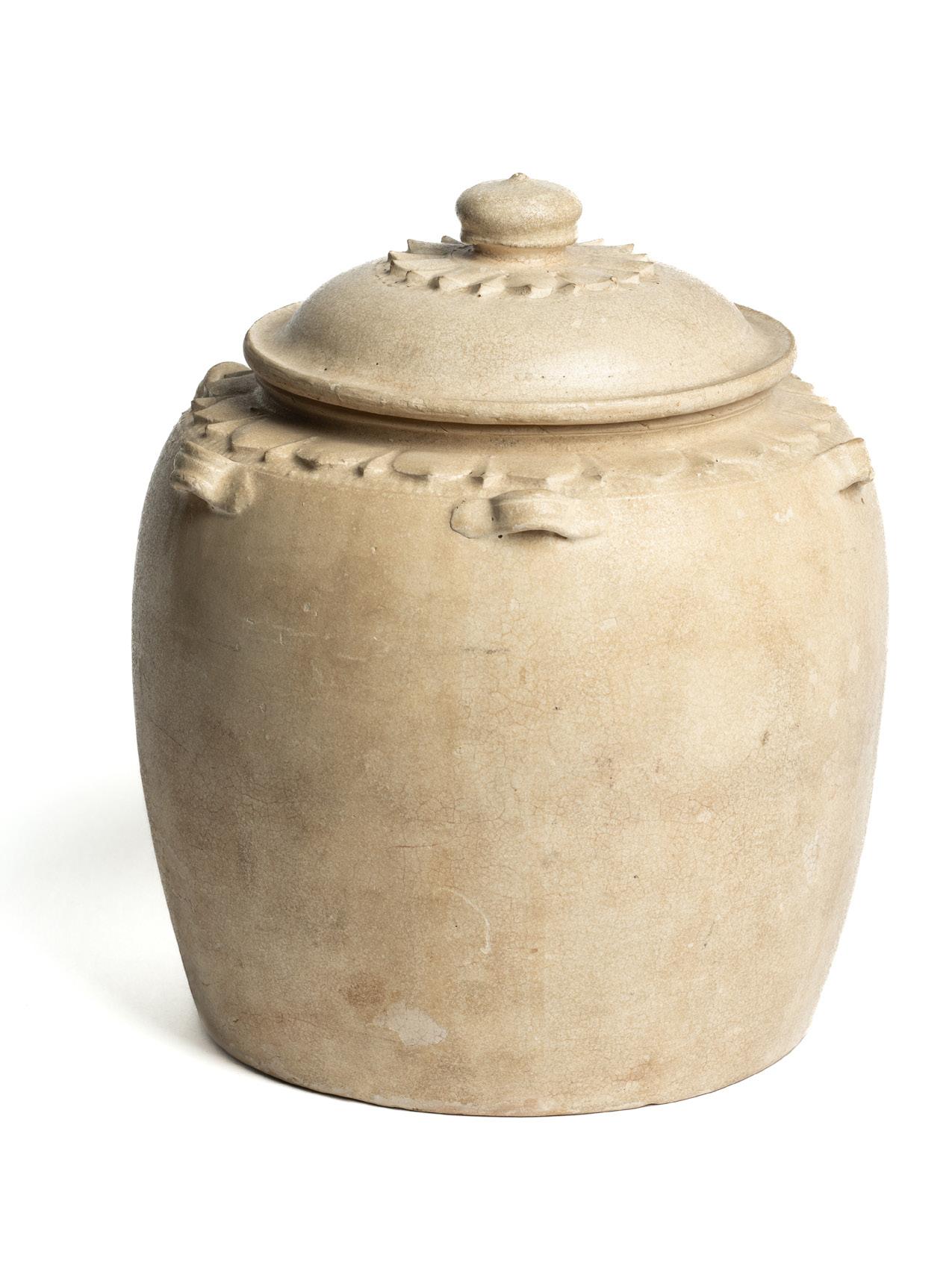
Provenance: Collection of a deceased diplomat, thence by descent
For a near identical vessel in the British Museum, see inv. no.2003,1014.1 (https:// www.britishmuseum.org/collection/ object/A_2003-1014-1)
£500-700
240.
FOUR SMALL SOUTH-EAST ASIAN STONEWARE VESSELS, 11TH / 12TH CENTURY, comprising a Vietnamese ewer with raised lotus petal collar, and three Khmer pots, the larger brown glazed with incised linear decoration, the two smaller with lids, 8cm high; 14cm diam.and smaller Provenance: Collection of a deceased diplomat, thence by descent
£250-350

96
241.
FOUR SMALL BLUE AND WHITE VESSELS, VIETNAM, 15TH / 16TH CENTURY, stoneware, comprising three small jars, with faceted, lobed and round sides respectively and a small box with bird design on the lid, 7cm high and smaller, together with a Small Ming Blue and White Porcelain Cup, 3.7cm high

Provenance: Collection of a deceased diplomat, thence by descent
£250-350
242. EIGHT MONOCHROME GLAZED BOWLS, VIETNAM AND CHINA, MOSTLY CIRCA 12TH CENTURY, four porcelain and the other four of stoneware, 18.5cm diam. and smaller

Provenance: Collection of a deceased diplomat, thence by descent
£250-350
243.
FOUR STONEWARE LIMEPOTS, VIETNAM, 14TH / 15TH CENTURY, each with snake-like assymetrical handle and circular opening on the shoulder, three with green splashed decoration around the handle and brown painted ring above the foot, 11cm high and smaller

Provenance: Collection of a deceased diplomat, thence by descent
For a closely related example in the British Museum, see inv. no. 1928,1116.1 (https://www. britishmuseum.org/collection/ object/A_1928-1116-1)
£200-300
97
244.
FOUR CELADON GLAZED DISHES, PROBABLY VIETNAM, 14TH / 15TH CENTURY, each with carved underglaze stylised leaf decoration, 27.5cm approx. each

Provenance: Collection of a deceased diplomat, thence by descent
£300-400
245.
THREE SOUTH-EAST ASIAN STONEWARE POTS, comprising a Khmer brown glazed jar, 12th century, with associated lid, a Thai engraved brown and pale blue glazed bowl, circa 15th century, with associated lid, and a small Vietnamese blue and white container with relief decorated lid, 15.5cm high and smaller

Provenance: Collection of a deceased diplomat, thence by descent
£200-300
246.
A KHMER POTTERY EWER, BURIRAM PROVINCE, THAILAND, CIRCA 12TH CENTURY, olive glaze, of melon shaped form, with twin scrolling handles and small spout, later added Kashmir silver mounts, 30cm high

Provenance: Collection of a deceased diplomat, thence by descent.
£300-400
98
247.
REVERSE GLASS PAINTINGS, JAVA, INDONESIA, EARLY 20TH CENTURY, each depicting an official riding a horse in a procession, framed,
each
Collection of a deceased diplomat, thence by descent.
248.
TWO REVERSE GLASS PAINTINGS, JAVA, INDONESIA, EARLY 20TH CENTURY, one depicting a ruler and his wife, the other a mosque, framed, 37.5 x 29.5; 31.5 x 36cm


Provenance: Collection of a deceased diplomat, thence by descent.
£180-220
99
TWO
29.5 x 37cm
Provenance:
£150-250
249.
A MISCELLANEOUS GROUP OF SOUTH-EAST ASIAN JEWELLERY, MOSTLY 19TH-20TH CENTURY, comprising ten amber and one gold bead drops, the former with gold mounts, two intaglio seal rings, a nephrite frog pendant, an amber necklace with gold mounts, two large gilt pendant earrings, a single gold earring and another element each set with a spinel and five other gold elements, 36.5cm (necklace extended straight), 3cm average height (bead), (24)

Provenance: Collection of a deceased diplomat, thence by descent.
£500-800
250. (illustrated online)
FOUR SILVER ITEMS, INDIA AND SOUTH-EAST ASIA, 20TH CENTURY
comprising a belt with openwork floral links and convex buckle engraved with lion design, a bracelet composed of interlaced wire element with chain and drops below, a silvergilt bracelet, and a ropework silver chain, 86.5cm long (belt) and smaller; weight of bracelet: 27g
Provenance: Collection of a deceased diplomat, thence by descent.
£120-180
251. No Lot 252.
A JAVANESE MEDICINE CHEST, INDONESIA, 19TH CENTURY, wood, lacquered and painted, with gilt details, standing on Chinese style bracket feet, the corners with faux bamboo columns, the front with three drawers, each with zinc lined compartments, faced with an intricate design of Chinese scrolling foliage and dragons, the sides and skirt similarly decorated, 36.5 x 54 x 30cm
Provenance: Collection of a deceased diplomat, thence by descent.
For an illustration of another chest with similar Chinese influence, see Moss 2007, p.67

£500-800
259
100
253.
TWO BURMESE LACQUERED BOXES, EARLY 20TH CENTURY, each of rectangular form, one of wood with orange stylised sgraffito decoration, the other of black lacquered woven bamboo (pachok), 12 x 35.5 x 22cm; 16.5 x 33 x 21cm

Provenance: Collection of a deceased diplomat, thence by descent.
For a similar pachok, see Fraser-Lu 1985, fig.81, p.81
£120-180
254.
A JAVANESE SHADOW PUPPET, INDONESIA, CIRCA 1900, painted, cut and pierced vellum, with horn handle, depicting a deity with black face and elaborate polychrome and gold adornments, embossed inscription in Javanese along lower edge, 84 x 40cm approx.

Provenance: Collection of a deceased diplomat, thence by descent.
£200-300
255.
A CARVED WOOD BETEL CONTAINER, JAVA, INDONESIA, 18TH/19TH CENTURY, the rectangular tray with compartments, standing on splayed foot, the sides profusely carved with floral and animal designs, 20 x 31 x 18cm

Provenance: Collection of a deceased diplomat, thence by descent.
£200-300
101
256.
A TORAJA WOOD RICE SCOOP, SULAWESI, INDONESIAN ARCHIPELAGO, 19TH / 20TH CENTURY, of concave crescentic form, the finial in the form of a stylised ox-head, 18cm long Provenance: Collection of a deceased diplomat, thence by descent

The finials of Torajan rice scoops come in a variety of forms, most commonly fish tails. For a typical example in the British Museum, thought to have been made in the mid-20th century, see inv. no. As1974,24.8 £80-120
257.
part
FOUR SOUTH-EAST ASIA CONTAINERS, JAVA AND BURMA, 20TH CENTURY, comprising a basket for a fighting cock, a large waisted basket, a lacquered cane box and a bamboo and hide box, 54cm high and smaller Provenance: Collection of a deceased diplomat, thence by descent £120-180

258.
A MISCELLANEOUS GROUP OF RED LACQUER OBJECTS, BURMA (NOW MYANMAR), 20TH CENTURY, comprising two betel boxes, one with associated lid, the other missing its lid, two ladles, five small woven cane bowls, two small 'hsunok' (ritual food containers) with lid and inner tray, a fluted bowl on four claw feet, three other bowls, 15cm (larger hsunok); 38cm (longest ladle), (13 items approx.)
Provenance: Collection of a deceased diplomat, thence by descent £200-300
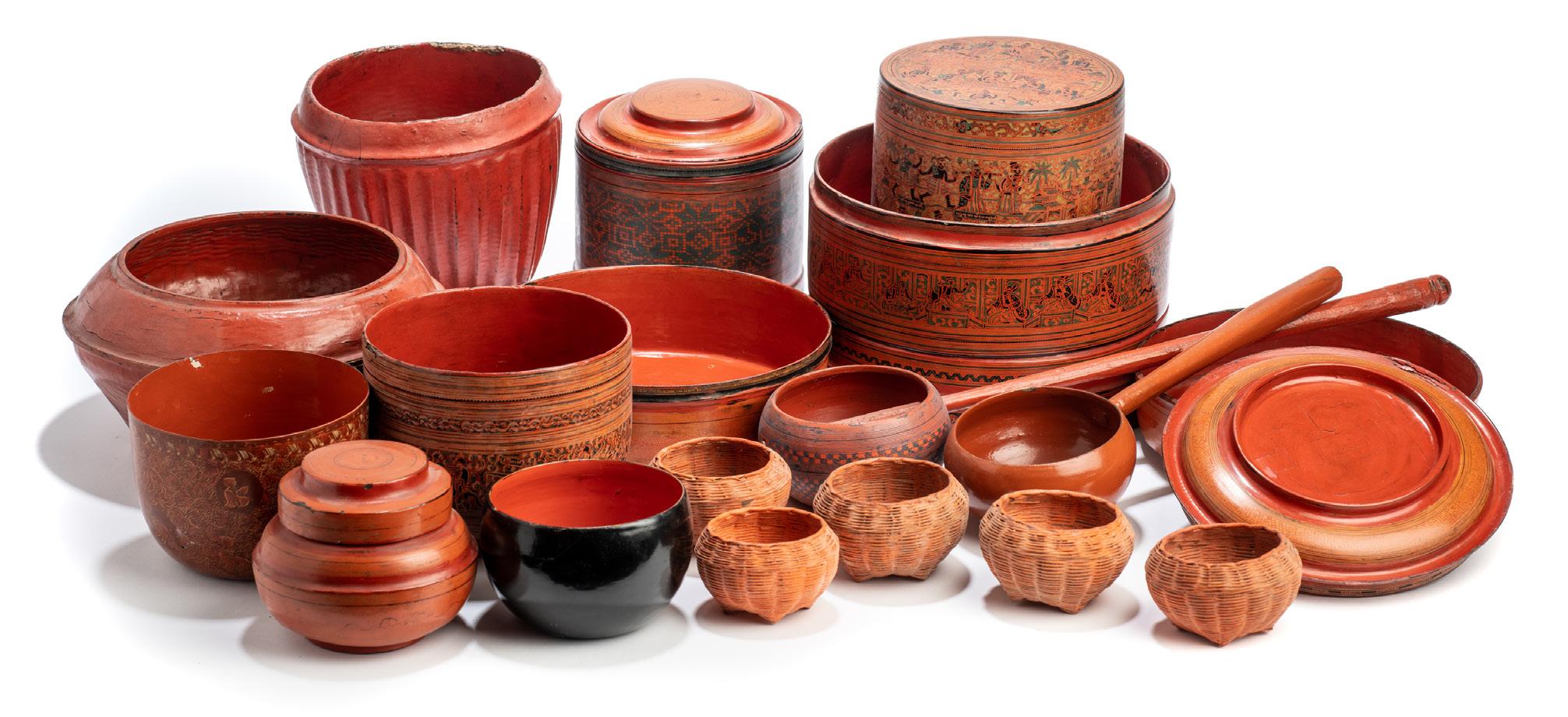
102
259.
A DUTCH COLONIAL EBONISED GLAZED CABINET (LEMARI), JAVA, 18TH / 19TH CENTURY, on cabriole legs, the lower case with large drawer below and fall-front opening above with smaller drawers, the glazed upper case surmounted by openwork parapet with central crest and rosebud finials, with gold and red painted details, 164cm high
Provenance: Collection of a deceased diplomat, thence by descent. £2500-3500
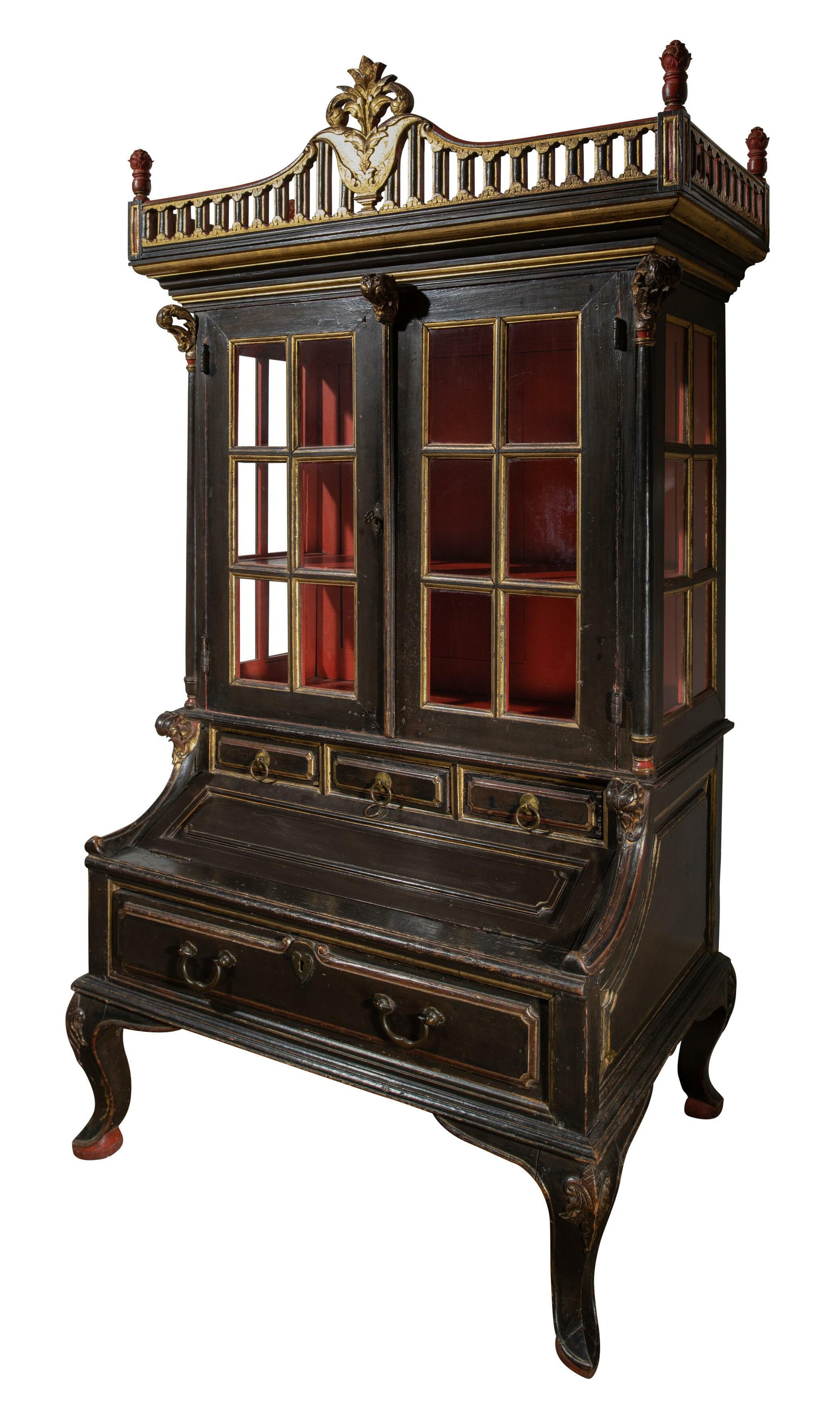
103
260.
A MONUMENTAL LACQUER TRAY, BURMA, 20TH CENTURY, orange lacquered cane, of circular form, with raised vertical edge, 96cm diam.
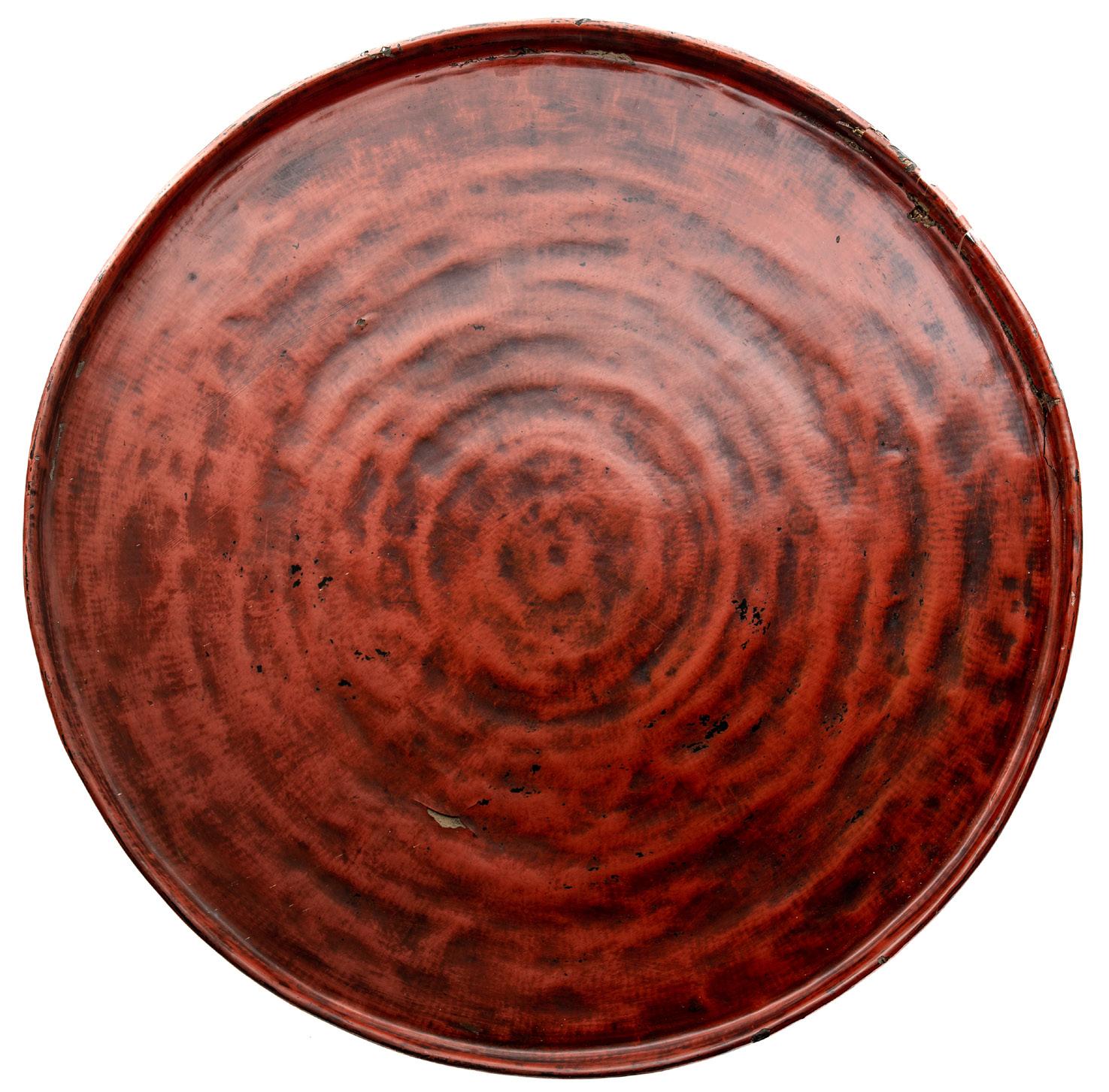

Provenance: Collection of a deceased diplomat, thence by descent.
£200-300
261.
A PAINTED AND CARVED WOOD ARCHITECTURAL ELEMENT, JAVA, INDONESIA, 18TH/19TH CENTURY, painted in blue, brown and red, with touches of gold, comprising a base with abundant lotus decoration in relief and slender faceted column section, 147cm high
Provenance: Collection of a late diplomat, thence by descent
£100-150
104
262.
TWO SILVER ROWING TROPHIES, BURMA (NOW MYANMAR), CIRCA 1930, each of 'thabeik' form, with chased and repousse boating scenes amidst dense scrolling foliage, the larger with inscription on upper rim reading R.B.C. Burma Bowl 1933 Inter-Port Fours, and Combes Company Ltd., Rangoon underneath, 13, 9.5cm diam. 148g; 89g Provenance: Private collection, Western England £120-180

263.
TWO SCENES IN A PALACE, BURMA (NOW MYANMAR), LATE 19TH / EARLY 20TH CENTURY, gouache on paper, each depicting groups of men and women engaged in various games and other activities, framed, 40.5 x 30.5cm each (paintings) £250-350
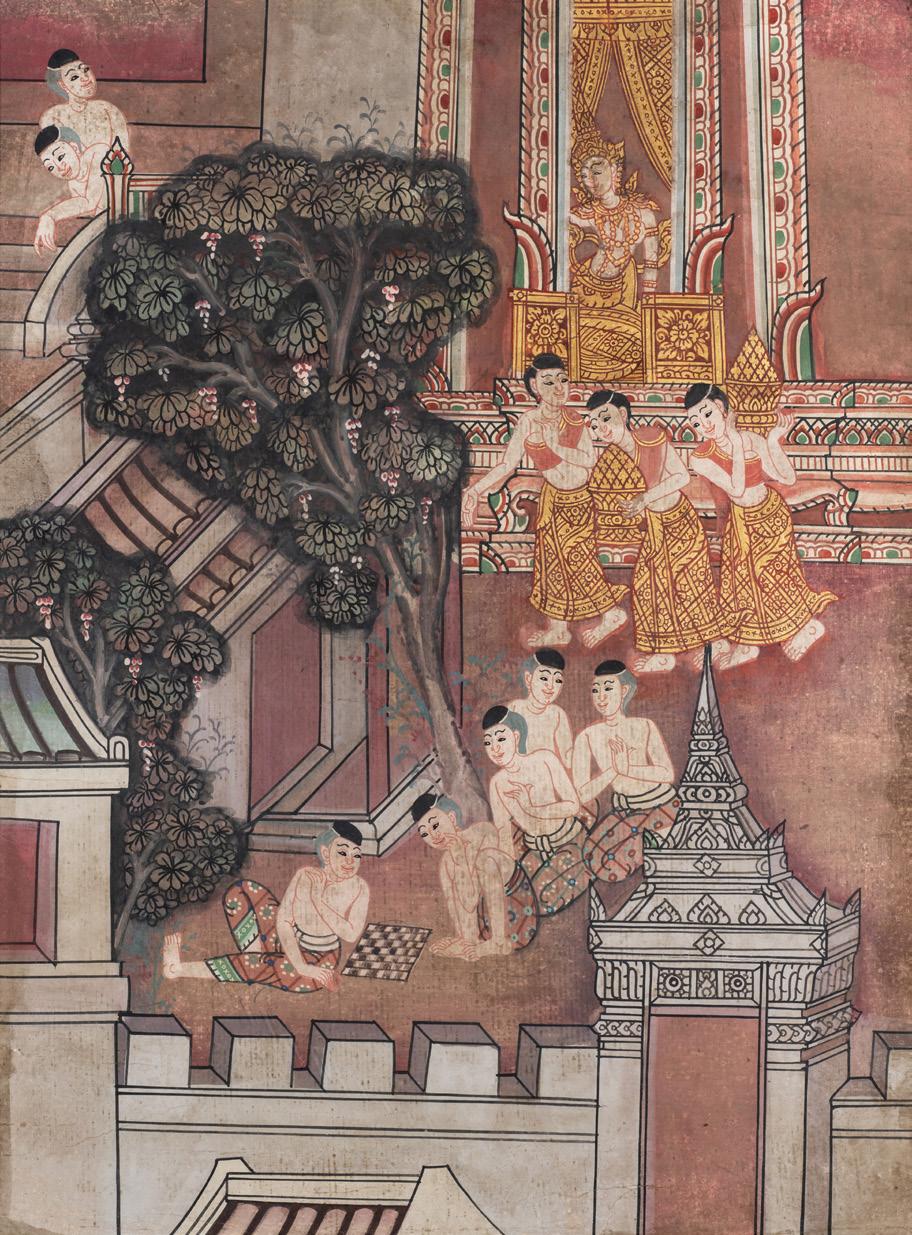
264.
FIVE REPOUSSE COPPER GILT PLAQUES, THAILAND, 19TH CENTURY, depicting Rama battling with a rakasha, each mounted on stand, 14 x 11cm approx. each £500-700 part
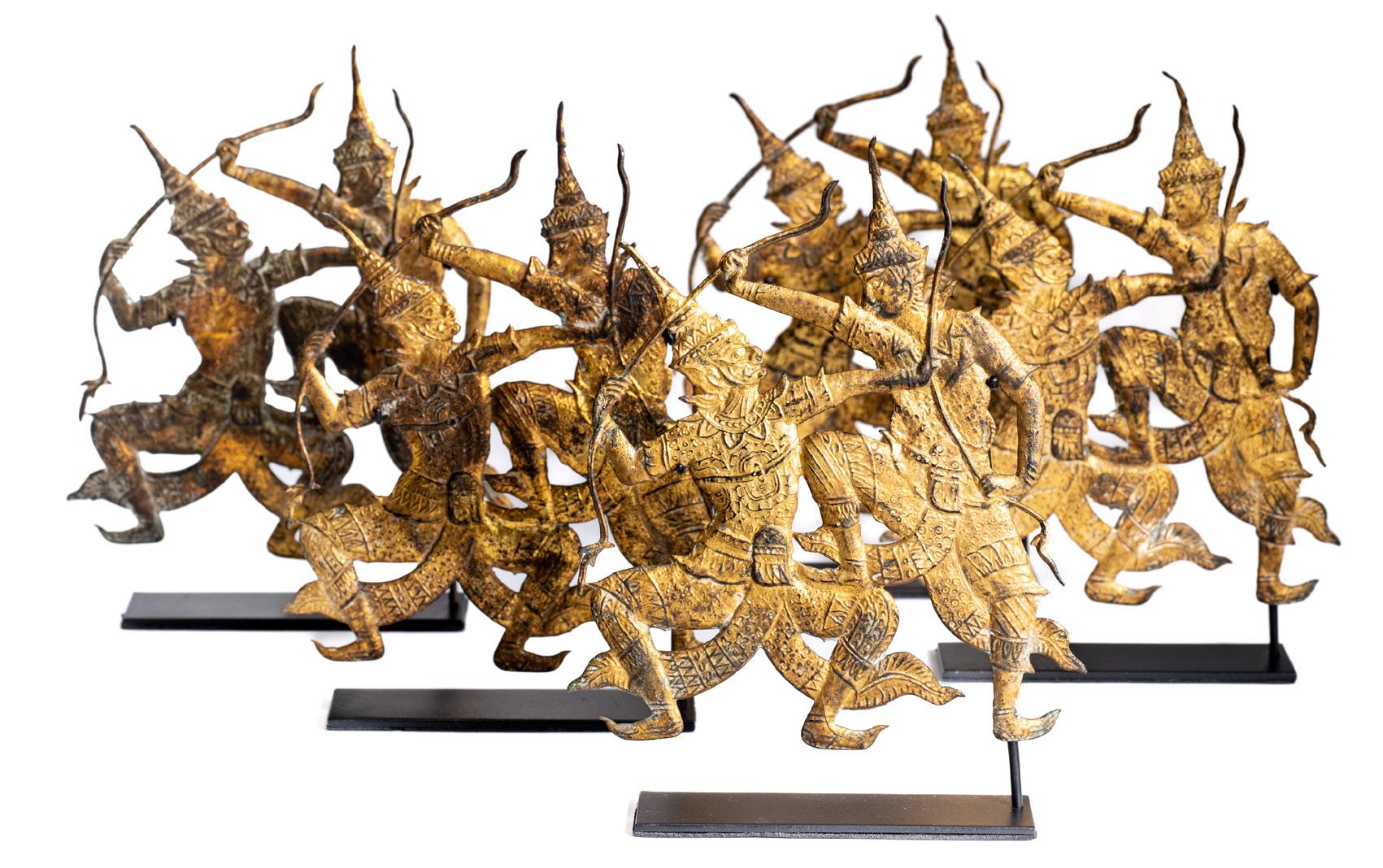
105
265.
□ A SINGLE HEADED DRUM (TABLA), NORTHERN INDIA, 20TH CENTURY, of jar shaped form, the wood body with turned decoration, the head tensioned with multiple leather straps and tightened with inserted painted wood reels (gatte), 27cm high

Provenance: Tony Bingham, London
The term 'tabla' is also generally used for a duo of drums, the other type being the copper bowl-shaped baya. See Cross 1982, p.5.
£40-60
266.
□ TWO NEW GUINEA COLUMN DRUMS (KUNDU), PAPUAN GULF, 19TH / 20TH CENTURY, each of waisted cylindrical form, with reptile skin head, 103cm; 61cm long
Provenance: Tony Bingham, London
For related examples, see Port Moresby 1988, p.19
£300-400
267.
□ A LARGE CEREMONIAL SLIT DRUM (GARAMAT), LOWER RAMU OR COASTAL SEPIK, NEW GUINEA, EARLY 20TH CENTURY, of long cylindrical form with linear opening running along the top, the sides carved and painted with abstract motifs in red, white and green, a projecting finial at each end in the form of a human figure with overside mask-like face, 201cm long Provenance: Acquired by the Christensen Fund; donated to the Western Australia Museum; de-accessioned in the early 1990s, when acquired by the vendor.
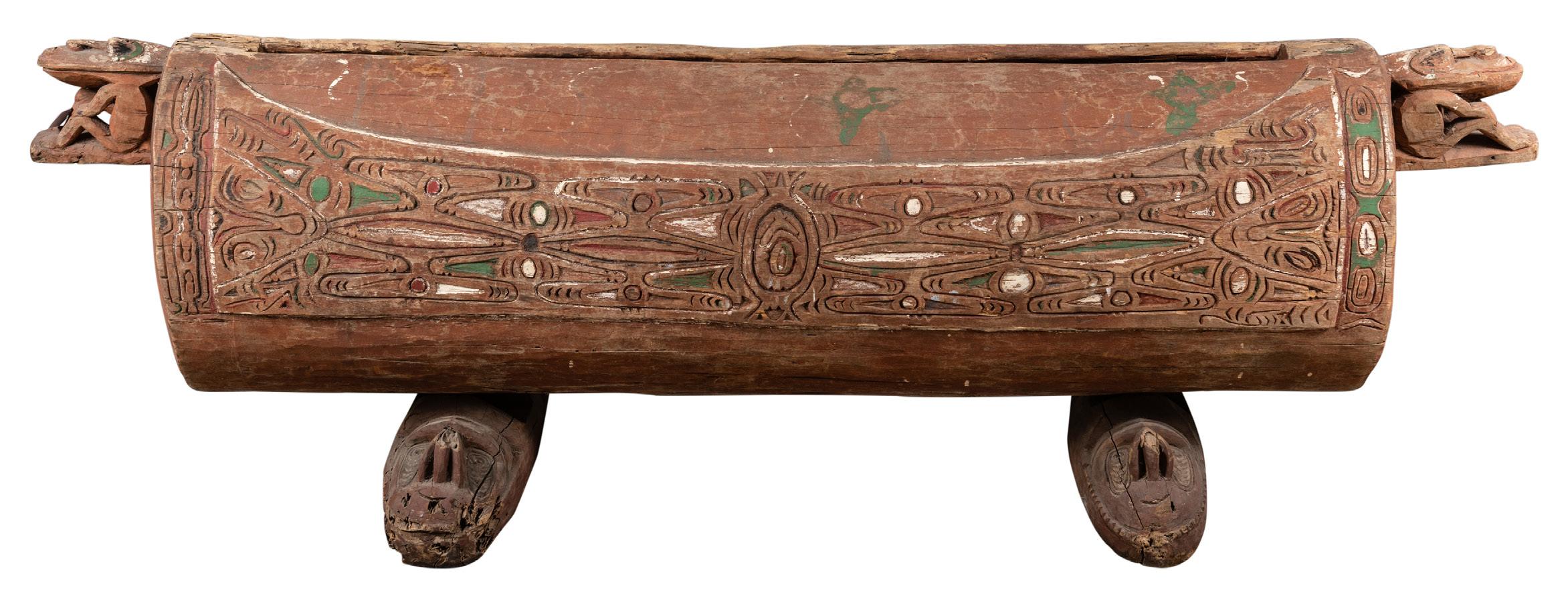


Published: Bortignon 1980, p.66.
For an illustration of another garamat in East Sepik District, see Gourlay 1975, p.114, pl.14
£600-800
106
268.
□ A SET OF SIX SUSPENDED BRONZE BELLS, CHINA, EARLY 20TH CENTURY, of descending size, each of hemispherical form, strung together, decorated in gold with red and black lacquer, with central lotus surrounded by flower and tree motifs, with key design around the rim, together with A Bronze Rattle, 19th/20th century, composed of an archaistic Chinese bronze mirror fringed with eight pellet bells, Bells: 21.5 and smaller, Rattle: 20cm diam.


Provenance: Tony Bingham, London £150-200
269.
□ A LUTE (GAMBUS), NORTH SULAWESI, INDONESIA, MID-20TH CENTURY, the bulbous wood body with hide face, tapering into the hollow neck, the scrolling headstock in the form of a fish, the tailpiece (buntut) inscribed with date, reading 1.7.1955, 87cm long
The gambus is derived from the South Arabian qanbus. This example is one of two types, the gambus Melayu which has a hide resonator unlike the gambus Hadhramaut, made of wood. For a photograph of the instrument being played in Bolaang Mondondow, accompanied by a drum, see Kunst 1994, p.176. £80-120

107
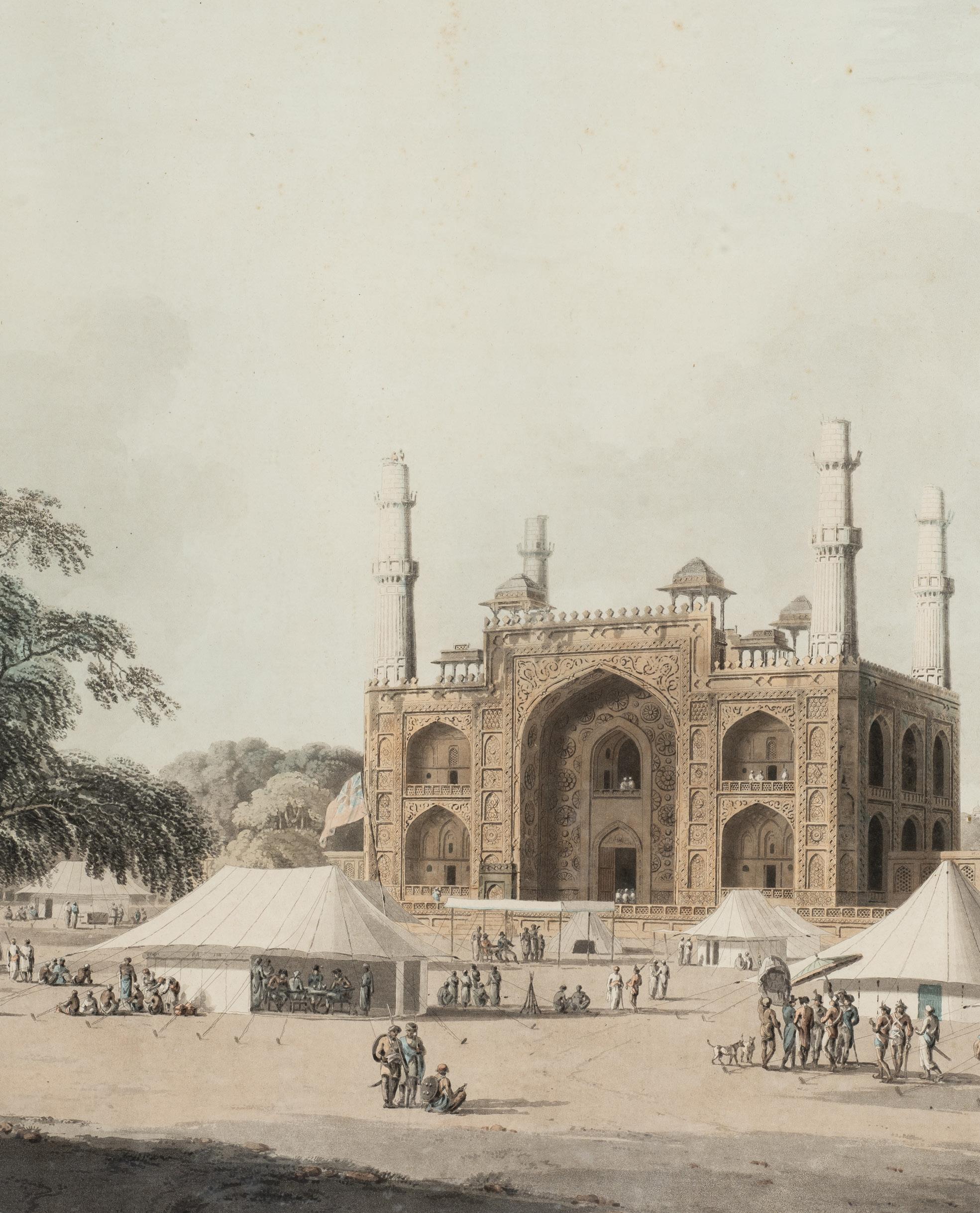
Lot 330 detail
THE PETER MILLETT COLLECTION LOTS 270-371
Peter John Curnow Millett (1925-2016)

Peter Millett was born in Karwar, near Goa, on the west coast of India, and after school in England and a spell in the Indian Army, he moved to Assam, where he worked as a tea planter. After spending most of the 1950s there, he transferred to Kerala, where he managed the Pambra Coffee and Timber Estate. He came back to England with his family in 1973, settling on the edge of Dartmoor and started a new career as a probation officer and marriage guidance counsellor, retiring in the mid-1980s. From this point onwards, he had time to pursue more seriously his hobby of collecting antiques, transforming it into a business, specializing in objects from India, which, remarkably, he mostly found in auctions and antique shops close to home in the West Country. I first met him over thirty years ago, and over the following decades would frequently see him on his regular visits to London selling his recent discoveries. His charming and amusing company belied an acute eye and keen business acumen, and he sold several items to the British Museum. Working on his collection for this auction has been a hugely enjoyable experience, bringing back happy memories of Peter. His extensive library of reference books on India will be sold in these rooms at a future date.
(Arthur Millner)
109
270.
A BRONZE FIGURE OF NANDI BULL SHELTERED BY A COBRA, WESTERN DECCAN, INDIA, CIRCA 18TH CENTURY, crouching on a raised plinth, a diminutive lingam in front, wearing bells and trappings, his head with prominent horns, 12.5cm high

£120-150
271.
A BRONZE FIGURE OF KRISHNA VENUGOPALA, BENGAL, EASTERN INDIA, 19TH CENTURY, standing with his ankles crossed, his hands raised playing the flute (now missing), a bracelet on each wrist, traces of black and red lac, 20.5cm high

£250-350
272.
A BRONZE FIGURE OF KRISHNA, TAMIL NADU, SOUTH INDIA, 15TH/16TH CENTURY, standing in tribhanga on a raised lotus base, his left arm raised, wearing elaborate belt with lion head clasp, earrings and tall headdress, 19.5cm high
This form of Krishna, depicted with his arms raised, is often confused with Rama, whose pose when holding bow and arrow is similar. In this case, however, there is no quiver of arrows over his shoulder, and the god is resting his left arm on the shoulders of his favourite consort Satyabhama. For a Chola bronze of the same iconography in the Los Angeles County Museum of Art, see Pal 1988, p.278
£500-800

110
273.
A BRONZE FIGURE OF KRISHNA, TAMIL NADU, SOUTH INDIA, 17TH/18TH CENTURY, the youthful deity on raised lotus base, holding a butter ball in his right hand, 9cm high £150-250
274.
A BRONZE FIGURE OF KRISHNA, TAMIL NADU, SOUTH INDIA, 18TH/19TH CENTURY, the youthful deity on raised lotus base, his right foot resting on a lotus, holding a butter ball in his right hand, 11cm high £150-200
275.
A SMALL BRONZE FIGURE OF KRISHNA KALIYADAMANA, SOUTH INDIA, 18TH/19TH CENTURY, the young Hindu deity dancing on the snake's body while holding a butter ball in his left hand, on raised lotus base, 7cm high Kaliya, the snake, had been wounded by Garuda after failing to pay him due respect and retreated to a lake which he poisoned with lethal vapours. Krishna fought with him after hearing that his friends and their animals were being poisoned. Kaliya, after almost dying in the struggle depicted here, was spared and subsequently became an ardent devotee. £100-150
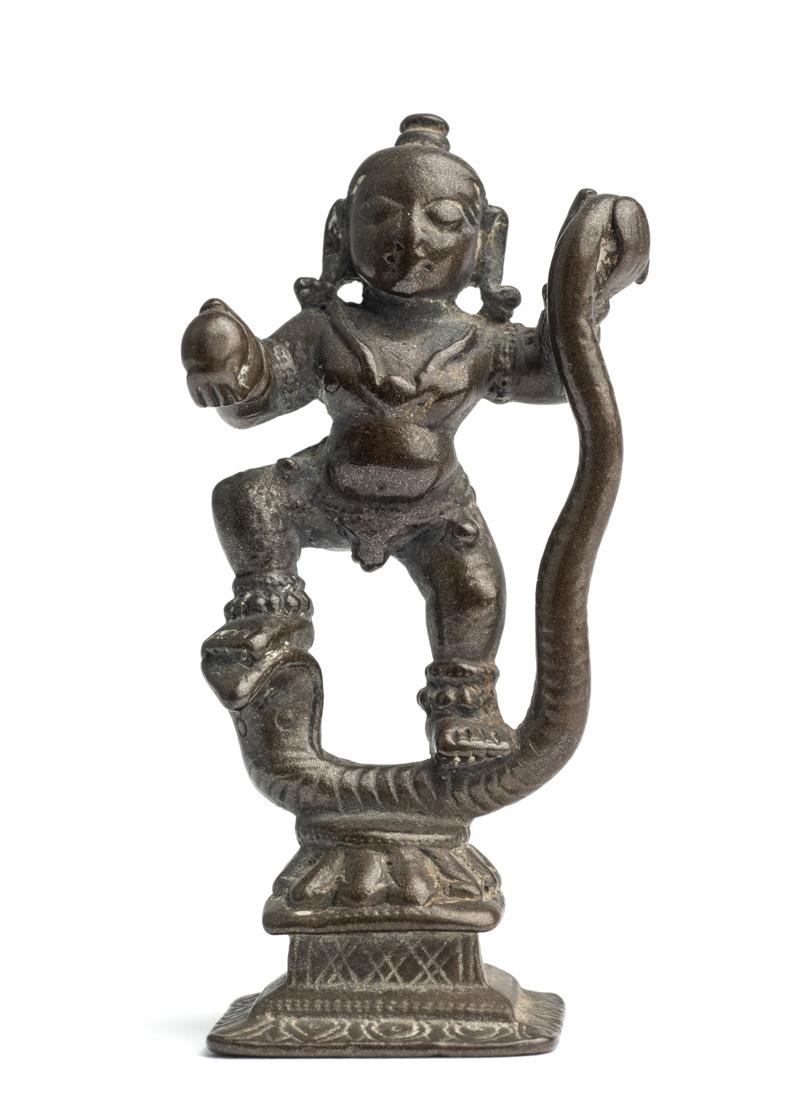

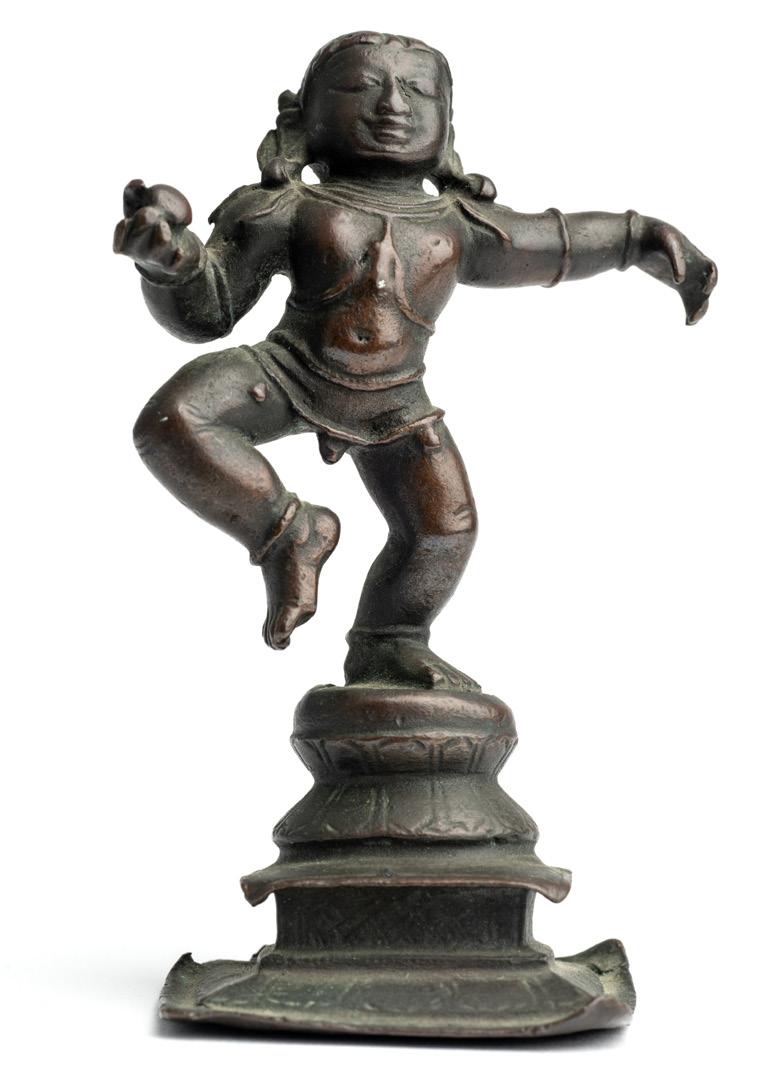
111
276.
A BRONZE FIGURE OF HANUMAN, DECCAN, SOUTH INDIA, CIRCA 18TH CENTURY, standing on a square plinth with hands in anjali mudra, his long tail form an arch behind him, 12.3cm high
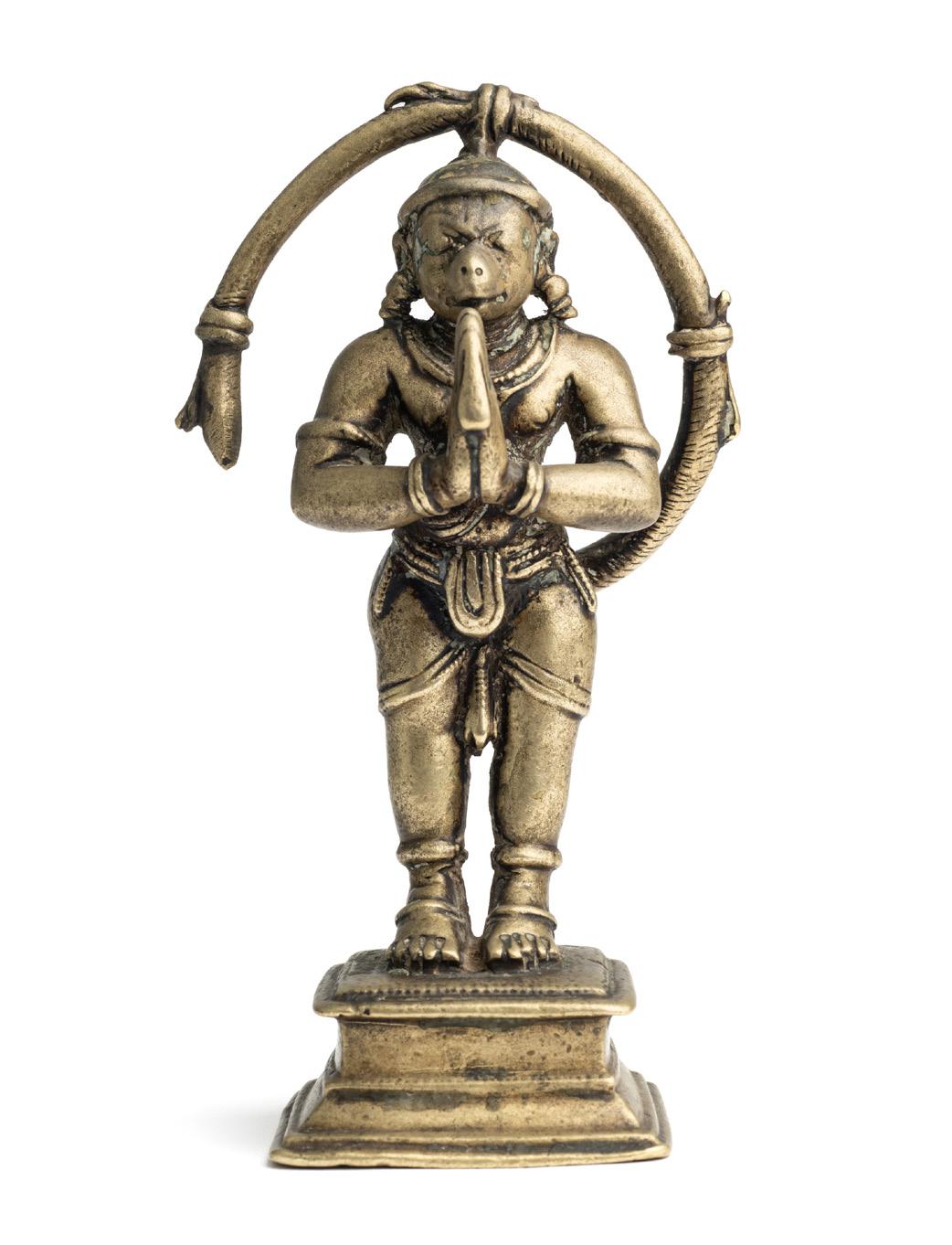
£250-350
277.
TWO BRONZE FIGURES OF HANUMAN, SOUTH INDIA, EARLY 20TH CENTURY, one with hands in anjali mudra, the other with right hand raised, 9.8, 10.6cm high £150-250

278.
A BRONZE FIGURE OF RAMANUJA, TAMIL NADU, SOUTH INDIA, 19TH CENTURY, the Vaisnava saint seated in padmasana on a cushioned plinth, his hands in anjali mudra, a staff tucked in his right arm, 7.5cm high Ramanuja is a historical figure who lived in South India in the 12th century. He is one of the most important teachers (acharyas) of devotional Hinduism (bhakti). Although the object he is holding resembles an axe, it is in fact a staff with a cloth banner attached.
£120-150

112
279.
A SMALL JAIN BRONZE SHRINE, WESTERN INDIA, 12TH/13TH CENTURY, depicting three tirthankara figures, each naked, standing under a tiered parasol, framed by slender columns supporting a pointed arch surmounted by kalasa, the tapered base with two lines of devanagari script including indistinct date, 10.5cm high

This small shrine bears a striking resemblance in style and composition to a much larger piece dated 1121 A.D. in the Los Angeles County Museum of Art (M.75.90). Although our jinas do not have the identifying emblems, the figures in the Los Angeles bronze are identifiable as Santinatha, flanked by Neminatha and Vasupujiya. See Pal 1988, p.141
£200-300
280.
A BRONZE FIGURE OF DURGA RIDING ON HER LION, WESTERN DECCAN, CIRCA 18TH CENTURY OR LATER, the four armed goddess holding an attribute in each hand, wearing a five leaf crown, 11cm high
£120-150
281.
A BRONZE FIGURE OF SARASWATI, TAMIL NADU, SOUTH INDIA, 19TH CENTURY, the goddess seated with legs loosely crossed on a lotus base, playing a veena, his head with tall headdress, 8cm high

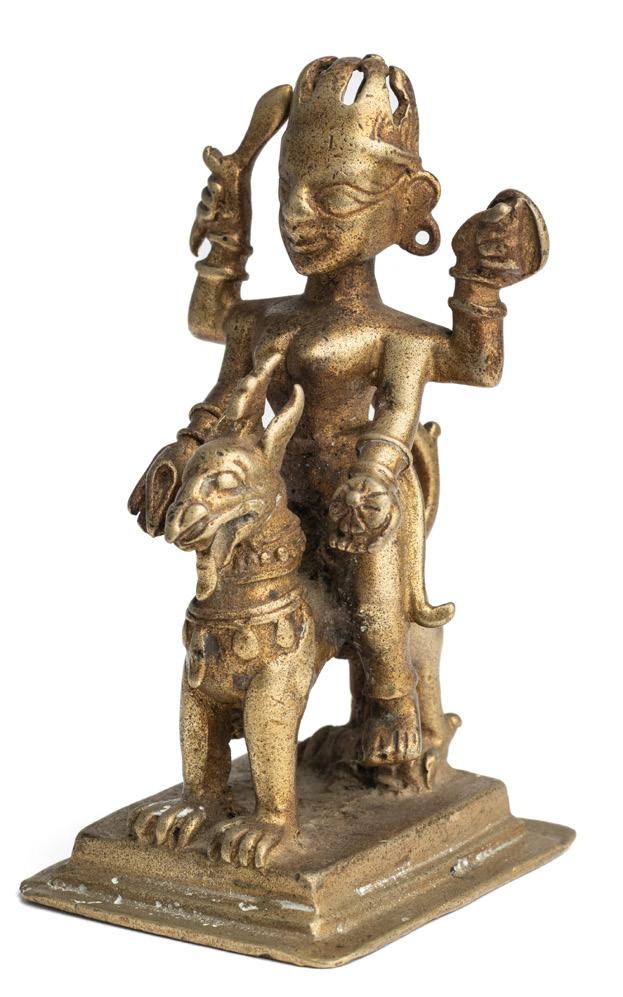
£120-150
282.
THREE BRONZE FIGURES OF BALAKRISHNA, BENGAL, ORISSA AND TAMIL NADU, INDIA, 17TH-19TH CENTURIES, each depicting the infant deity crawling and holding a butter ball, 7.5, 6, 6.5cm
£200-300

113
283.
A BRONZE FIGURE OF DURGA MAHISASURAMARDINI, ORISSA, EASTERN INDIA, CIRCA 17TH CENTURY, the four-armed goddess stabbing the buffalo demon with her trident, assisted by her vehicle the lion, the decapitated buffalo head on the lotus base below, 13cm high £300-400
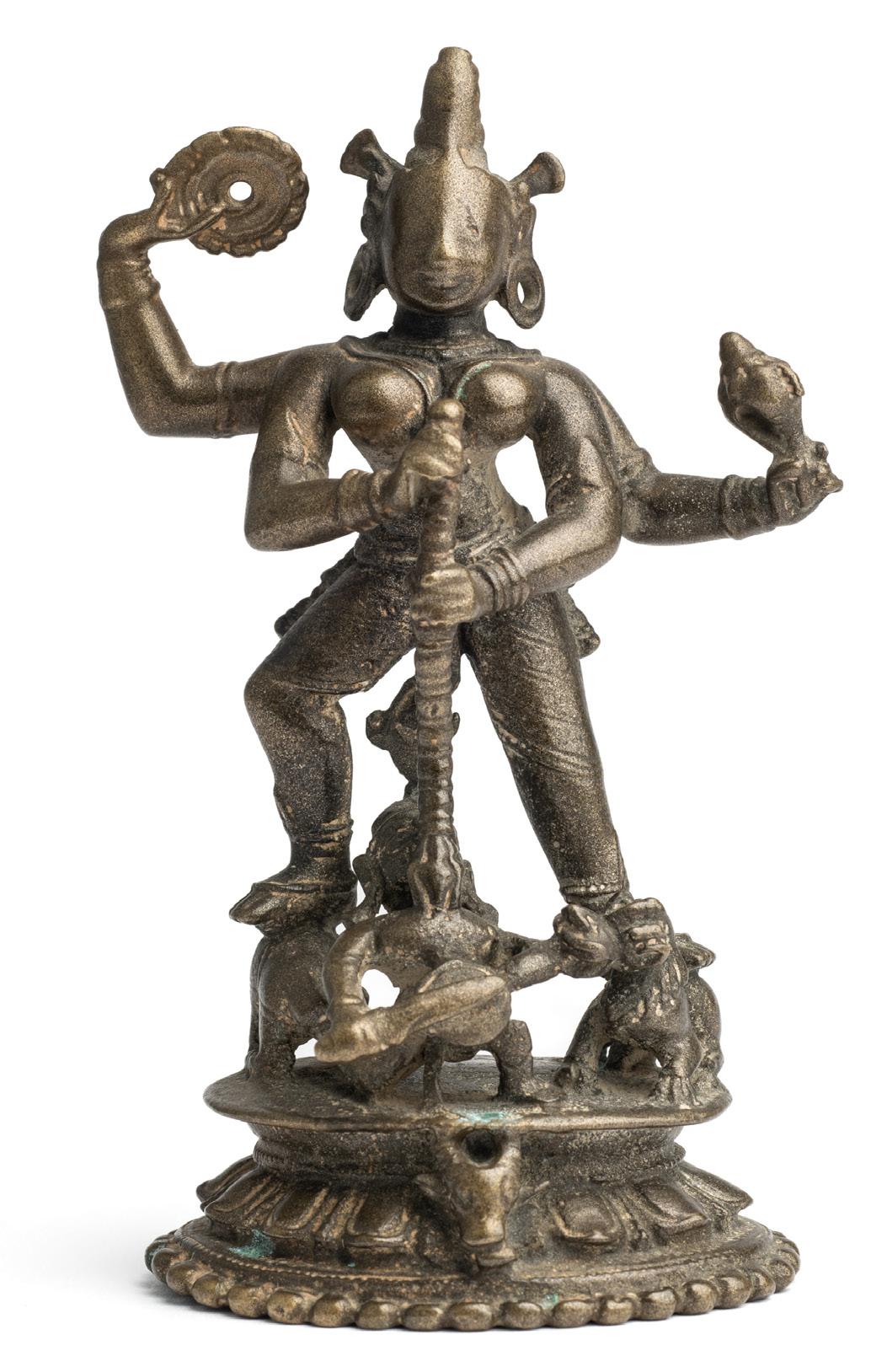
284.
VISHNU WITH BHU DEVI AND SRI DEVI, TAMIL NADU, SOUTH INDIA, 18TH/19TH CENTURY, each standing on lotus bases, the four armed god with primary hands in varada mudra and resting on his mace (now missing), his consorts each holding the stem of a padma, 9cm, 8cm, 8cm (3)
The two goddesses are distinguished by the form of the lotuses they are holding and the breast band, which is worn only by Sri-Devi. £250-350

114
285. A 'GANGAJUMNA' FIGURE OF VISHNU, TAMIL NADU, SOUTH INDIA, 18TH CENTURY, bronze, with details highlighted in brass overlay, the four armed deity with primary hands in varada mudra and resting on his mace (now missing), wearing earrings and tall conical headdress with bud finial, 9.8cm high £100-150
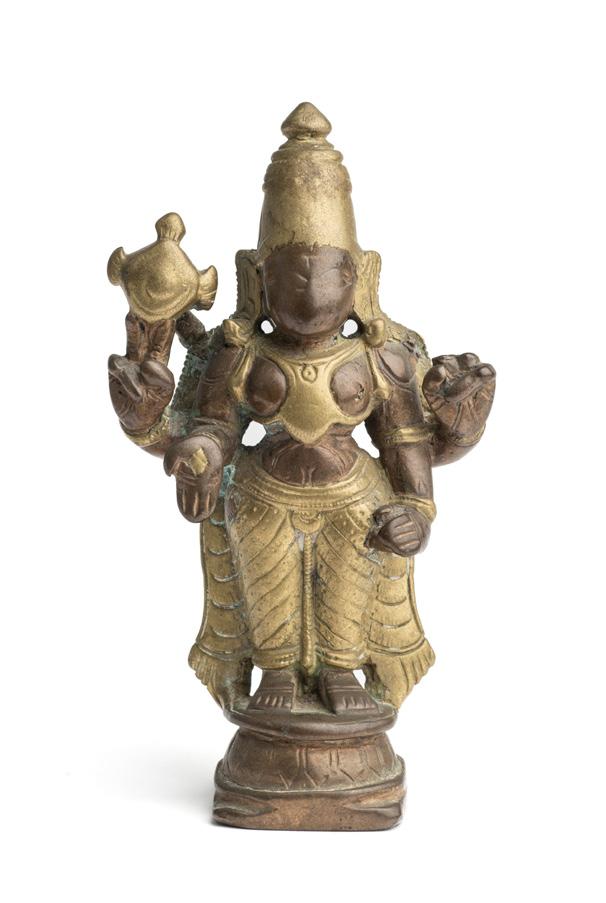
286.
FIVE SMALL BRONZE IMAGES, SOUTHERN INDIA, 15TH-19TH CENTURIES, comprising two miniature Siva altars, a figure of Khandoba on horseback, a figure of Skanda(?) and a small image of Nandi bull, 7cm and smaller £200-300


287.
THREE SMALL FOLK BRONZES, CENTRAL INDIA, 19TH CENTURY, each depicting the figure of a deity, one male, two female, 7.5cm and smaller £60-80
115
288.
FIVE SMALL VAISNAVITE BRONZE IMAGES, SOUTHERN INDIA, 18TH/19TH CENTURY, comprising three figures of Balakrishna, one figure of Vishnu and one of Vaisnavi, 6.5cm and smaller £150-250
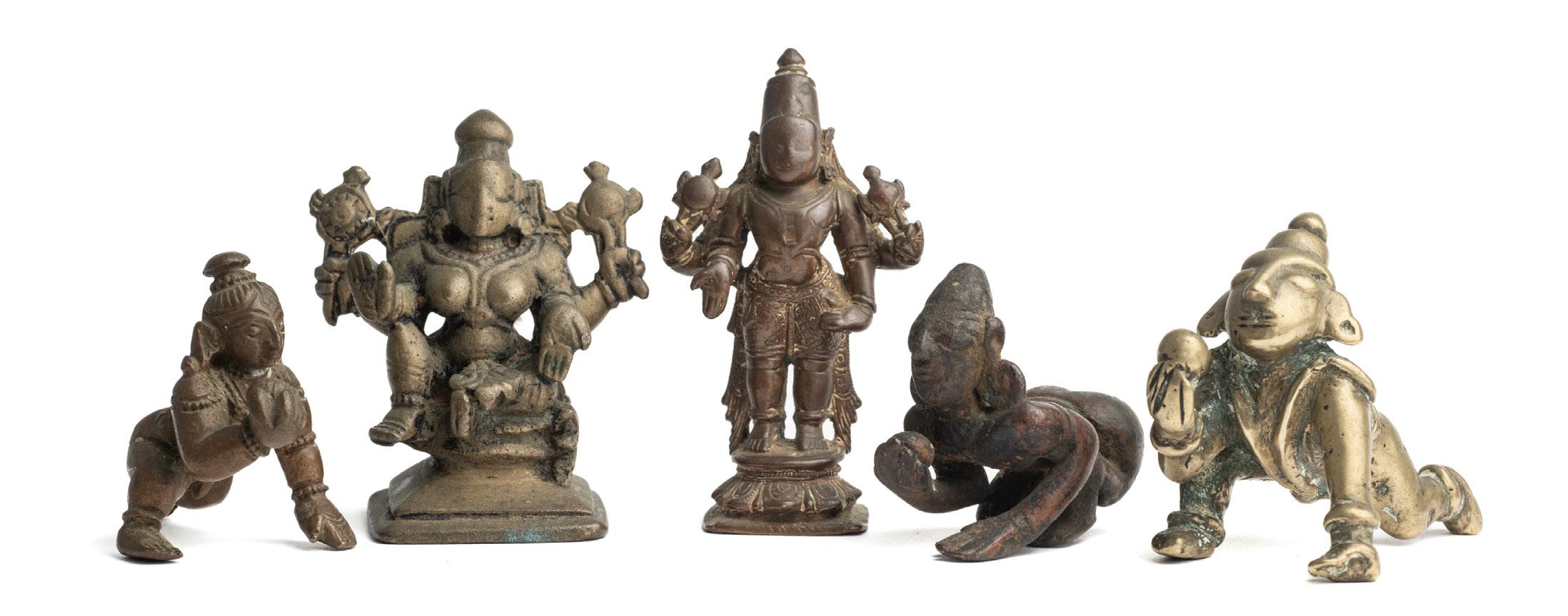
289.
A BRONZE FIGURE OF VITHOBA, DECCAN, SOUTHERN INDIA, 18TH/19TH CENTURY, standing on a lotus base, holding a pouch in his right hand, a conch shell in his left, 10.5cm £200-300

290.
A BRONZE FIGURE OF VISHNU, SOUTH INDIA, 19TH CENTURY, the four armed deity standing on a lotus base on raised plinth, with hands holding cakra, sankha, gada and a flower, 12cm high £250-350

116
288 289 290
291.
A BRONZE FIGURE OF GANESHA, TAMIL NADU, SOUTH INDIA, 18TH/19TH CENTURY, the four-armed, elephant headed deity seated on a raised lotus throne, holding a goad, a noose and a broken tusk, eating sweets with his trunk from his left hand, his vehicle the rat below, 9.5cm high £200-300

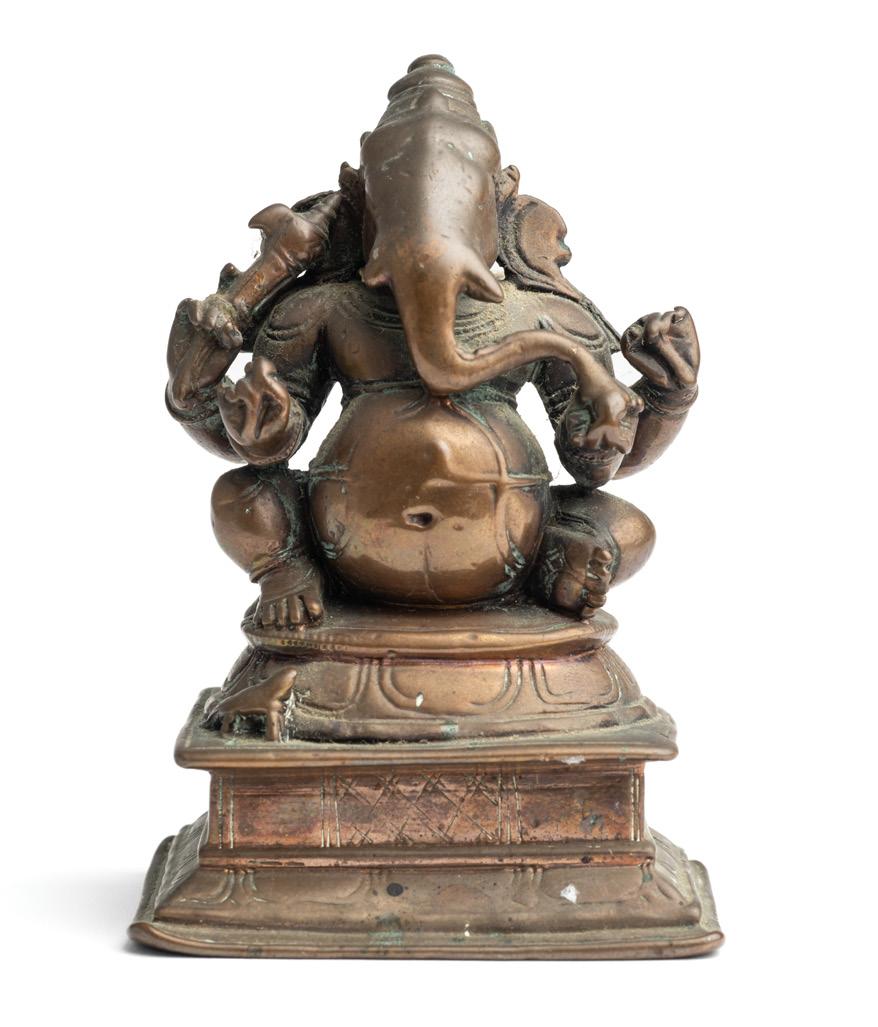
292.
A SMALL BRONZE FIGURE OF GANESHA, DECCAN, SOUTHERN INDIA, 16TH/17TH CENTURY, the fourarmed, elephant headed deity seated on a lotus throne, his vehicle the rat at his side, 6.7cm £150-250
293.
TWO BRONZE HANUMAN TALISMANIC PENDANTS, PROBABLY DECCAN, SOUTHERN INDIA, 18TH, 19TH CENTURIES, each of circular pierced form with central striding figure of the monkey god, the larger with the god holding the tree with the magic herbs, a sevenheaded cobra above and a defeated warrior below, 16.5, 7cm
For a related, larger, example in the Los Angeles County Museum of Art, see Pal 1988, p.233 £150-200

117
PALLAVA GRANITE BUST OF A MALE DEITY, TAMIL NADU, SOUTH INDIA, CIRCA 8TH CENTURY, wearing necklace, sash, earrings and tiered headdress, mounted, 30cm
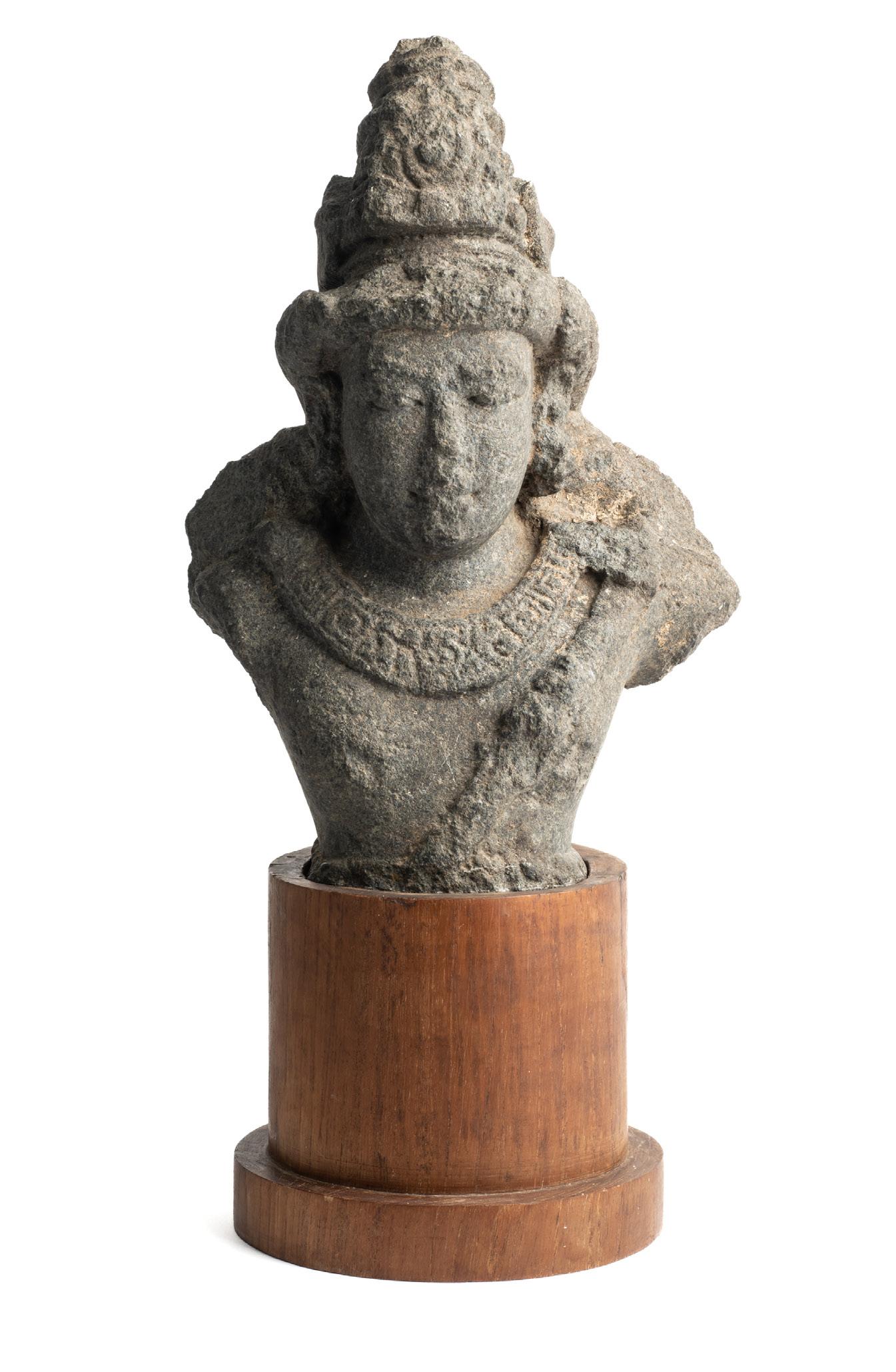
118 294. A
£700-900
295. A GREY STONE IMAGE OF VIRABHADRA, DECCAN, INDIA, CIRCA 15TH CENTURY, the four-armed deity holding sword and shield in his primary hands and bow and arrow in his upper hands, a small figure of the goat-headed Daksha at his feet, 21.2cm high £800-1200
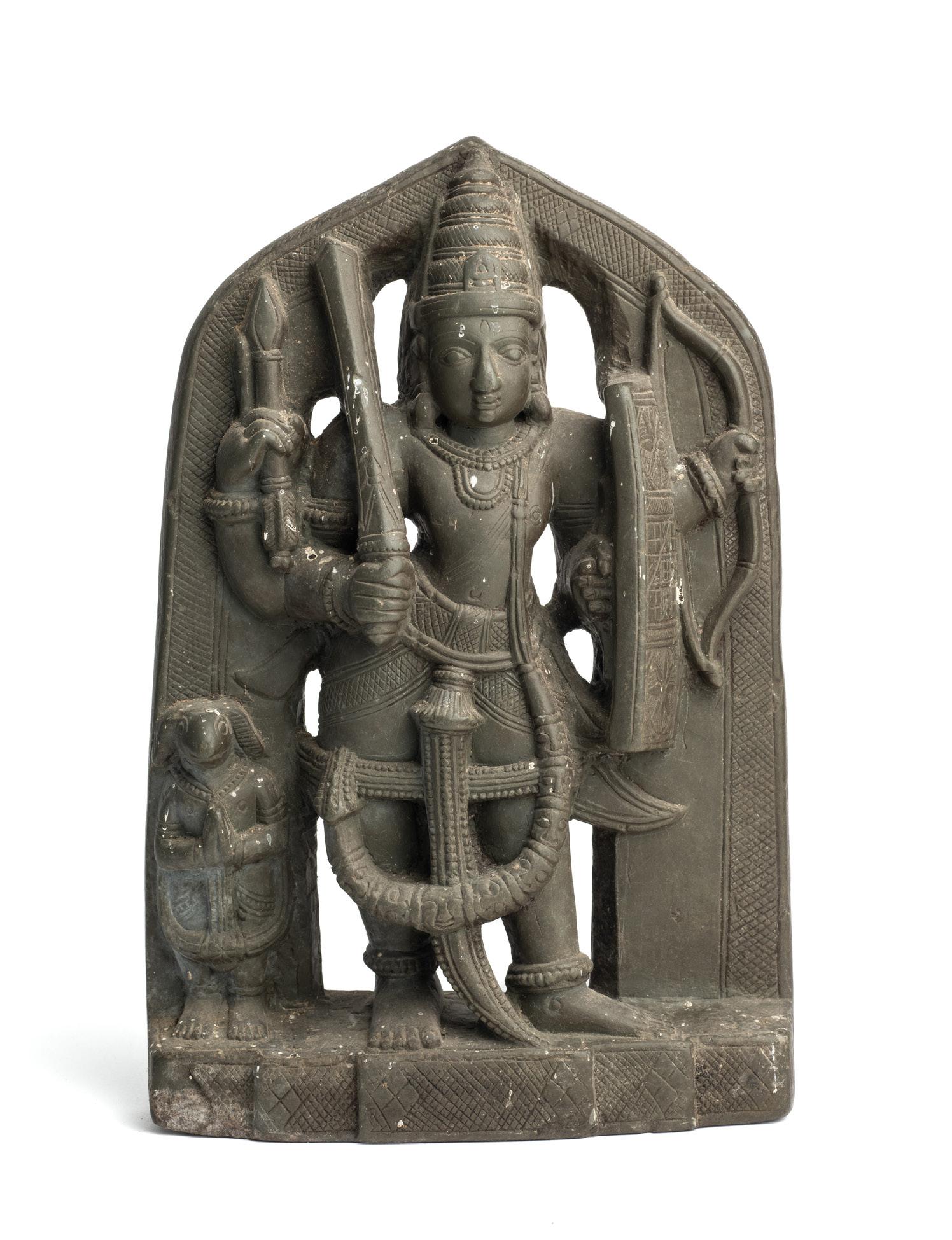
119
296.
TWO HINDU BRONZE NAGA IMAGES, DECCAN, 18TH-19TH CENTURY, one with single cobra head, on conical stand, the other a five-headed cobra canopy from a portable shrine, 26, 28.5cm high £80-120

297.
A BRONZE SHRINE DEPICTING DURGA MAHISASURAMARDINI, WESTERN INDIA, DATED SAMVAT 1735/1678 AD, the four armed goddess attacking the demon with her trident as it emerges from the decapitated buffalo's body, while holding a sword and ritual drum in her upper hands, the goddess and her foe wearing silver bracelets and armbands, extensive dedicatory inscriptions including date in devanagari script on the reverse, 17.5cm high

Very unusual on a Hindu bronze of this date is the Mughal style merlon decoration engraved on the base. £600-800
298.
A BRONZE FIGURE OF SUBRAHMANYA, TAMIL NADU, SOUTH INDIA, 19TH CENTURY, standing on a square lotus base, his vehicle the peacock standing behind holding a cobra in its beak, the four armed deity with primary right hand in abhaya mudra, his left in varada mudra, holding vajra and tanka in his upper hands, wearing conical headdress with bud finial, his long hair flowing over his shoulders, 17.3cm high
£250-350

120
299.
AN UNUSUAL BRONZE SHRINE DEPICTING KRISHNA PLAYING HIS FLUTE, PROBABLY EASTERN DECCAN, CIRCA 15TH CENTURY, the four-armed god playing his flute, his upper hands holding gada and conch shell, a cakra hanging from his right elbow, flanked by a pair of gopis holding offerings, a pair of cows with a calf below, a diminutive figure of Garuda at the front, the prabha with small lingam and figure of Ganesha on each side, sun and moon emblems above, remnants of gilding in several places, 16.5cm high
There are a number of unusual features of this bronze, such as the curious hook and bulb motifs around the prabha. Also the presence of Ganesha and a lingam, as well as the sun and moon emblems, are connected with Siva, and not commonly seen on Krishna images.
£800-1200
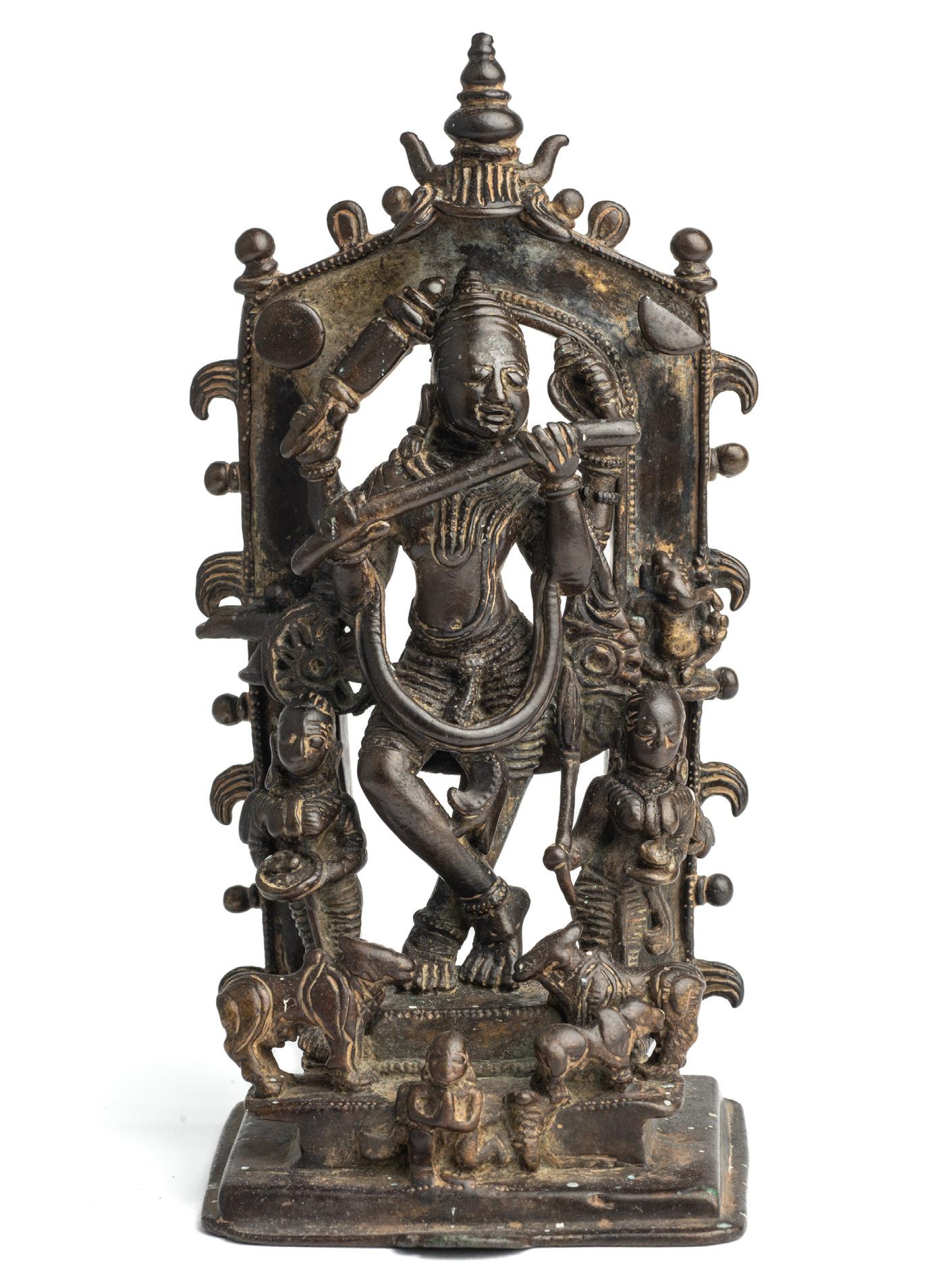
121
300.
A LARGE VIRABHADRA PLAQUE, WESTERN DECCAN, INDIA, 18TH CENTURY, of waisted rectangular form, the form armed form of Siva holding sword, shield, bow and arrow, Nandi and sun and moon emblems above, sheltering under a five-headed cobra, wearing sandals, flanked by Daksha and Sati, a handle at the back, 28 x 20cm
For a similar plaque in the Norton Simon Museum, Pasadena, see Pal 2003, p.303. Daksha offended Siva by not inviting him to attend a sacrifice following an earlier occasion when Siva had slighted him. Sati, who was Daksha's daughter, as well as being Siva's wife, was present and felt so insulted that she threw herself on the pyre. Then Siva appeared as Virabhadra and cut off Daksha's head to avenge his wife. Other gods pleaded for Daksha's life, but although Siva decided to spare him, his severed head could not be found, so the head of a goat was substituted instead. Daksha is depicted with hands in namaskara mudra, humbly paying respects, while at the bottom, he appears prior to the replacement head

122
£300-400
301.
A BRASS SIVA MASK, WESTERN DECCAN, INDIA, 18TH/19TH CENTURY, in the form of a moustachioed face of Siva, his headdress with bud-shaped finial, wearing necklace with lozenge shaped pendant, 25.5cm high



For a closely related mask in the Museum of Folk and Tribal Art, Gurgaon, see Aryan 2005, p.63, No.113. £400-600
302.
TWO BRONZE SIVA MASKS, WESTERN DECCAN, INDIA, 19TH CENTURY, each in the form of a moustachioed face of Siva, with flared headdress and earrings, 18.5, 13.5cm high
See footnote to the previous lot.
£300-500
123
303.
A BRONZE FIGURE OF DURGA, WESTERN DECCAN, INDIA, DATED SAMVAT 1658/1601 AD, the four-armed goddess seated in lalitasana on a raised stool, holding damaru, trisula, patra and khadga, a pierced and cusped arch behind, surmounted by a kalasa, a dedicatory inscription of two lines of devanagari script, including date, on the reverse, 13.5cm £250-350

304.
A BRONZE FIGURE OF NARASIMHA, DECCAN, SOUTHERN INDIA, CIRCA 18TH CENTURY, the lion avatar of Vishnu seated with legs loosely crossed, originally held with yoga-patta, his consort, Lakshmi seated on his left knee, a discus and conch in his upper hands, a seven headed cobra canopy above, 10cm high

£150-250
305.
THREE BURMESE FIGURES, 19TH CENTURY, comprising a lacquered and gilt wood figure of Buddha, inlaid with faceted glass and inscribed in Burmese on the base, a marble reclining figure of Buddha and a bronze mythical lion (chinthe), 28.5cm high and smaller £120-150
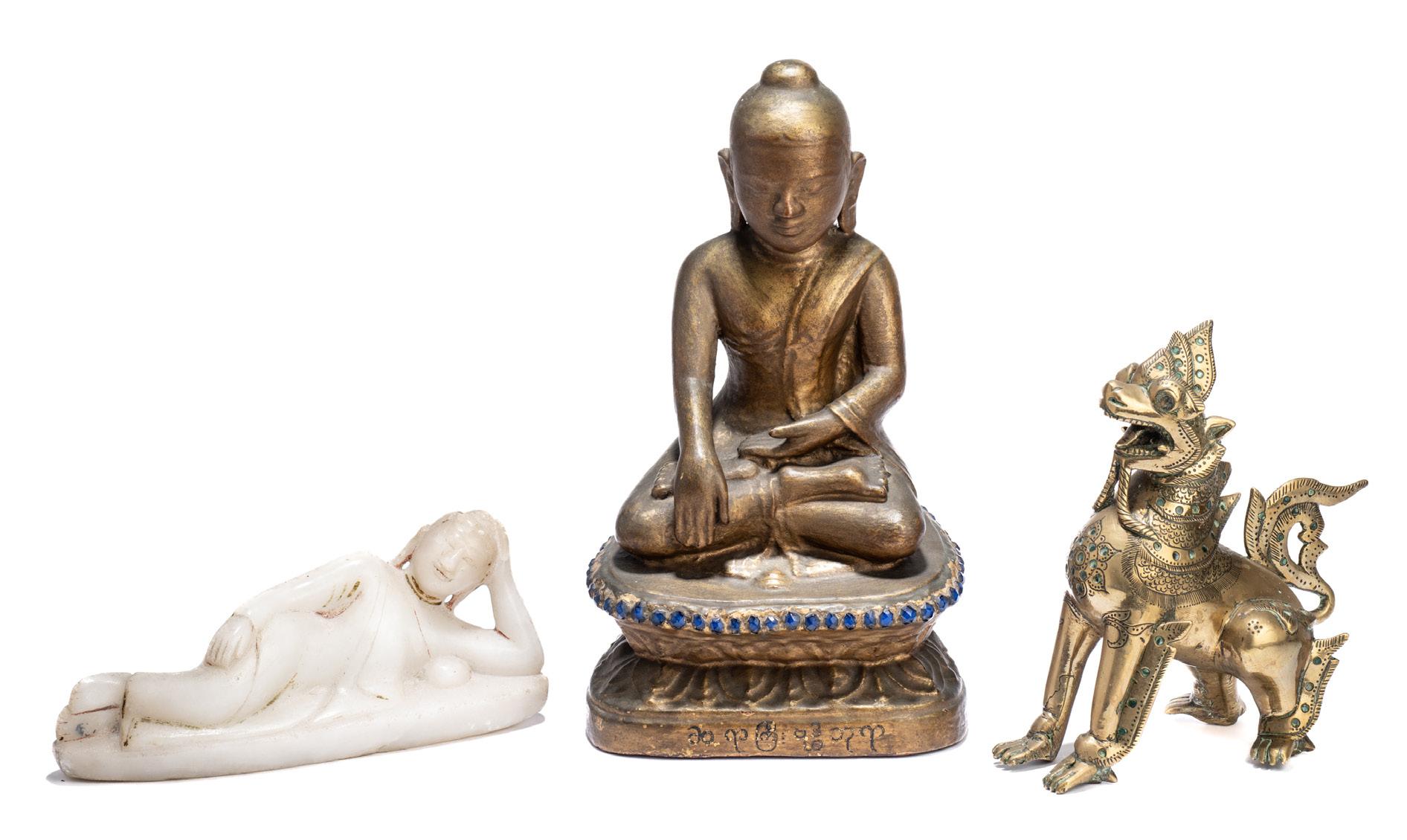
124
306.
A BRONZE FIGURE OF A SEPOY, PROBABLY BENGAL, INDIA, 19TH CENTURY, standing on square base, wearing uniform with shako on his head, a gun resting on his left shoulder, 18.3cm high £70-90
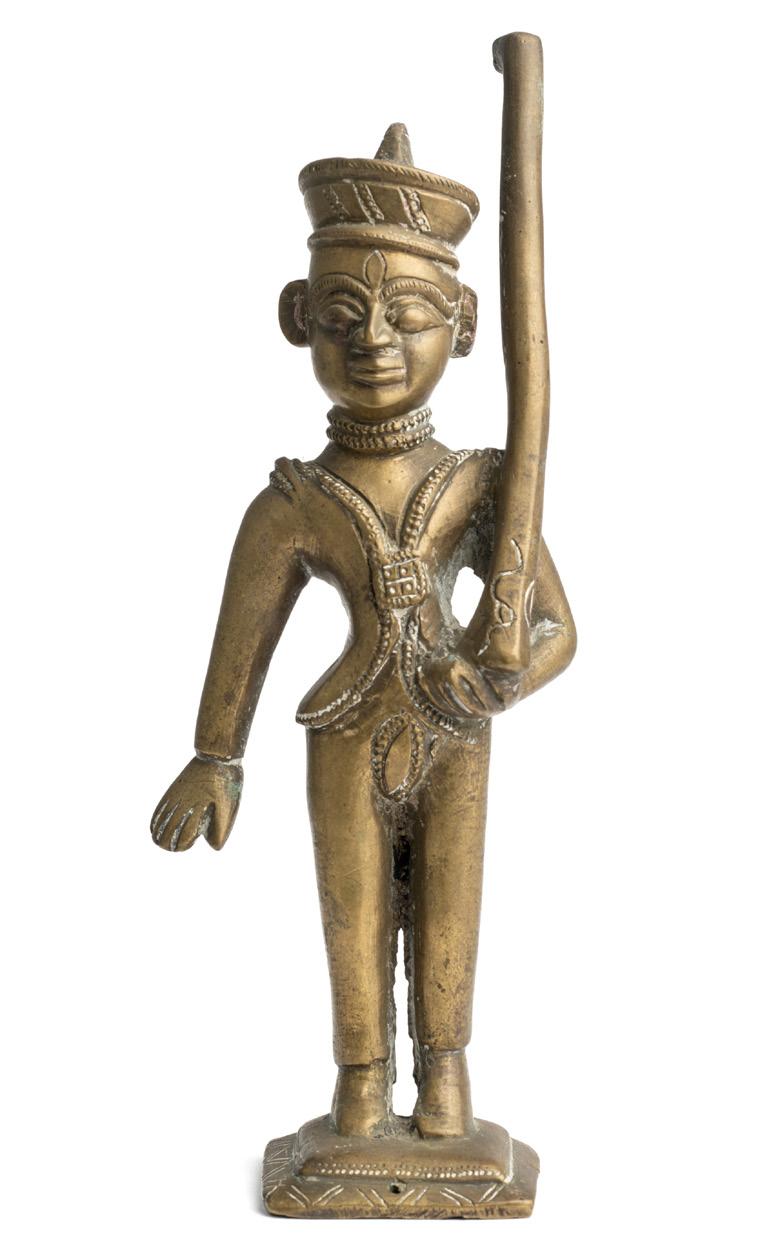
307.
TWO BRONZE ANIMALS, INDIA, CIRCA 19TH CENTURY, comprising a dog, on rectangular base with scrolling tail and collar, and a camel, wearing neck ornaments and a brocaded blanket, 15cm, 20cm £80-120

308.
THREE SMALL BRONZE IMAGES, INDIA, 17TH-19TH CENTURIES, comprising figures of Garuda, a rishi and Hanuman, 6.5cm and smaller £120-180

309.
TWO BRONZE RITUAL OBJECTS, DECCAN, INDIA, CIRCA 18TH CENTURY, comprising an incense stick holder in the form of a seven-headed cobra and an oil lamp in the form of a lotus, each with scrolling shaft leading to support foot, 13cm long approx. each £80-120

125
310.
A BRONZE FIGURE OF A MYTHICAL LION (VYALA), INDIA, 18TH/19TH CENTURY, standing on rectangular base, with pointed snout, protruding tongue and scrolling tail, 12cm high £150-200
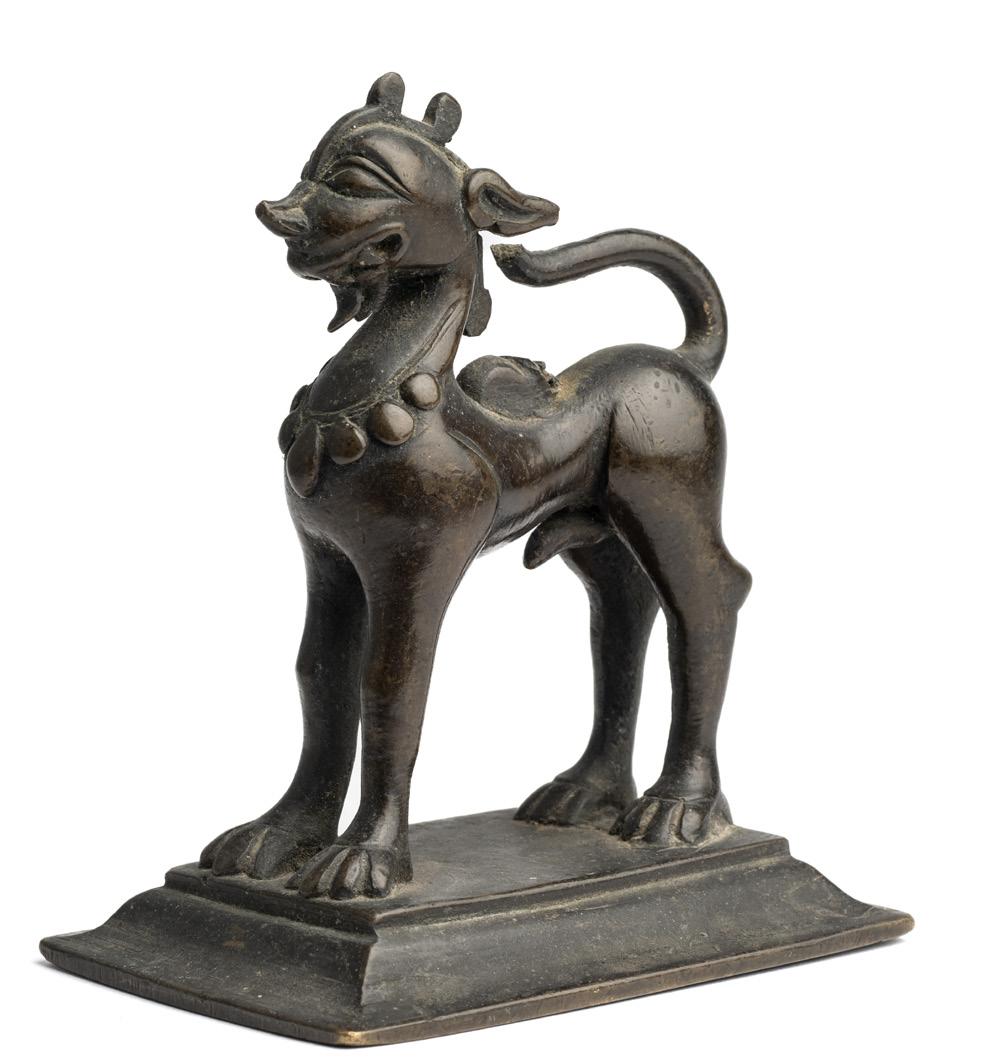
311.
FIVE SMALL BRONZE OBJECTS, NORTHERN INDIA, CIRCA 19TH CENTURY, comprising three temple oil lamps in the form of conch shells and two printing stamps for cotton textiles, 9cm and smaller

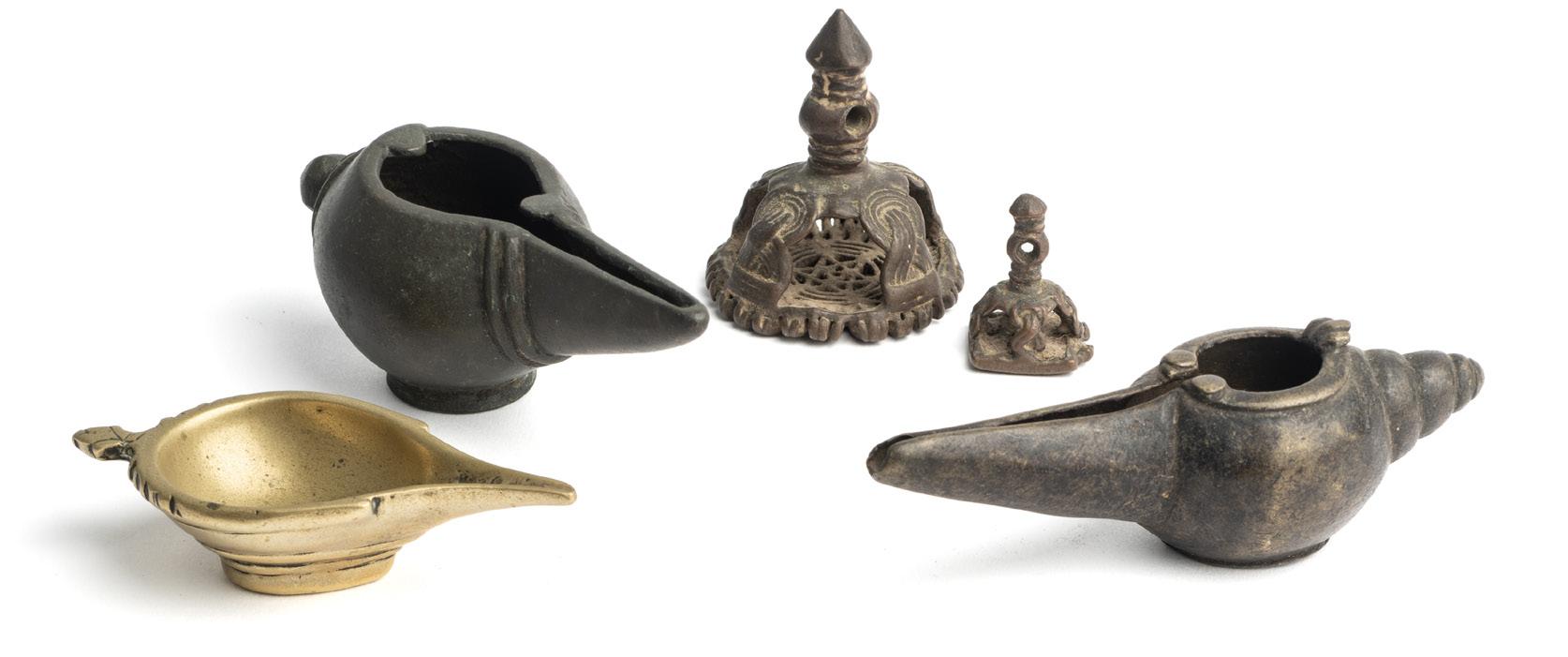
For a group of similar textile stamps, see Bussabarger and Robins, pp.86-87.
£60-80
312.
FOUR SIVALINGAMS, INDIA, 16TH-19TH CENTURIES, two of bronze with cobra canopy, one of bronze set with a stone lingam, the fourth of carved stone, 8.5cm and smaller £150-200
126
313.
A GROUP OF INDIAN METALWORK, MOSTLY LATE 19TH CENTURY, comprising a Kashmir enamelled copper jar and cover with associated tray, a large bronze basin, a pair of brass bracelets, a brass tribal torc, a brass rattle and the upper part of a lotiform offering tray, 45cm diam. of basin and smaller (8)
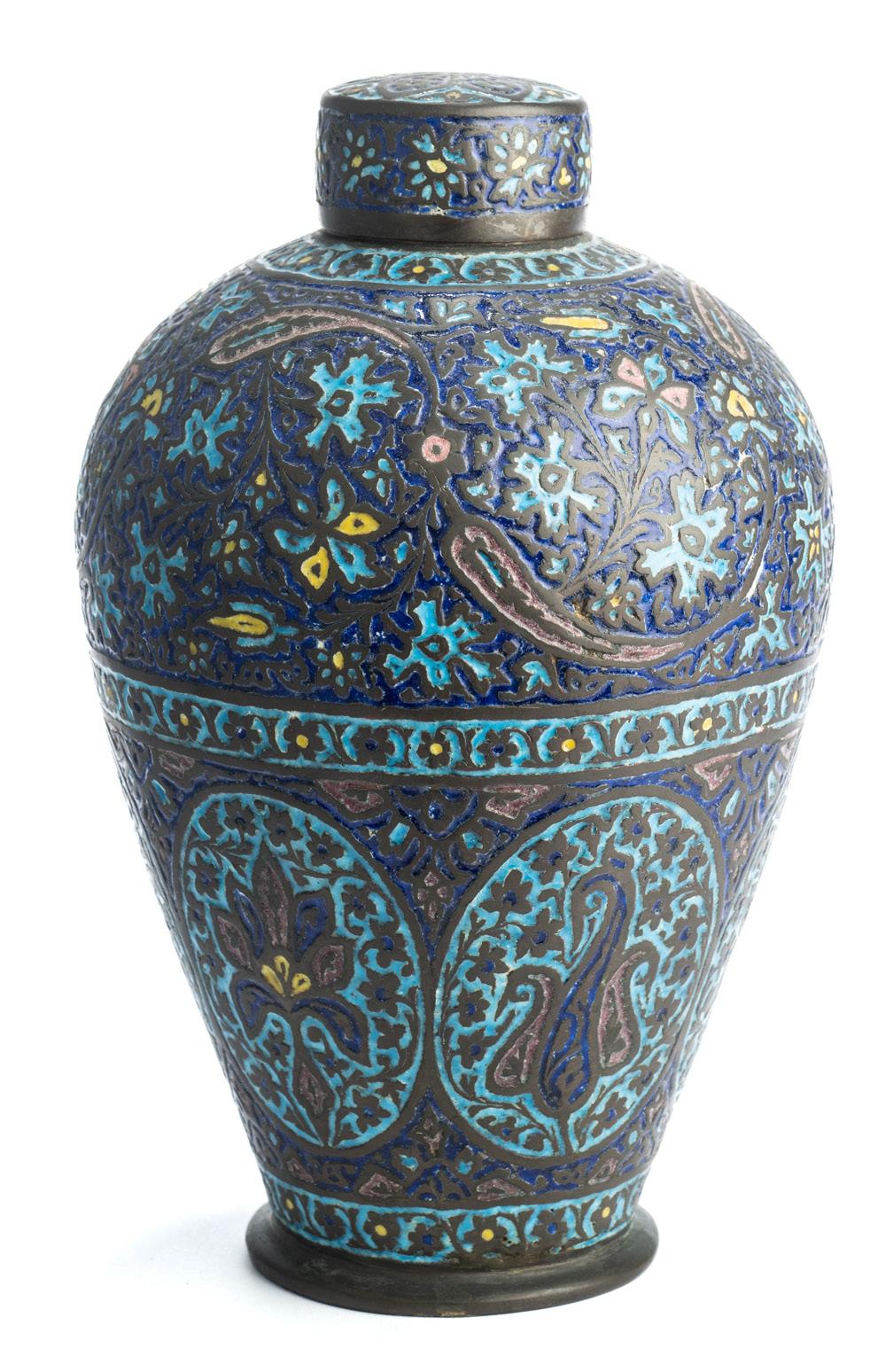
£120-150
part
314.
THREE SILVER BEAKERS, INDIA, CIRCA 1900, the largest South India, set with garnets, the applique decoration comprising intertwined cobras, Hindu deities and coins, the other two Bhuj, Cutch, with dense repousse foliate decoration, one with initialled shield motif and inscribed date '23rd September 1896', 15.5cm, 9cm, 8.8cm high
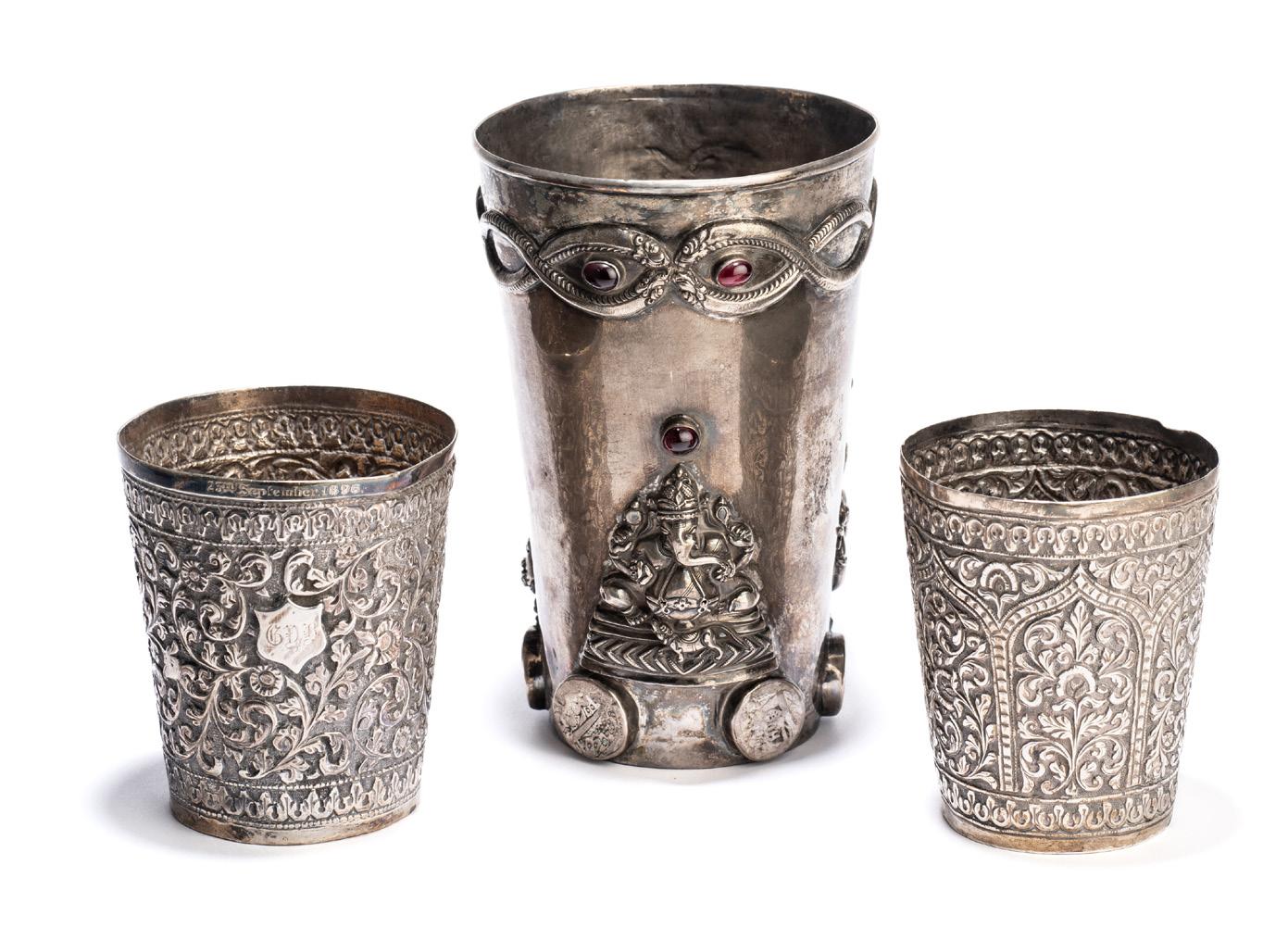
For similar Cutch beakers, see Wilkinson 1999, pl.159, p.95.
£200-300
127
315.
TWO BRONZE RITUAL OBJECTS, WESTERN DECCAN, INDIA, 18TH/19TH CENTURY, comprising a Saivite bracelet, fringed with pellet bells and heads of Siva, and a ritual pot with applique figures of devotees, a cobra and sun and moon emblems, 15cm (max. diam. bracelet), 10cm pot

For a related bracelet, see Jain and Aggarwala 1989, p.43, and pot, Aryan 2005, p.148, pl.277. £80-120
316.
A BRASS TEMPLE LAMP, DECCAN, SOUTHERN INDIA, 20TH CENTURY, the tall turned shaft on wide base, the reservoir with seven wick holders, surmounted by peacock finial, roughly engraved kannada inscription on the shaft, 67.5cm high £60-80

317.
THREE BRASS VESSELS, TANJORE (NOW THANJAVUR), SOUTH INDIA, CIRCA 1900, comprising a Gangajumna lota and two engraved and repousse bowls, each decorated with a series of medallions depicting Hindu deities, 18cm approx. each high £120-180

128
JAIPUR SCHOOL OF ART BRASS TRAY, RAJASTHAN, INDIA, LATE 19TH CENTURY, the repousse relief decoration comprising a central sun medallion depicting Hanuman riding in a chariot, surrounded by a circular border depicting signs of the zodiac, two further concentric bands containing medallions depicting animals, human figures and Hindu deities, 77cm diam.
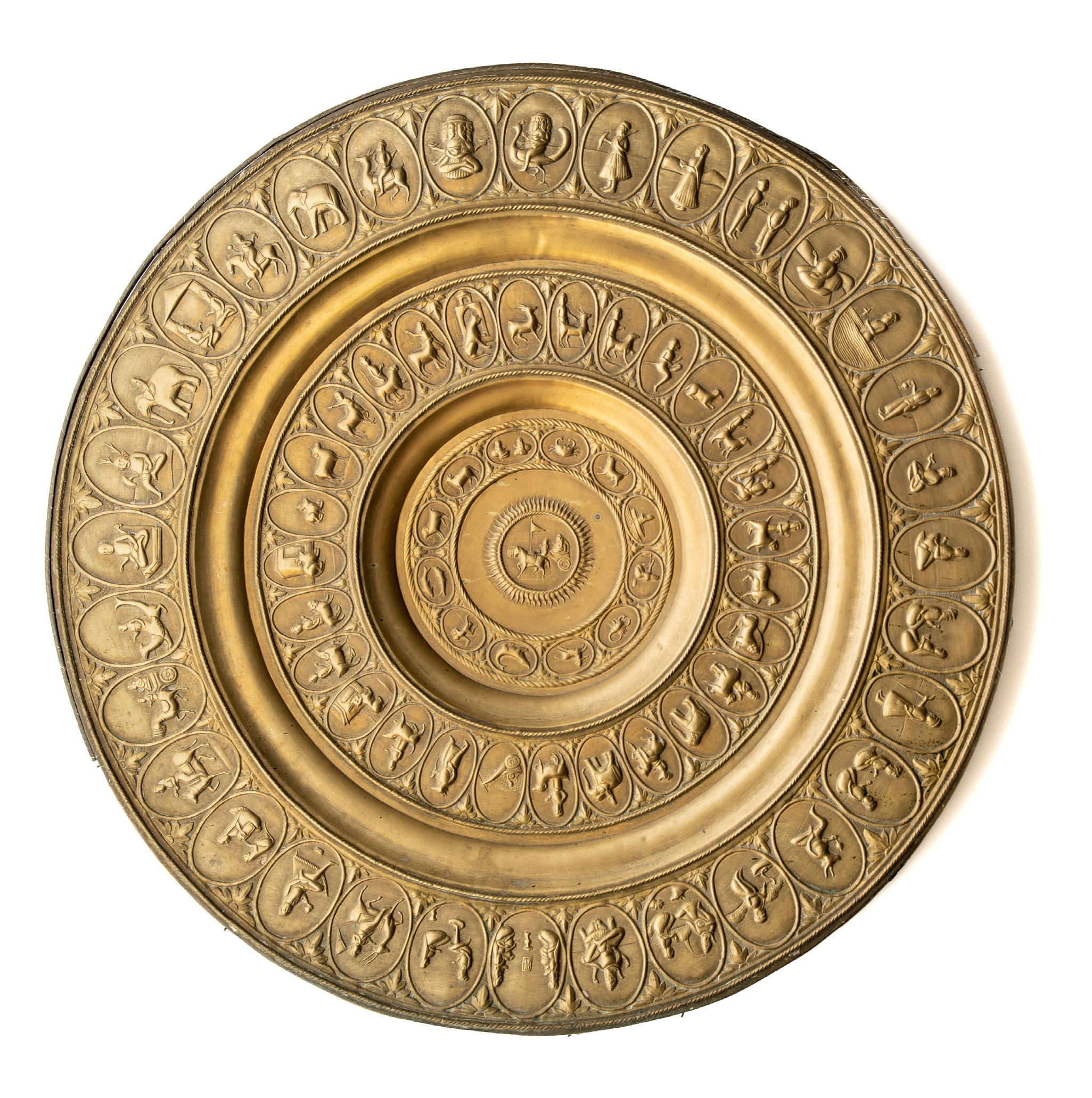
129 318. A
£200-300
319.
SIX BRASS LOTAS, INDIA, 19TH CENTURY, each of typical bulbous form, with waisted neck and overhanging rim, engraved decoration, one with 'gangajumna' copper inlay, the largest 19.5cm, the smallest 6.7cm high
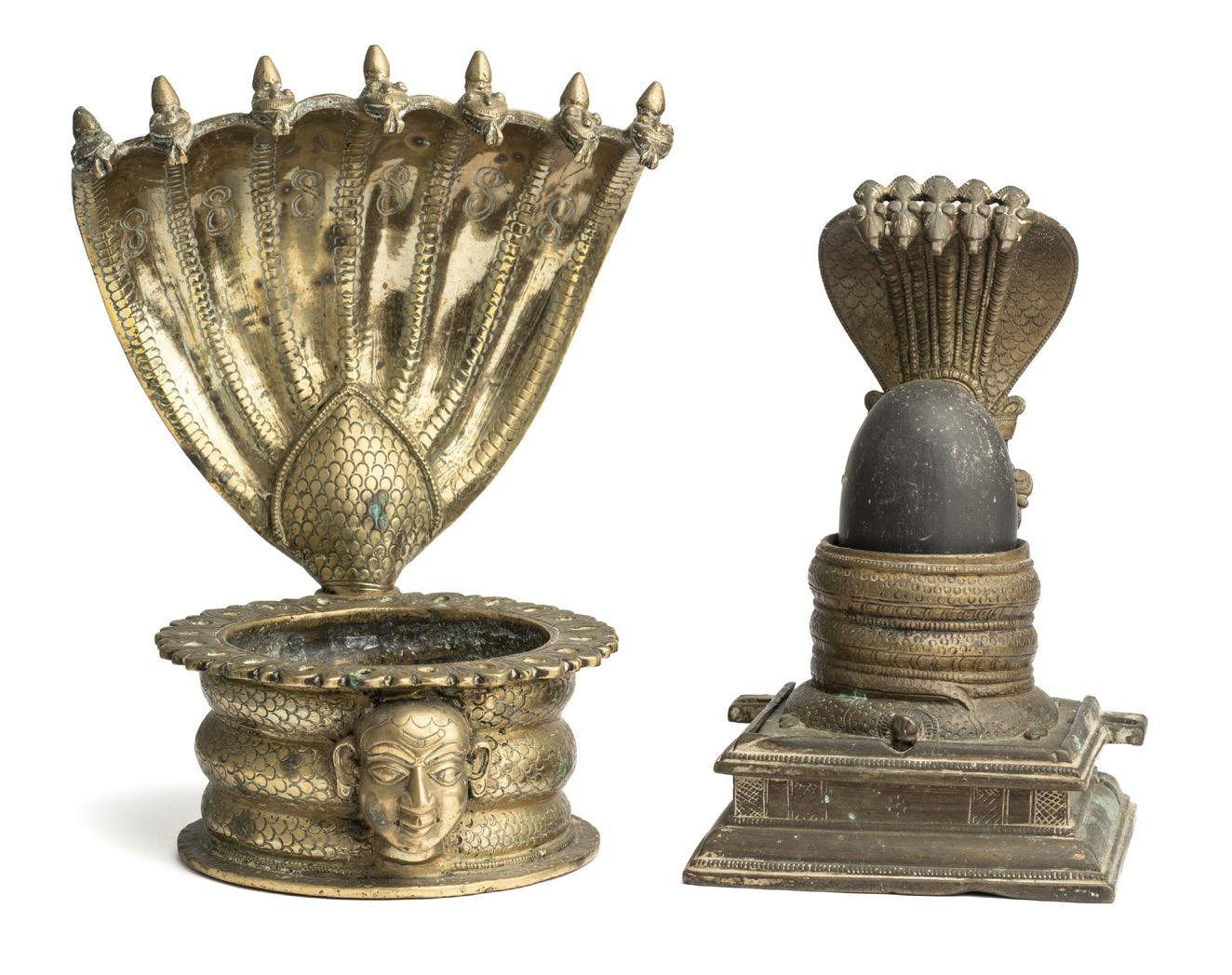

£200-300
320.
THREE BRASS OBJECTS, INDIA, 19TH CENTURY, comprising a Mughal style ewer and two huqqa bottles, the ewer with scrolling handle, domed hinged lid and straight faceted spout, the bottles of bulbous form on flared rim foot, 26.5cm (ewer), 25, 23.5cm (huqqas)
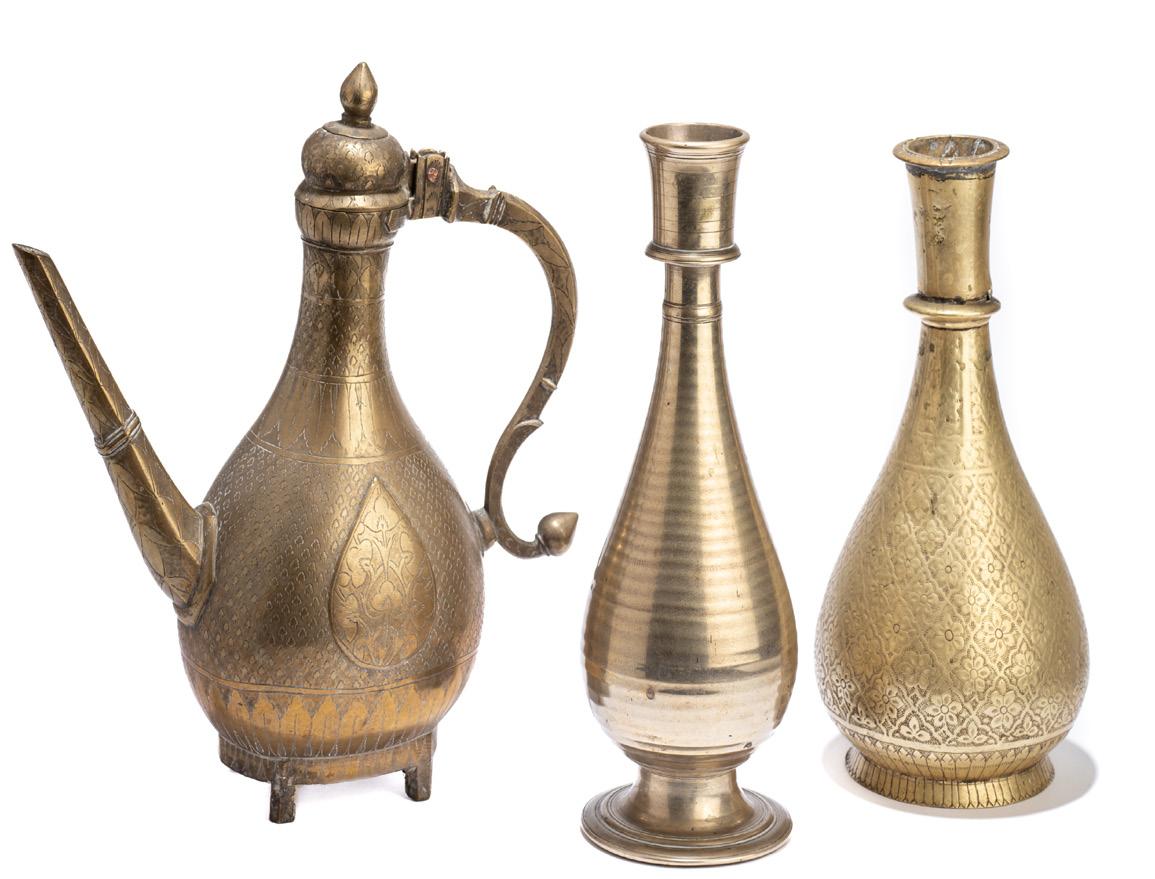
£150-200
321.
TWO BRASS LINGAM HOLDERS, DECCAN, INDIA, 18TH/19TH CENTURY, each in the form of a multi-headed cobra, the smaller on square plinth, the coiled cobra body resting on a turtle, set with associated lingam stone, the other with head of Siva at the front, 18cm, 21cm
£200-300
130
322.
TWO BRASS VESSELS IN THE FORM OF FISH, PROBABLY LUCKNOW, INDIA, 19TH CENTURY, comprising a spice box, the hinged lid with inner compartment, and a tinned brass hand-held huqqa bottle, 21cm, 23cm £120-180

323.
A TANJORE ‘SWAMY-WORK’ TRAY, SOUTH INDIA, LATE 19TH CENTURY, brass with repousse sheet copper and silver overlay, of circular form, the central medallion depicting the marriage of Minakshi and Sundareshvara, together with Two Smaller Circular Trays and a Sinhalese Octagonal Tray, 19th-20th centuries, in similar technique, 49cm diam. and smaller (4)
For a near-identical ‘swami-work’ tray, see Untracht 1993, p.63, no.115. £150-200

131
part
324.
ATTRIBUTED TO NEIL CORMACK, BRITISH (c.1793 - c.1853), ROHTASGARH, watercolour on paper, framed, 29.5 x 49.5cm

Rohtas fort, near Sasaram in the state of Bihar, is said to be one of the largest hill forts in the world with its circumference totalling 45km and it is spectacularly positioned on a plateau 1500 feet above the plain. Its ancient origins are not clear, but most of the constructions visible today date from the 16th century, when the Mughal Governor, Man Singh undertook various additions and improvements. It is only beginning to be visited today, because, until a few years ago, it was headquarters of the Naxalites, a Maoist guerilla group. The fort of the same name near Jhelum in Pakistan was built and named after this one by the Sultan Sher Shah Sur, who is buried in the famous tomb at Sasaram.
£400-600
132
TO NEIL CORMACK, BRITISH (c.1793 - c.1853), FORT ST. GEORGE, MADRAS (NOW CHENNAI), watercolour on paper, framed, 29 x 46cm
The original heart of Madras can be seen in the background of this view which probably dates from around 1830.

the right is the Bay of Bengal and in the foreground
Triplicane (now Cooum) River.
133 325. ATTRIBUTED
On
the
£700-900
326.
~ A PAIR OF PORTRAITS OF SHAH JAHAN AND MUMTAZ MAHAL, DELHI, LATE 19TH CENTURY, gouache with gold on ivory, in carved ebony frames, hinged brass supports at the back, 6 x 4.5cm (paintings), 16 x 10.5 x 11cm (frames)

£120-180
327.
THOMAS DANIELL (1749-1840), VIEW ON THE CHITPORE ROAD, CALCUTTA, hand coloured aquatint from 'Oriental Scenery', engraved by Thomas and William Daniell, published by Thomas Daniell, August 1797, framed, 42.5 x 60cm (image)

Thomas Daniell wrote of this scene: 'In this view on the Chitpore road (taken in the Monsoon season) appears the house of a native Bengal merchant: the style of architecture is Mohommedan, except in the turret, which is an unsuccessful attempt at the Grecian...Part of a Bazar, or market, is seen, and a small Hindoo temple of modern construction' (Archer 1980, p.96)
£300-500
134
328.


135
EDWARD
ORME (PUBLISHER, 1775-1848),
TWO
INDIAN VIEWS,
hand
coloured aquatints,
comprising 'A View of Part of St. Thome Street, Fort
St.
George', Colonel Francis Swain Ward, and ‘Fortress of Gwalior taken by General Popham in 1780', both published 1804, framed, 30 x 43cm (each, image) £200-300
329.
THOMAS AND WILLIAM DANIELL (1749-1840, 1769-1837), TWO VIEWS FROM 'ORIENTAL SCENERY', hand coloured aquatints, comprising 'View from the Ruins of Currah [Kara], on the River Ganges', drawn and engraved by Thomas and William Daniell, published by Thomas Daniell 1803, and 'N.W. View of Rotas Ghur [Rohtasgarh], Bahar, drawn and engraved by Thomas Daniell, published by Robert Bowyer, 1796, both framed, 42.5 x 60cm (image)
The Daniells visited Kara in October 1789. See Archer 1980, no.63. For a discussion of this view of Rohtas, along with two others in the fort produced by the Daniells following their visit in 1790, see Archer 1980, nos. 81-83. For a watercolour of this fort attributed to Neil Cormack in this sale, see lot 324. £800-1200


136
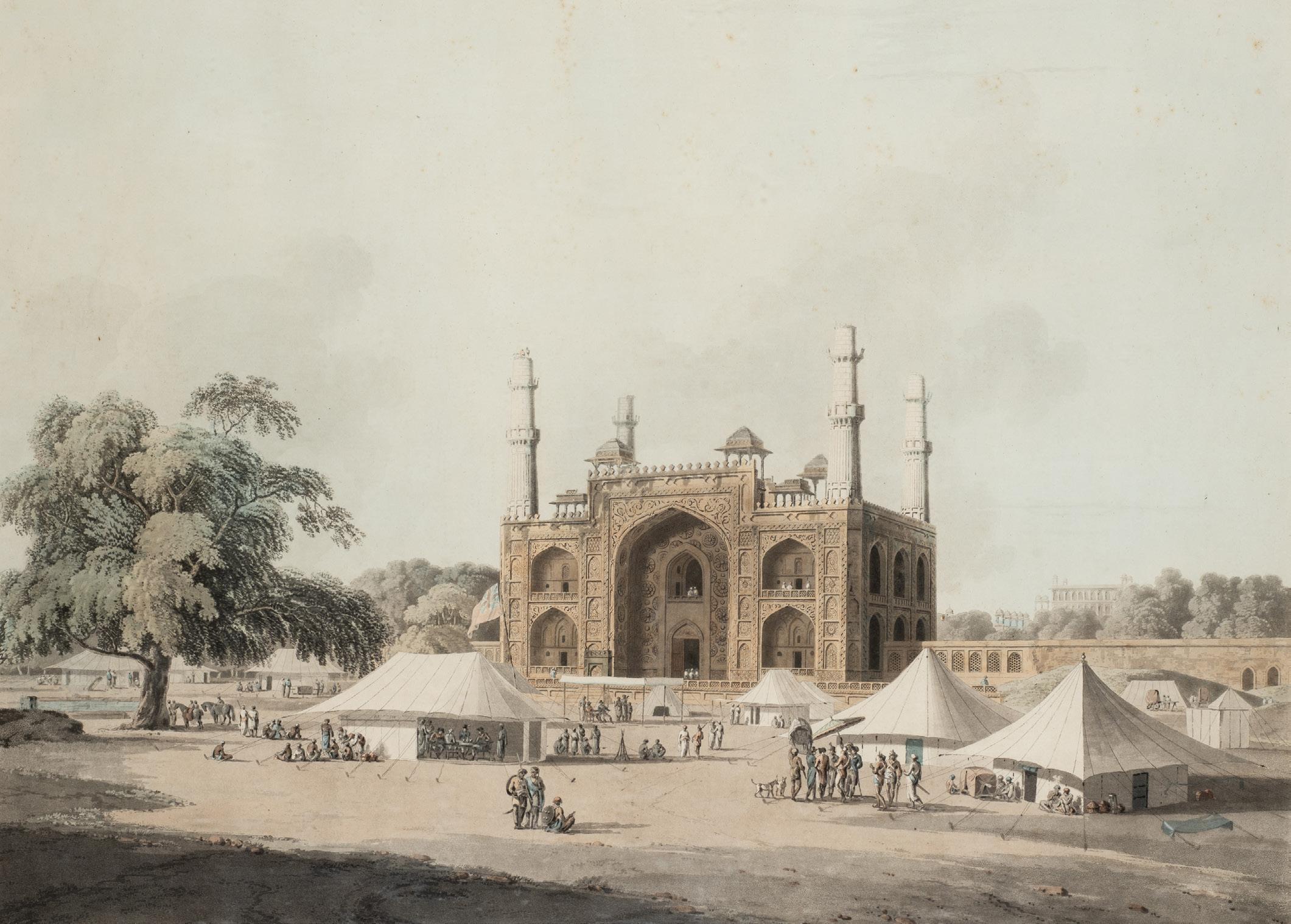
137 330. THOMAS DANIELL (1749-1840), GATE OF THE TOMB OF THE EMPEROR AKBAR, AT SECUNDRA [SIKANDRA], NEAR AGRA, hand coloured aquatint from 'Oriental Scenery', engraved by Thomas Daniell, published by Robert Bowyer, November 1795, framed, 43 x 60cm (image) The Daniells visited Sikandra in January 1789. This scene shows the encampment of a large party which the artists had joined on the trip to Agra. See Archer 1980, no.30 & pl.V £400-600
Scenery', drawn and engraved by Thomas and William Daniell, published by Thomas Daniell, January 1804, framed, 42 x 59.5cm (image)
The artists visited these falls in Tamil Nadu in August 1792 and reported how the spectacular site was much visited by pilgrims and fish were abundant. Mildred Archer notes how much the scene had changed in the 20th century, with a hydro-electric scheme reducing the water flow to a trickle and few pilgrims visiting (Archer 1980, no.122 & pl.XXVI).
£400-600
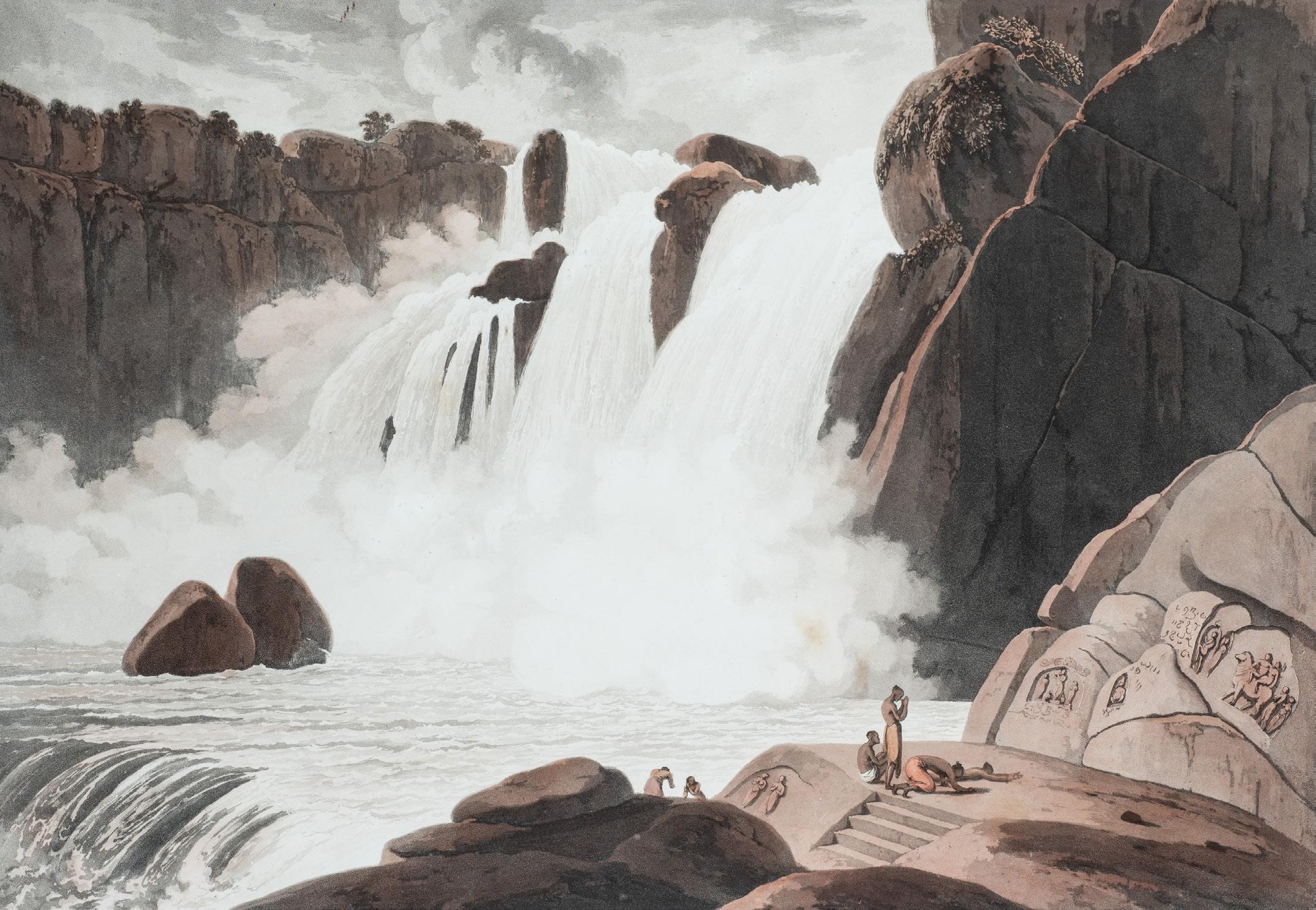
138 331. THOMAS
AND WILLIAM DANIELL (1749-1840, 1769-1837), THE WATER-FALL AT PUPPANASSUM IN THE TINNEVELLY DISTRICT, hand coloured aquatint from
'Oriental
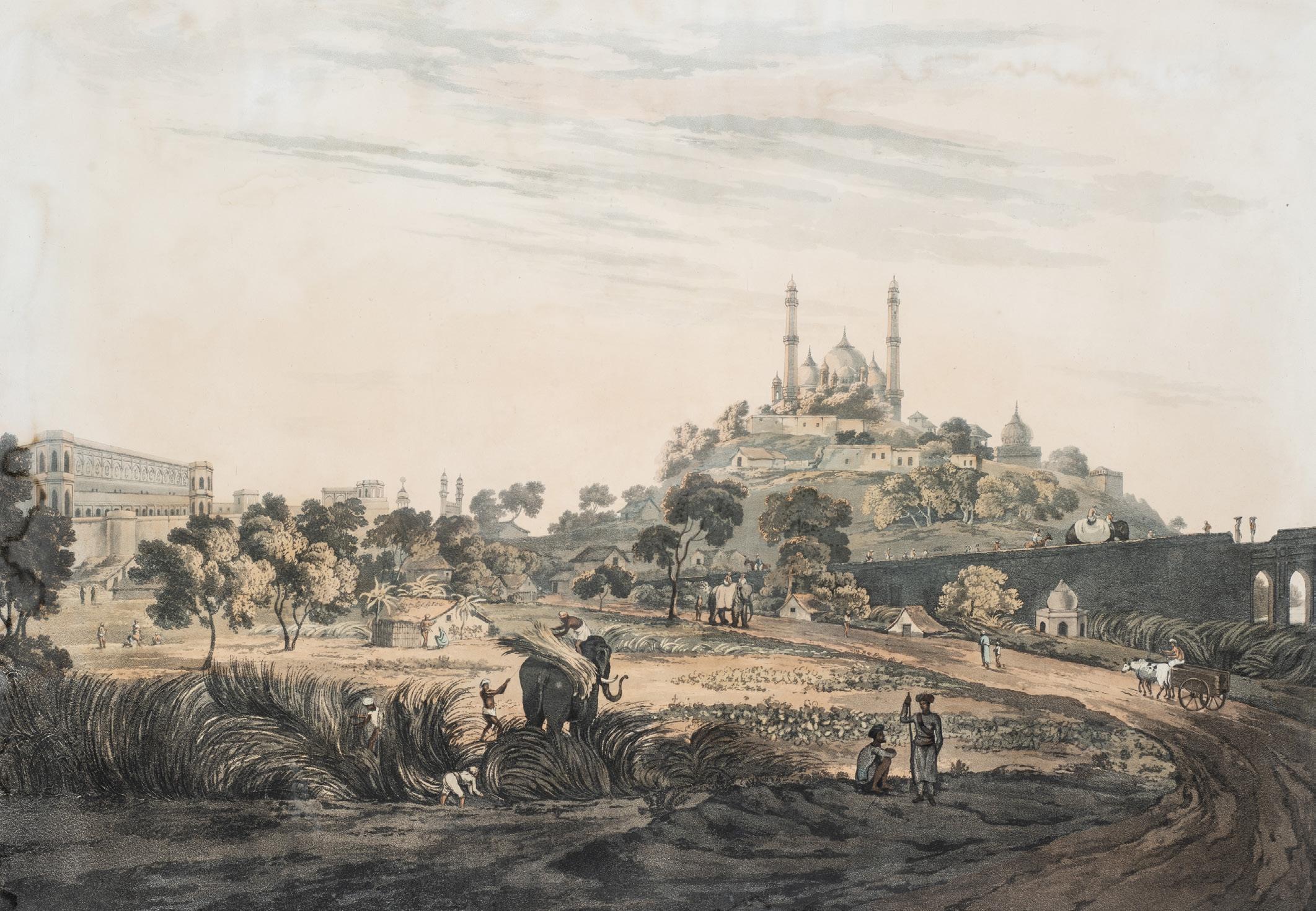
139 332. HENRY SALT (1780-1827), A VIEW AT LUCKNOW, hand-coloured aquatint, engraved by D. Havell, published by William Miller, May 1809, framed, 41.5 x 60cm (image) £300-400
part
333.
ATTRIBUTED TO THOMAS DANIELL (1749-1840), FOUR SKETCHES OF INDIAN RIVER VIEWS, pencil and ink with watercolour on paper, laid on paper mount, framed as a group, one inscribed with comments by the artist, 11.5 x 9.5cm; 15.5 x 10.3cm; 16.5 x 10.5cm; 6 x 11cm
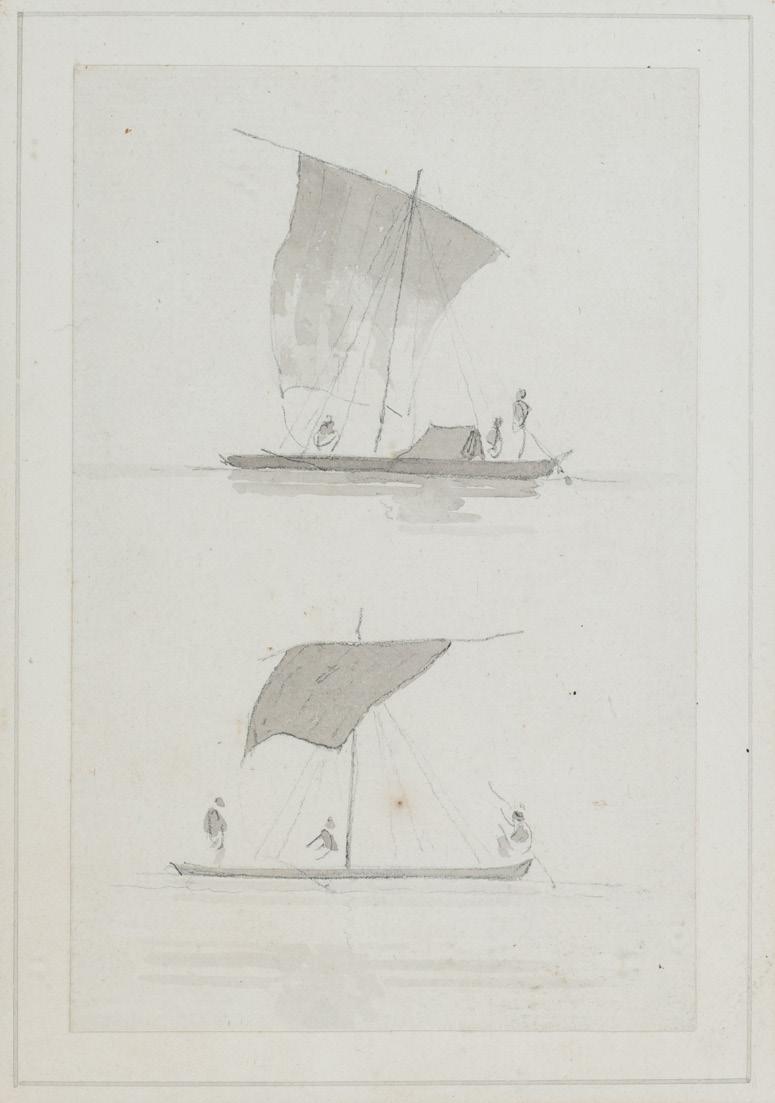

Provenance: According to pencil inscriptions on the back, Sotheby's, lot 55, 9th May 1962. £600-800
334.
TWO COMPANY SCHOOL PAINTINGS OF TRADESMEN, PUNJAB, INDIA, MID-19TH CENTURY, gouache on paper, one depicting an embroiderer, inscribed with a line of nastaliq script, the other depicting cooks preparing food, framed together, 16 x 14cm approx. each (inside mount)
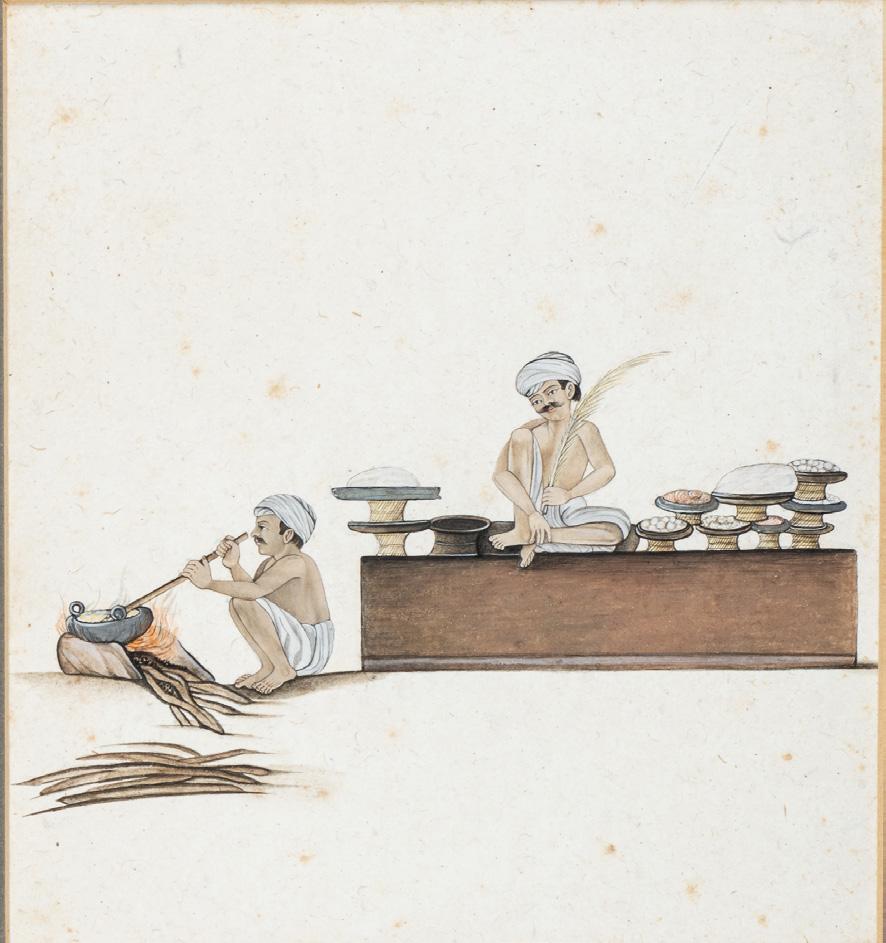
£200-300
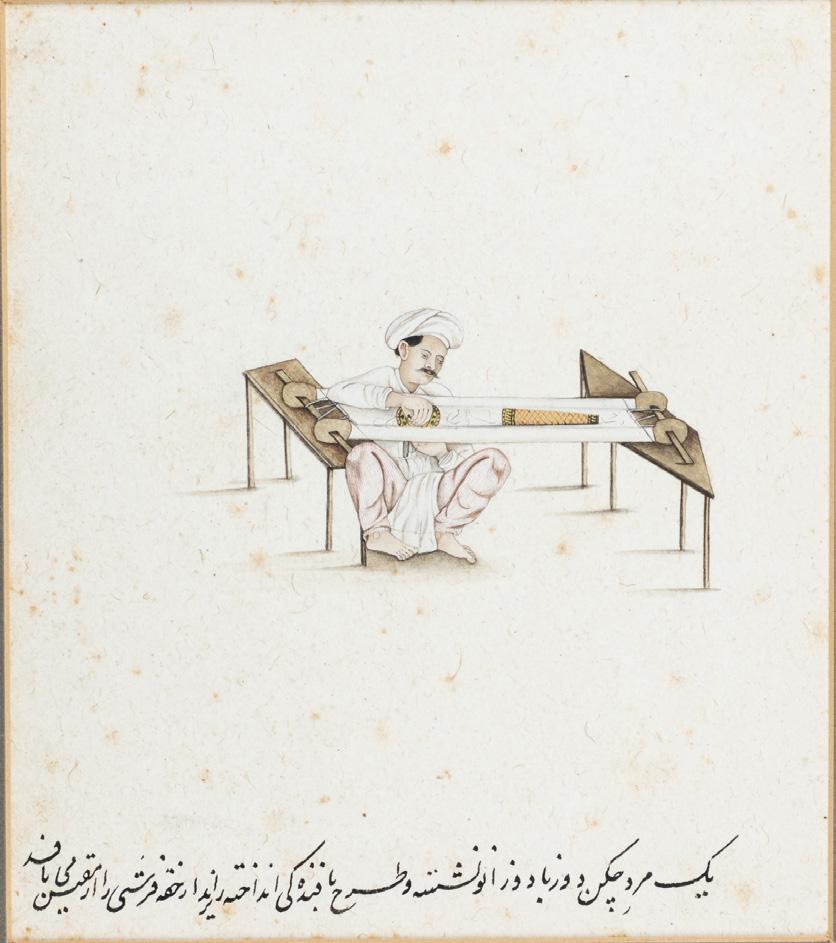
140
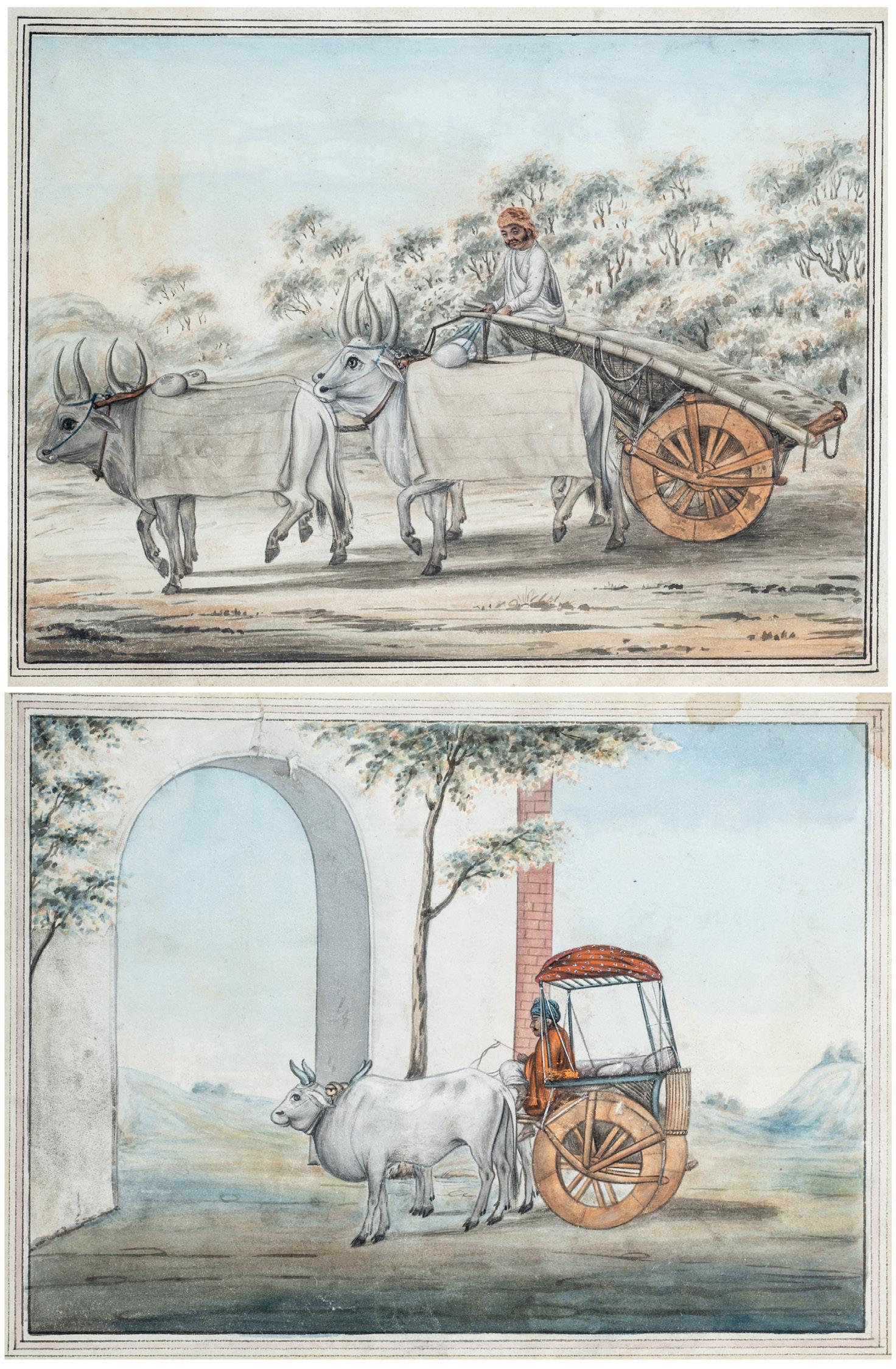
141 335. TWO SCENES DEPICTING OX-CARTS, COMPANY SCHOOL, PATNA, INDIA, MID19TH CENTURY, watercolour on paper, framed, 12.5 x 17cm approx. each £300-400
336.
THREE INDIAN CHARACTERS, COMPANY SCHOOL, PATNA, INDIA, MID-19TH CENTURY, gouache on paper, depicting an elderly woman making a pious offering, a water-seller and a merchant(?), framed, 10.5 x 8.7cm, 15 x 14.5cm, 15 x 14.5cm (inside mount)


£300-400
337.
OSWALD COULDREY, BRITISH (1882-1958), 'PARROTS AND PHARISEES, MADURA', watercolour on paper, framed, initialled and dated 25 08 16, 36 x 24.5cm
Born in Abingdon, Oxon, Couldrey joined the Indian Education Service and lived in India between 1909-1919, the last eight years as Principal of the Rajamundry College of Art in Madras Presidency (now Andhra Pradesh). He taught several well known Telugu artists and poets and wrote many books, mostly of poetry.
£200-300
338.
ROBERT TALBOT KELLY, BRITISH, (1861-1934), 'EN PROMENADE', watercolour on paper, signed lower left, framed, 29 x 20cm inside mount
This painting is reproduced in Talbot Kelly's book, 'Burma, Painted and Described', Adam and Charles Black, London, 1905, opposite p.168.
£120-180

142
339.
G VENKATESH RAO, INDIAN, A TIGER, DATED

1913, oil on canvas, signed and dated lower right, framed
Venkatesh Rao is best known for his depictions of Hindu deities, published as oleographs by the Ravi Varma Press. In 1922, he presented a portrait of King George V to the Prince of Wales and this is now in the Royal Collection (RCIN 406686).
£100-150
340.
A. KAMADOLI, INDIAN, FIRST HALF 20TH CENTURY, 'A WOODLAND GIRL', oil on canvas, signed lower right, label on the reverse reading: 'Artist: A Kamadoli, Address: School of Art, Bombay, Title: A Woodland Girl, [..] Oil Colour, For Sale: Rs. Seventy-Five Only Rs 75/-/-', 56.5 x 41.5cm
£100-150
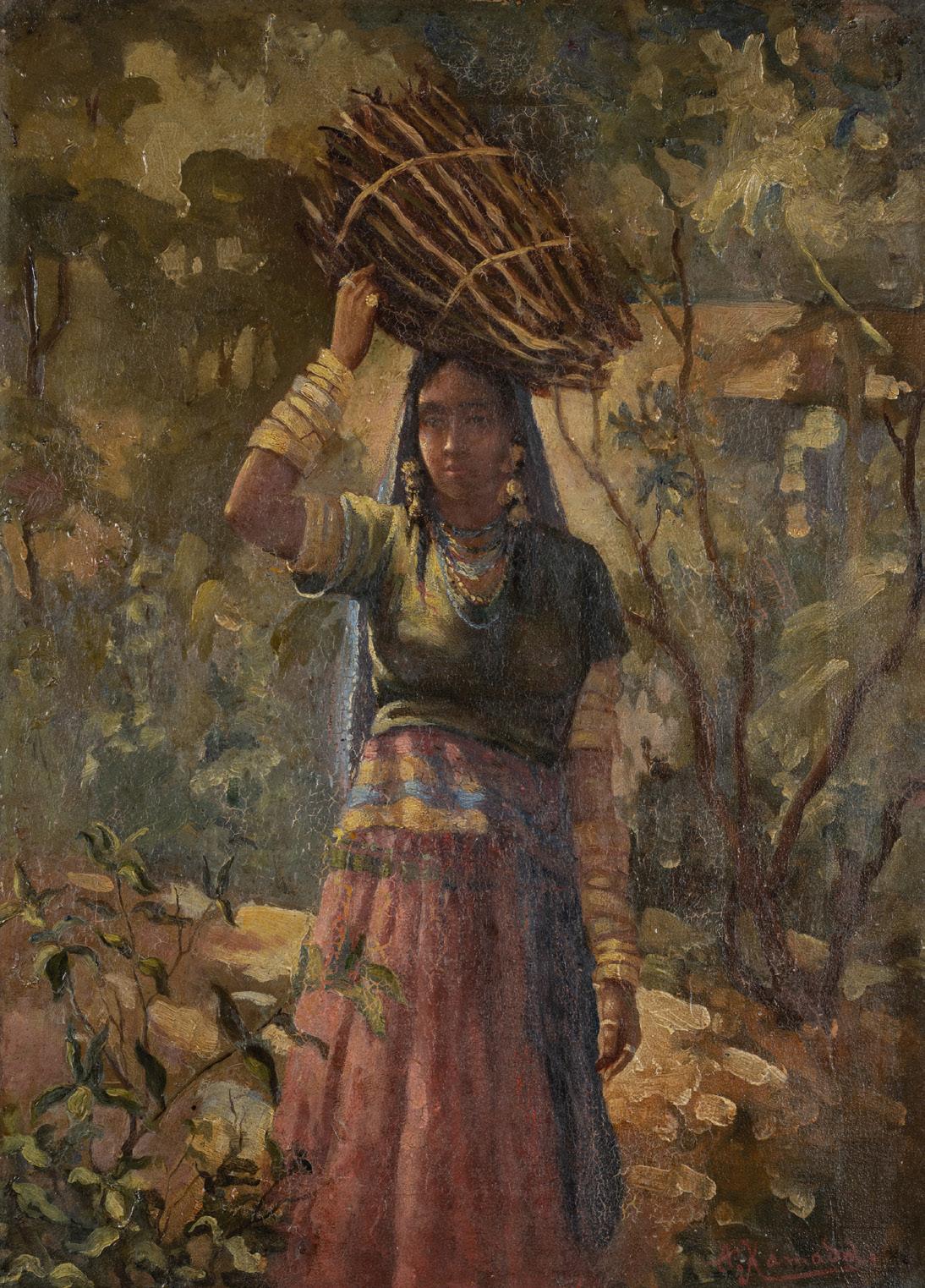
143
x
paper, both
x
Monwar
of
in Bangladesh. He was born in Jessore in Bengal Presidency, British India, and trained
Government College of Art and Craft in Calcutta. As well as painting, he is known as a teacher, writer and broadcaster. He is particularly celebrated for his puppet shows which he devised
refugee camps during the war of
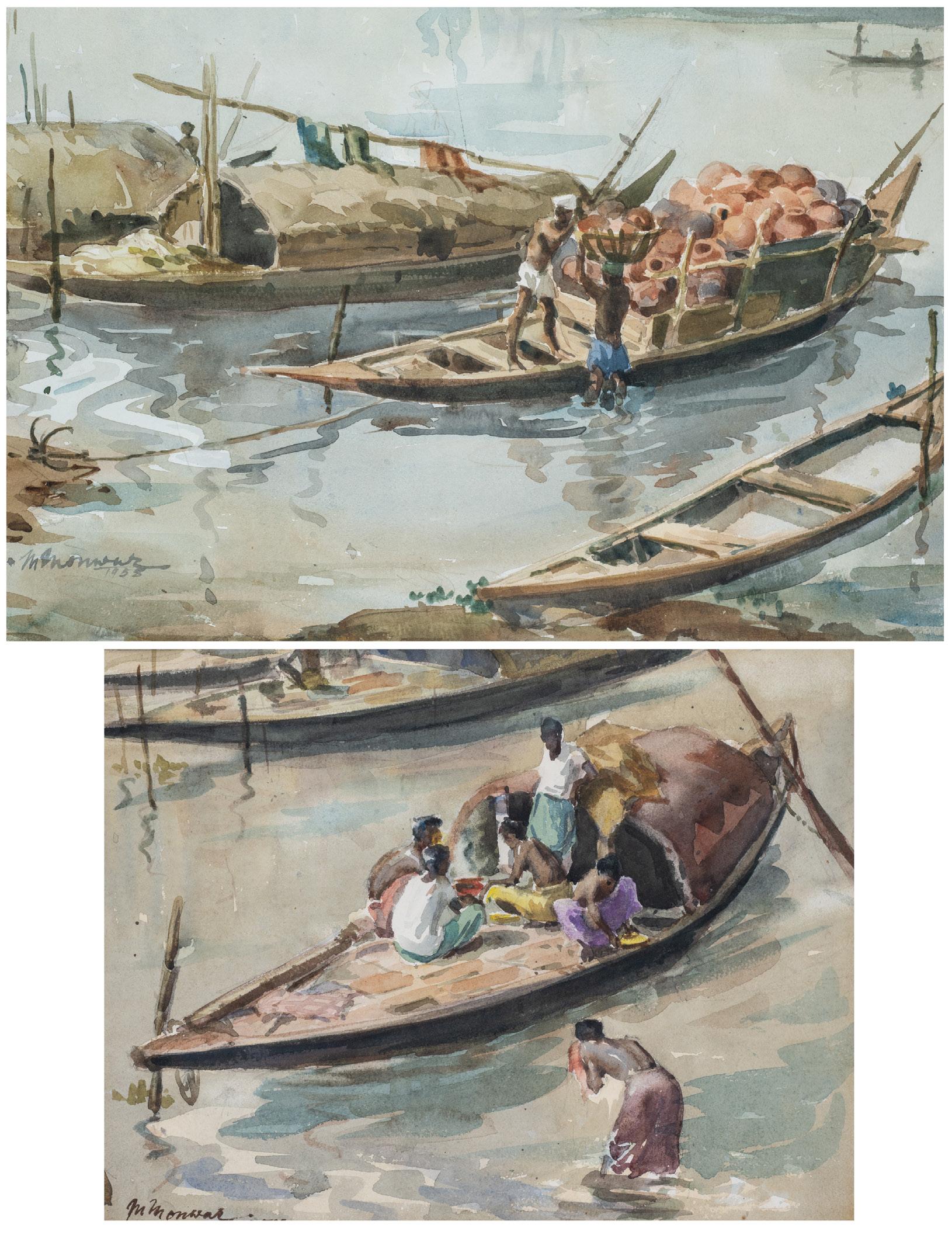
144 341. MUSTAFA MONWAR, BANGLADESHI, b.1935, TWO RIVER SCENES, watercolour on
signed and dated lower left, the larger 1955, the smaller 1957, framed, 34
49.5cm, 25.5
33.5cm (2) Mustafa
is one
the best known figures in the arts
at the
in the
independence. £200-300
SCHOOL, EARLY 20TH CENTURY,
SCENES OF INDIAN MARKETS, comprising one oil on canvas, inscribed 'Baroda Brass Shops' and signed 'E.Geo. Turnbull[?], and three watercolours, one unmarked, another initialled 'G.E.', the third inscribed 'The Golden Mosque, Chandnee Chowk, Delhi, F.S.Hallows, 1917, framed, 37 x 31cm inside mount, and smaller

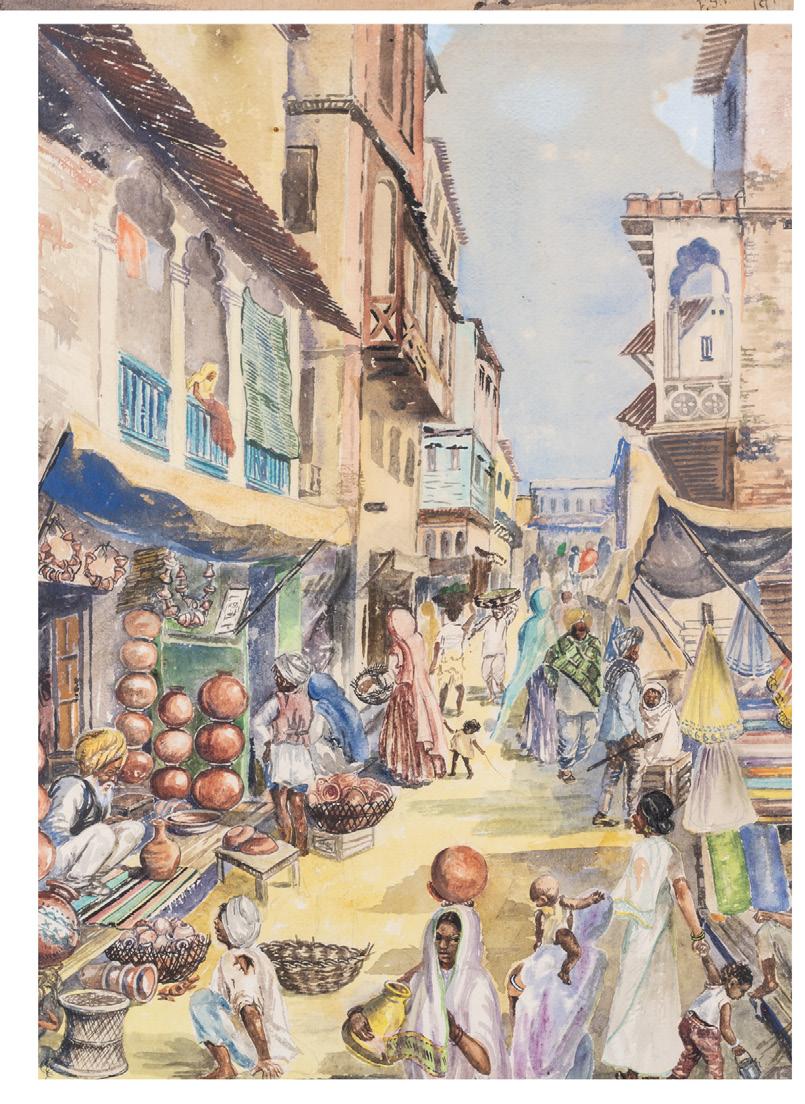


145 342. ANGLO-INDIAN
FOUR
£120-180
343.
SIX INDIAN AND BURMESE SCENES, MOSTLY MID-20TH CENTURY, watercolour on paper, comprising a Tamil gopuram, signed 'M. S. Chandrasekhar 1954', studies of four women, a South Indian woman, a South Indian temple scene, indistinctly signed, a desert scene, initialled R.L., and the entrance to a Burmese pagoda, framed, 36 x 25.5cm and smaller (6)
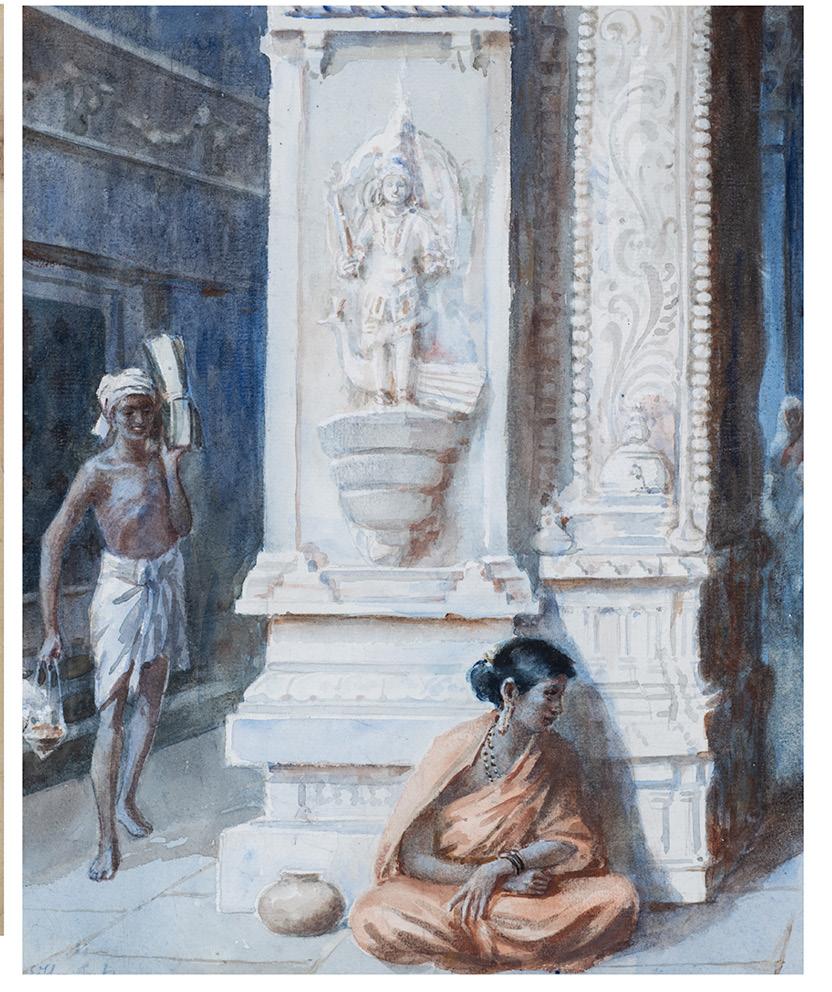


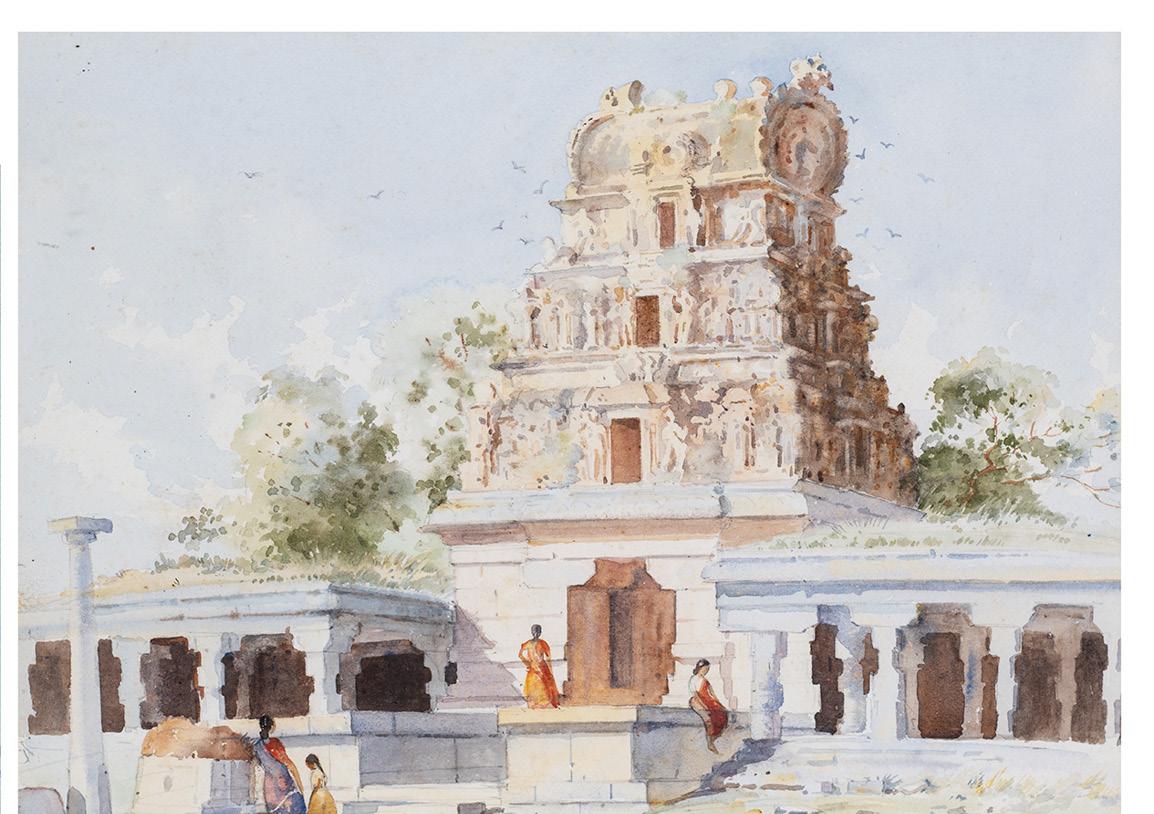


146
£150-250
344.
SEVEN PORCELAIN FIGURES OF DEITIES, PROBABLY GERMANY FOR THE INDIAN MARKET, 20TH CENTURY, the three larger overglaze painted, depicting Durga, Saraswati and Christ, the Good Shepherd, the other four painted directly on the ceramic, two depicting Krishna and two depicting Durga, 22.5cm high and smaller
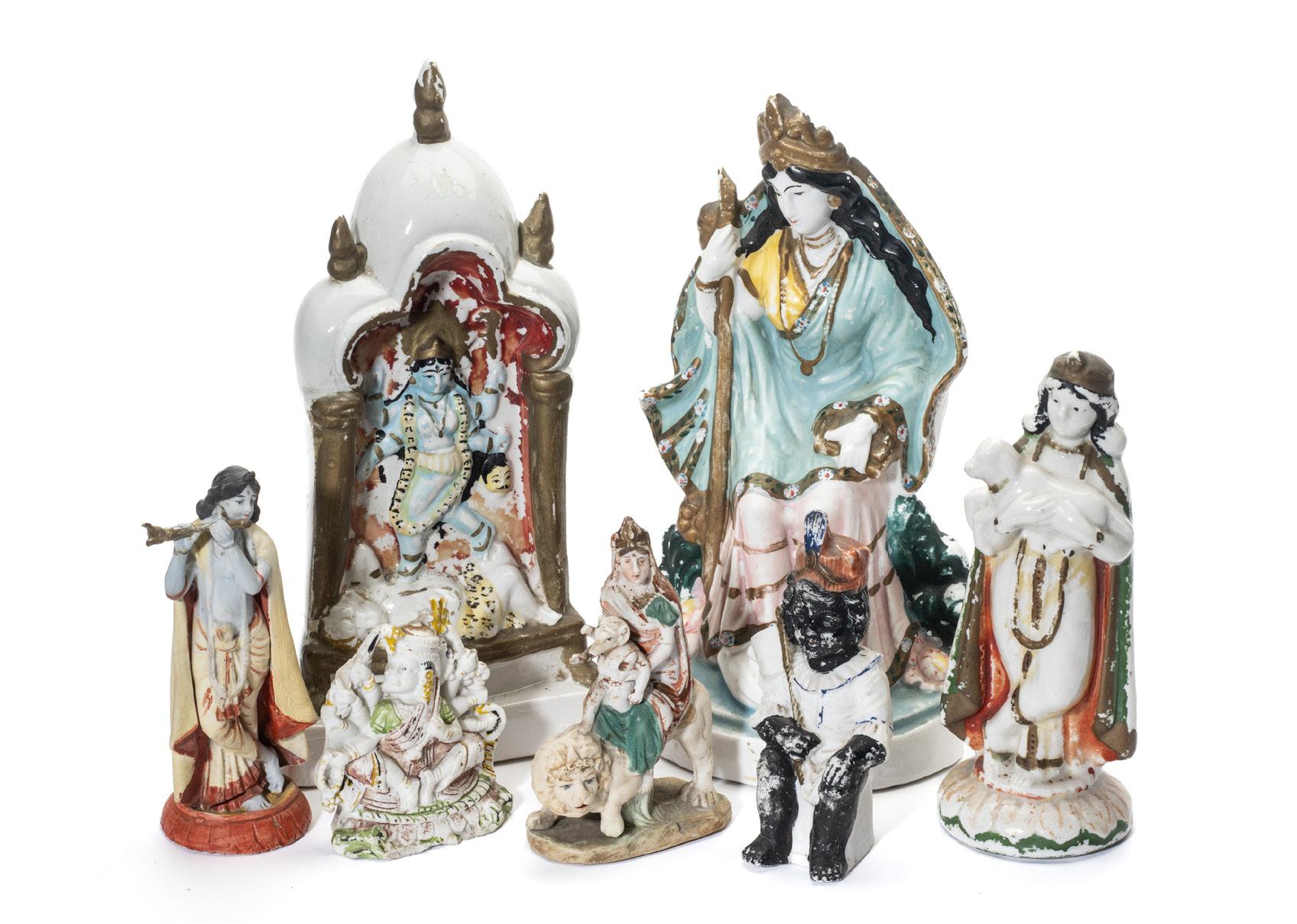
£120-180
345.
TWO PAINTED CLAY FIGURES OF SUBHADRA, PURI, ORISSA, 19TH/20TH CENTURY, each with prominent eyes and stylised features and stump like arms, 14.5, 12cm high Subhadra is the sister of Jagannatha and Balabhadra and the three deities are worshipped as a trio, depicted with large round eyes and often handless arms. Jagannatha is associated with Krishna and the cult at his temple in Puri is an example of the ability of Hinduism to absorb popular local cults into the mainstream. It is likely that the association of Jagannath with Vaishnavism occurred after the cult was well established, and simple village origins in the form of painted and roughly carved wood images may explain the truncated arms. Figures like this along with paintings were produced as mementoes for pilgrims visiting the famous temple in the seaside town, built in the 12th century by Anantavarman Codagangadeva.
£70-90
346.
TWO PORCELAIN FIGURES DEPICTING SIVA AND GANESHA, PROBABLY GERMANY FOR THE INDIAN MARKET, EARLY 20TH CENTURY, each seated on a chamfered rectangular base, buff glaze, imitating ivory, with brown painted details, embossed factory marks underneath, 9cm, 8.5cm

£70-90
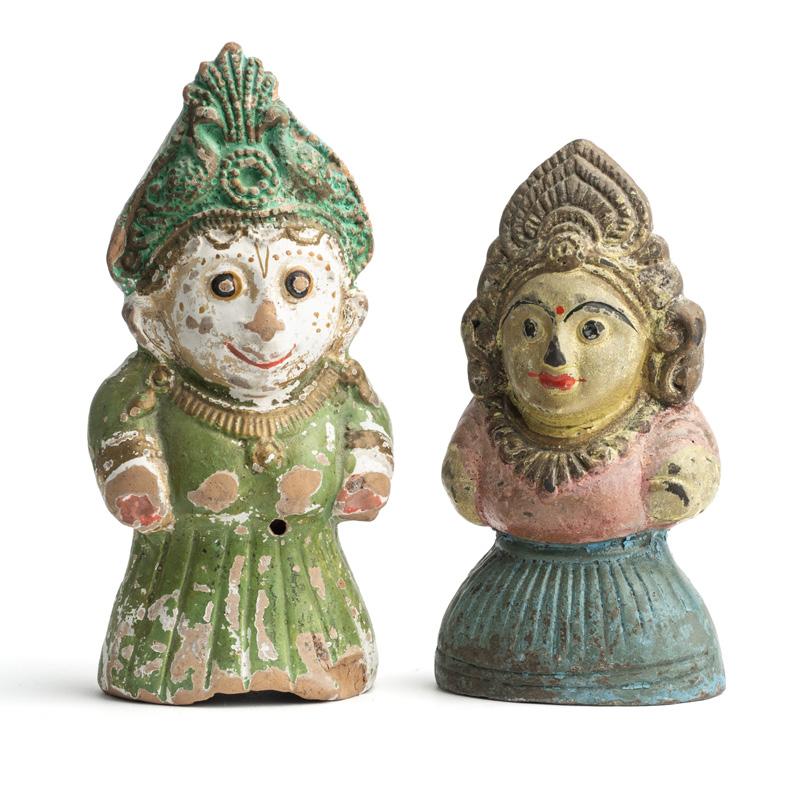
147
347.
TWO CARVED WOOD FIGURES, INDIA, 19TH CENTURY, one depicting a mother with two children with traces of polychrome, the other depicting Siva and Parvati riding on Nandi, accompanied by a rishi and attendants, 21, 19cm
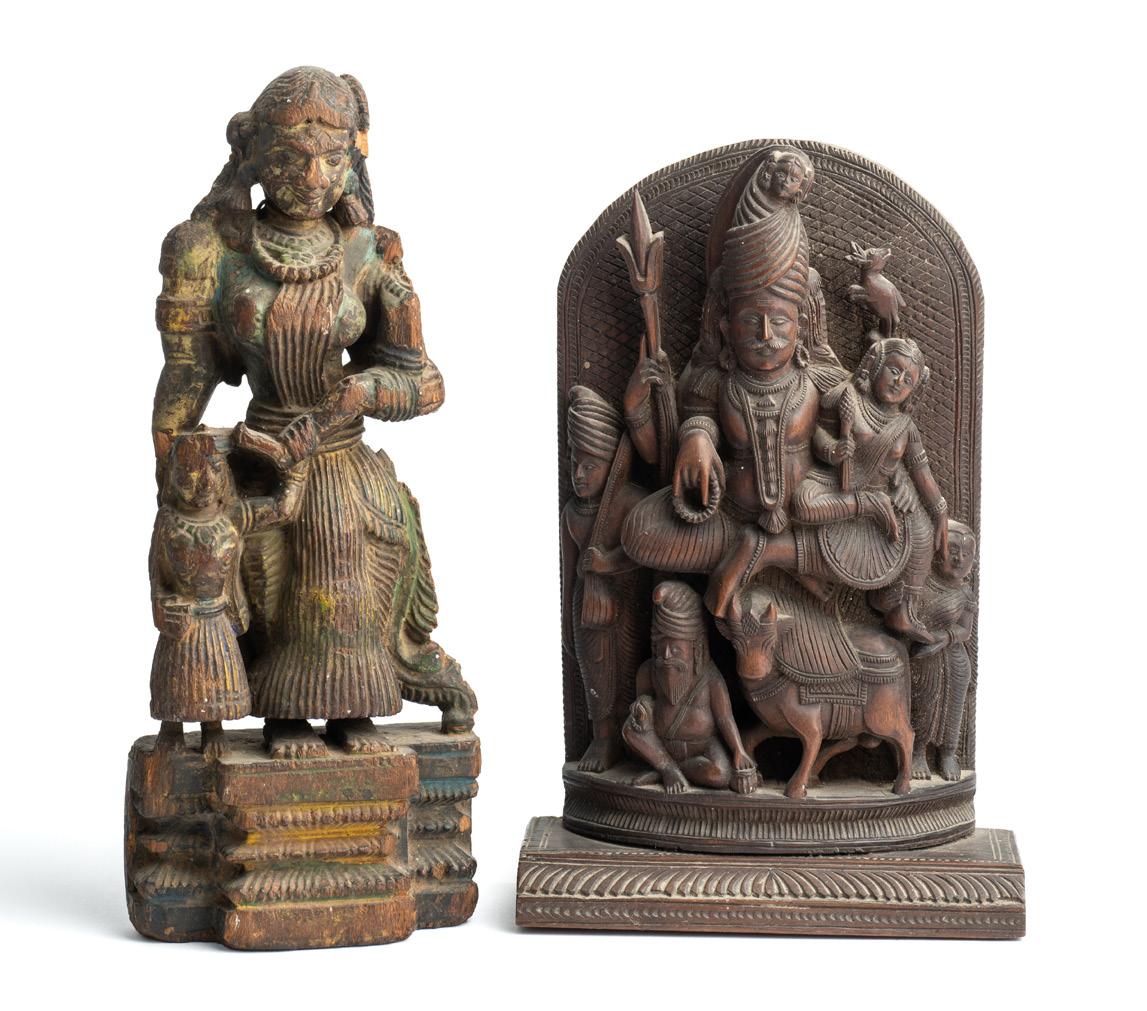
£100-150
348.
A SANDALWOOD WORKBOX, MYSORE REGION, DECCAN, INDIA, LATE 19TH CENTURY, on claw feet, the lid and sides profusely carved with animals and deities amongst scrolling foliage, the interior with removable tray with lidded compartments, 15 x 28 x 19.5cm

£250-350
349.
A COTTON AND SILK POLYCHROME APPLIQUE ENTRANCE HANGING (TORANA), GUJARAT, WESTERN INDIA, 20TH CENTURY, of horizontal rectangular form, depicting a lingam flanked by a pair of Nandi figures, with scrolling floral forms and a makara at either end, fringed along the bottom with tapered tassels, 62 x 224cm approx.
£80-120

148
detail
350.
A FRAGMENTARY BLACK STONE FIGURE OF KRISHNA, BENGAL, 19TH CENTURY, polychrome and gold painted, the youthful deity wearing billowing scarf and disc earrings, 15.7cm high £60-80

351.
FOUR IMAGES OF GANESHA, INDIA, 19TH-20TH CENTURIES, each depicting the four armed, elephant headed god seated in lalitsana, the largest carved in pink alabaster, another in grey stone, the third carved in marble with painted details, the fourth of painted terracotta, 16.3cm and smaller £100-150

149
352.
A BOMBAY SCHOOL OF ART CHARGER, INDIA, CIRCA 1890, slip painted earthenware, the central scene depicting Dushyant and Shakuntala with caption in devanagari script below, surrounded by a scrolling border of foliage and mythical beasts with kirtimukha at the top and a pair of geese at the bottom, devanagari maker's marks, 'Sri C.R.' on the reverse along with three old labels, foot pierced for hanging, 45.5cm diam.
The labels read: 'From Col. Lindsay RE [Royal Engineers] Sale at Queens Gate. Aug 1898'; 'Bought from R.G.Vivian's Sale, Sketty Hall, Swansea 1937, by M. J. Williamson'. A third, fragmentary label seems to be a price in rupees.

150
£300-400
353.
A BOMBAY SCHOOL OF ART VASE ON STAND, INDIA, LATE 19TH CENTURY, turquoise glazed earthenware, underglaze painted with stylised foliate designs in manganese, the shoulder with four loop handles surmounted by flared neck, the ring stand on four lion feet, the underside with devanagari and arabic initials, 50.5cm high £250-350
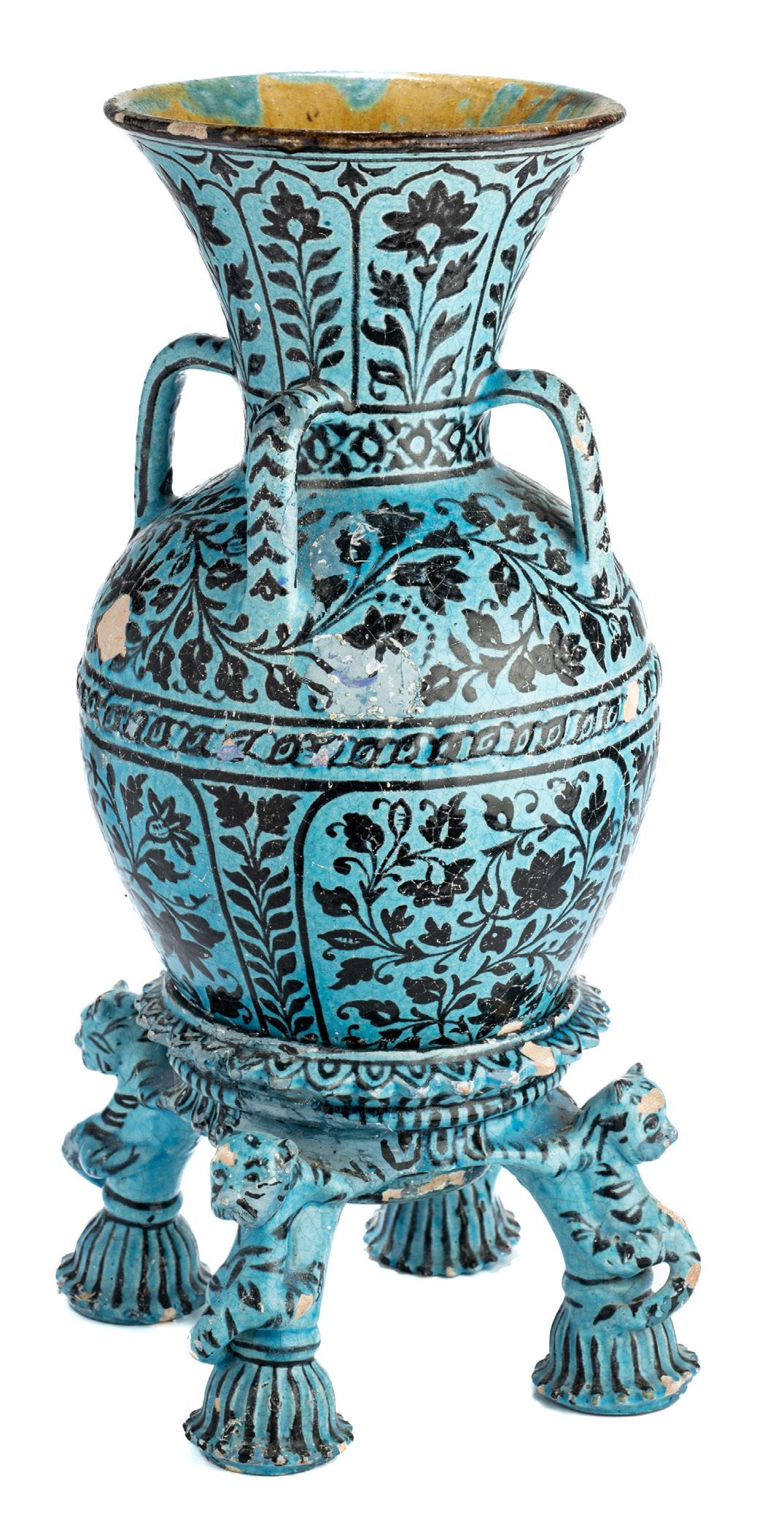
151
354.
TWO BOMBAY SCHOOL OF ART DECORATIVE PLATES, INDIA, LATE 19TH CENTURY, slip painted earthenware, the larger with pierced floral lip, the well with a floral medallion, the smaller of flatish, slightly concave profile, decorated with central floral medallion surrounded by lotus and scrolling floral border, initialled 'Sri Chi Na' and embossed on the base, pierced foot, 26, 23cm

£100-150
355.
A BOMBAY SCHOOL OF ART CUP AND GOBLET, INDIA, 1880-1890, slip painted earthenware, each painted with stylised floral designs, 9cm, 11cm

£60-80
356.
A PAIR OF BOMBAY SCHOOL OF ART VASES, INDIA, CIRCA 1880, slip painted earthenware, of bulbous 'huqqa' form, with gently flared, ridged neck, the sides decorated with repeated stylised floral medallions, the base with embossed stamp in nastaliq script and painted letters in devanagari reading 'Babu', 33.5cm each
£250-350

152
357.
FIVE MULTAN POTTERY VESSELS, PUNJAB, INDIA (NOW PAKISTAN), CIRCA
1900, blue and white glazed earthenware, comprising two reticulated double body vases, two pilgrim bottles, and a small dish with pierced lip, 21cm high and smaller


The inscriptions in Urdu read khusamadeed ('welcome to all').
£120-150
358.
TWO JAIPUR BLUE AND WHITE VESSELS, INDIA, LATE 19TH CENTURY, underglazepainted glazed fritware, the larger with twin handles and tulip-shaped mouth, moulded relief decoration on each side depicting Ganesha, the smaller with a series of floral panels on the sides, the shoulder and neck with alternating bands of lotus and acanthus motifs, 30cm, 10.5cm high £120-150
153
359.
AN UNUSUAL BOMBAY SCHOOL OF ART VASE, INDIA, CIRCA 1880-1890, slip painted and sgraffitoed earthenware, four leopard-spot painted loop handles linking shoulder and neck, the sides painted with stylised lotuses, the base inscribed 'Shri', 19.5cm high
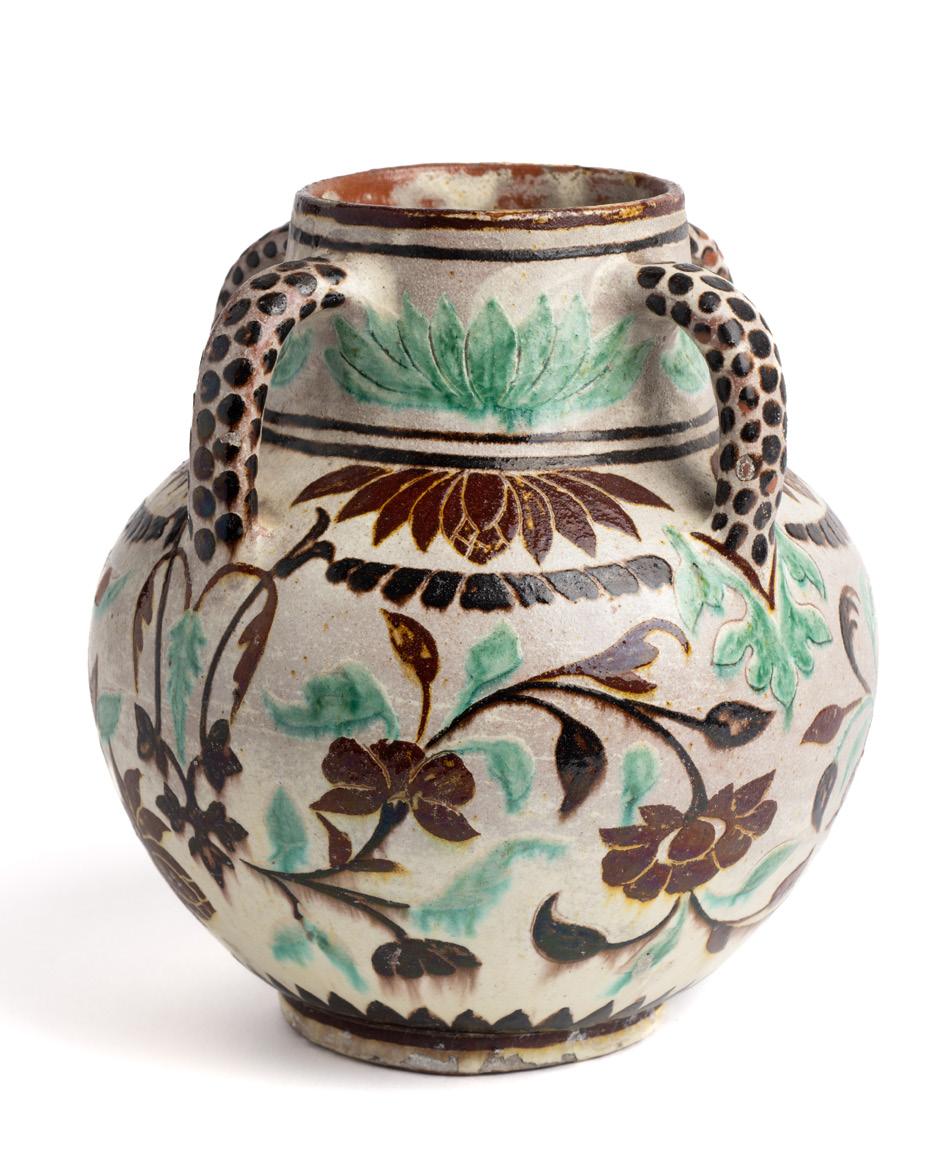
£150-200
360.
A PAIR OF BOMBAY SCHOOL OF ART ORNAMENTAL EWERS, INDIA, LATE 19TH CENTURY, blue and white glazed earthenware, each with flattened body, small spout, scrolling hand and slender neck topped with dome stopper, inscribed 'Sri Paa' on base, 27cm high each

For another ewer of the same form, but decorated with white and manganese slip under a honey coloured transparent glaze, see Victoria and Albert Museum, inv. no. IM.54-1921
£120-180
154
361. A LARGE BOMBAY SCHOOL OF ART VASE, INDIA, CIRCA 1880, turquoise glazed earthenware, underglaze painted in cobalt blue, the decoration comprising a register of lotiform panels filled with dense floral designs, further foliate bands above and below, 47cm high

Although the turquoise and cobalt colour scheme is inspired by early Syrian and Persian ceramics, the intricate floral designs are closely modelled on the Buddhist mural painting at Ajanta.
£300-400
155
362.
A PAIR OF BOMBAY SCHOOL OF ART VASES, INDIA, LATE 19TH CENTURY, slip painted earthenware, of pilgrim flask form, with flattened bodies and flared neck, 34cm high each (2) £150-200
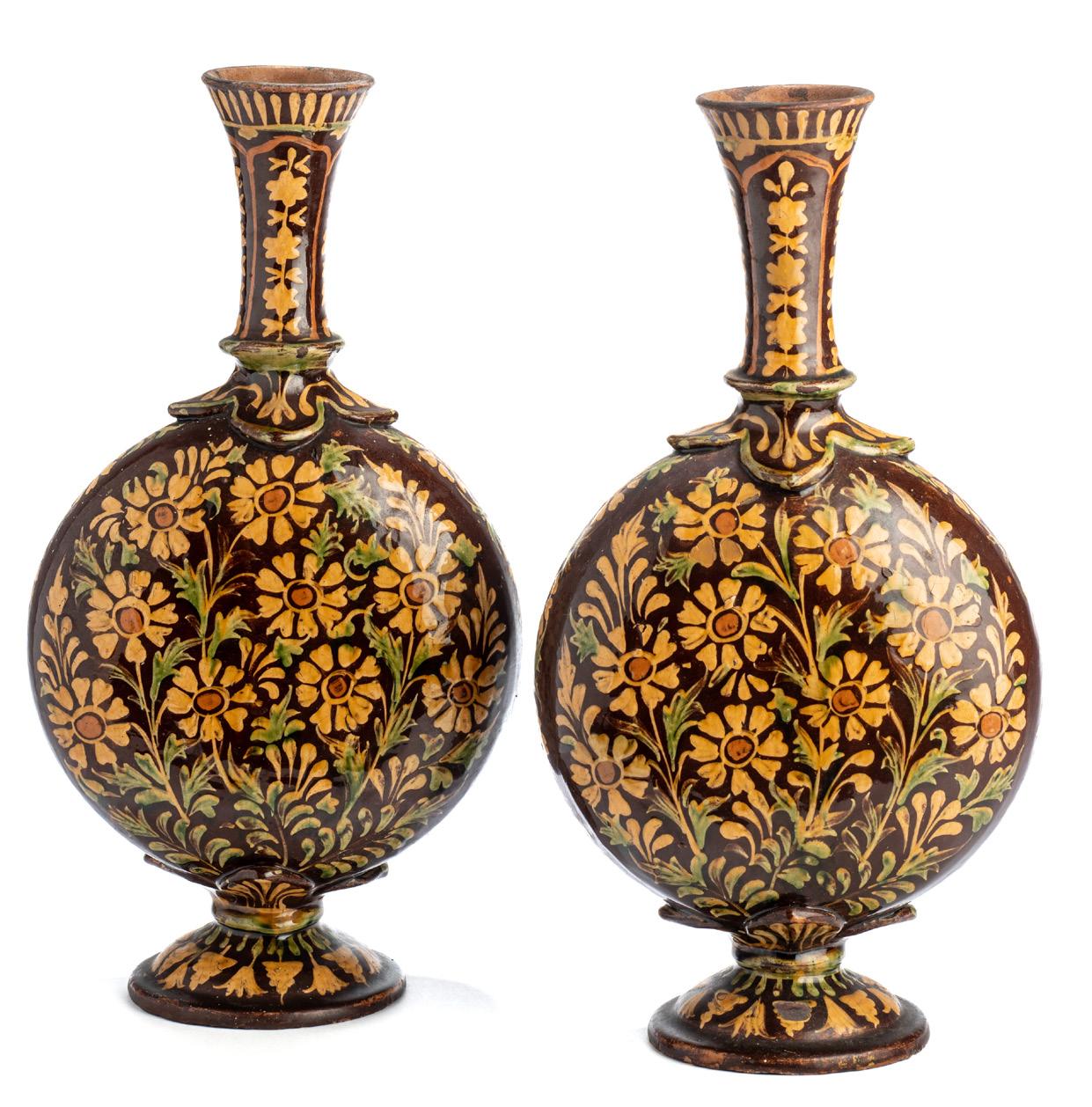
363.
A BOMBAY SCHOOL OF ART VASE, INDIA, CIRCA 1880, slip painted earthenware with sgraffito details, the decoration inspired by the Ajanta caves, including depictions of Buddha with devotees and lotus designs, the twin handles in the form of bird headed female deities, the domed lid with small figure as finial, associated wood base, 46cm high
£300-500

156
364.
TWO BOMBAY SCHOOL OF ART VASES, INDIA, CIRCA 1880, slip painted earthenware, the larger with stylised foliate decoration, the shoulder with a series of triangular panels depicting seated ascetics alternating with floral motifs, the other with cherubic figures amidst leafy scrolls and palmette motifs, 29.5, 25.5cm high

The smaller is inscribed with the name 'Jayrav' on the base
£200-300
365.
A BOMBAY SCHOOL OF ART SURAHI, INDIA, LATE 19TH CENTURY, slip painted earthenware, of bulbous form with gentle flared neck and domed stopper, the body with a reticulated arabesque design, the base with inscribed initials, 35cm high

The decoration on this vessel shows a closer affinity with the Islamic styles favoured by the Sindh potters who brought their techniques to the art school. It is also interesting to note that the clay body is a paler buff than the red terracotta most commonly seen in Bombay pottery.
£120-180
157
366.
A BOMBAY SCHOOL OF ART EWER, INDIA, CIRCA 1880, slip painted earthenware, the spherical body supporting a flared neck with lobed mouth, the handle in the form of a tiger perched on a branch, inscribed on base, 30.5cm high £150-250
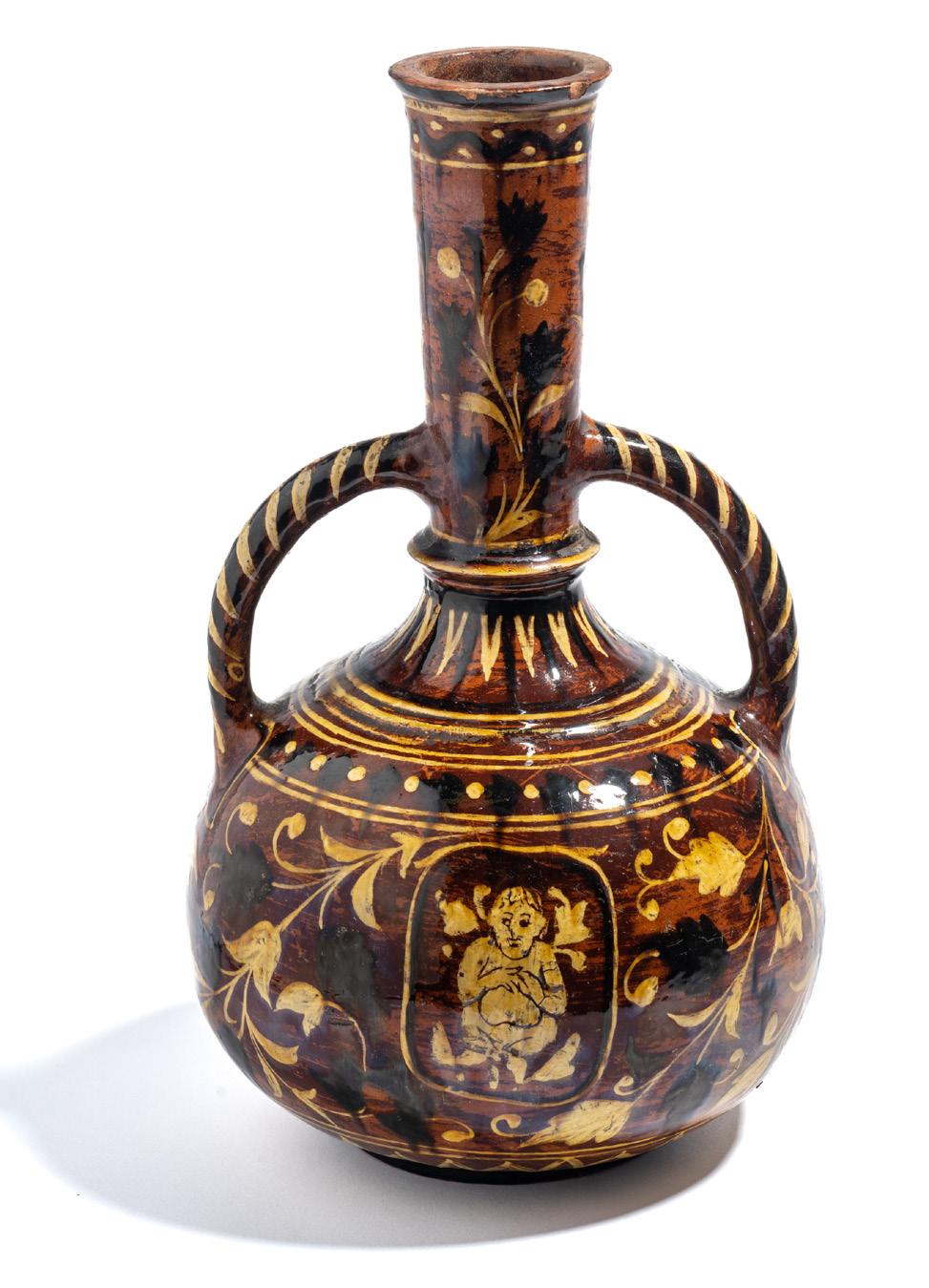
367.
TWO BOMBAY SCHOOL OF ART VESSELS, INDIA, LATE
19TH CENTURY, slip painted earthenware, comprising a vase decorated with densely painted floral medallions, and a ewer with squat ridged body and cylindrical neck, embossed on the base with Bombay School of Art Pottery mark, 30.5, 23.5cm £120-180
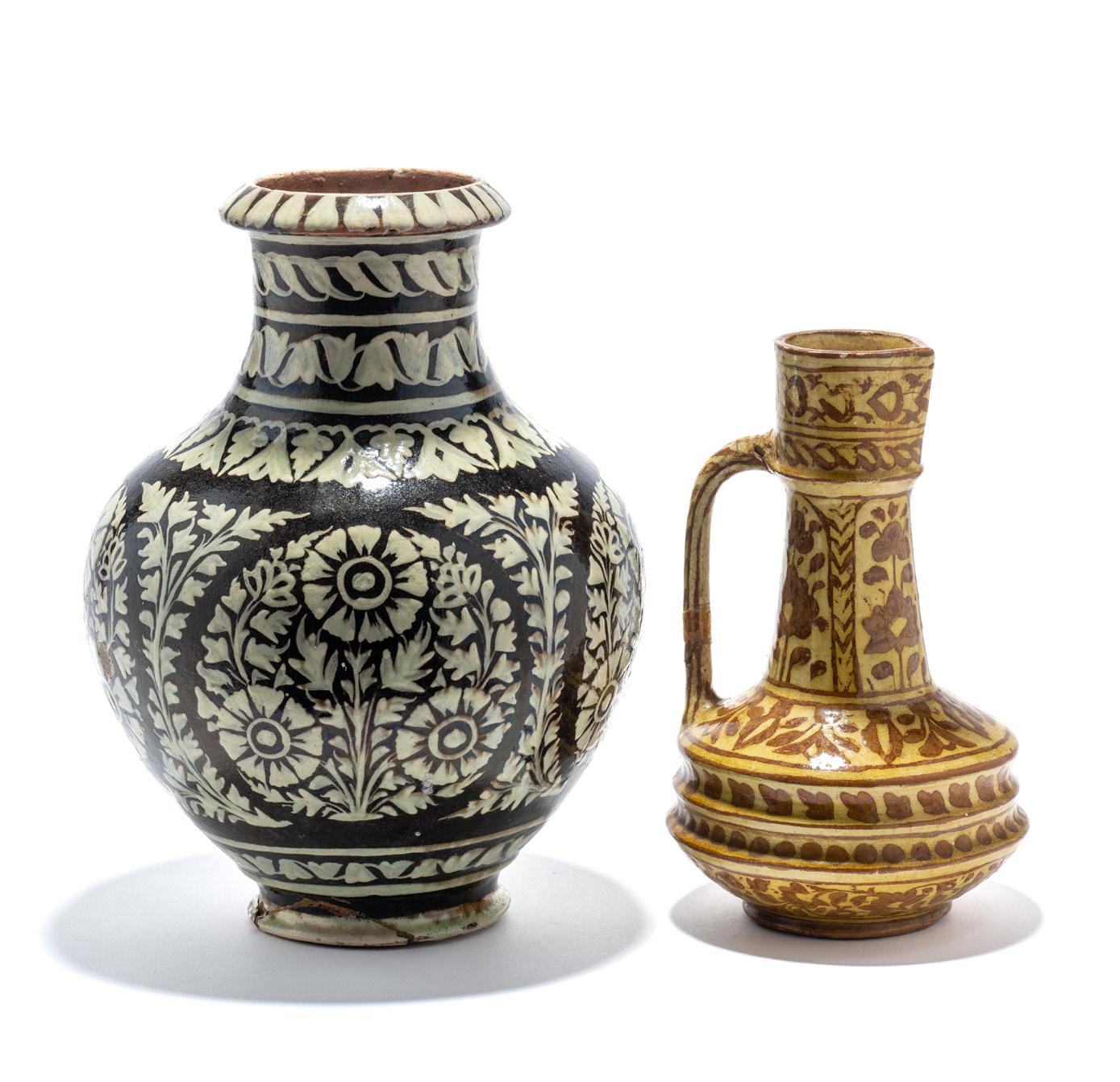

368.
A BOMBAY SCHOOL OF ART VASE, INDIA, CIRCA 1880, slip painted and sgraffitoed earthenware, of surahi form with twin handles, each side decorated with a medallion containing a cherubic figure amidst scrolling foliage, inscribed on base, 30cm high £120-180
369.
158
A BOMBAY SCHOOL OF ART VASE, INDIA, CIRCA 1880, slip painted earthenware, with ridged neck and flared mouth, the body decorated with repeated floral medallions, 33cm high


£150-200
370.
A BOMBAY SCHOOL OF ART VASE ON STAND, INDIA, CIRCA 1880, slip painted earthenware, of amphora form, the waisted stand with four supporting modelled peacocks, four similar peacock handles on the neck and shoulder, serrated and pierced rim, the sides indistinctly painted with Hindu figures in oval medallions, interspersed with birds and floral arabesques, 52cm high (including stand)
£250-350
371. (illustrated online)
A CHINESE PORCELAIN CHARGER, FIRST HALF 19TH CENTURY, probably for the Central Asian Market, overglaze painted with polychrome floral decoration, the centre with Islamic inscription and date reading AH 1235/1820 AD, modern hanging bracket, 46.5cm diam.
£80-120
End of Sale
Next Sale May 2023
Closing for entries by end of March
159






